The best time to visit Hawaii for good weather, smaller crowds, deals and more

So you want to visit Hawaii? Understandable — it's a great place.
However, unless you're booking a spontaneous flight deal (and those do happen), you'll probably want to plan to ensure you're traveling at the best time for your particular dream trip.
Whether you're looking for dry, idyllic weather, perfect whale watching season, or the cheapest time to book a Hawaiian hotel room, consider this your definitive guide to planning a perfect trip to Hawaii.

The best time to visit Hawaii for good weather
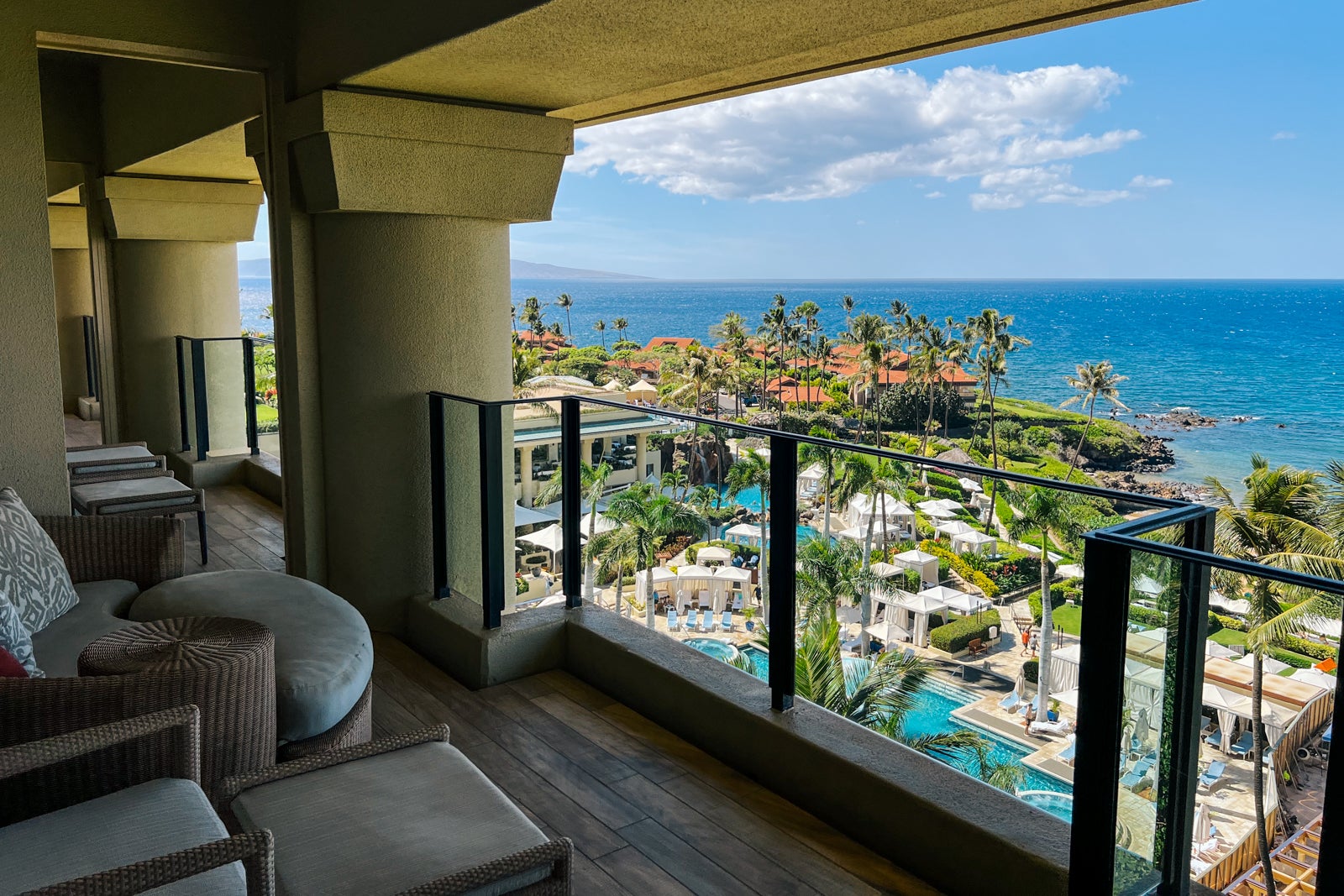
Generally, the best weather in Hawaii is in June, July and September. This is when travelers can expect the least amount of rain along with warmer water temperatures.
However, Hawaii isn't a true four seasons state and it has pretty great weather year-round. So if traveling during June, July or September isn't in the cards, you're still probably fine as there's really no bad time to go. I just got back from a trip in mid-November and the weather was great. It was warm enough to swim in the ocean without being too hot lying in the sun.
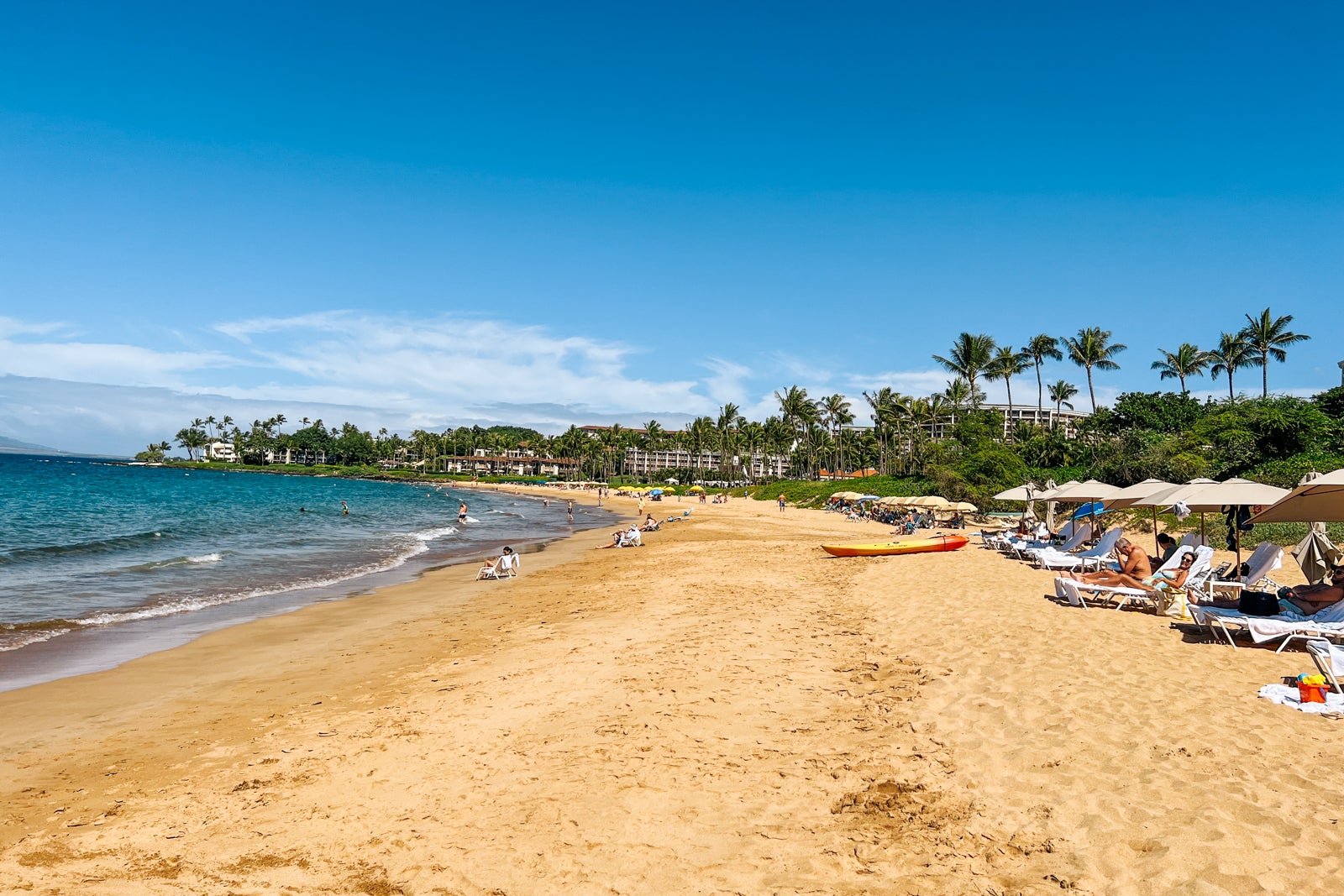
Hawaii has a tropical climate, with temperatures generally staying between 83 and 88 degrees all year long.
You should check local weather, though, as conditions in some parts of the Islands are wetter than others depending on if you are staying on the windward or leeward sides of each island.
Kauai, for instance, gets a lot of rain on the northern side of the island compared to the southern side (which does lead to some pretty great rainbows). Even if the forecast calls for rain, however, the rain tends to come in short bursts and doesn't last long.
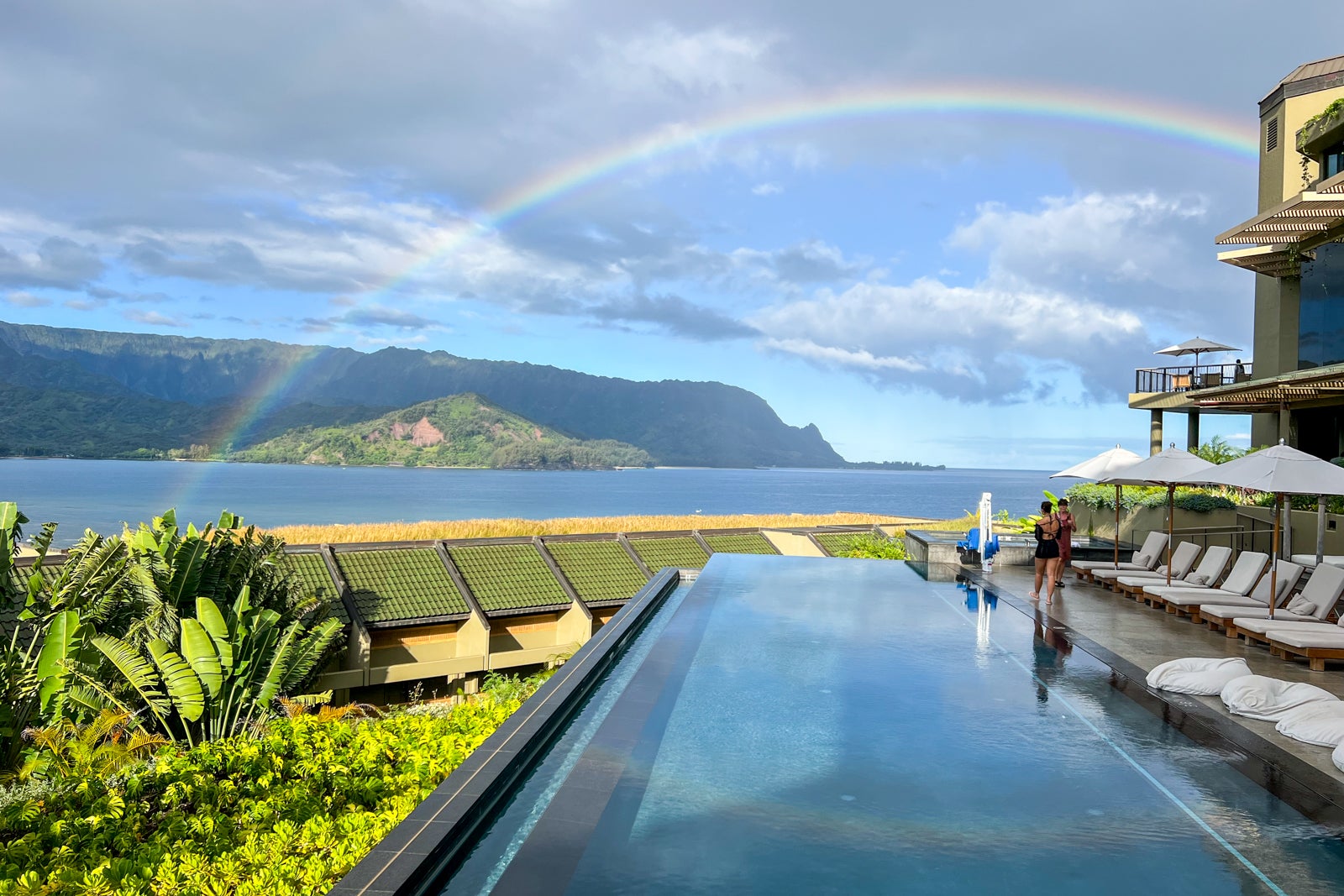
Best time to visit Hawaii to avoid crowds
The peak tourism season in Hawaii typically starts in the middle of December and continues until the end of March or mid-April, depending on the timing of spring break for major parts of the U.S.
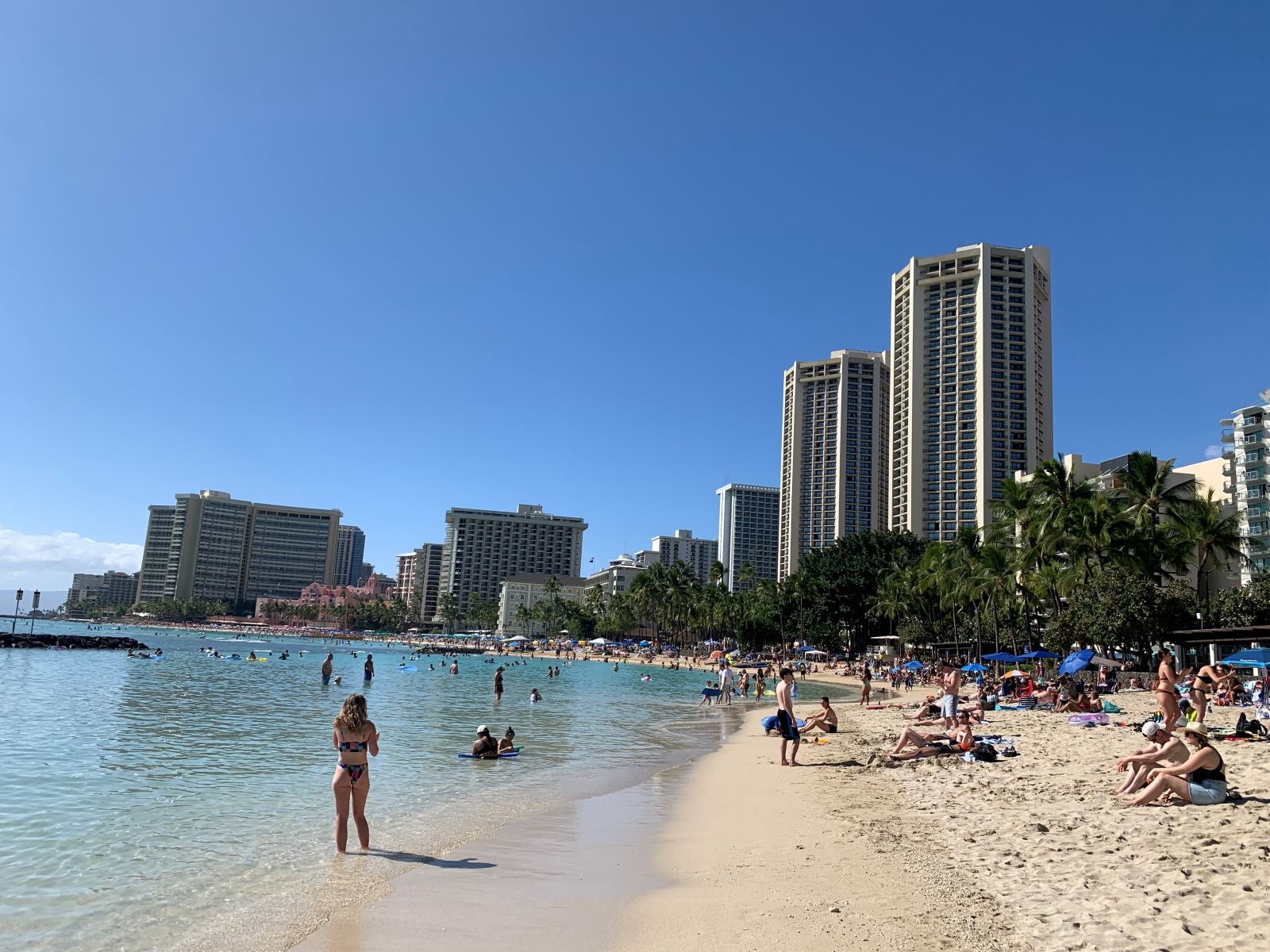
The less busy season stretches from the middle of April until mid-June, when most schools are out of the summer and then resumes from September until crowds tick up before the holidays. Shoulder season is a great time to visit. The huge crowds are gone, prices are lower and you can have more of the beach to yourself. Even in busy spots like Honolulu, you'll have more breathing room after Labor Day and before Thanksgiving.
July and August, while not considered Hawaii's busiest season, still tend to draw decent crowds — and are especially popular with vacationing families.
Cheapest months to visit Hawaii
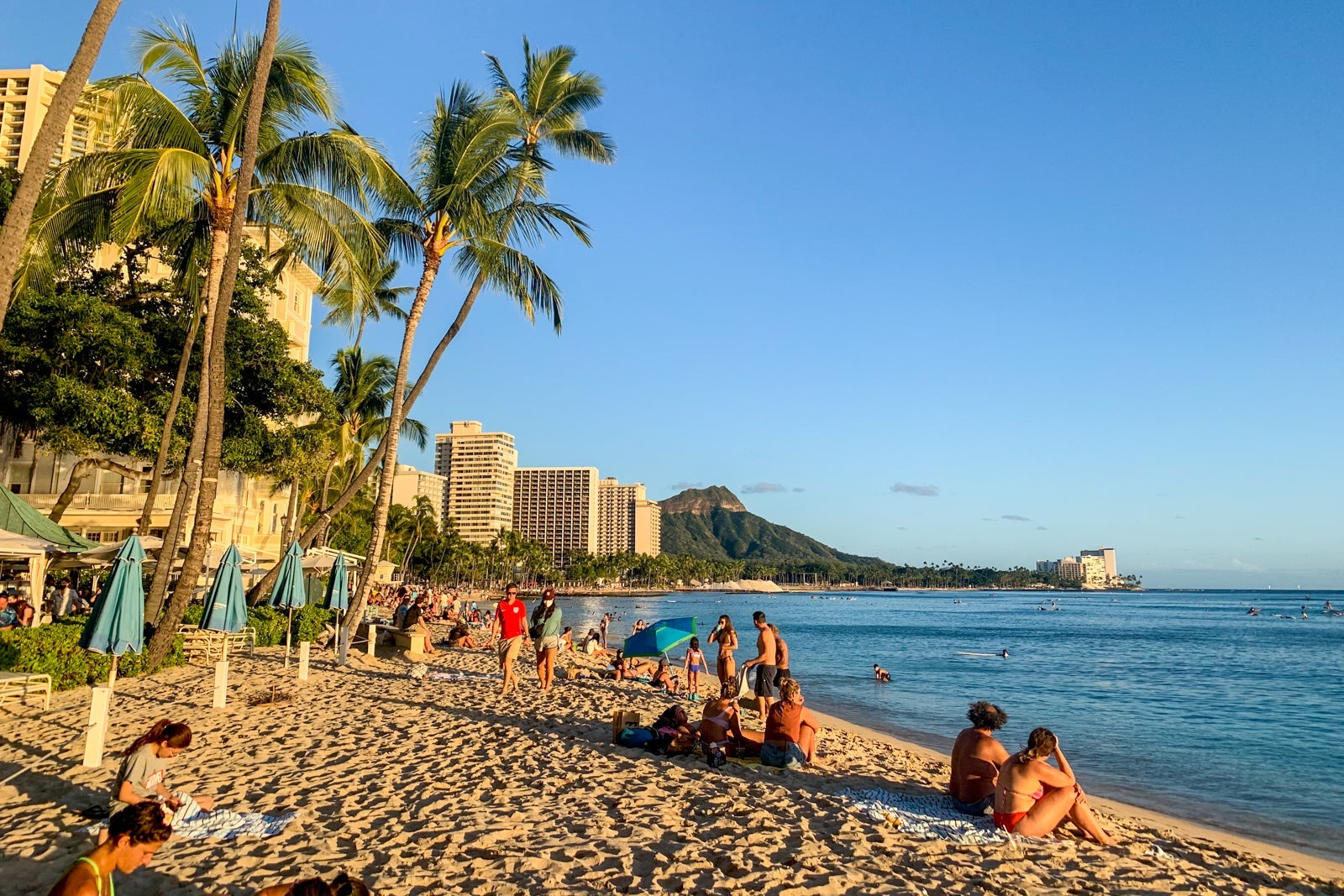
Traveling to Hawaii is usually priciest during peak season, so if you want to save, wait until the off-peak or shoulder seasons.
The shoulder seasons in Hawaii run from late March through the beginning of May, and from September until Thanksgiving. However, spring break and the beginning of September can yield high traffic and higher prices, too, so look carefully before booking.
Historical data from the travel booking site Skyscanner shows airfare is at its most expensive during the winter, specifically in January. At this time of year, average long-haul flight prices can exceed $1,400.
However, prices can plummet during the shoulder seasons or times that cushion peak periods, such as late November and early March. This past September, we saw a fare war develop with prices as low as $62 one-way to Hawaii. This is especially true if you are coming from the western half of the U.S. Keep an eye on TPG deal alerts , where we regularly cover sales to Hawaii.
We looked at historical data, and generally, the most expensive month for a room in Honolulu is January, with the least expensive month being April. Analysts tell TPG it's best to book as early as possible for the best rates in the off-season. We're told that many tourists are booking as close in as a week before arrival, and the best deals will be had as far out as possible. It pays to plan ahead.
Of course, you may have more flexibility when you cash in your points and miles — though hotel award rates tend to shift with peak and off-peak seasons, too. Also, award flight availability is often directly tied to demand.
Best time to travel to Hawaii to surf
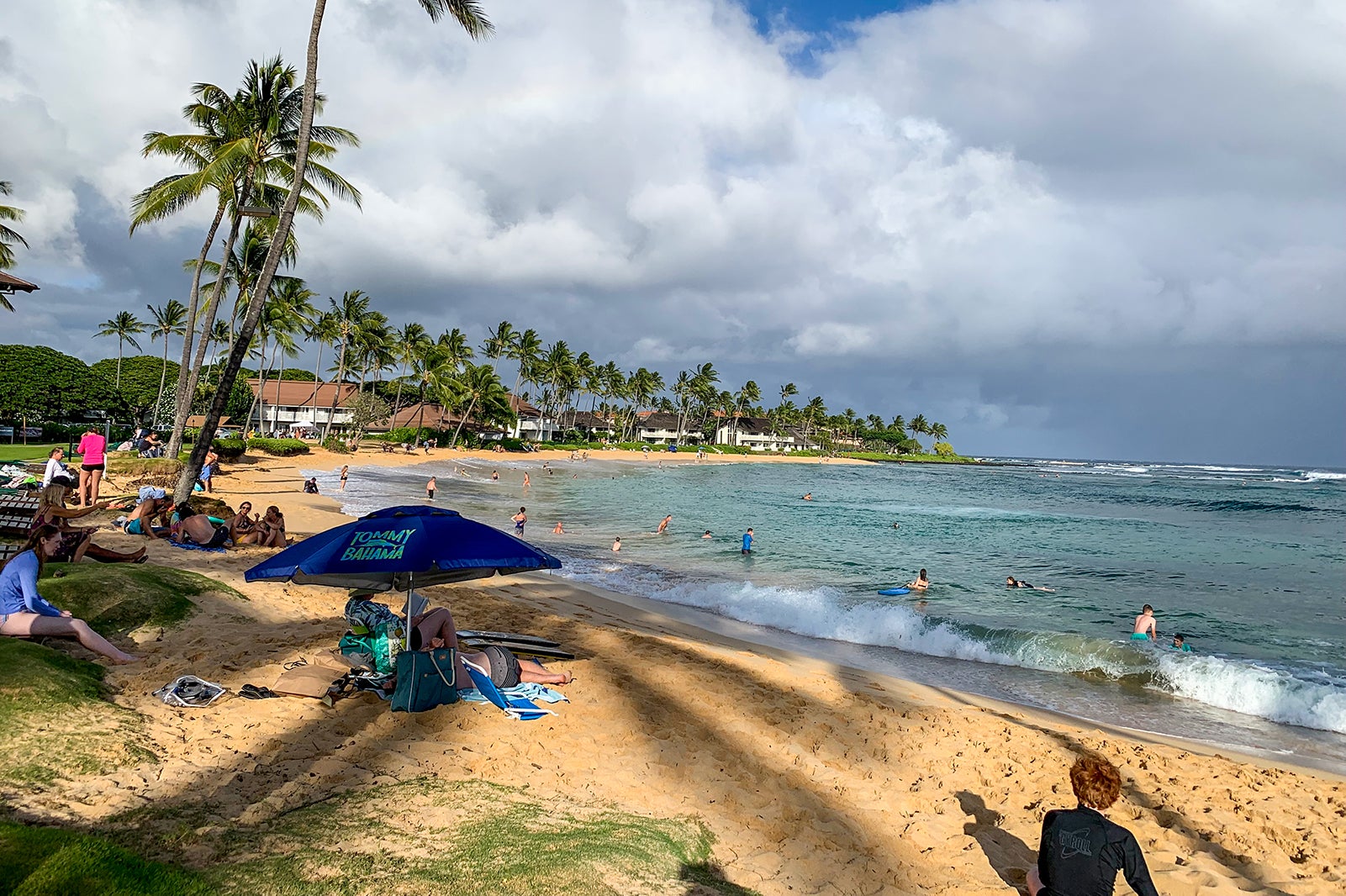
Only four of the islands in the Hawaiian archipelago are suitable for surfing year-round: Oahu, Maui, Kauai and the Big Island. As for when and where you'd like to surf, well, that depends entirely on your skill level.
The waves follow a somewhat consistent schedule. In the winter, for example, surfers can find serious swells off an island's north coast, while the south coast experiences calmer seas. During the summer, the opposite is true.
So, for advanced surfers, the winter season, or ho'oilo, which runs from mid-November to early February, is when you should look out for big wave surfing competitions on the North Shore of Oahu, also known as the "Seven Mile Miracle."
On the Big Island, surf enthusiasts should check out La'aloa Bay and Honoli'i Beach Park.
For novice surfers, you'll want to spend more time on the island's southern coasts in the winter. In Maui, beaches in Kaanapali, Lahaina and Kihei deliver just-right waves for beginners to get their feet wet.
Best time for whale watching in Hawaii
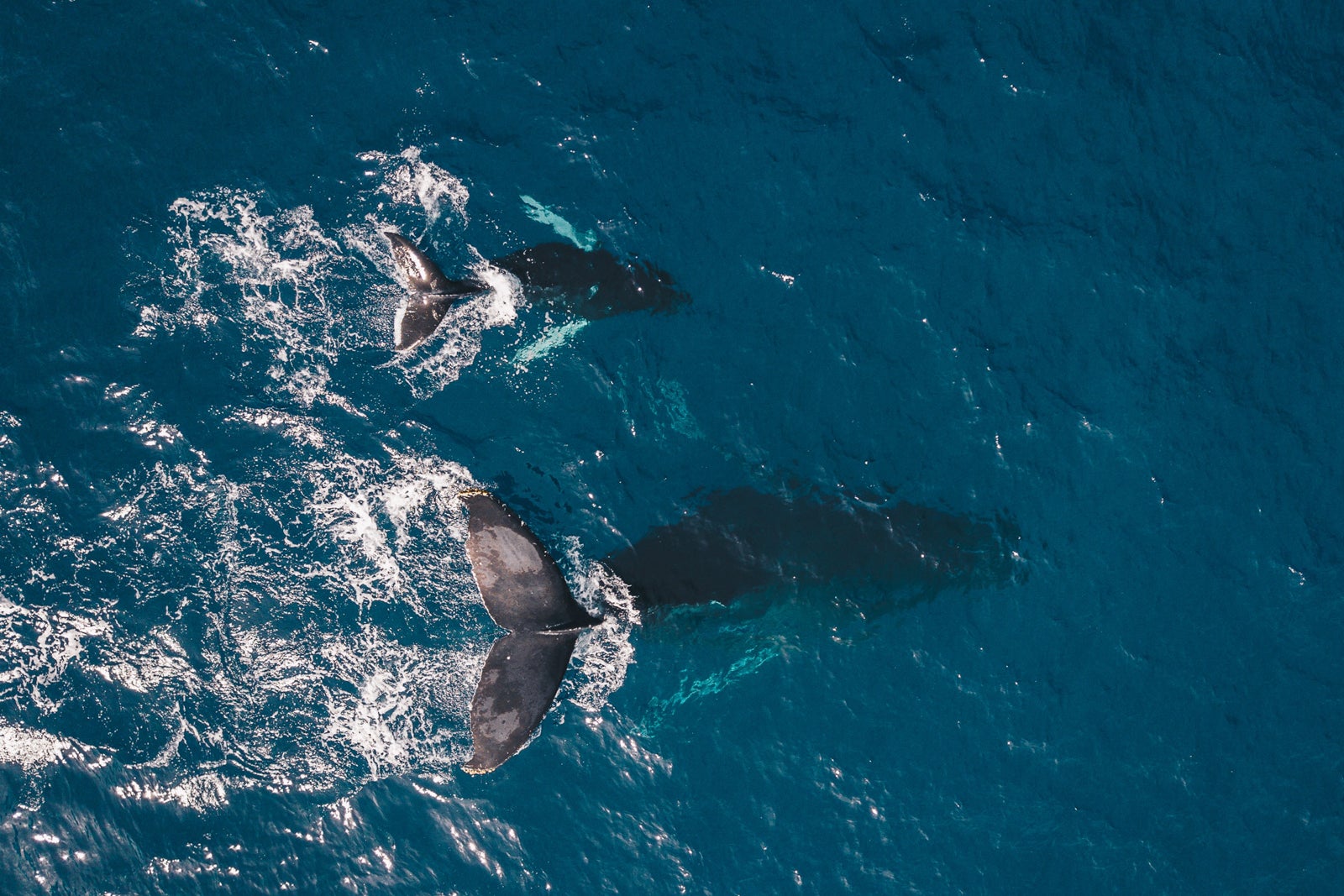
The best time to go whale watching
Whales migrate to Hawaii in pods of roughly 1,000 between late December and early April, making Maui and the Kohala Coast of the Big Island two of the best places on Earth to spot the giants. Note that sometimes whales show up as early as November, so you could get lucky if you travel during shoulder season.
The best time to see turtles
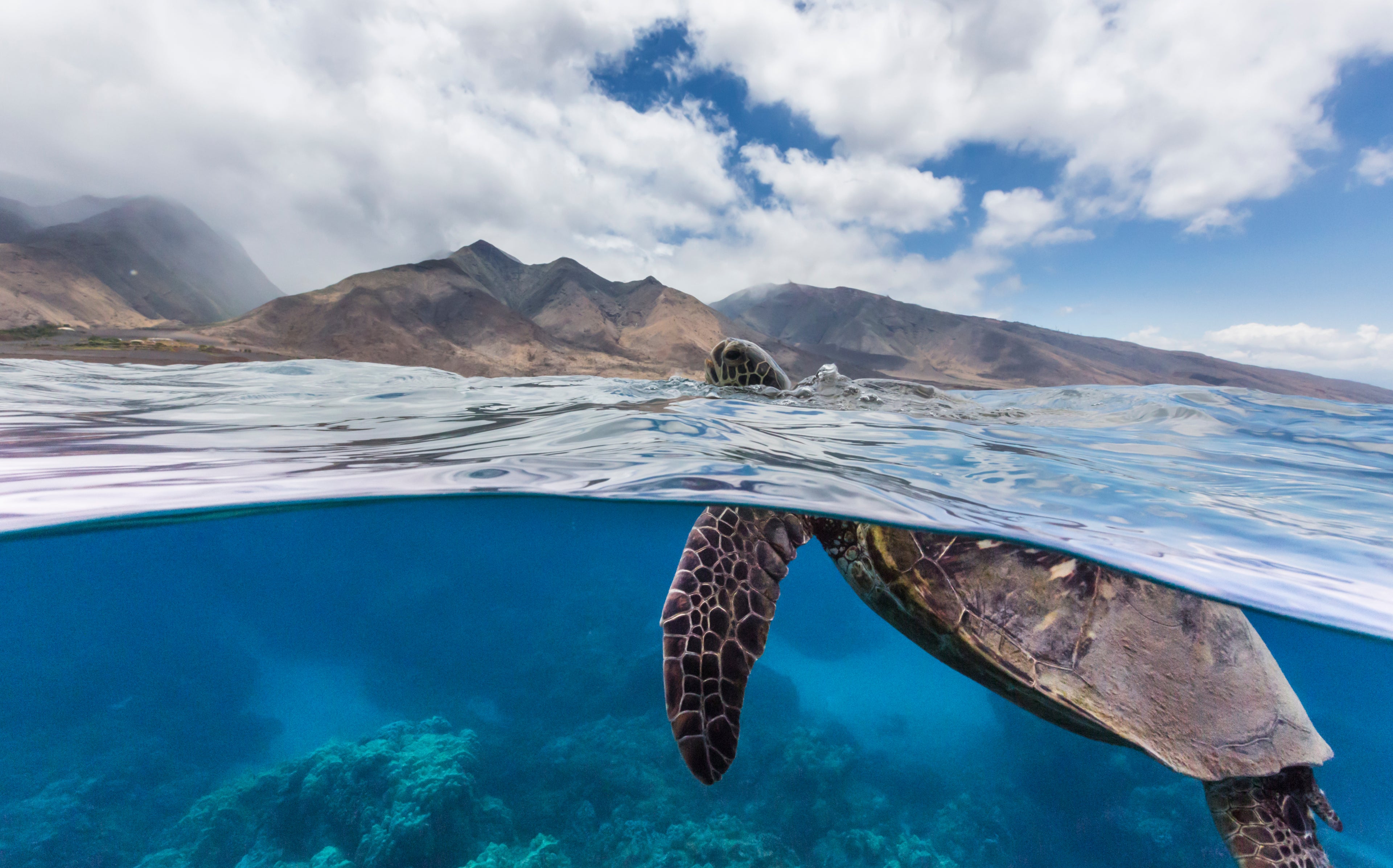
If you're interested in spotting Hawaiian green sea turtles (honu), they're plentiful year-round in Maui, on the Big Island of Hawaii, Kaui and on Oahu. One of the most famous spots for turtle-spotting is on Ho'okipa Beach in Maui.
Visit in the summer, during nesting season, to increase your odds. You'll even find sea turtles on some hotel grounds. I was able to get up close and personal with turtles on a trip to the Hilton Waikoloa Village on the Big Island. At that hotel, they hang out in the hotel's lagoon.
Many vendors sell turtle snorkeling adventures and I've had great luck with two separate snorkeling trips in Hawaii.
A warning, though: please don't get too close. People are asked to give the turtles at least ten feet of space and never touch them. Human touch can spread bacteria to turtles, which can lead to starvation for the creature. Remember that green sea turtles are listed as an endangered species.
Hawaii has five of the seven species of sea turtles in the world, but green sea turtles are the most common.
When to visit Hawaii for events
Summer events.
In the summer, on the third weekend of July, visitors can attend the Prince Lot Hula Festival, Hawaii's largest non-competitive hula event.
Fall events
The Hawaii Food & Wine Festival is a major draw for foodies, featuring an extensive lineup of dinners, parties, cooking classes and more taking place in October and November of 2024 on three different islands – Hawaii, Maui and Oahu.
In September, travelers can attend the Aloha Festivals in Waikiki, which feature arts and crafts, food and performance stages. Don't forget the floral parade.
Winter events
This is prime season for surfing competitions, including the Vans Triple Crown of surfing on the North Shore of Oahu.
Spring events
Heading to Hawaii in the springtime? Consider the Honolulu Festival in March or the Lantern Floating Festival, held on Memorial Day yearly in Ala Moana Beach Park in Honolulu.
Worst time to visit Hawaii?
This is kind of a trick question, as there is really no bad time to visit Hawaii. You'll find warm weather and sunshine most of the year. Even when it does rain, it is often just for a few minutes.
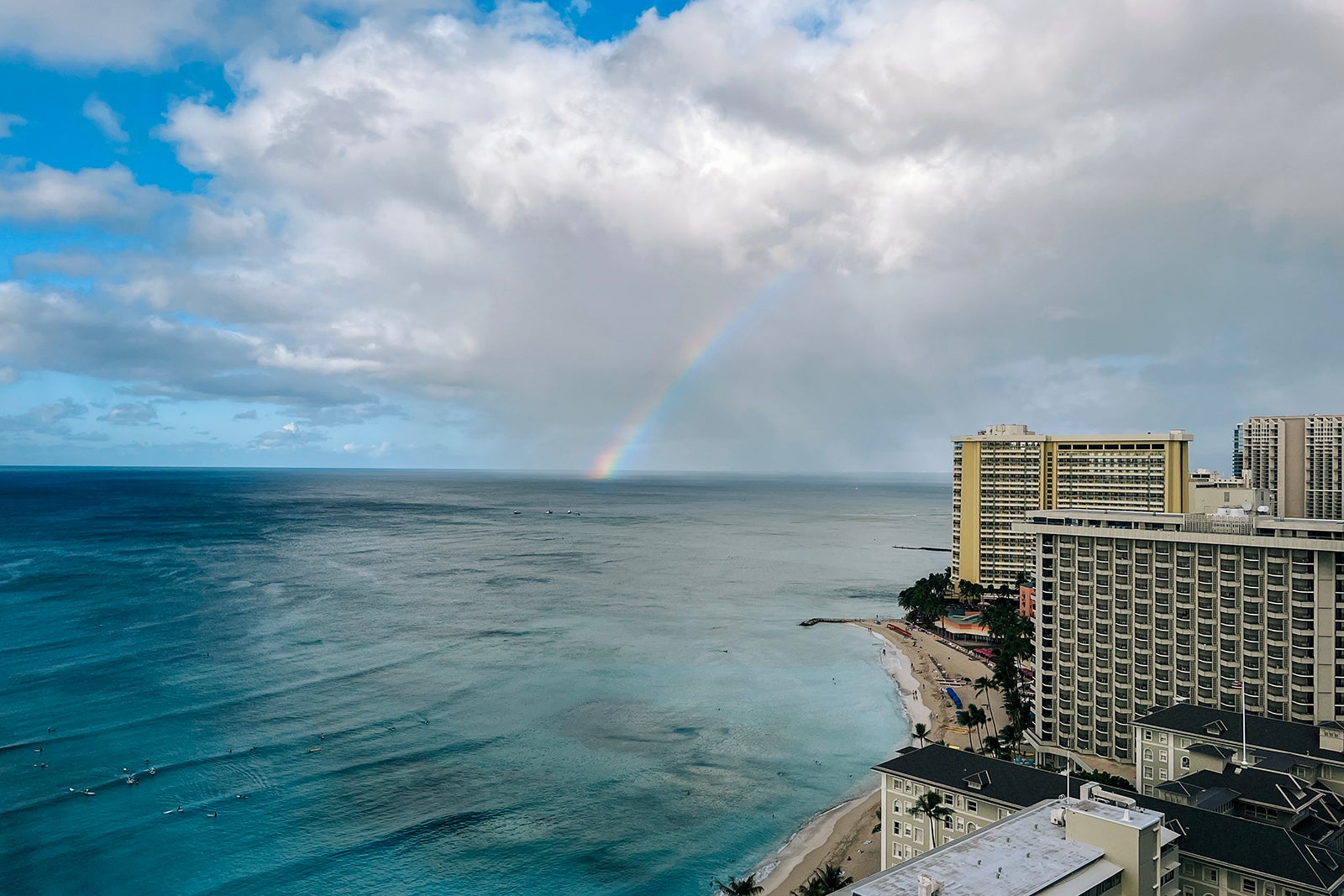
That said, some locals say December is the worst time of the year because of the extra crowds, extra costs, and the increased rain shower odds. But even with all that, I'd trade Northeast winter weather for that any time of the year.
Related reading:
- Key travel tips you need to know — whether you're a beginner or expert traveler
- The best travel credit cards
- Where to go in 2024: The 16 best places to travel
- 6 real-life strategies you can use when your flight is canceled or delayed
- 8 of the best credit cards for general travel purchases
- 13 must-have items the TPG team can't travel without
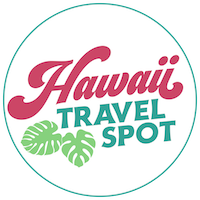
Best Time to Visit Hawaii: A Month-by-Month Breakdown
Are you planning a trip to hawaii but aren’t sure when to go keep scrolling to find out the best time to visit hawaii., this guide to the best time to visit hawaii was written by marcie cheung (a hawaii travel expert) and contains affiliate links which means if you purchase something from one of my affiliate links, i may earn a small commission that goes back into maintaining this blog..
Hawaii is a popular travel spot, known for its beautiful beaches, green mountains, and unique culture.
Many people dream of visiting this paradise. But when is the best time to go?
Why trust my insights? My numerous trips (over 40!) to Hawaii have given me a rare depth of knowledge about the islands.
I’ve visited during peak season, school breaks, and when there were fewer crowds. Here are a few things to think about before planning a trip.
The weather can be different throughout the year. Winter months are during the rainy season and summertime is during hurricane season.
There are special events and festivals that happen in certain months. Also, some times of the year might be more expensive or crowded than others.
In this guide, we’ll look at each month to help you pick the best time for your trip to Hawaii. We want to make sure you have the best time possible!
Want to skip all the planning and just access my detailed Hawaii itineraries complete with daily schedules, fun activities, and travel hacks? Click the button below.
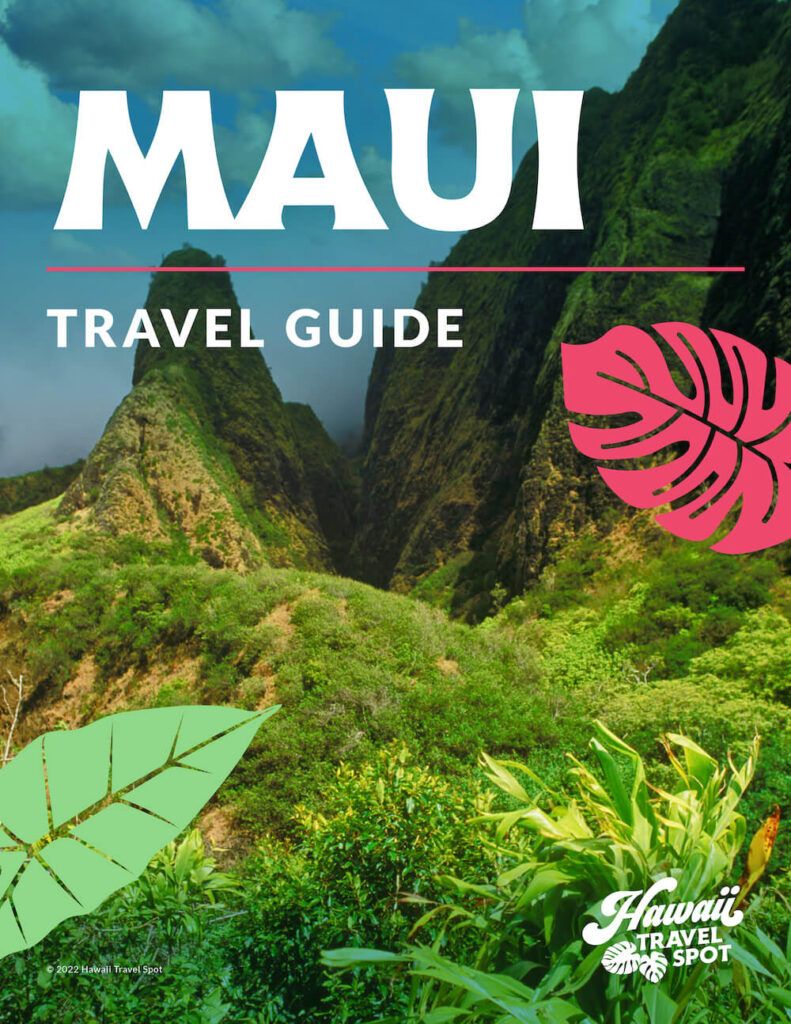
Best Time to Go To Hawaii
Visiting hawaii in january: a fresh start to the year.
January in Hawaii offers a refreshing change from the typical winter scene. While the mainland may be in the grip of cold, Hawaii greets visitors with cooler but pleasant temperatures, making it a cozy time to explore.
But the real treat?
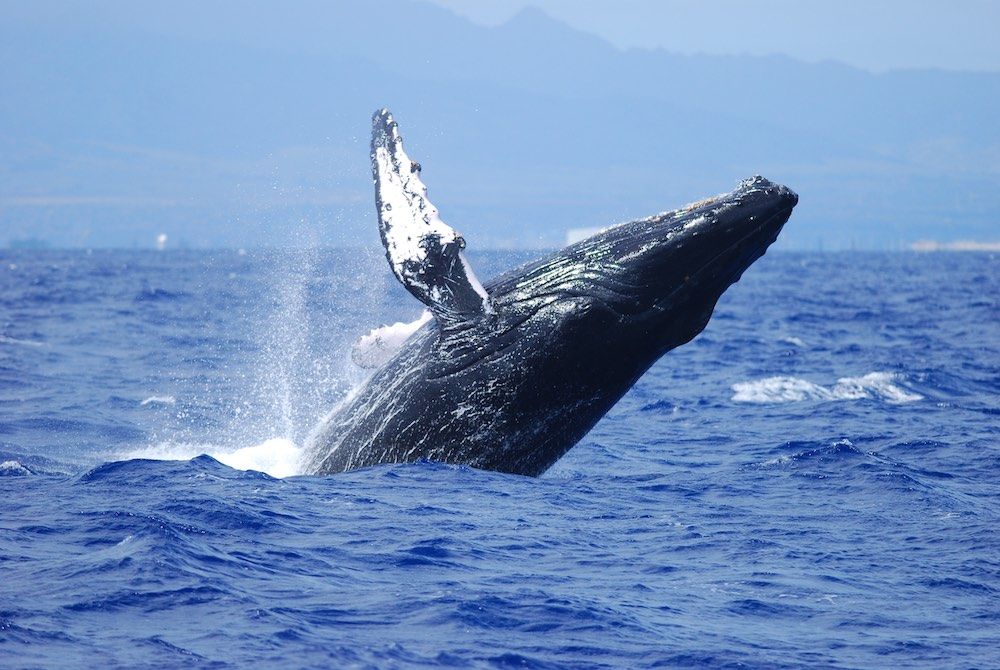
January is prime whale-watching season . Grab your binoculars, because the majestic humpback whales grace the Hawaiian waters during this time, presenting a spectacular natural show.
We usually have the best luck seeing whales on Maui !
For sports enthusiasts, the island of Oahu buzzes with excitement as the PGA Tour’s Sony Open takes place in Honolulu. It’s a grand event that attracts golfing aficionados from around the world.
As for the crowds, January sees a mix. The early part of the month still holds onto the holiday rush, but as the month progresses, the crowd thins out, and there’s a slight drop in prices.
It’s a fantastic balance of vibrant events, natural wonders, and serene moments.
Hawaii in February: Romance and Revelry
February in Hawaii continues to be a prime time for nature enthusiasts, as the humpback whales remain the stars of the show, gracing the waters with their majestic presence.
These gentle giants provide unparalleled viewing experiences that resonate with both first-time visitors and returning fans.
However, the islands also burst into a lively mood with the Waimea Town Celebration on Kauai. This vibrant event is a beautiful mix of Hawaiian culture, music, and food, making it a must-attend for anyone visiting Hawaii during this period.
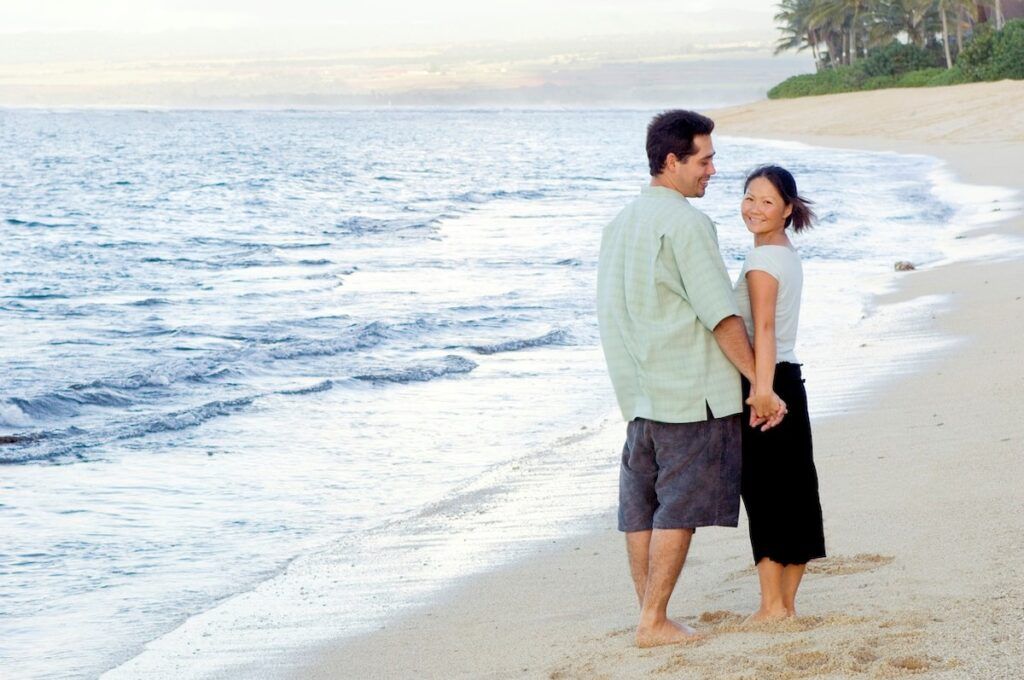
And, speaking of special moments, imagine spending Valentine’s Day in paradise ! Hawaii in February offers a romantic backdrop like no other.
Whether you’re strolling on moonlit beaches or enjoying a candlelit dinner with ocean views, the Aloha spirit makes Valentine’s celebrations even more magical.
February truly captures the heart and soul of Hawaii’s charm.
One thing to point out is that a lot of travelers take advantage of February holidays (like President’s Day) and some schools have a mid-winter break.
March in Hawaii: Spring Awakens
As winter gives way to spring, Hawaii undergoes a gentle transformation in March .

The islands experience a delightful shift in weather, with temperatures beginning to warm up and nature bursting into vibrant hues, echoing the rejuvenating spirit of spring.
A highlight of the month is the Honolulu Festival .
Celebrated primarily on Oahu, this event showcases the rich cultural tapestry of the Pacific region. With dance performances, art displays, and grand parades, the festival draws visitors and locals alike into a world of shared heritage and unity.
However, with spring’s arrival, so comes the influx of Spring Break travelers. Popular spots like Waikiki Beach or the North Shore can get bustling, as families and students flock to enjoy the sun and surf.
It’s a lively time to visit, with a contagious energy in the air, but those seeking solitude might prefer the quieter corners of the islands.
April in Hawaii: Traditions and Tranquility
April in Hawaii welcomes visitors with mild temperatures and the promise of clearer skies, as the rainfall becomes a tad less frequent.
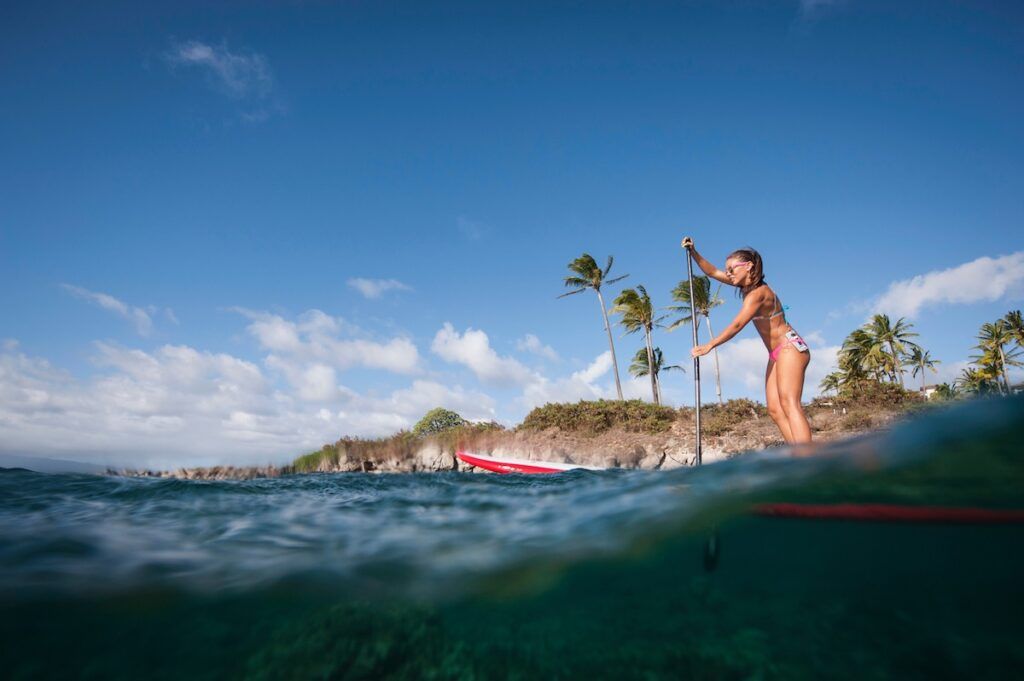
The landscapes gleam in the gentle sun, making it a picturesque time to explore the islands.
An event that truly embodies the spirit of Hawaii in April is the Merrie Monarch Festival .
Hosted in Hilo on the Big Island, this week-long celebration is dedicated to King David Kalākaua and is a grand showcase of Hawaiian culture, especially hula. Dancers from across the globe participate, making it a vibrant and unforgettable spectacle.
If you’re considering a trip around Easter , you’re in for a treat.
While Hawaii embraces its unique traditions, Easter festivities blend seamlessly. Beachside Easter egg hunts and sunrise services are quite popular.
However, do note that this period might see a slight surge in visitors, given the holiday season.
Our kids usually have spring break in April and we definitely notice larger crowds and higher airfare in early April.
Plan ahead for a smooth vacation experience.
May in Hawaii: A Serene Prelude to Summer
May is a gem of a month to visit Hawaii. As the islands bask in dry and calm weather conditions, it offers the perfect prelude before the high energy of summer sets in.
The balmy days and slightly cooler nights make for comfortable explorations, whether you’re hitting the beach or trailing through the lush rainforests.

One of the most heartwarming events in May is the Lei Day Celebration .
An ode to the Hawaiian tradition of lei-making, this day sees locals and visitors donning these fragrant garlands, reflecting the Aloha spirit in full bloom.
Traveling to Hawaii in May comes with the distinct advantage of the shoulder season. Not only do you get to avoid the peak summer crowds, but you often find better deals on accommodations and flights.
In essence, May promises an intimate Hawaiian experience, blending tradition, weather, and travel perks seamlessly.
May is hands-down one of my favorite times to visit Hawaii. That’s because flight prices are usually decent and the weather is comfortable.
June in Hawaii: Summer Splendor Begins
As the calendar flips to June , Hawaii welcomes the onset of summer with sun-kissed beaches and azure waters beckoning travelers to dive into paradise.
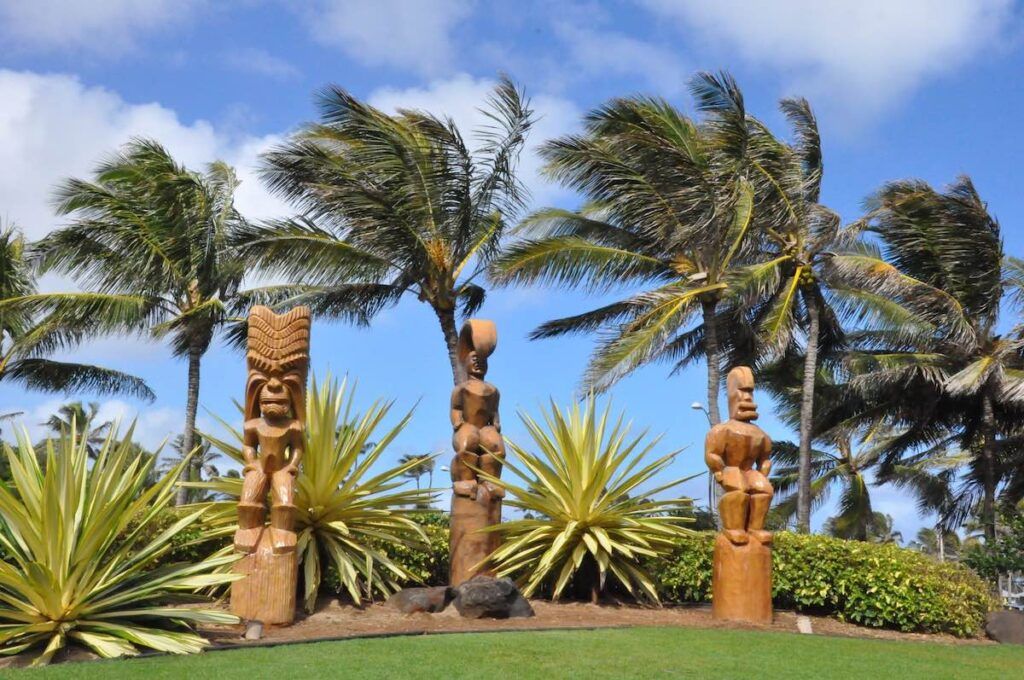
The weather turns warmer, but the gentle Pacific breezes ensure comfort, making it ideal for sunbathing or taking a refreshing dip.
A significant highlight of June is King Kamehameha Day .
This day commemorates the legendary king who united the Hawaiian Islands. Across the state, grand parades, hula performances, and vibrant floral processions honor his legacy, offering visitors a deep dive into Hawaii’s rich history and traditions.
However, with summer’s arrival comes the school holidays. Families flock to the islands to make the most of their break, which means popular tourist spots might get a bit crowded.
If you’re seeking tranquility, consider venturing into lesser-known areas. Nonetheless, June’s allure lies in its blend of history, sunshine, and island festivities.
July in Hawaii: Sizzling Summer Delights
As July rolls around, Hawaii truly embraces its tropical charm. With warm temperatures bathing the islands, it’s the epitome of a sun-soaked paradise.
The balmy days, complemented by refreshing ocean breezes, create the quintessential beach holiday mood, inviting everyone to indulge in island adventures.
A gastronomic treat awaits in July with the Hawaii Food & Wine Festival .
This event attracts foodies from all over, celebrating the culinary diversity of the islands. Local chefs team up with international culinary stars, presenting dishes that are both an art and a sensory delight.
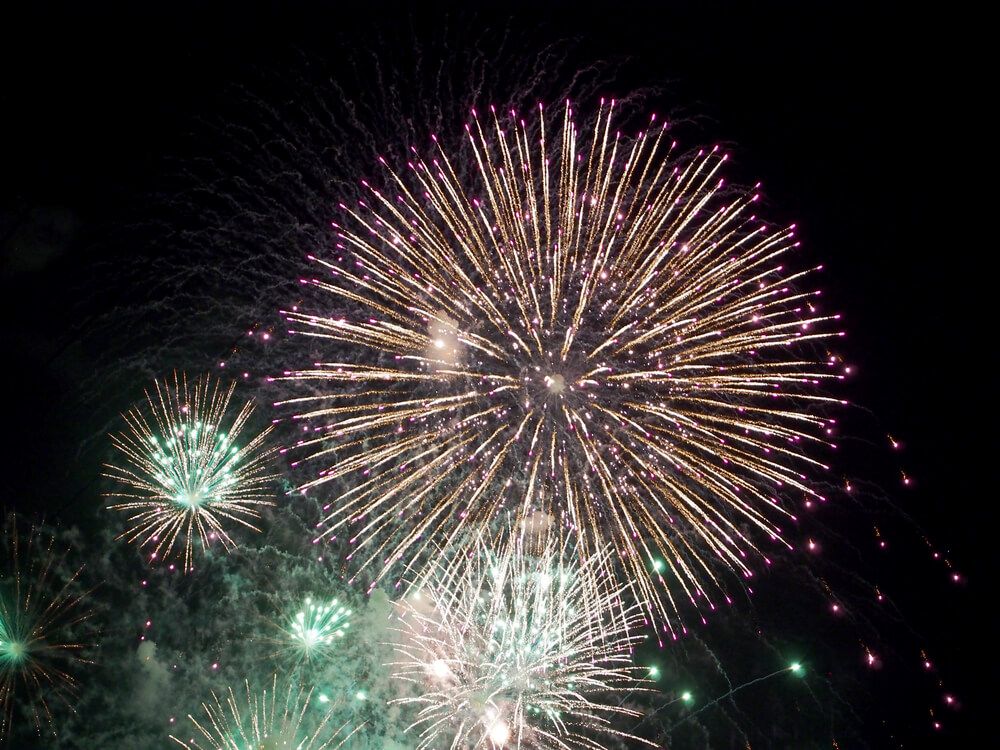
Moreover, the Fourth of July , or Independence Day, is fun in Hawaii. While traditional BBQs and beach picnics are common, what truly stands out are the mesmerizing fireworks displays, especially in areas like Waikiki.
Amidst the summer fun, July in Hawaii offers a blend of culinary escapades and patriotic festivities.
August in Hawaii: Sunlit Serenades and Summer’s Farewell
August is the hottest month in Hawaii. In fact, it can be downright muggy.
It feels super tropical and sunny. The beaches are bright and inviting, making it hard to stay away from the sparkling water.

Yet, even in this warmth, Hawaii’s trade winds bring a cooling relief, making outdoor activities and ocean plunges all the more inviting.
For those with an ear for music, August hosts the Hawaiian Slack Key Guitar Festival , an event that celebrates one of Hawaii’s most beloved musical traditions.
The melodious tunes of the slack key guitar, played against a backdrop of palm-fringed horizons, is a soul-soothing experience few other places can offer.
As August in Hawaii nears its end, the islands experience the wind-down from the summer holidays.
While the early weeks still resonate with the vibrant energy of summer vacationers, the latter part of the month brings a more relaxed atmosphere, setting the tone for early fall.
September in Hawaii: Welcoming Fall with Aloha
September in Hawaii marks the gentle shift from the height of summer to milder, more temperate days. The intense warmth starts to wane, giving way to softer, more comfortable temperatures.
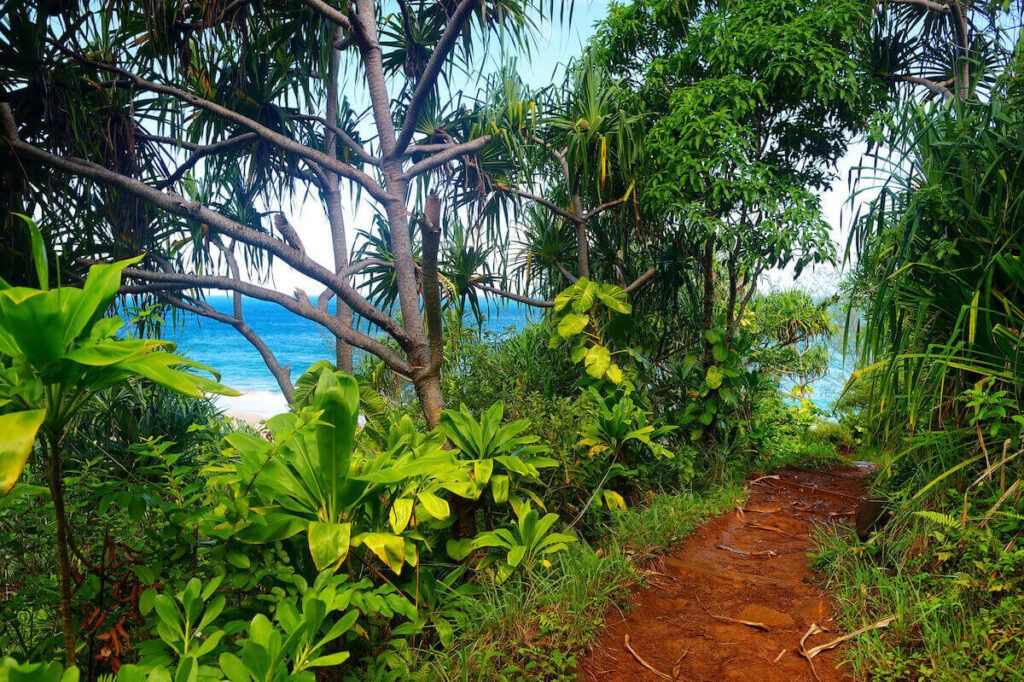
This transitional phase bathes the islands in a delightful blend of sun and breeze, making it an ideal month for those seeking a balanced tropical experience.
The month is also home to one of Hawaii’s most cherished celebrations: the Aloha Festivals .
This statewide cultural extravaganza honors Hawaii’s music, dance, and history. With parades, hula shows, and traditional chants, it’s a vibrant showcase of the islands’ rich heritage and the spirit of ‘Aloha’.
One of September’s best-kept secrets?
It’s a month that often sees fewer visitors, thanks to school sessions resuming. This low crowd advantage means quieter beaches, shorter queues at attractions, and a more intimate, relaxed Hawaiian vacation experience.
October in Hawaii: Cinema, Celebrations, and Calm
October in Hawaii greets visitors with a refreshing ambiance.
While the temperatures remain comfortably warm, there’s a noticeable increase in occasional rainfall, draping the Hawaiian islands in a fresh, rejuvenated glow.
These brief showers, often followed by rainbows, add to the magic of the Hawaiian landscape.
For film enthusiasts, October is a treat. The Hawaii International Film Festival takes center stage, showcasing a curated selection of global cinema, with a special emphasis on Pacific-Asian films and narratives.
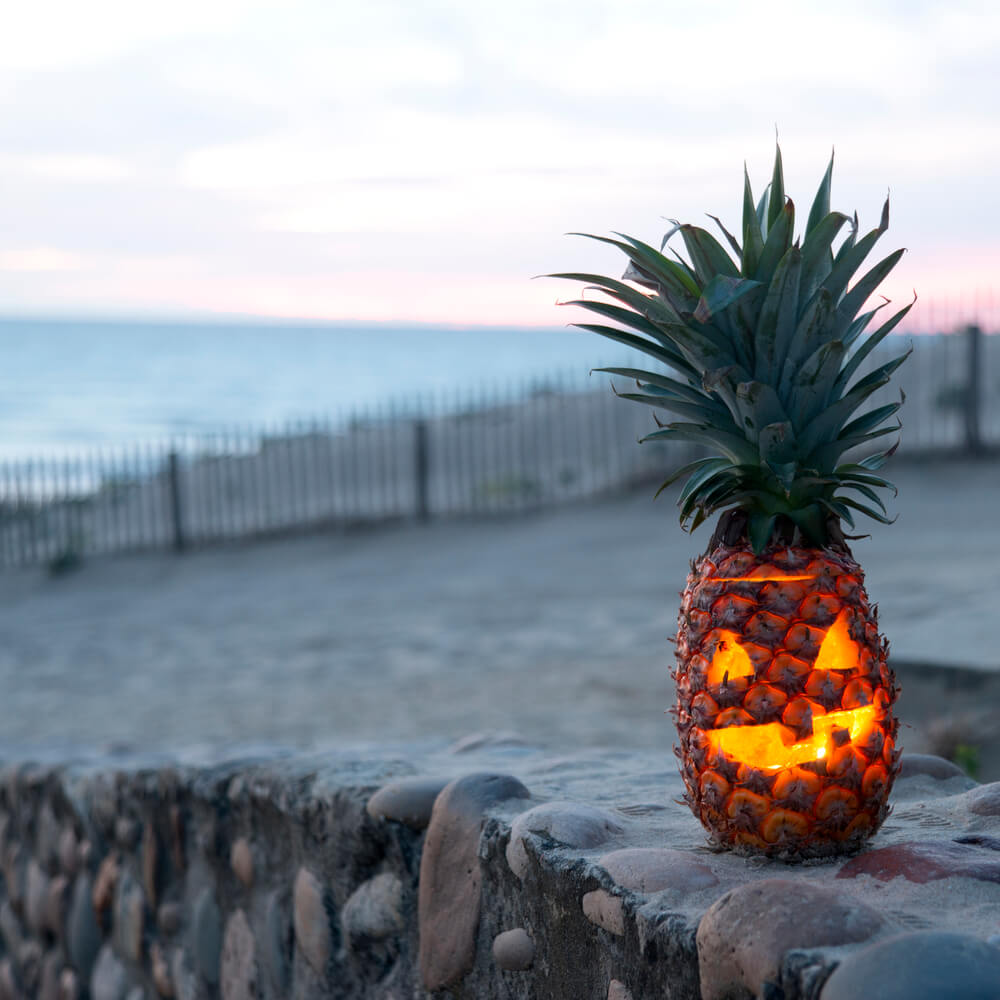
As the month concludes, Halloween festivities kick in. From themed beach parties to spirited street parades, Hawaii embraces the spooky season with its unique island twist.
Traveling in October also offers the benefits of the fall shoulder season.
With fewer tourists around, you can enjoy better deals on accommodations, reduced wait times at popular spots, and a tranquil atmosphere that makes exploring Hawaii even more serene.
November in Hawaii: Raindrops, Revelry, and Retail
November in Hawaii marks the onset of the islands’ rainy season.
While sun-drenched moments still abound, brief, scattered showers paint the landscapes in richer shades of green, offering a fresh and vibrant aura to Hawaii’s iconic vistas.
The festive mood begins to build, especially with the Waikiki Holiday Parade . Commemorating Pearl Harbor survivors and veterans, the parade is a colorful spectacle of music, floats, and Hawaiian culture that lights up Honolulu’s streets.
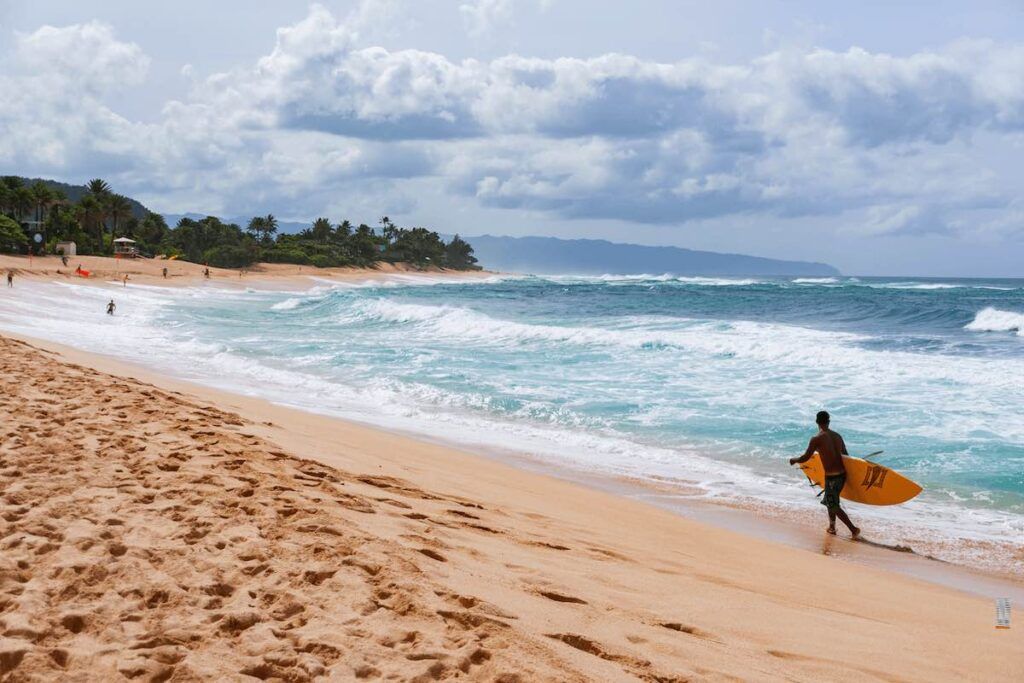
And as Thanksgiving rolls in, Hawaii adds its island flair to traditional celebrations. Imagine feasting on roasted turkey with a side of fresh pineapple and coconut pie, all with the soothing sounds of the ocean nearby!
For those eyeing holiday deals, Black Friday in Hawaii doesn’t disappoint.
From bustling malls in Honolulu to local boutiques, shoppers can find both global brands and unique island gifts, making November a blend of nature, festivities, and retail delights.
December in Hawaii: Festive Lights and Island Nights
December brings a refreshing coolness to Hawaii, with temperatures dipping just enough to remind visitors of the winter season, albeit with a tropical touch.
The occasional rain showers further enhance the Hawaiian islands’ lush beauty, setting the stage for a magical end-of-year escape.
Honolulu City Lights is a star attraction, turning the city into a radiant wonderland. Giant Yuletide figures, shimmering trees, and festive decorations line the streets, offering a captivating contrast to the palm-fringed horizons.
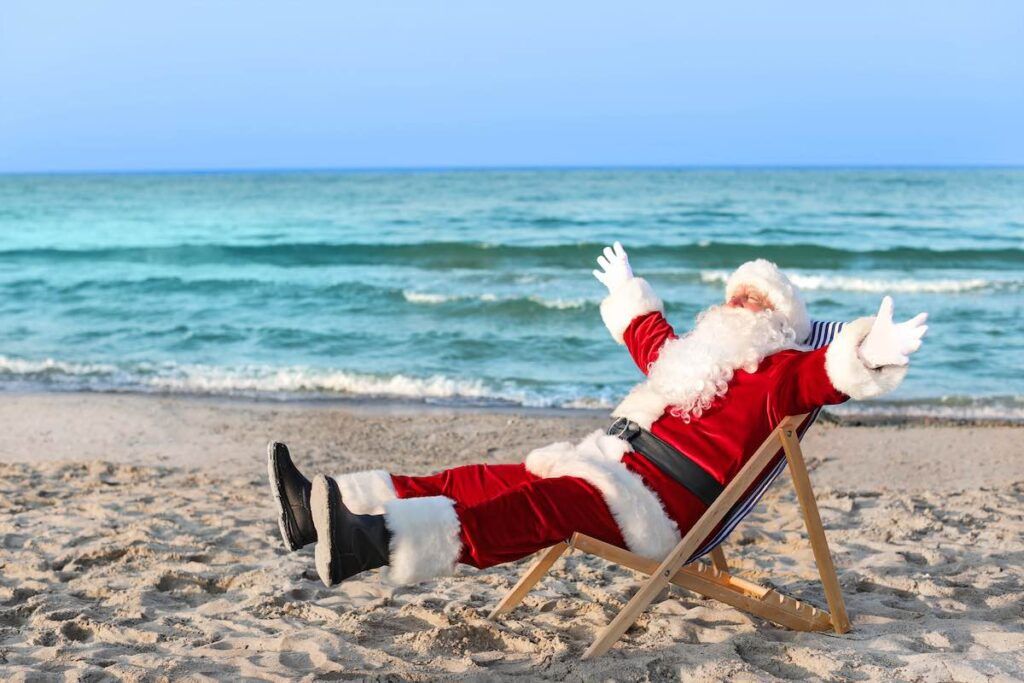
Christmas in Hawaii is a harmonious blend of traditional festivities and island customs. Think Santa arriving on a canoe or Christmas trees adorned with seashells!
As the month draws to a close, the New Year’s Eve celebrations kick into high gear.
Spectacular firework displays light up the night sky, luaus come alive with dancing and music, and the Aloha spirit ushers in a new year with hope, warmth, and joy.
Handy Hawaii Travel Tips: Be Ready for Paradise
Hawaii is a dream destination for many! To ensure you get the best deals and choices, book your flights and places to stay well in advance. You’ll save some cash and skip the last-minute stress.
Island Hopping
Why stick to just one island when Hawaii has so many treasures? Consider hopping between islands to experience a mix of adventures, from fiery volcanoes to tranquil beaches. Each island has its own unique vibe.
Hawaii’s weather can change with the season. If you’re visiting Hawaii in the summer, pack light clothes, swimsuits, and sunscreen. For winter, throw in a light jacket for cooler nights.
Always keep a rain poncho or umbrella handy—sudden showers can surprise you!
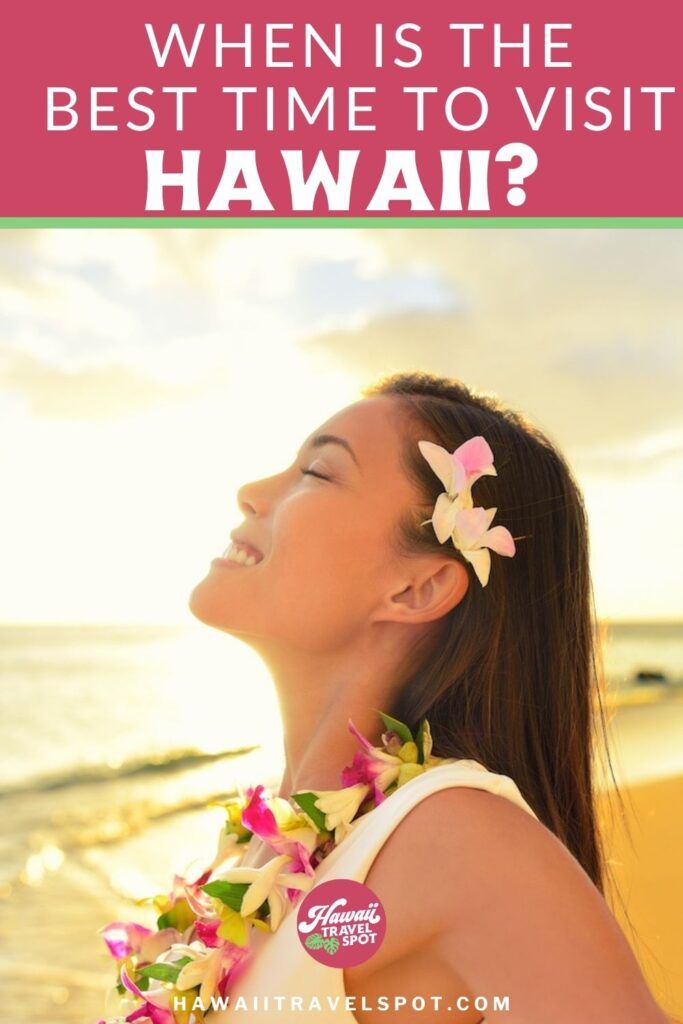
Best Time to Travel to Hawaii FAQs
What is the cheapest month to go to hawaii.
The cheapest months to visit Hawaii are typically during the off-season: mid-April to early June and September to mid-December. And Oahu is usually the cheapest Hawaiian island to visit .
However, it’s essential to consider factors like airfare sales, special hotel promotions, and other factors that could affect prices. Always keep an eye out for deals, as they can pop up anytime!
What is the rainy season in Hawaii?
Hawaii’s rainy season typically runs from November through March, although the Hawaiian islands can experience rain at any time of the year.
What is the best island to visit in Hawaii for the first time?
Oahu is often recommended for first-time visitors. It offers a mix of natural beauty, beaches, and historical sites. Honolulu, the state capital, is on Oahu and provides a blend of urban and island experiences, including Waikiki Beach, Pearl Harbor , and the North Shore.
When is the peak tourist season in Hawaii?
The peak tourist seasons in Hawaii are during the winter holidays (mid-December to early January) and summer (June to August), when families vacation while school is out.
What month is off-season in Hawaii?
The off-season in Hawaii, when tourism tends to be lower and you might find better deals, is generally from mid-April to early June and from September to mid-December.
When is the best time for whale watching in Hawaii?
The prime time for whale watching is from December to April when humpback whales migrate to Hawaii’s warm waters.
Are flights and accommodations cheaper during certain months?
Yes, the shoulder seasons, which are the periods between peak and off-peak seasons (typically April to early June and September to mid-December), often offer better deals on flights and accommodations.
When are the biggest cultural festivals in Hawaii?
Festivals like the Merrie Monarch Festival take place in April, while the Aloha Festivals are celebrated in September.
Is it a good idea to island-hop, and when’s the best time?
Island hopping lets you experience the unique character of each island. The best time depends on your preferences, but the shoulder seasons offer a good balance of weather and affordability.
How should I pack for Hawaii?
Always pack beach essentials. For summer, light clothing suffices. If you’re visiting in the cooler months or planning to explore higher elevations, bring some warm layers. Don’t forget rain gear, as showers can be spontaneous.
When is hurricane season in Hawaii?
While hurricanes are rare, Hawaii’s hurricane season is from June to November. It’s always a good idea to check forecasts and have travel insurance .
Book a Hawaii Photo Shoot
Whenever we travel to Hawaii, we almost always book a photo shoot with Flytographer. They are super easy, affordable, AND it guarantees that I’ll have more than just selfies. You can get $25 off if you book through this link or use the code HAWAIITRAVEL.
Best Time of Year to Travel to Hawaii Wrap Up
So, when’s the best time to visit Hawaii? Well, every month has something cool to offer! If you love sun and beach fun, summer’s perfect.
If festivals are your thing, spring and fall have some great events. And if you enjoy watching whales and cooler days, winter’s your season.
Remember, Hawaii is special all year long. It’s always filled with the friendly “Aloha” feeling. It’s a good idea to think ahead about what you want to do and see. That way, you can pick the best month for your trip.
No matter when you choose to visit, get ready for awesome adventures, from rainy days to sunny beaches. Hawaii is always ready to make your trip special, any time of the year.
So, when are you packing your bags?
Looking for more Hawaii travel resources? Check out my top planning tips for Oahu , Maui , Kauai , and the Big Island !
Leave a comment cancel reply.
Save my name, email, and website in this browser for the next time I comment.
READY TO PLAN YOUR TRIP TO HAWAII?
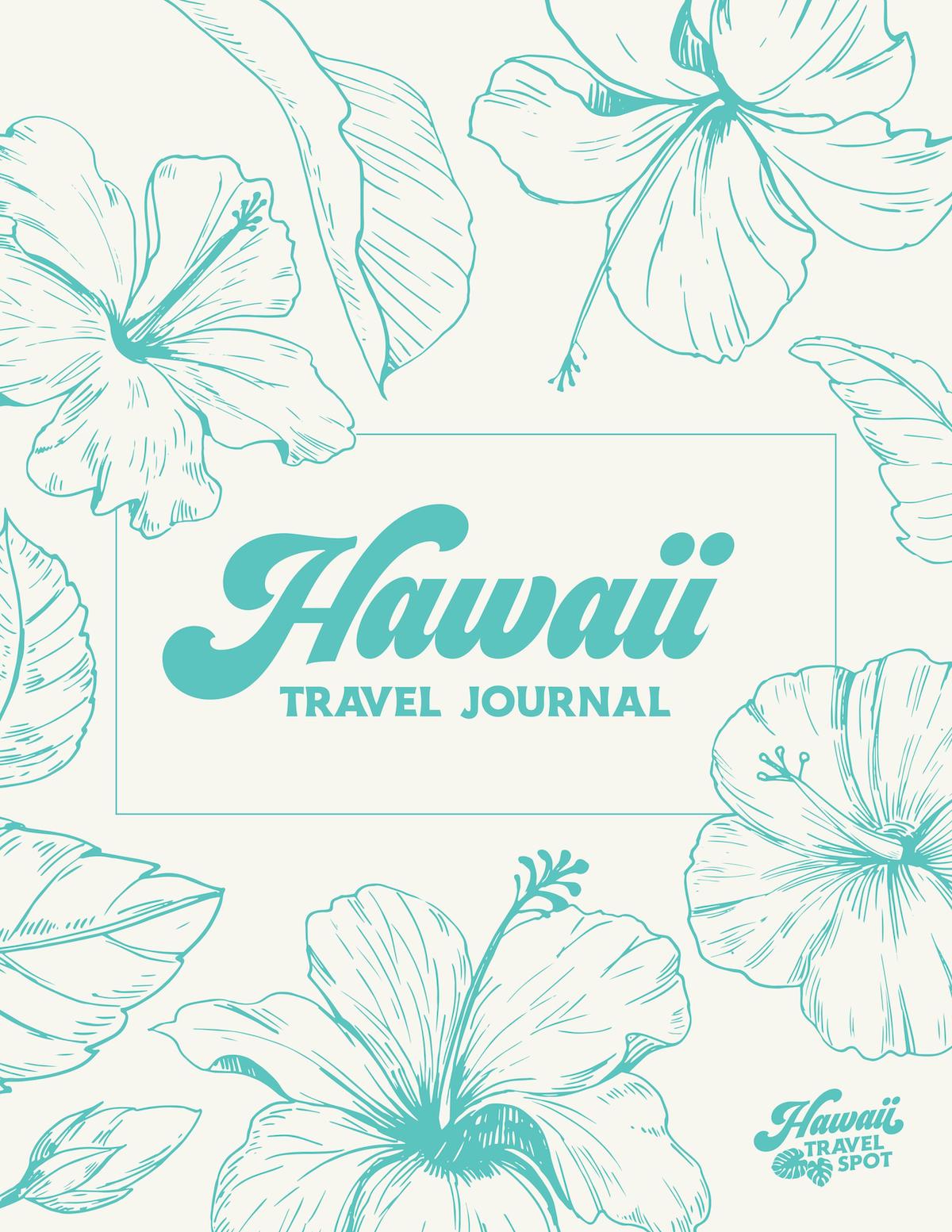
This Step-by-Step Workbook & Journal Will Help!
- Search Please fill out this field.
- Manage Your Subscription
- Give a Gift Subscription
- Newsletters
- Sweepstakes
- Travel Tips
The Best Time to Visit Hawaii for Low Prices and Beautiful Weather
These are the best times to visit Hawaii, according to your travel preferences.
:max_bytes(150000):strip_icc():format(webp)/cailey-rizzo-author-page-pic-7f06c5208014435080678b3158fc7861.jpeg)
Elizabeth Rhodes is a special projects editor at Travel + Leisure , covering everything from luxury hotels to theme parks to must-pack travel products. Originally from South Carolina, Elizabeth moved to New York City from London, where she started her career as a travel blogger and writer.
:max_bytes(150000):strip_icc():format(webp)/elizabeth-rhodes-25083778bc654f69b30ce8417affc82c.jpg)
Hawaii is a perennially popular destination for many reasons. The Aloha State is home to an extraordinary culture, pristine landscapes, and idyllic beaches. If you're searching for the best time to visit Hawaii, we've got you covered. The islands are beautiful at any time of year, but individual preferences can dictate the best time to book your tropical vacation. To help you decide, you can think of the state's calendar in the following way.
- High Seasons: June to July and the month of December
- Shoulder Seasons: January to May and August to November
Whether you want to save a few bucks, find uncrowded attractions, or spot a majestic humpback whale, here are the best times to visit Hawaii.
Michela Buttignol/Travel+Leisure
Most Popular Times to Visit Hawaii
With an annual visitor count that regularly approaches 10 million, Hawaii is beloved throughout the year. However, some periods are busier than others. According to the Hawaiian Tourism Authority, the most popular months for tourists are almost always June, July, and December (in some configuration). July usually takes the top spot — as it did in 2022, when it drew more than 919,000 visitors to the islands.
This aligns with the fact that Hawaii is a popular destination for families during school breaks. Summer vacation attracts many travelers, and so does winter break, especially among visitors from cold climates who'd like to spend their holidays singing "Mele Kalikimaka" on a warm, sunny beach .
Spring is another time that can draw considerable crowds. In addition to bringing American spring breakers, spring also draws Japanese travelers celebrating the so-called Golden Week , a stretch in late April and early May when four holidays are celebrated over seven days.
Best Times to Visit Hawaii for Smaller Crowds
Since school breaks are the most popular times in Hawaii, the months when school is in session tend to draw the smallest crowds. February and September consistently rank near the bottom of the tourism board's list of busiest months — in 2022, they saw 630,000 and 703,000 visitors respectively — and the months surrounding them tend to be quiet, too.
Given the holidays that happen in the spring, though, fall is perhaps the best time to plan a trip if you're looking for a long stretch of uncrowded days. There are fun events to be found at this time of year, too, like the Aloha Festivals in September and October's Hawaii Food & Wine Festival.
Best Times to Visit Hawaii for Good Weather
The weather in Hawaii is consistently warm, with temperatures slightly lower in the winter months (November to April) than in the summer (May to October). Hawaii's average daily winter temperature at the beach is 78 degrees Fahrenheit, while the average daily summer temperature is 85 degrees, according to the Hawaiian Tourism Authority . Water temperatures are usually pleasant, too: they average around 74 degrees most of the year but inch up to around 80 degrees in the summer.
Rainfall is at its lowest in Hawaii from April through October, but even the wetter winter months aren't too bad. Rain is most common on the northeastern (or windward) sides of the Hawaiian islands , meaning sunseekers can stick to the leeward southwestern edges for the best chance of clear skies. Hawaiian rain showers are also famous for producing rainbows — so drizzly days have their perks.
The timing of severe weather can sometimes be hard to predict, since tropical storms and cyclones can happen year-round in the Pacific. But the Hawaii Department of Health warns that hurricane season officially runs from June through November.
Best Times to Visit Hawaii for Lower Prices
Hawaiian Airlines reports that traveling to the state is generally cheapest in the shoulder seasons of late spring and early fall — and they should know, considering they operate both nonstop flights to Hawaii from the United States, Asia, and the South Pacific, as well as inter-island flights that can get you from one Hawaiian island to another. For more savings, the airline suggests booking your flights so you're arriving and departing on weekdays, not weekends. Generally speaking, hotel rates soar in Hawaii during the Christmas and New Year holidays in late December and early January, and again during spring break and summer vacation dates. So, if you want to cut costs on both accommodations and airfare, avoid those times of the year.
Another way to visit without worrying about airfare and hotel costs is to hop aboard a Hawaiian cruise . Choose an itinerary that visits outside of the peak tourist seasons, and you'll have great odds of experiencing all that Hawaii has to offer without any exorbitant on-shore costs.
Best Times to Go Surfing in Hawaii
Visitors and locals can surf year-round on Hawaii's famous waves, but there are a few things to keep in mind if you're planning to hang ten . Waves are usually larger during the winter months, says the Hawaiian Tourism Authority, especially on the islands' north-facing shores, so conditions aren't ideal for beginners learning to surf.
If you want to watch the experts tackle some big waves, though, this can be a fun time to visit. Some of the world's greatest surf contests happen in Hawaii during the winter, like the Vans Triple Crown — held on Oahu's North Shore every year since 1983 — and the Eddie Aikau Invitational , held any winter when waves consistently reach 40 feet in height.
Best Times to Go Whale Watching in Hawaii
Humpback whales can be seen off the islands' coasts from December through May, so visitors who come to Hawaii with whale watching in mind will be in luck for much of the year. The peak of the season is generally considered to be January, February, and March — that's when the National Oceanic and Atmospheric Administration calls on the public to help monitor whales and contribute to its annual Sanctuary Ocean Count .
Worst Times to Visit Hawaii
In an environment as beautiful as Hawaii, it's hard to call any season a "bad time" to visit. But if you want to avoid high prices and giant crowds at the islands' most popular destinations , you might consider skipping the busy months of June, July, and December.
No matter when you visit, bear in mind that Hawaii has a unique ecosystem and a vibrant Indigenous culture — both of which have sometimes been put at risk by overtourism. If you travel to the islands, do so responsibly by respecting the locals you meet, keeping a safe distance from wildlife, and patronizing Hawaiian-owned businesses when you can. Be sure, as well, to prepare adequately for any outdoor activities you want to try. There's never a good time to be stuck on a steep mountain trail or stranded in choppy waters!
Related Articles
The best time to visit Hawaii

Feb 2, 2024 • 6 min read
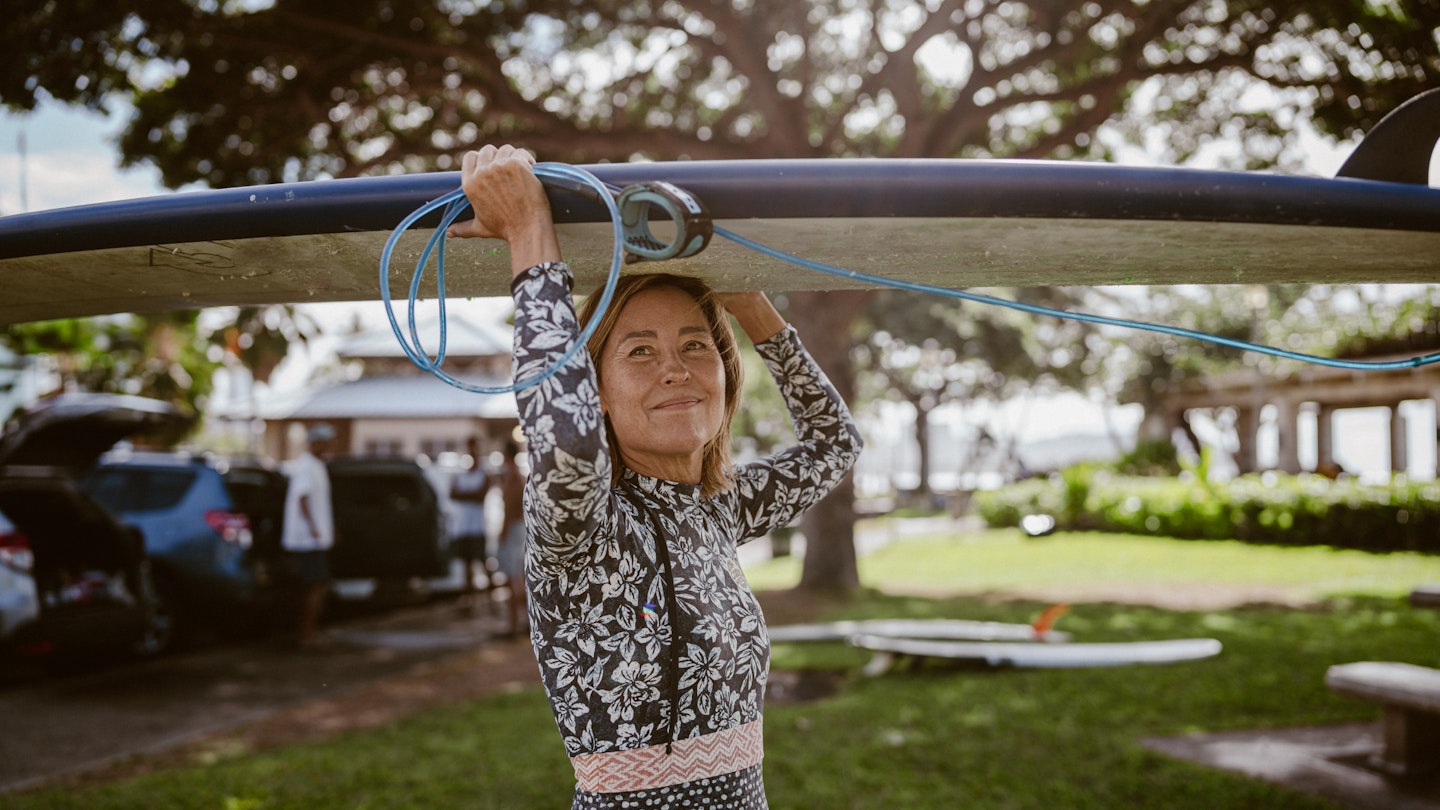
There's really no bad time to visit Hawaii © Fly View Productions / Getty Images
With year-round sunshine and balmy weather, any time is a great time to visit Hawaii . But while there are no major seasonal changes in the Islands, there are subtle differences in weather, crowds and prices throughout the year.
Most visitors travel during breaks, so summer and mid-spring are busy. But the busiest time in Hawaii is actually winter – specifically the last two weeks of December through early January – as people flee cold climates for sunny beaches and warm weather. During this peak time, prices for airfare and hotels are the highest. You'll find cheaper rates during late spring and fall, before Thanksgiving.
During the summer, the average daytime temperature is 85°F; in the winter, it's 78°F. But summer tends to be drier and hotter; winter is often rainy and wet. For more tips and advice, read on before you plan your next vacation to the Islands .
June to August is busy, but the weather is perfect
If you want to experience Hawaii at its best, visit during the summer. The days are long and languid, the weather is almost always sunny, and there's so much to do. But schools are out on summer break, making this a peak season for traveling to the Islands. Expect higher prices on airfare and hotels and longer lines at popular attractions. Reservations for things like Hanauma Bay on Oʻahu and sunrise at Haleakalā National Park on Maui may be harder to nab.
Surf is up on south-facing shores – like Waikiki on Oʻahu and Poʻipu on Kauaʻi – and outdoor events and festivals are happening on every island. June starts with the annual King Kamehameha Celebration Floral Parade through Waikiki. Every weekend, Japanese temples host bon dances at night, with traditional dancing, music and food. On Maui, there's the annual Kapalua Wine & Food Festival , Maui AgFest and Maui Film Festival .
Every island has a county fair, with keiki (kids) rides, live entertainment and food booths. And surfing is celebrated at the annual Duke's OceanFest in August, a weeklong festival in honor of the legendary Duke Kahanamoku, with surf contests, surf polo, swimming, stand-up paddling and Hawaii's only dog surfing competition.
Most plumeria trees will be in full bloom, and it's also mango season, so expect lots of mangoes on the menu in restaurants and at farmers markets across the state.
September to October is the cheapest time to visit
Fall is typically the slower season for travel in Hawaii – you'll run into fewer crowds but still enjoy warm temperatures, averaging a high of 88°F. Airfare from the US mainland is usually at its lowest, and finding deals (and rooms) at hotels will be easier.
Evenings are balmy – perfect for a quiet dinner at an oceanfront restaurant – and the ocean is actually the warmest it will be all year. It's still hurricane season until November, though, with most hurricanes hitting the Islands in late summer and early fall.

November to January is the best time to escape winter — but expect crowds
It's no surprise the winter months are Hawaii's busiest – you can still lounge on the beaches here and bask in the sun. The days start getting shorter in late fall, and November, namely Thanksgiving weekend, signifies the start of Hawaii's busiest travel period. Rooms may be hard to get, so book early if you're planning a trip to Hawaii during this time. This is also the priciest season, though you can sometimes score deals on airfare.
Winter months bring monster surf to the north shores of all islands. Professional surfers flock to Oʻahu's fabled North Shore for contests, including the Triple Crown of Surfing and the Eddie Aikau Big Wave Invitation – both exciting to watch from shore. (Don't attempt to get in the water when the surf's up.) The Honolulu Marathon happens in December, when thousands of people hit the roads from Waikiki to Hawaiʻi Kai.
Starting in November, humpback whales – called kohola in the Hawaiian language – start their annual return to Hawaii to breed, birth and nurse calves. An estimated 8000 to 12,000 migrate from Alaska to the Islands' warm, shallow waters from November through April, and the protected marine mammals can be seen from every island.

February and early March are often rainy and slow
Late winter brings good news for budget travelers and anyone looking for a more relaxing vacation: you can often find discounts on airfare and hotels, and beaches, hiking trails and popular attractions aren't nearly as crowded as during the peak summer and winter seasons.
Winter months tend to be rainier than summer, but the showers are usually localized and don't last that long. This is a great time to hit farmers' markets – every island has them! – as avocados, citrus, lychee and other tropical fruits are still in season.
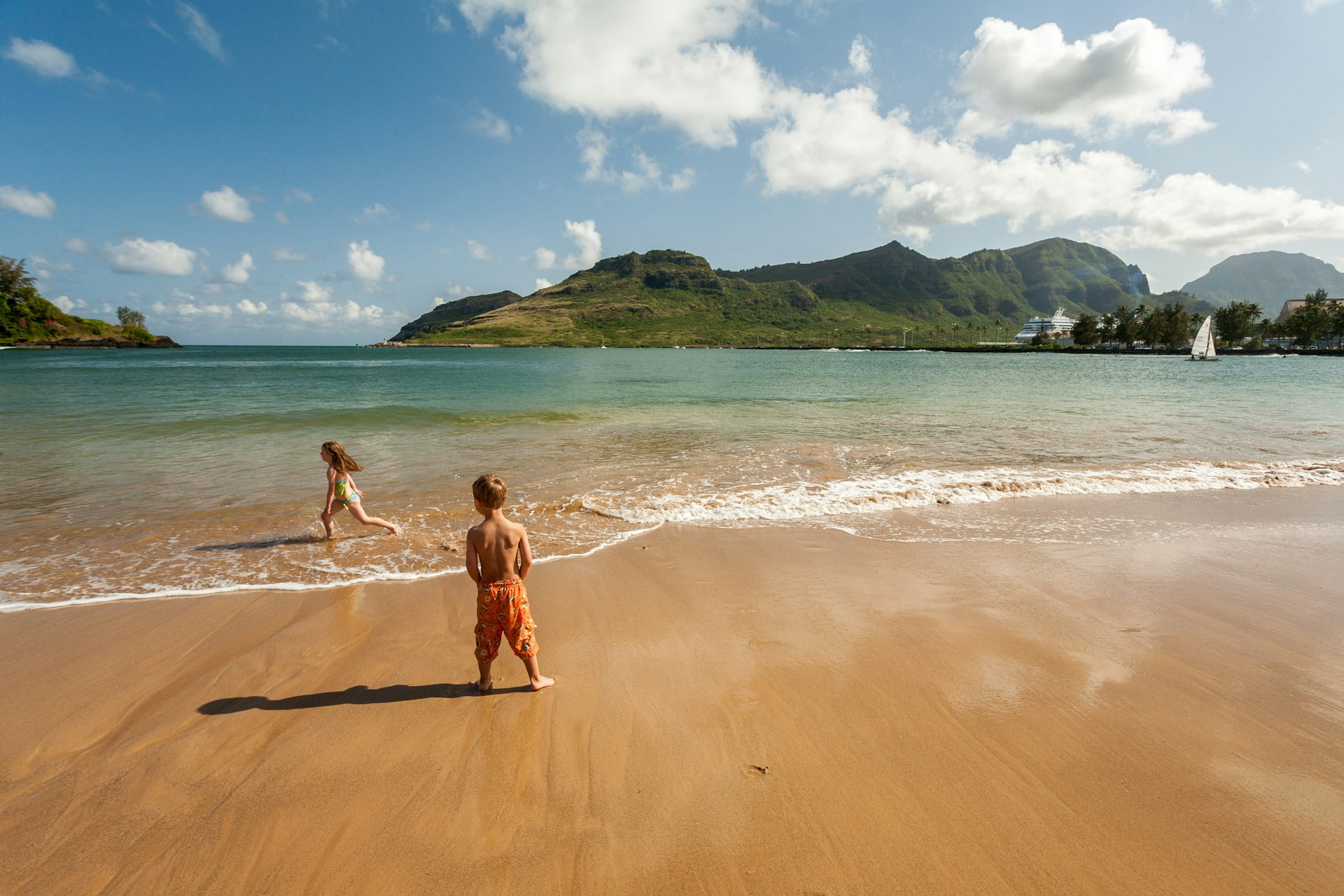
Mid-March to early April is an ideal time for families
With the exception of spring and Easter breaks, spring is a slower time of year for travel. But when schools are out, it's another peak season. The prices aren't as high as they are in the summer and winter months, though, and the weather is cool and comfortable, not summery hot – perfect for outdoor adventures with kids.
It's a nice time to walk through zoos – the Honolulu Zoo on Oʻahu is the largest in the state, but the Panaʻewa Rainforest Zoo & Gardens in Hilo is charming, with a great playground and botanical gardens. The ocean is fairly calm during this period, making it great for snorkeling and swimming.
And if it rains, there's plenty to do indoors. Oʻahu has a few indoor playgrounds, including Kids City in Honolulu and Kapolei, Hawaii Children's Discovery Center in Kakaʻako and the new Keiki Kingdom , with the largest ball pit on the island. This is also a great time to take in a luau, which can often be sold out during busier seasons.
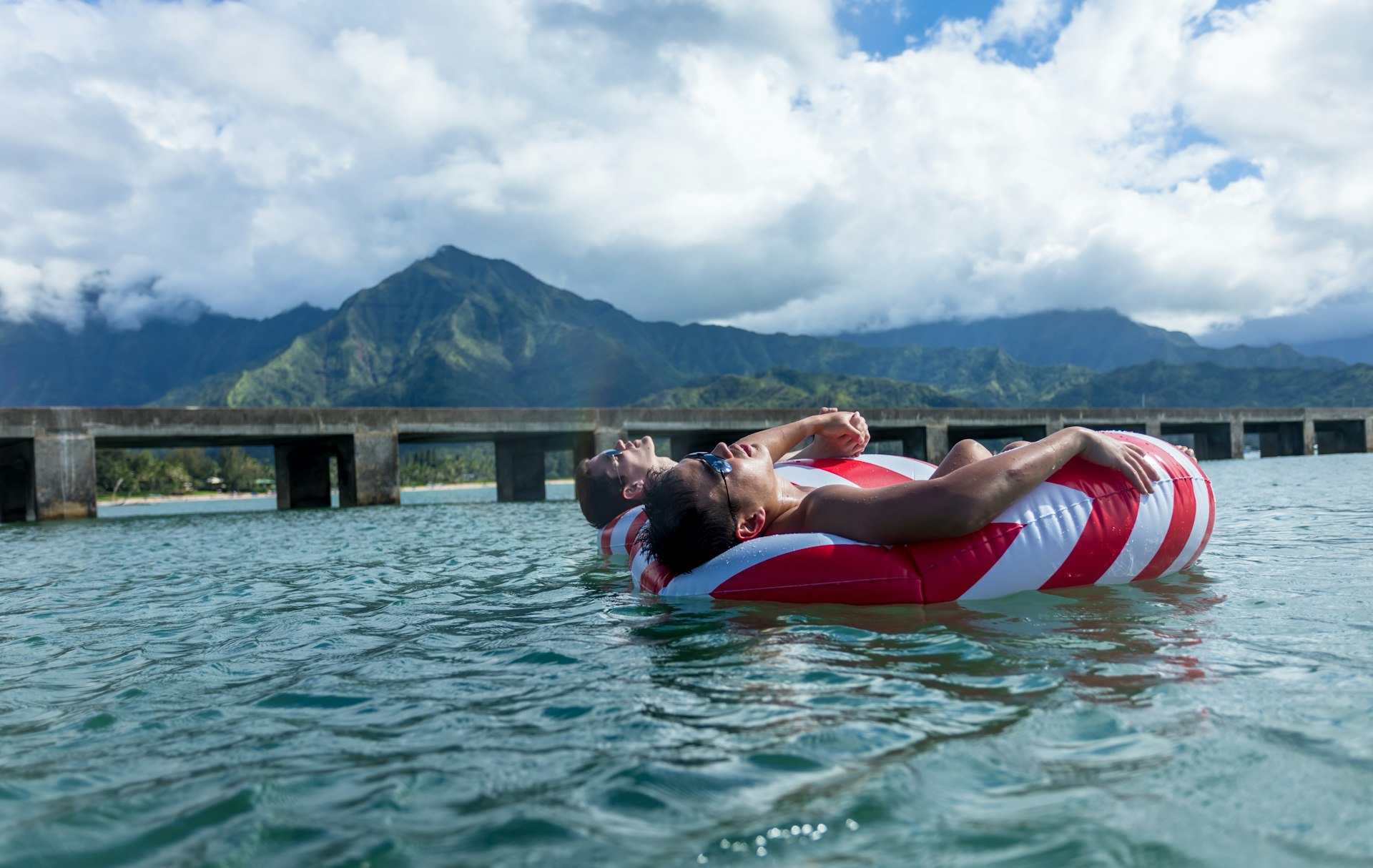
May to June is best for couples
Hawaii is one of the most romantic places in the world, and heading there during a slower time – fewer visitors, emptier beaches – makes for an even more magical trip for the lovers out there. This is just before the peak-summer travel time, so you'll likely find cheaper flights and accommodations.
Temperatures are in the mid-80s, and the weather isn't as rainy as in early spring, which means it's a great time to hit hiking trails, walk along beaches and explore charming neighborhoods, like Kailua on Oʻahu, Paia on Maui and Hanalei on Kauai. This is also a great time to visit Hawaii Volcanoes National Park , as it's not as crowded or rainy. (Still, if you're hiking through the park, you should bring rain gear just in case.)
This article was first published Apr 16, 2021 and updated Feb 2, 2024.
Explore related stories
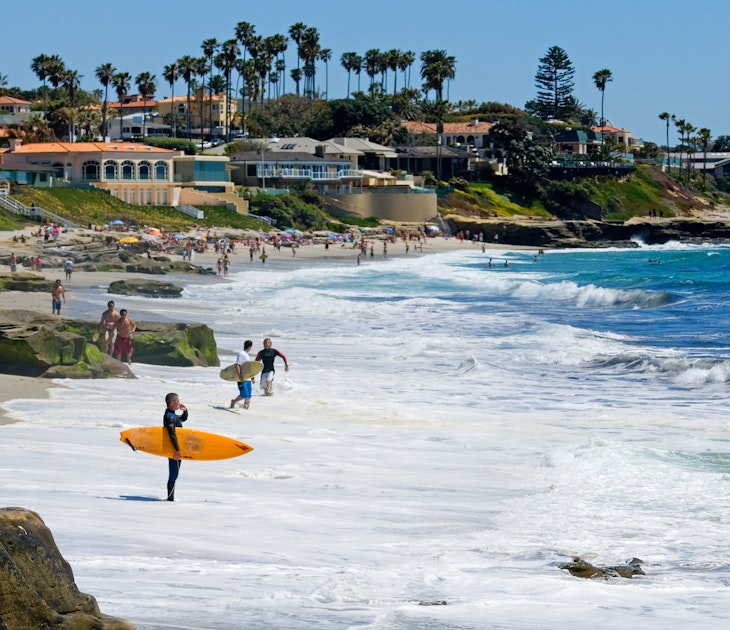
Tips & Advice
May 3, 2024 • 12 min read
The summer months are the USA’s busiest travel season. Plan your vacation with these top places to visit.
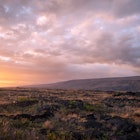
Apr 18, 2024 • 11 min read

Mar 28, 2024 • 19 min read
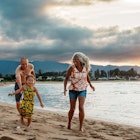
Mar 5, 2024 • 13 min read

Feb 15, 2024 • 7 min read

Feb 1, 2024 • 7 min read

Jan 27, 2024 • 15 min read

Dec 27, 2023 • 8 min read

Nov 17, 2023 • 10 min read
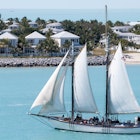
Nov 16, 2023 • 6 min read
Advertiser Disclosure
Many of the credit card offers that appear on this site are from credit card companies from which we receive financial compensation. This compensation may impact how and where products appear on this site (including, for example, the order in which they appear). However, the credit card information that we publish has been written and evaluated by experts who know these products inside out. We only recommend products we either use ourselves or endorse. This site does not include all credit card companies or all available credit card offers that are on the market. See our advertising policy here where we list advertisers that we work with, and how we make money. You can also review our credit card rating methodology .
The Best Times To Visit Hawaii in 2023 [By Seasons & Islands]
Lindsey Olander
Former Content Contributor
23 Published Articles
Countries Visited: 24 U.S. States Visited: 25
Keri Stooksbury
Editor-in-Chief
34 Published Articles 3178 Edited Articles
Countries Visited: 47 U.S. States Visited: 28
![hawaii low tourist season The Best Times To Visit Hawaii in 2023 [By Seasons & Islands]](https://upgradedpoints.com/wp-content/uploads/2020/05/Maui-Sunset.jpg?auto=webp&disable=upscale&width=1200)
Island of Hawaii (“Big Island”)
Final thoughts.
We may be compensated when you click on product links, such as credit cards, from one or more of our advertising partners. Terms apply to the offers below. See our Advertising Policy for more about our partners, how we make money, and our rating methodology. Opinions and recommendations are ours alone.
Hawaii’s 137-island archipelago occupies an ideal position in the North Pacific Ocean. U.S. passports aren’t required to visit its tropical shores, yet it’s far enough away to feel like a true escape. In fact, it’s hard to believe that Hawaii is a state at all, what with its dreamy beaches, unique island culture, and near-perfect weather that remains warm and beautiful year-round.
Unfortunately, beauty comes at a price — especially during peak season, when paradise-seeking crowds pour onto its sands and fill up its resorts. Hawaii’s popularity and distance from the mainland mean a visit is rarely cheap, especially for those flying in from the East Coast.
That’s why the best time to visit Hawaii is during the season that fits your preference and a price you can afford. Every month has its pros and cons, so when you choose to go all comes down to your top priority, be it affordable rates, consistent sun, better chances at spotting wildlife, or stellar surfing conditions.
The Best Time to Visit Hawaii by Season
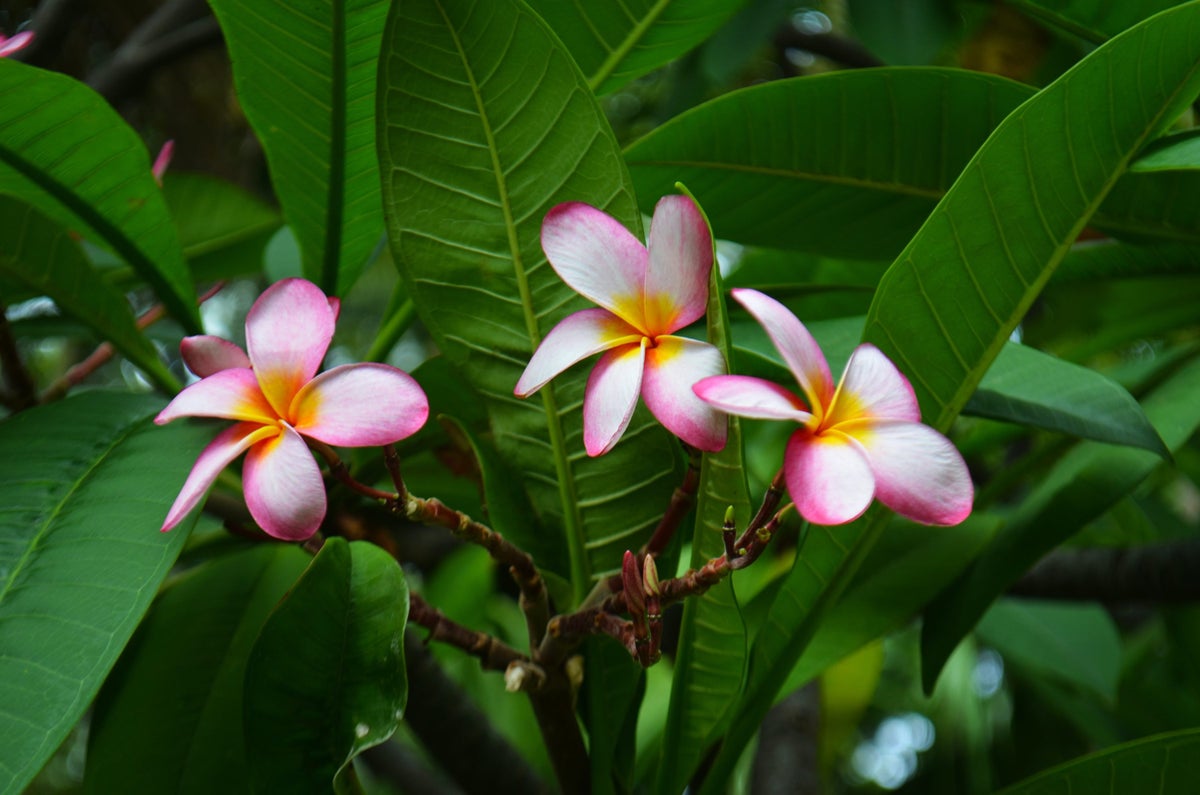
Hawaii’s weather stays relatively consistent year-round, so the state’s shoulder seasons also coincide with its low seasons. The arrival of spring marks Hawaii’s first shoulder season .
After the holiday excitement has come and gone, snowbirds head back to school and to work, trade winds and rain die down considerably, and daily temperatures begin to rise, spurring seasonal fruits and flowers — plumeria plants, jacaranda trees — to bloom once more.
Spring also means Hawaii’s whale-watching and surfing seasons are coming to a close . Winter’s big waves begin to calm down — ideal conditions for beginner surfers to test their legs — while luaus and spring festivals are equally immersive (if land-bound) ways to spend time on the islands.
Hawaii’s rainy season ends in March. Days are temperate while nights are cool , so pack a jacket. The tail-end of whale-watching season extends through the month, when breaching humpbacks can still be spotted off the coasts of Maui and Hawaii (known as “the Big Island”).
Although March is still considered low season in Hawaii, prices skyrocket around Spring Break . Schools unleash hordes of students and families taking advantage of their kids’ time off, causing flight and hotel rates to rise to meet demand.
If you’re on a budget, avoid early March as much as possible. By the end of the month, ticket prices should drop considerably and continue to do so through April and May.
Hot Tip: Save even more on airfare with the help of our guide on the best ways to fly to Hawaii using points and miles .
Hawaii’s best spring weather is often experienced in April and May , when the dry season officially begins and daylight hours are more consistently warm and sunny.
Despite these near-ideal conditions, April sees far fewer crowds than summer or winter, making it one of the quietest, most affordable months to visit any of the islands.
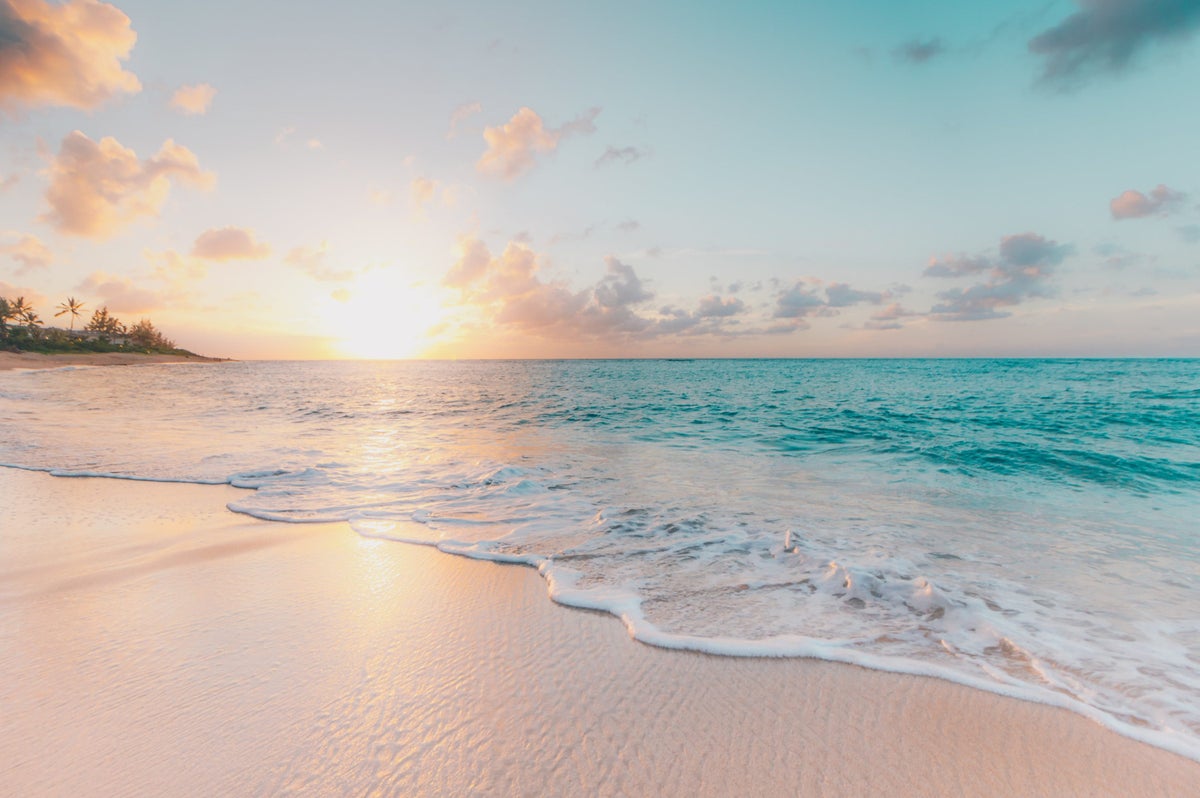
Like all holidays, inflated airfare and hotel rates coincide with Easter weekend as well as Golden Week — the last week in April is Japan’s peak travel time — though prices should level off again by May.
Even less rainy than April, May in Hawaii is glorious. The sun is out, the days are long, and the waters are calm — perfect conditions for snorkeling, diving, swimming, and spending as much time as possible by the beach .
Plus, crowds are few and far between , so hotel rates are low, reservations at oceanfront restaurants are easy to come by, and there’s lots of room on the beach to spread out.
Hot Tip: Do you have some points burning a hole in your pocket? Check out our guide to the best Hawaii hotels to book with points for some vacation inspiration.
Hawaii heats up during the summer, and we’re not just referring to the humidity. Summertime is one of the busiest, priciest windows (barring the holidays) to fly to the Hawaiian Islands.
Days are hot and muggy — temperatures hover around the low 90s — but more importantly, school is out around the country, meaning both locals and vacationing families vie for prime spots on Hawaii’s beaches and book out its hotels in record numbers.
Yet despite how expensive and crowded summer gets, it’s impossible to hate on those endlessly sunny days. Hiking and snorkeling conditions peak during summer , when the trails are driest and the waters are calmest. This is also nesting season for sea turtles, which are a favorite sighting.
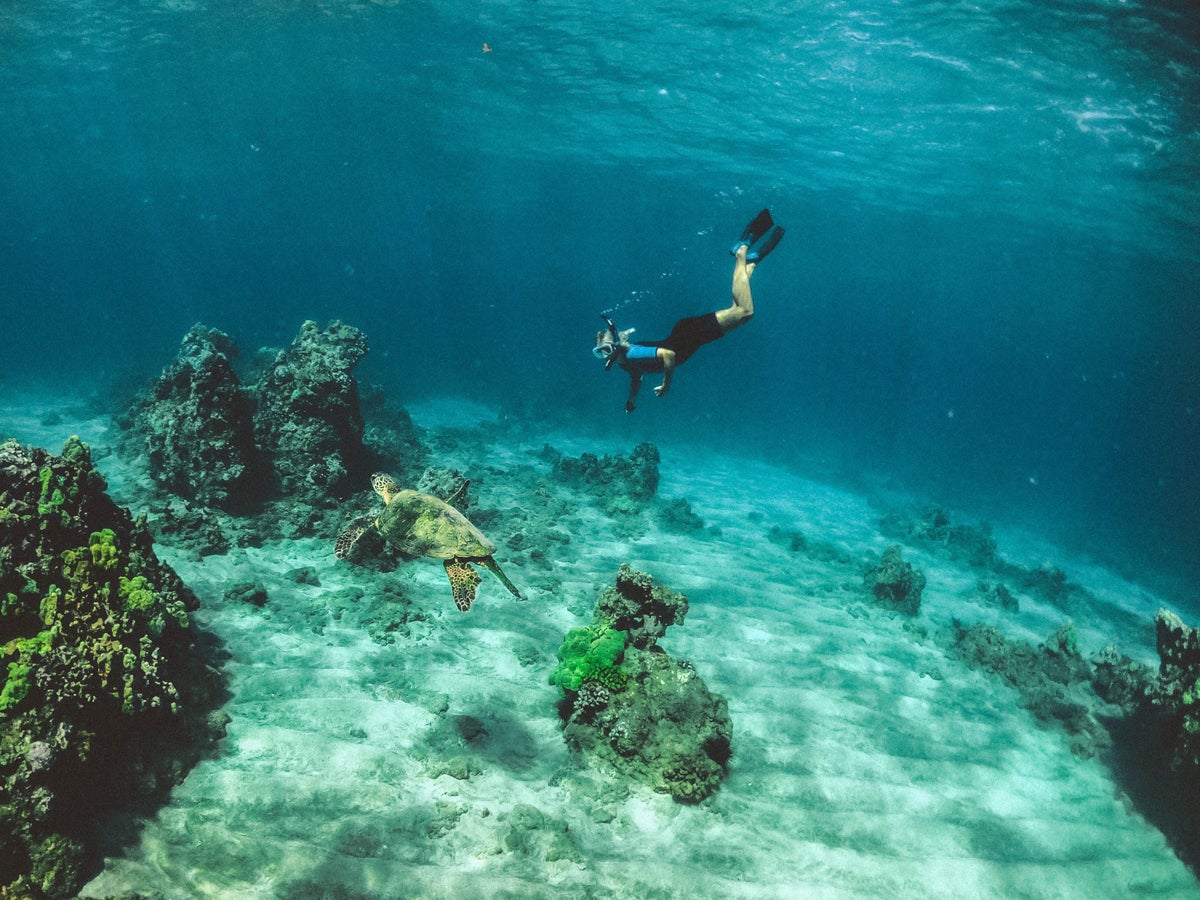
While dry season’s lack of rainfall is a blessing for some, waterfalls are at their weakest during the summer months. If snapping a selfie by a waterfall is on your bucket list, you might want to postpone your visit until the rainy season resumes, when cascades return in full force.
Sun-seekers love June. Hawaii’s driest month is bright and warm, free from humidity and heavy rainfall. The official start of summer also means airfare and hotel rates begin to increase as schools begin to close and vacationers scramble to log their first summer getaway.
That said, airfare in June is still more reasonable than what you’d find during winter, which might be why this month welcomes much larger crowds.
Similar to the Caribbean, June signals the start of Hawaii’s hurricane season , which lasts through November. Although rare, hurricanes and tropical storms do make landfall, so be sure to check weather reports and, if necessary, postpone your trip. The safest decision is the best one.
Hot Tip: Don’t let inclement weather ruin your Hawaiian vacation! Our introductory guide to travel insurance helps break down the detailed ins and outs of what your travel insurance policy covers so that you can get the maximum benefit from it.
By now, most schools are closed for the summer, which makes July Hawaii’s busiest month . If you’re looking to avoid crowds, you might want to skip Oahu (especially Waikiki) and Maui, whose resort-lined beaches fill up the fastest.
In July, temperatures across Hawaii are at an all-time high while beaches previously off-limits due to their rough winter conditions are now open for snorkeling, swimming, and surfing for beginners. Unlike June, humidity starts to become a factor , though, for many, that simply comes with the territory of spending time in a tropical climate zone.
Families planning a trip to Hawaii in August should book far in advance — this is the height of summer , when September (and school) is still out of mind. Temperatures peak, soaring into the high 80s, and crowds continue to pack beaches, making hotel rates surge.
If you’re looking for a deal, prices and crowds tend to drop later in the month as families head back home to prepare for the start of school.
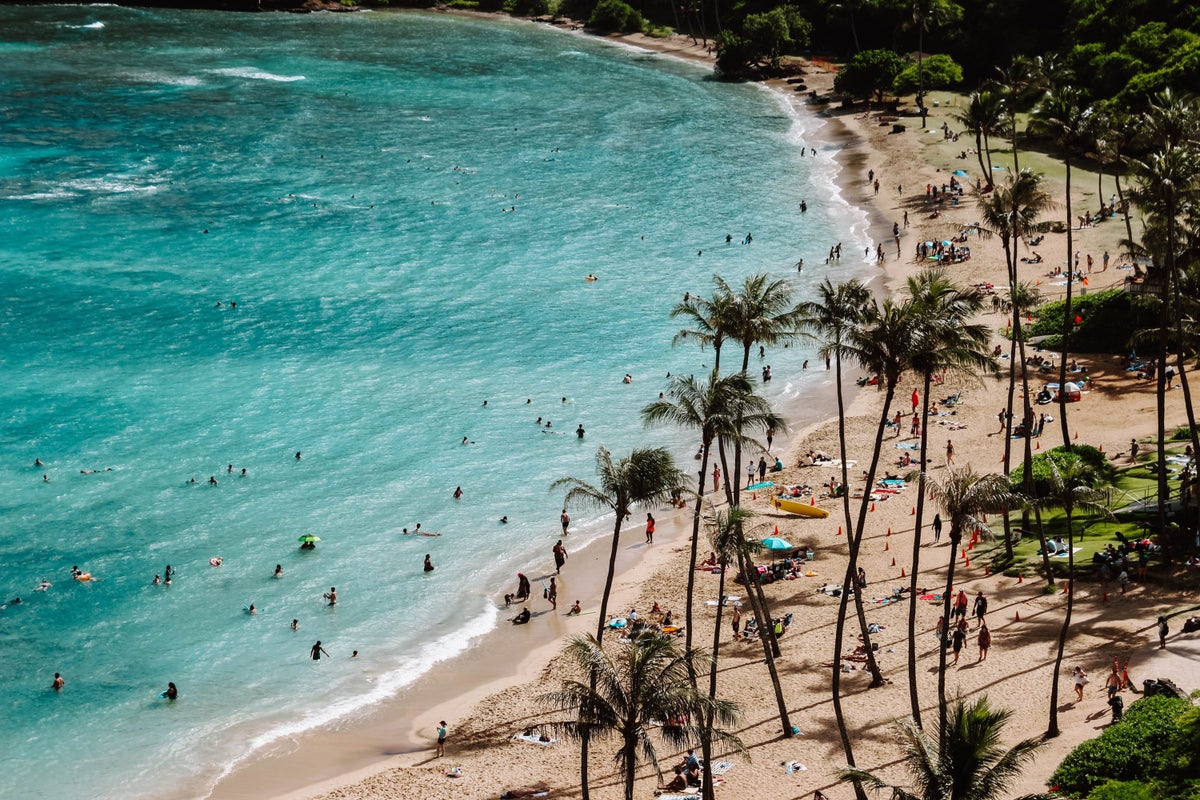
Hawaii’s second shoulder season comes in the fall, when students resume classes and parents pack up the summer gear and return to work.
Although rain begins to fall more regularly, the weather has never been better, which is why fall is widely considered to be one of Hawaii’s most beautiful seasons . The ocean waters are the warmest they’ve been all year — an after-effect of continuous exposure to summer’s hot sun — while nights are cool and the dry season welcomes one cloudless day after another.
Aside from Thanksgiving, fall is also an affordable time to visit . Now that school is back in session, anyone that chooses to travel will have a better chance of finding fantastic deals. Keep in mind, though, that hurricane season peaks in August and September. Investing in travel insurance might be wise if you’re forced to move your travel dates.
September is beautiful — one of the best months to visit Hawaii, weather-wise , and when ocean temperatures peak at 81 degrees — but travelers should be wary.
Hurricane season is still in full effect , and jumps in airfare and hotel prices are known to happen at the beginning of the month, when vacationers try and squeeze in 1 last getaway before summer ends and school begins. After classes restart, expect the crowds to dissipate and flight and hotel rates to plummet — and remain low right up until the holidays.
Hot Tip: Check out our ultimate travel guides to Hawaii for more ideas on what to do and where to stay during your next Hawaiian vacation, including top attractions, recommended restaurants, and hidden beaches. We’ve got guides on Maui and Kauai and Oahu, Big Island, and Lanai .
The humidity of summer lifts in October, which brings clear, warm days — temperatures average in the mid-80s — and slightly cooler nights. Since Hawaii’s dry season is coming to a close , rain starts to occur more frequently in the forecast. Aside from Labor Day weekend, hotel rates in October also trend low.
One of the biggest draws of the month is the 3-week-long Hawaii Food and Wine Festival , which is held across the Big Island, Maui, and Oahu. Its big-ticket lineup of dinners, cooking classes, and parties celebrating Hawaiian cuisine draws foodies from around the globe.
With the exception of Thanksgiving week, November is one of the quietest months across the Hawaiian Islands. The last month of hurricane season also signals the start of rainy season, so days continue to get cooler and wetter.
Winter is also on the horizon, and surfers begin to emerge to take advantage of shorelines’ growing swells. In November, major surfing competitions start to take place on Oahu’s North Shore.
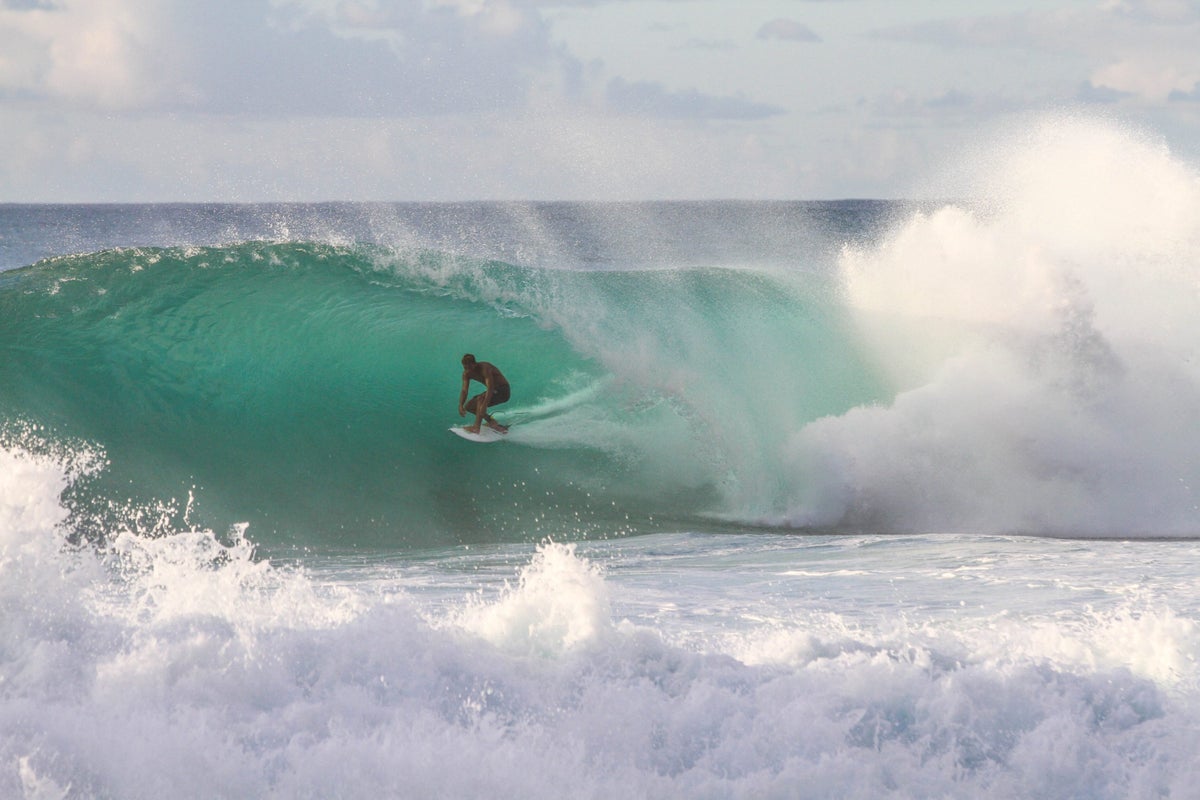
The holidays are an expensive time of year, and winter in Hawaii is no different. From as early as Thanksgiving through the New Year, it consistently ranks as one of the busiest and priciest seasons to book a flight.
Despite being Hawaii’s wettest and “coldest” time of year , with temperatures dipping into the high 70s, tropical paradise is an obvious escape from the snow and the cold back home. Better still that the kids are off from school and businesses are closed for the holidays.
Plus, what Hawaii lacks in less-than-perfect weather it makes up for on the water. Whale-watching is one of winter’s biggest attractions , while huge swells create some of the best conditions for big-wave surfing in the world.
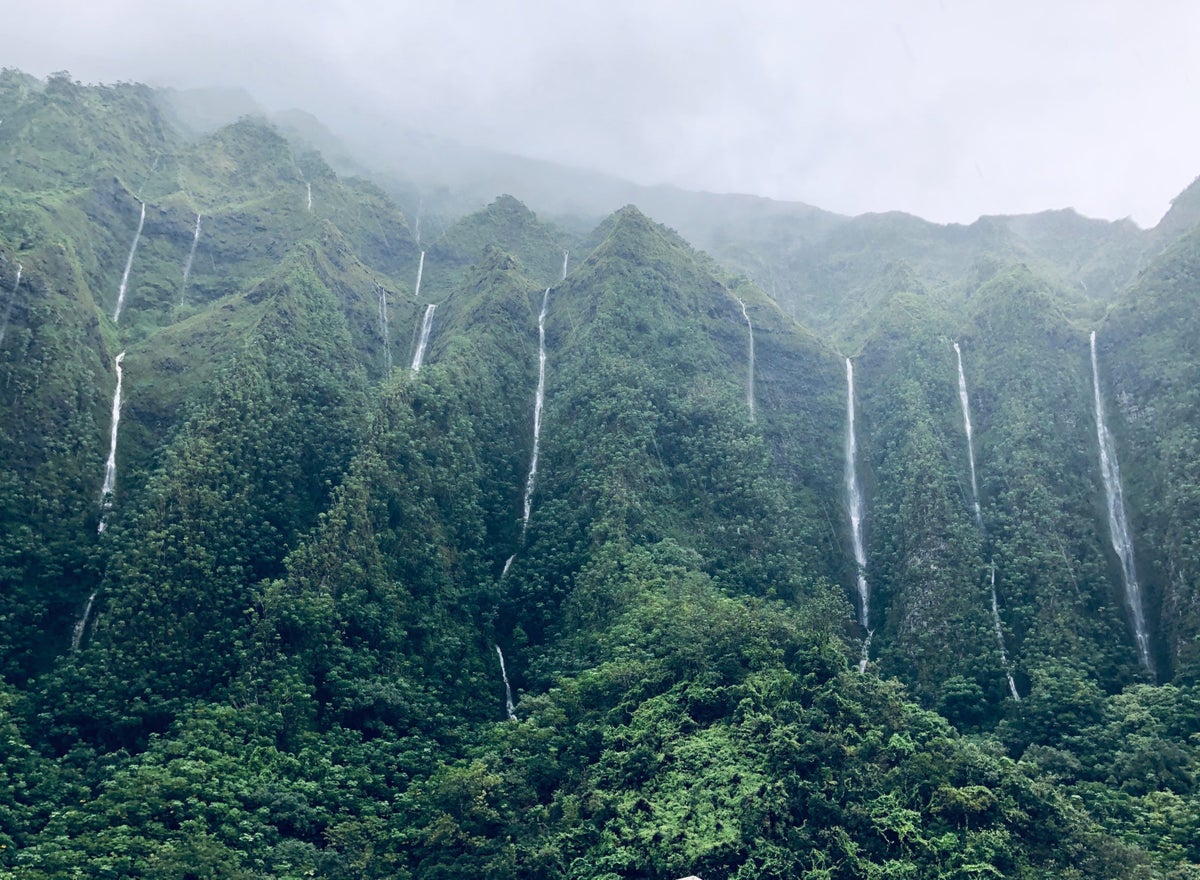
The islands’ rainiest month is still a magical time in Hawaii. After all, what compares to celebrating the most wonderful time of the year in one of the most beautiful places on Earth? Unfortunately, many, many people agree, making December one of Hawaii’s busiest months of the year .
As crowds soar, so do hotel rates and airfare , which reach an all-time high in late December — particularly in the days between Christmas and New Year’s, when revelers come to celebrate the season and holiday breaks free up student and family time.
If your heart is set on a Hawaiian winter, do your wallet a favor and book reservations as early as you can manage. For many visitors, the reward is worth the money spent. This is especially true for whale-watching enthusiasts and surfers competing in the last legs of December’s Vans Triple Crown event.
With the holiday chaos in the rearview mirror, travelers use their winter woes (and extra pocket money) to start fresh — on the beach, that is — which is why January clocks in as one of the most expensive months to book a flight and a hotel .
Surfing season is still well underway and the whale-watching season kicks into high gear, when pods of humpbacks in the thousands migrate from Alaska to mate and give birth in Hawaii’s warmer waters. By January, you can spot adults and calves breaching offshore, particularly near Maui, the Big Island, and Lanai.
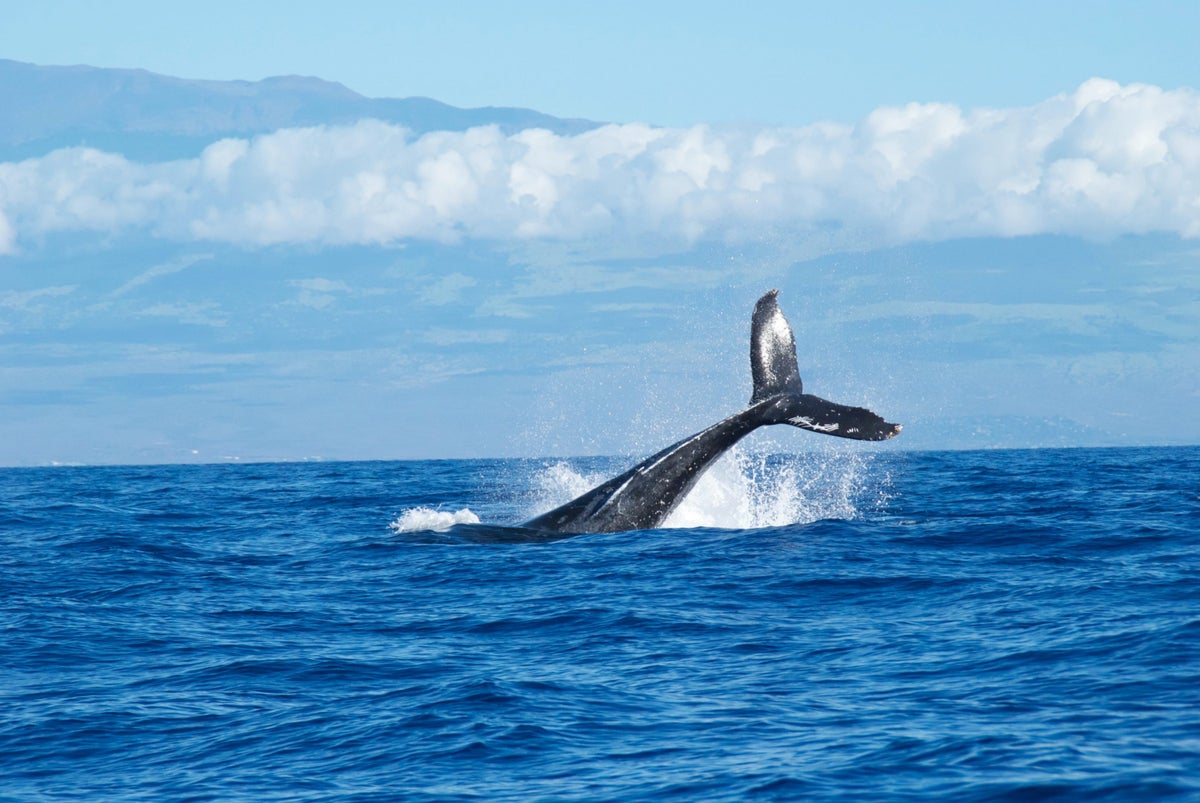
While February on the mainland can be snowy, rainy, and downright miserable, February in Hawaii is still enjoyably warm. Temperatures hang in the high 70s to low 80s and the rain continues to lessen as spring approaches.
While the ocean is the coldest it will get all year , water temperatures still average around 75 degrees and big waves remain a draw for experienced surfers. Generally, February is not a crowded month on the islands except for Valentine’s Day.
The month’s biggest draw is the whales — February marks the peak of Hawaii’s humpback whale season .
Bottom Line: Generally, for the best weather, the best time to travel to Hawaii is in April, May, September, or October . If you’re looking for the best deals, the cheapest rooms and flights are typically found in mid-September, October, November (except Thanksgiving week), and early December before the holidays.
The Best Time to Visit Hawaii by Island
April, May, September, and October beat out all of the rest of the months on Oahu thanks to their great weather, minimal crowds, and affordable room rates.
June through August are Oahu’s driest months while December through February are its wettest. Trade winds that blow in during the winter result in high waves off the north coast — perfect conditions for the island’s world-renowned surfing competitions.
If you’re looking to avoid the crowds, stay away from high season (December through March) and Golden Week (the last week in April when travelers from Japan pour into Honolulu). Waikiki and Honolulu are perpetually busy year-round .
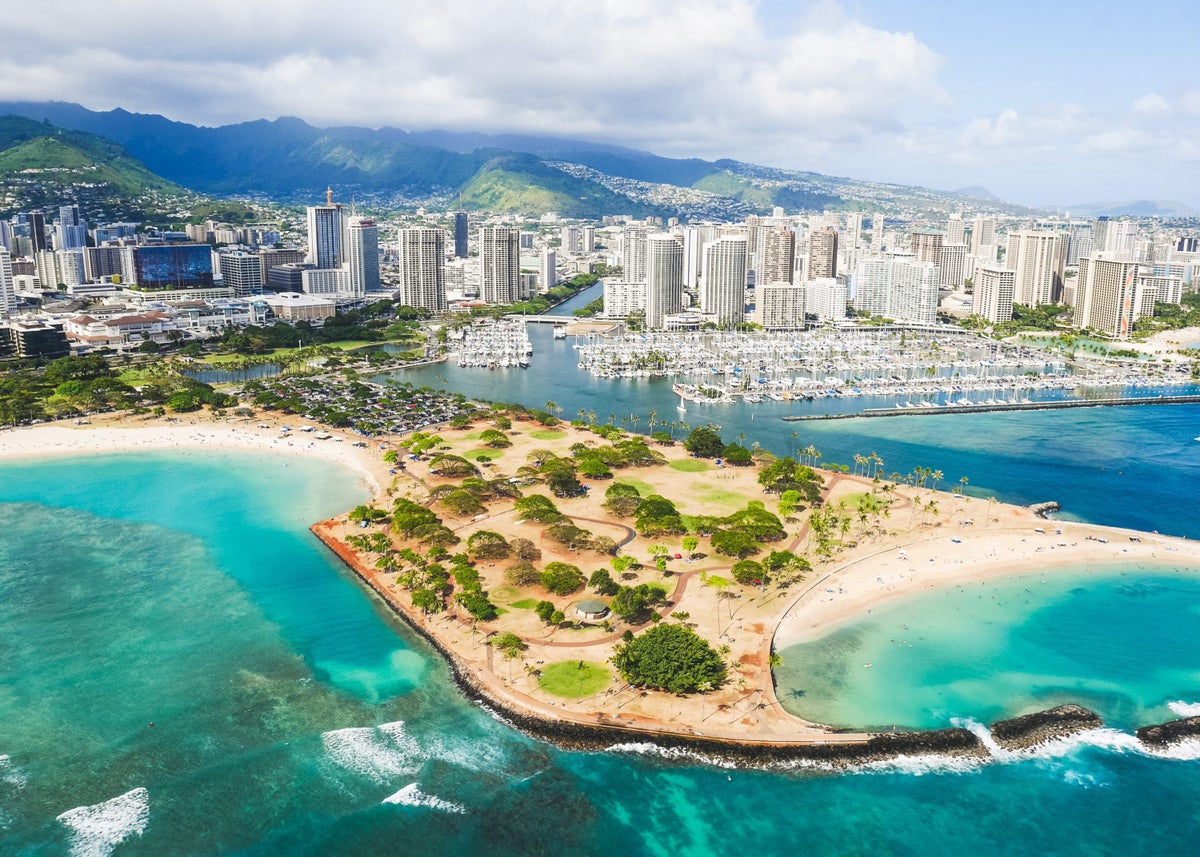
Events to Plan For:
- The Honolulu Festival (March)
- Lei Day Celebration (May 1)
- Prince Lot Hula Festival (July)
- Aloha Festival (September)
- Hawaii Food and Wine Festival (October)
- Vans Triple Crown of Surfing (November, December)
Weather-wise, the best months to visit Maui are April, May, September, and October, unless you want to see the whales . If that’s the case, go anytime between December and March and stick to Maui’s west coast — an area that humpbacks and their newborns tend to favor.
There’s no bad time to visit Haleakala National Park , home to the world’s largest dormant volcano as well as a summit sunrise that is so stunning, it now requires reservations .
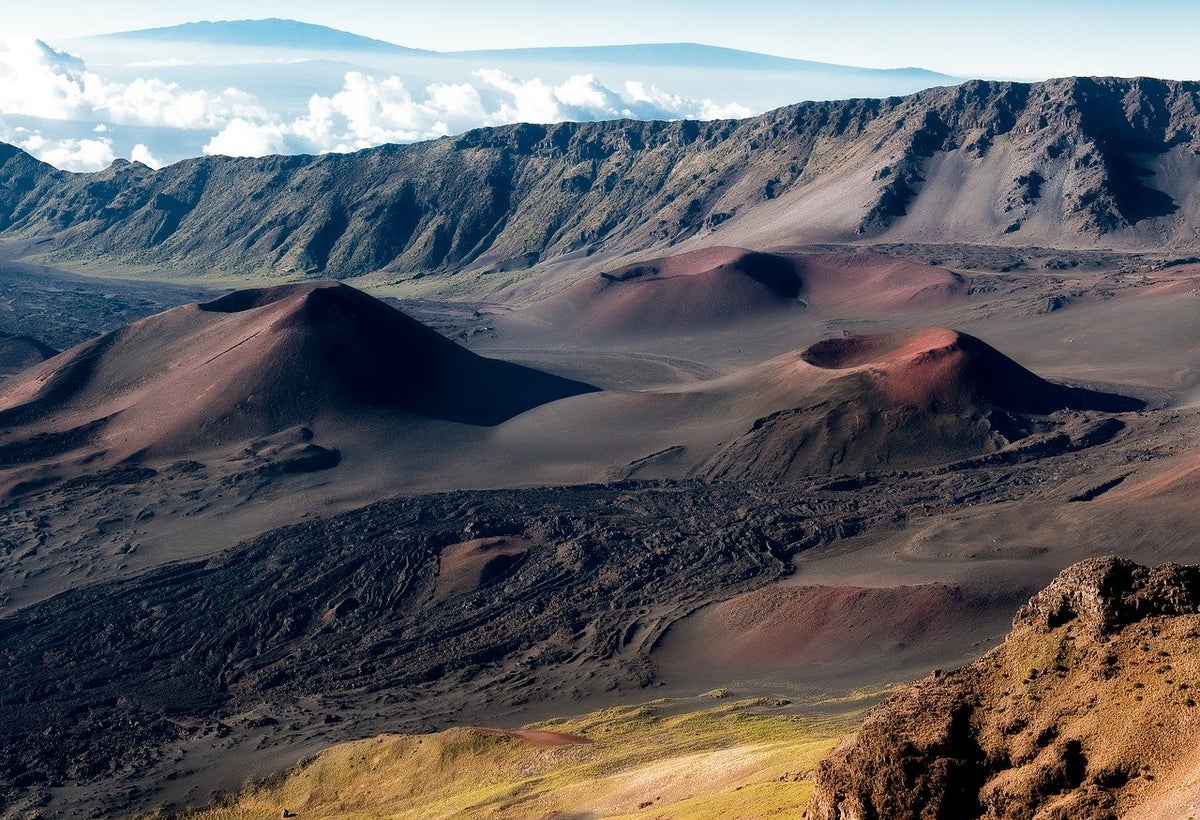
April and May are particular sweet spots for scoring more affordable hotel rates (Maui’s luxury properties tend to be pricier the rest of the year) as well as snorkeling. Since Maui is protected from trade winds, its water during the spring is as calm and as clear as it gets.
- East Maui Taro Festival (April)
- Maui Film Festival (June)
Nicknamed the “Garden Island,” Kauai is Hawaii’s lushest and rainiest island. Although the weather is generally better during the usual months of April, May, August, and September, summer is when rainfall is at its lowest , which increases your chances of sunshine while enjoying northern beaches like Princeville or hiking the island’s world-class trails.
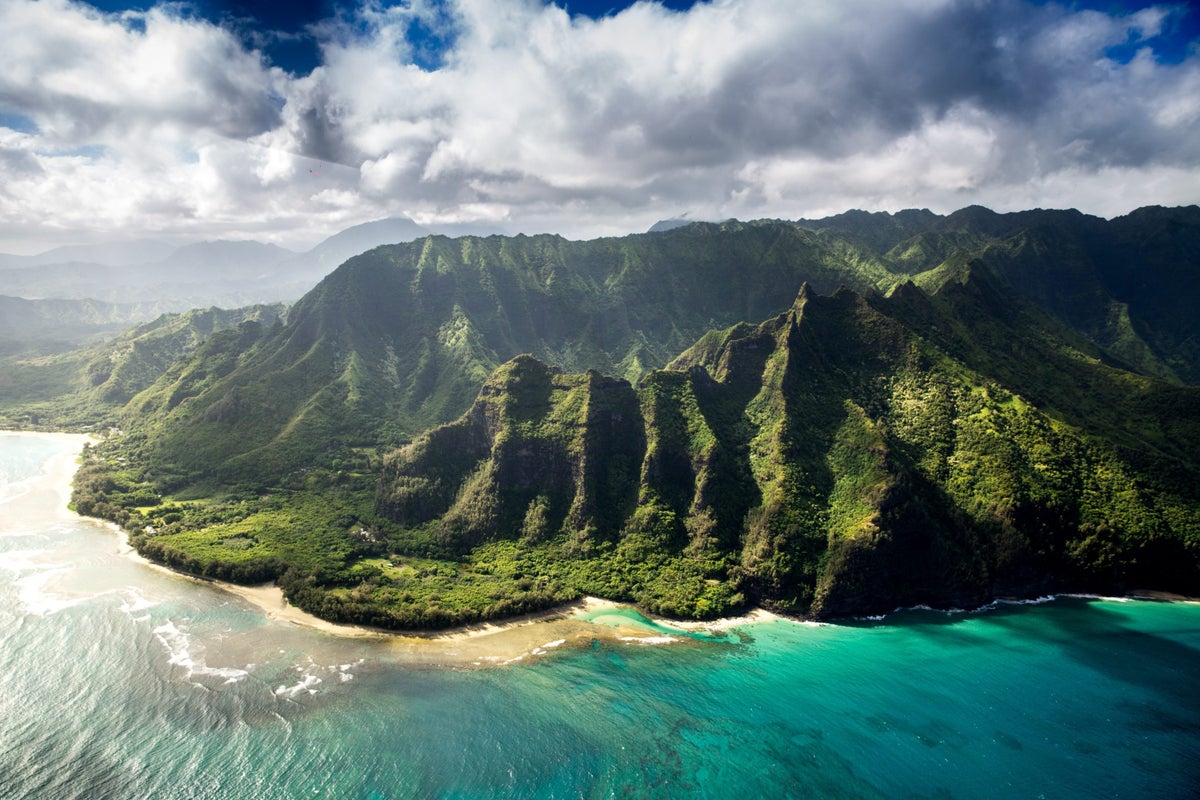
Pack plenty of water and sunscreen before you tackle the Kalalau Trail along the Na Pali Coast, one of the most beautiful hikes in the country. Boat tours of the Na Pali Coast run during the summer and are a great way to take in its enormous scale from afar.
If multiple dreary days are your biggest vacation nightmare, you might want to avoid Kauai in the late fall and winter, when the island receives more rain than other islands (on top of Hawaii’s rainy season).
- Waimea Town Celebration (February)
- Taste of Hawaii (June)
There’s a reason why the Island of Hawaii is known as “the Big Island.” At 4,028 square miles, it’s more than twice the size of all the other Hawaiian islands combined and covers 8 separate climate zones.
Generally, low season — late April, May, September, and October — offers the best weather, fewer crowds, and affordability across the board. High season (December through March) coincides with whale season; sightings are particular spectacular near Hilo Bay and the Kohala Coast.
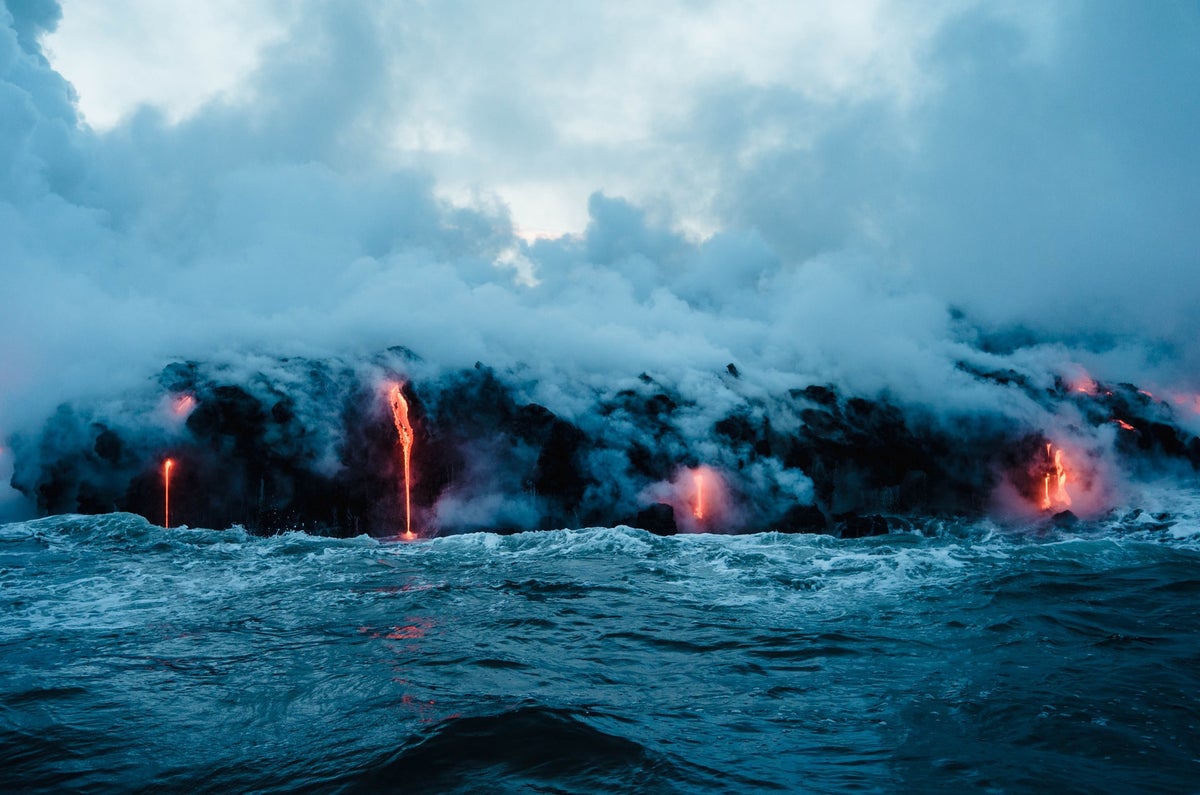
Summer’s higher temperatures make it an ideal time to stargaze on the summit of Mauna Kea (which experiences snow during the winter). Hawai’i Volcanoes National Park , where you can see active lava flows plunging straight into the ocean, is busy year-round and is worth a visit no matter what month you go.
Hot Tip: Take a virtual drive to explore the beautiful Haleakala National Park or immerse yourself in a virtual tour of Hawai’i Volcanoes National Park — both parks are featured in our round-up of 60+ Virtual Tours of Iconic National Parks Around the U.S.
- Merrie Monarch Festival (April)
The least-visited of Hawaii’s major islands , Lanai still retains its undiscovered vibe. It’s reachable via a direct flight from Honolulu or a ferry from Maui, though if you choose the latter, the journey can be rough during the winter. A trip anytime between the summer and November is ideal , when visitors can use the driest and warmest conditions on the island to their advantage.
Hot Tip: Planning on flying between islands? Learn about the best ways to redeem Hawaiian Airlines HawaiianMiles .
Go for a bike ride along Lanai’s unique red-dirt trails, swim and snorkel near its pristine beaches, cliff-dive off Kahekili’s Leap on the island’s south shore, or explore the wreckage at famous Shipwreck Beach.
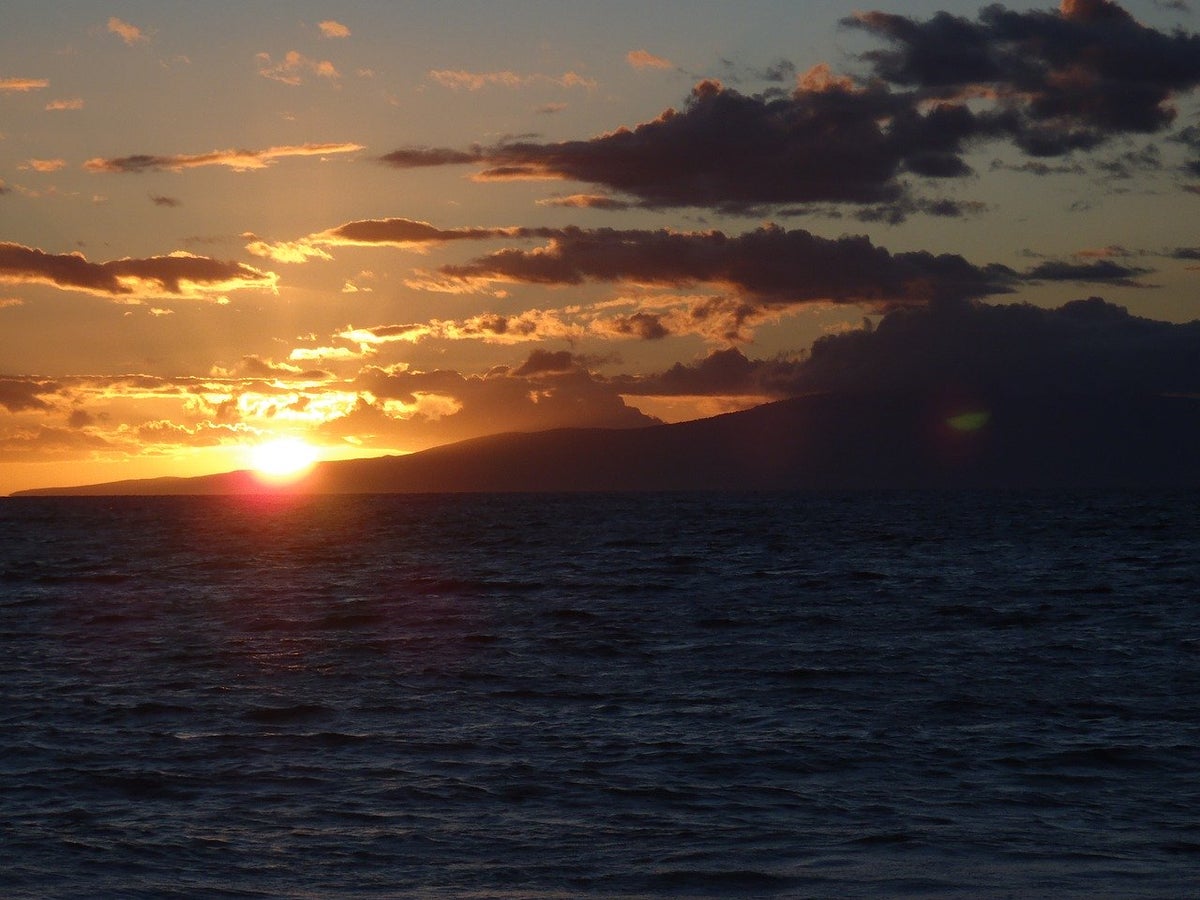
You won’t find many hotels on the island, though the Four Seasons Resort Lanai and its sister property, Sensei Lanai , are 2 of the most luxurious places to stay in all of Hawaii. Otherwise, a multitude of bed and breakfasts offer charming rooms, Wi-Fi, and a glimpse at local life.
No matter which island or month you choose to visit, a trip to Hawaii is sure to be one for the books. Between its famous golden beaches, award-winning resorts, delicious island cuisine, and laid-back lifestyle, it remains a top destination for celebrating life’s greatest moments — even if that moment is simply getting away from it all.
Summer is legendary, and even winter is warmer than the mainland. Yes, there is always a chance of rain, but because storms are localized and usually brief, you’ll find that sunshine is right around the corner. All you have to do is wait it out, or simply — as locals will attest — drive down the road!
Frequently Asked Questions
What is the cheapest time of year to visit hawaii.
Spring and fall are Hawaii’s shoulder seasons, when fewer crowds mean less demand. You’ll generally find cheaper flights and lower hotel rates during these 2 windows.
Is there a bad time to go to Hawaii?
There isn’t a bad time to visit Hawaii — at least, not where the weather is concerned. Hawaii’s tropical climate means it experiences warm, sunny weather year-round. Although the archipelago does experience a rainy season, tropical storms are few and far between, ensuring fun in the sun from January to December.
That said, if by “bad” you mean “expensive,” the winter months (December through March) tend to be the priciest times to visit and generally the worst in terms of available deals.
What is the rainy season in Hawaii?
Hawaii’s rainy season corresponds with winter, officially beginning in November and lasting through the end of March, but don’t let that deter you from planning a visit during those months. Although multiple days of rain are rare during dry season, it is not uncommon to experience consecutive clear, sunny skies during a winter getaway.
Generally, the amount of rainfall differs by island, and even destinations on each island. On Oahu, for example, Hilo averages about 130 inches of rain each year, while Honolulu only receives about 17 inches. Do your research, but expect to experience some rain no matter when you visit.
Was this page helpful?
About Lindsey Olander
Currently based in New York, Lindsey spent her childhood in Connecticut dreaming of far-off places. Her first flight was to Disney World at age 11. Her second flight was for a high school field trip to Italy, though travel as a career didn’t stick until she studied abroad in London during college and discovered the true power of her passport. Since then, she’s worked as a travel editor at Jetsetter and Travel + Leisure , where she reported on everything from African safaris to hot hotel openings to, yes, Disney World.
INSIDERS ONLY: UP PULSE ™

Get the latest travel tips, crucial news, flight & hotel deal alerts...
Plus — expert strategies to maximize your points & miles by joining our (free) newsletter.
We respect your privacy . This site is protected by reCAPTCHA. Google's privacy policy and terms of service apply.
Related Posts
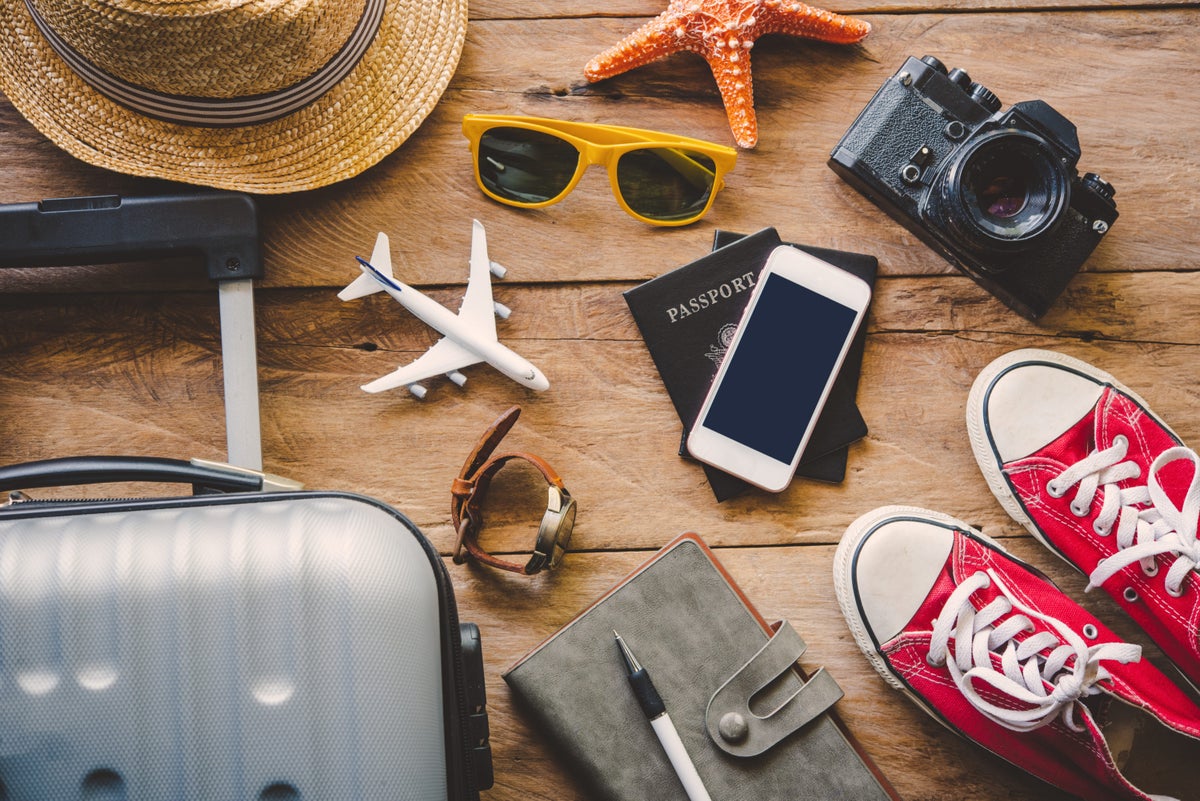
UP's Bonus Valuation
This bonus value is an estimated valuation calculated by UP after analyzing redemption options, transfer partners, award availability and how much UP would pay to buy these points.
Top Destinations
- Food + Drink
Explore the best of the world. Access insider tips and hotel recommendations from our travel tastemakers
By proceeding, you agree to our Privacy Policy and Terms of Use .
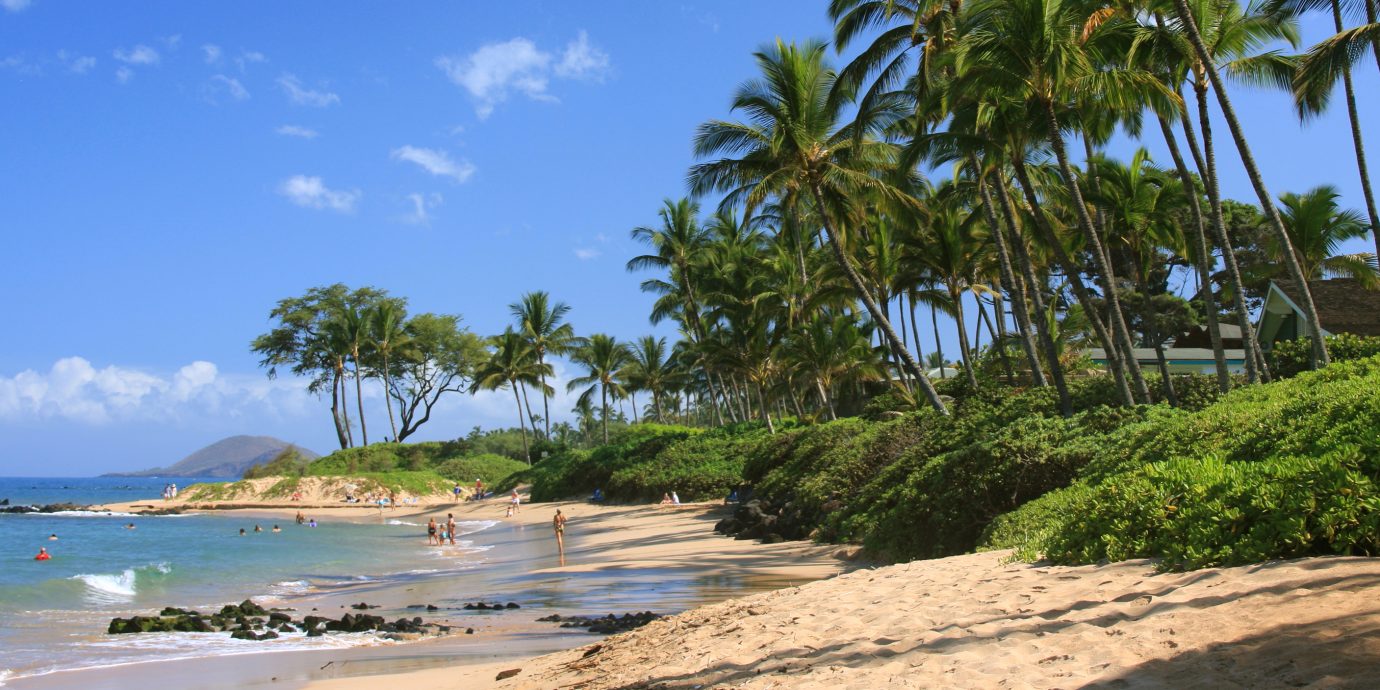
The Best Time to Visit Hawaii: A Season-by-Season Breakdown
Let’s be real: there’s no bad time to fly to Hawaii. The eight-island central Pacific archipelago is blessed with great (read: gorgeous) weather year-round, making it one of the top vacation destinations no matter what you’re celebrating—be that your honeymoon, a couple’s retreat, a family break, or just because. However, if you’re visiting for a reason (like seeing the humpback whales or surfing Oahu’s famous waves) or bound for a specific island (lush Kauai or glamorous Maui), you have more to consider. See which season and month best fits your itinerary.
Senior Editor, Jetsetter | @lindseytravels | lindseytravels.com
See recent posts by Lindsey Olander
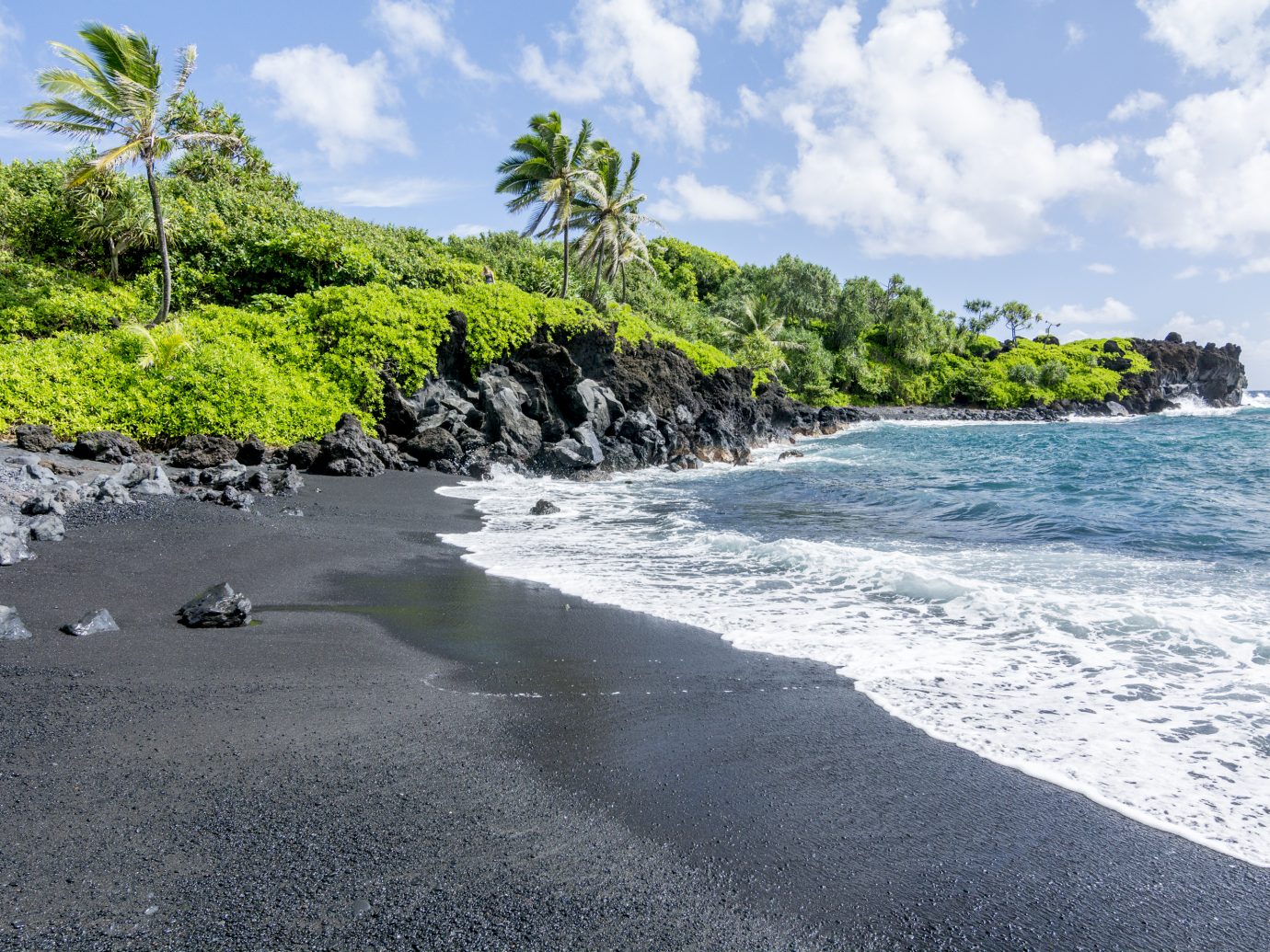
Spring (March through May)
Spring marks the start of Hawaii’s dry season, when the trade winds die down and the island’s fruits and flowers begin to bloom again after their winter slumber. In March, the islands are still experiencing a bit of rain and cooler temperatures at night (so pack a jacket), but on average, this is a very temperate time of year throughout Hawaii. As with all holidays, Easter takes a big hit on hotel rates and airfares, but prices level out by May. The window between April and May is one of the best times to visit Maui , whose hotels tend to be on the pricier side the rest of the year. And, although surfing and whale-watching season is at an end, that just means there’s more time to enjoy land-bound luaus and festivities. Eyeing a visit in April? Head over to Hilo, on the Island of Hawaii , for the Merrie Monarch Festival , a week-long annual “hula Olympics” of sorts that also involves craft fairs, live music, and—of course—dancing.
RELATED: 9 Cool Things to Do in Maui—Beyond the Beach
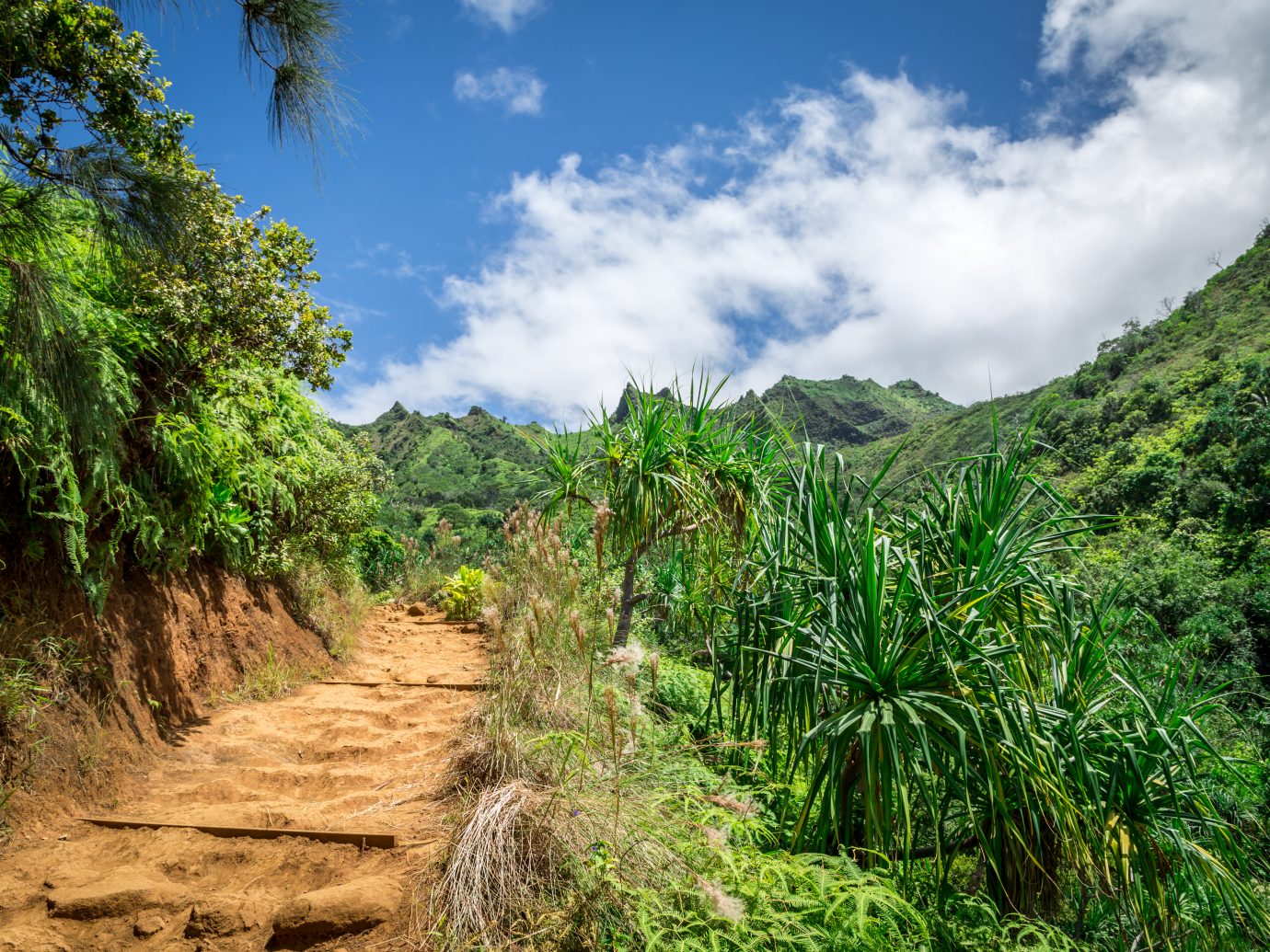
Summer (June through August)
Summer is one of Hawaii’s busiest seasons—this is when both families and locals take advantage of their kids’ summer breaks, packing into resorts and beaches to enjoy the warm water and stellar snorkeling conditions. (This is also the hottest and most humid time of the year for the islands, when temps hover near the low 90s.) Although airfare gets pricier come June (because summer typically spells high season everywhere else), summer is actually considered one of Hawaii’s low seasons, so you’ll find hotel room and rental car prices are lower than average. (This is probably why July sees peak crowds.) It’s also worth considering that the start of summer is also the start of hurricane season. Storms are very rare in Hawaii, but they do happen.
Because rainfall is generally at its lowest in the summer, many of the islands’ famous waterfalls become weaker than what you’d see in, say, fall or winter. Because of that, summer might be an ideal time to see Kauai —the “Garden Island” is Hawaii’s lushest and rainiest island by far—to increase your chances of sunshine while you hike the Kalalau Trail along the Na Pali Coast and Waimea Canyon or lay out on Poipu Beach near the Grand Hyatt Kauai Resort and Spa .
Explore More: See hotel details | See all Waikoloa, HI hotels
RELATED: The Best Beaches in Hawaii
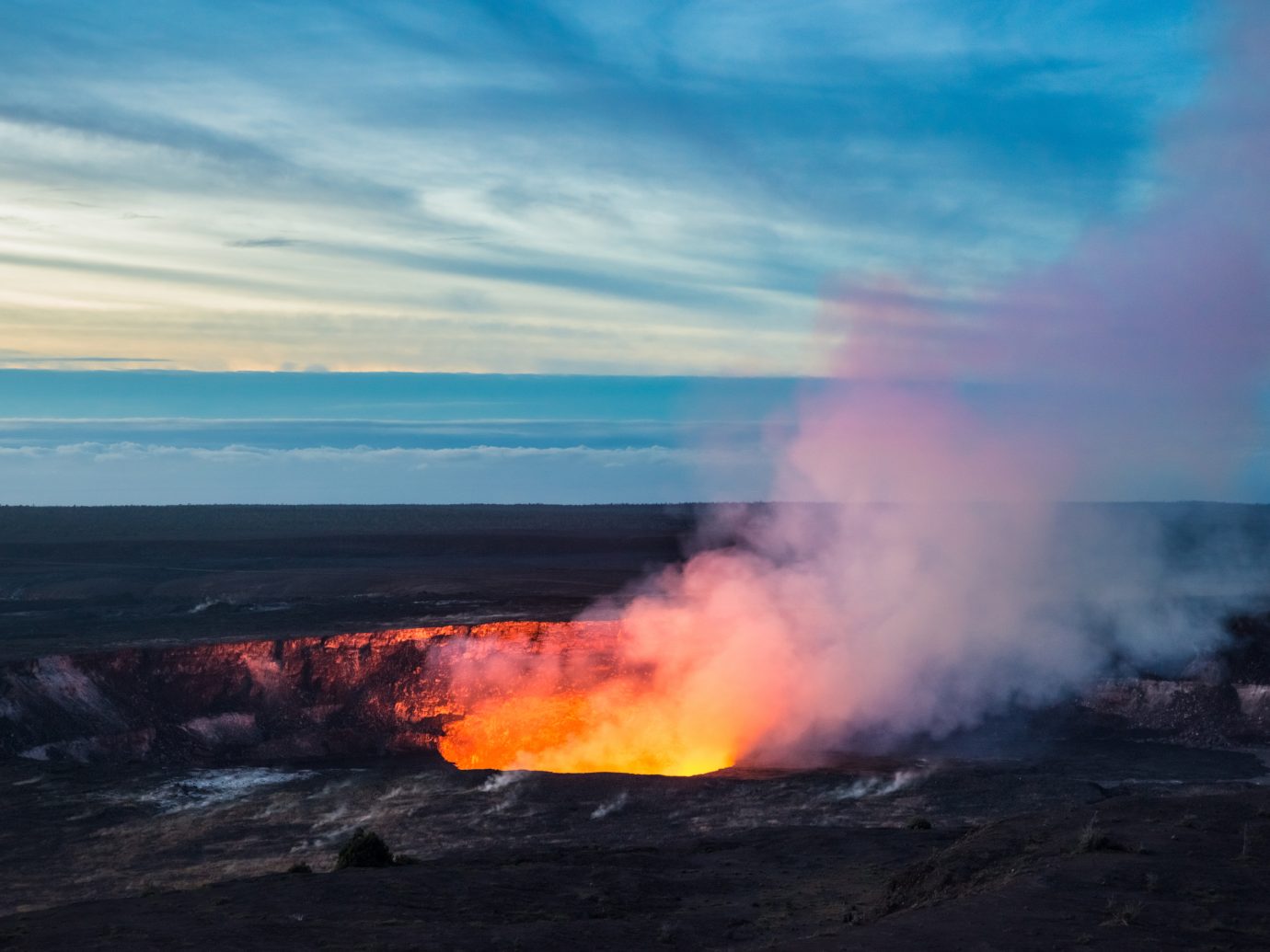
Fall (September through November)
Fall in Hawaii is similar to spring—rain is starting to fall more regularly, with warm days transitioning into cool nights. Beginning in late August, hotel prices begin to drop as the summer crowds disperse and kids head back to school. Fall is considered to be one of the best times to visit the islands overall: coming off the heat of summer, the ocean temps are the warmest they’ll be all year and last through October. October also sees the lowest hotel rates (barring Labor Day weekend, when prices skyrocket.)
Worried about getting caught in the rain? You might want to avoid Kauai, which experiences the most rainfall of any island. Instead, consider The Island of Hawaii, which is the driest of the Hawaiian islands in fall—not to mention the season’s lower temps make it an opportune time to visit Hawaii Volcanoes National Park . (JS Tip: Time your visit for sunset, when you can witness lava flow into the ocean at Kalapana.) October also brings the harvest season, and with that, the Hawaii Food & Wine Festival . This year, events are taking place across Maui, the Island of Hawaii, and Oahu for a three-week-long celebration of Hawaiian cuisine.
RELATED: 22 U.S. National Parks to See Now
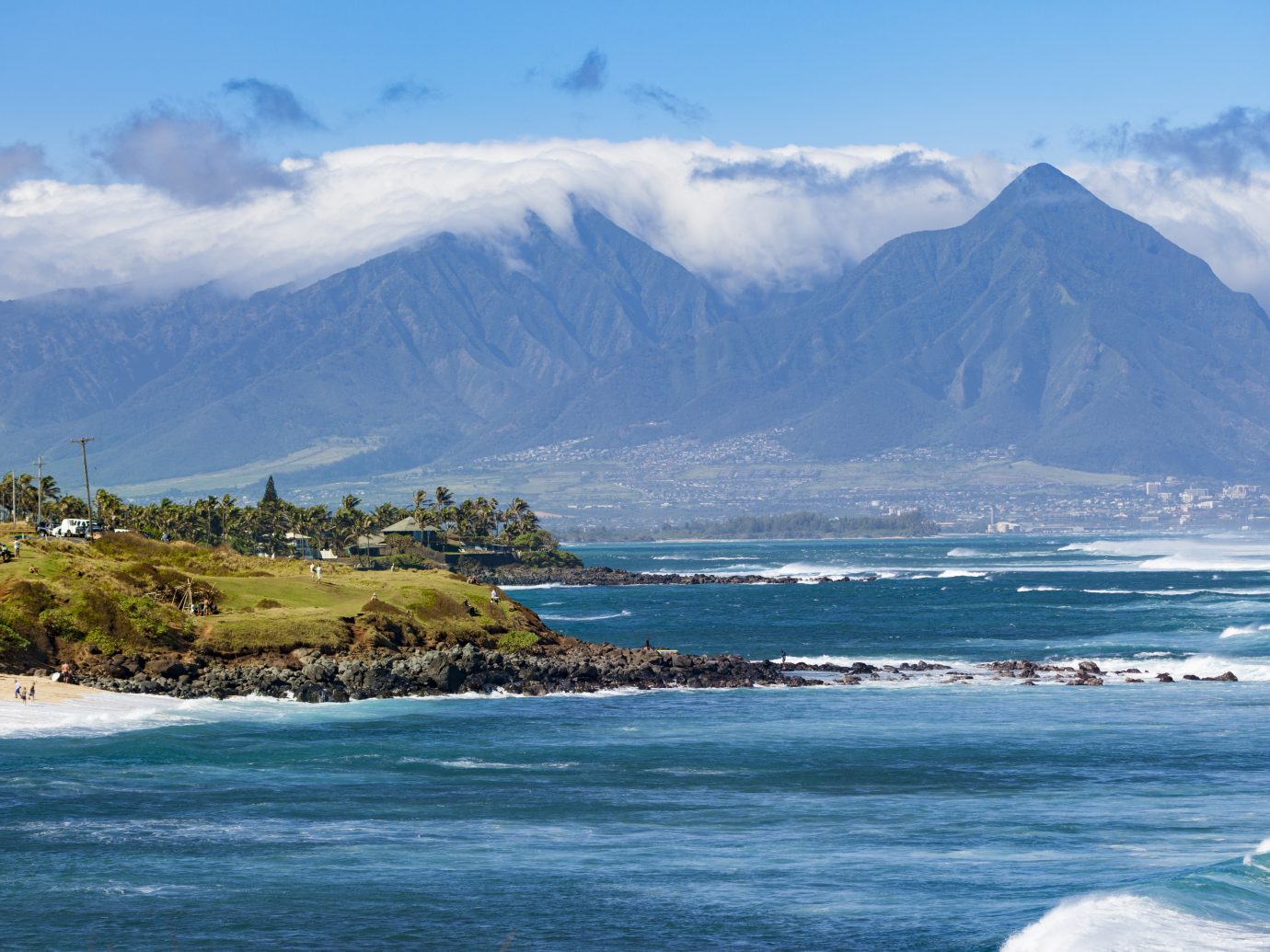
Winter (December through February)
Yes, winter in Hawaii is the wettest and coldest season of all—but cold is a relative term. Temperatures still reach the high 70s, and the trade winds blowing in result in high waves off the shores of Oahu —perfect conditions for the island’s world-renowned surfing competitions. December is the rainiest month of the year, but despite those less-than-ideal weather odds, it’s also the second-busiest time (behind July) in terms of tourists. Hotel prices follow suit, reaching a high in December especially between Christmas and the New Year (if you’d rather wait it out, rates drop after New Years).
Besides being a sunny escape from snowstorms back home, one of the islands’ other huge draws for tourists come winter are the whales: pods of humpbacks arrive from Alaska to mate and birth in the shallow waters between Maui and Lanai , and sightings of them breaching offshore are spectacular. Don’t want to leave the experience to chance? Although you can spot them as early as November and as late as March, whale sightings here peak in February.
- 15 Underrated Islands Worth Adding to Your Bucket List
- The Best Hotels in Maui Right Now
- Steal vs. Splurge: 13 Beach Essentials Every Jetsetter Should Pack
All products are independently selected by our writers and editors. If you buy something through our links, Jetsetter may earn an affiliate commission.
Become a Jetsetter.
Use our insider connections to know where to go and what to do.
Thanks for Signing Up!
Related Tags
Explore more.
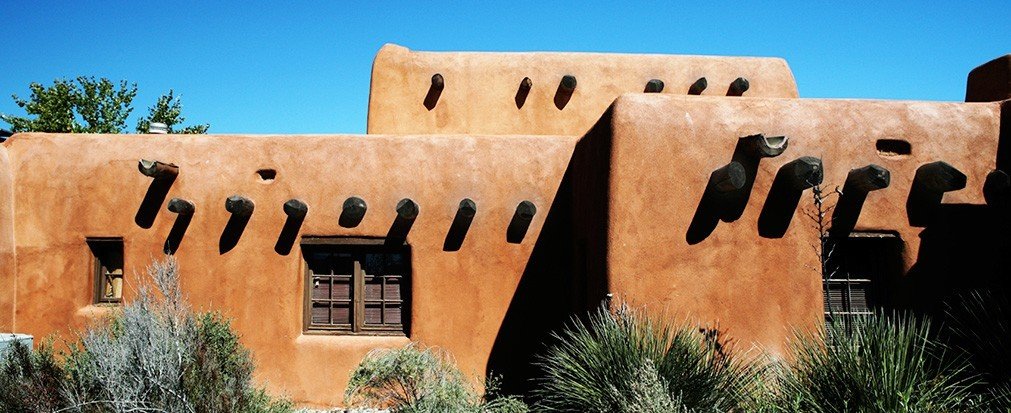
72 Hours in Santa Fe
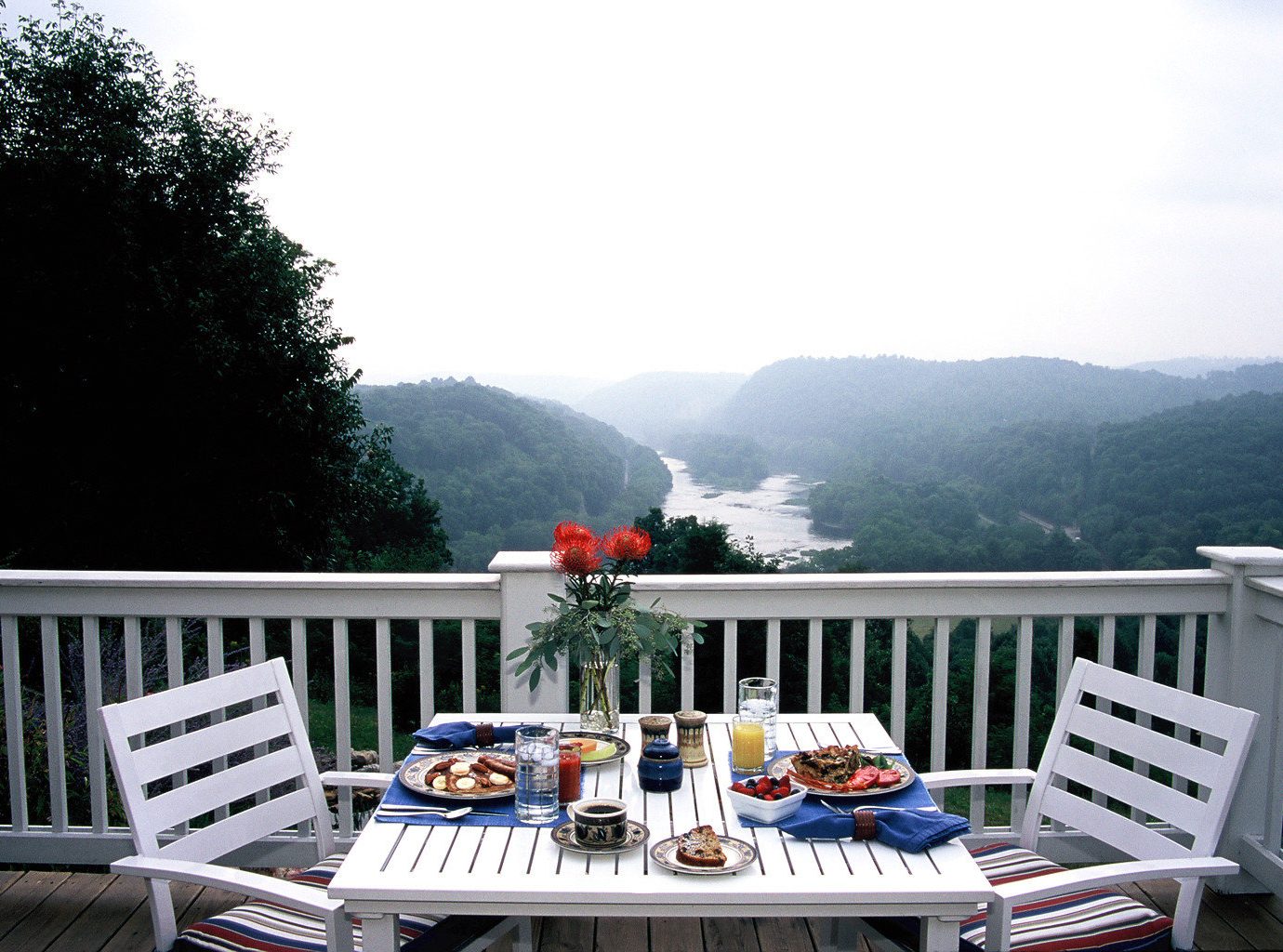
Inn at Riverbend
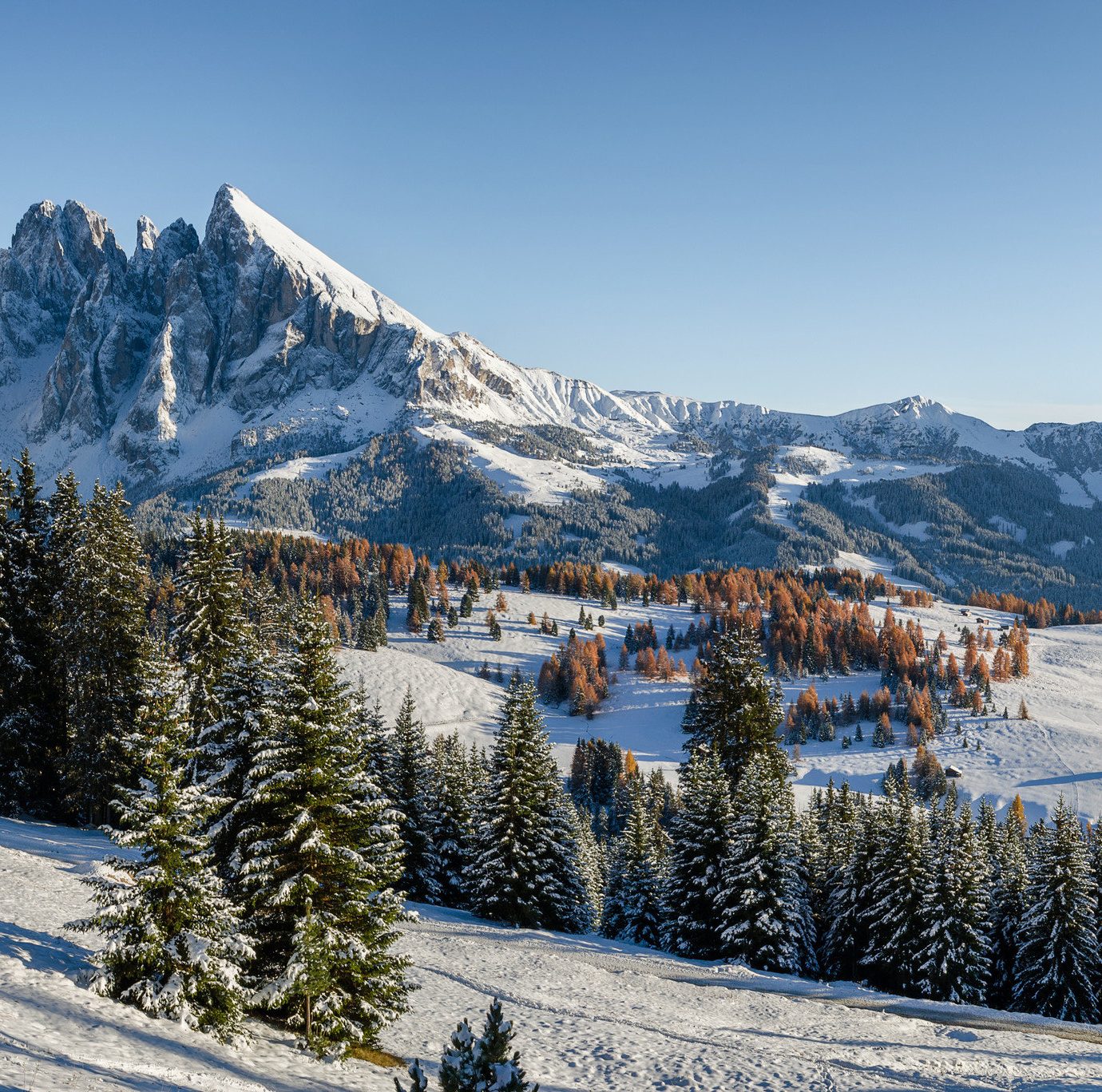
8 Underrated Winter Destinations Around the World

Park Central Hotel New York
Weather & Climate
Getting Around the Islands
Airports in Hawaii
One-Week Itinerary
Top Destinations
Most Beautiful places
Choosing the Right Island for Your Trip
All-Inclusive Resorts
Family-Friendly Hotels
Top Things to Do
Best Beaches
Surfing in Hawaii
Scenic Road Trips
Annual Events and Festivals
Food to Try
Best Hawaii Breweries
Chocolate Tours in Hawaii
Best Time to Visit
The Best Time to Visit Hawaii
Peter French / Design Pics/Getty Images
While almost any time of year except the monsoon season is a great time to visit this remote U.S. state, prices vary significantly by season—especially during the winter (when the island is still warm, but most of America is cold). The best time to visit Hawaii is during May when many snowbirds have retreated, and the weather is pleasant, without the threat of hurricanes or excessive rainfall. May is also the tail-end of humpback whale-watching season.
Decide what you want to see and do while you're in Hawaii, and then find the best time of year to meet your requirements. If you're a return visitor, plan your trip in a different season so you can experience an entirely different way of island life. The eight islands of Hawaii (six of which you can visit) are Oahu, Niihau, Kahoolawe, Maui, Kauai, Molokai, Lanai, and the Big Island (Hawaii). As no one island is like the other, it's recommended that you check out more than one.
The Weather in Hawaii
Despite being a tropical climate, the weather in Hawaii is not the same every month of the year. Hawaii has a dry season (April to October) and a rainy season (November to March). However, even the rainy season can be relatively dry when many parts of Hawaii suffer drought conditions.
The summer months can be hot and humid, especially in Honolulu and Waikiki. Hurricanes are rare but the hurricane season is from June to November. Fortunately, the last major storm to hit Hawaii was Hurricane Iniki, which severely damaged Kauai in September 1992.
The best weather is often found in April, May, September, and October, which is also conveniently the time when you can find some good travel bargains. Since most Americans are in school or work during these months, flight and hotel prices are much lower than during the summer or winter vacation months.
Peak Season in Hawaii
Summer is when you'll find more families vacationing in Hawaii since that's when school is out in many areas of the United States. School is also out in Hawaii in June and July, so the most popular beaches on every island tend to be more crowded during those two months as well as two weeks at the end of December when the students are on winter break. Airfare tends to be more expensive during the "high" season of mid-December to mid-April. If you plan to visit during this period, make your reservations early. Like airfare, lodging tends to be more expensive during the "high" season of mid-December to mid-April.
How Much Does it Cost to Visit Hawaii?
A vacation to Hawaii is not cheap. The cost is the primary reason that many people never make it to Hawaii despite their strong desire to visit the islands.
The cost of a round-trip airline ticket to Hawaii has increased substantially, but as you might expect, airfare from the West Coast is generally several hundred dollars less than from the East Coast. Fortunately, there are a large number of airlines that fly to Hawaii , and the costs vary from day to day and airline to airline, so the key is to plan and compare prices.
Popular Events & Festivals
Because Hawaii is one of the most ethnically diverse states in the country, annual cultural festivals abound throughout the islands. Additionally, the island celebrates national holidays and seasons such as Christmas as well as local agricultural festivals and historical festivals.
To fully appreciate the unique culture of Hawaii and its people, consider planning your trip around one of the major festivals that take place during the year. Here are a few on each of the four major islands:
Big Island : Kona Coffee Cultural Festival , Merrie Monarch Festival
Kauai : Kauai Polynesian Festival , Koloa Plantation Days
Maui : Celebration of the Arts , Kapalua Wine & Food Festival , Maui Onion Festival
Oahu : Aloha Festivals , Lei Day in Hawaii , Lantern Floating Hawaii
Winter in Hawaii
While the inclination for many folks is to visit Hawaii in the winter to escape the cold and snowy winter weather on the mainland, it's not the time to find either the best weather or the best bargains. However, winter does bring with it great waves that make Hawaii a world-famous surfing destination.
Events to Check Out
- The Vans Triple Crown of Surfing takes place each November and December on Oahu's North Shore, but traffic on the North Shore is extremely heavy on competition days.
Spring in Hawaii
Late Spring can be a great time to visit Hawaii: Many of the winter crowds have gone back to school and work - the weather is typically dry and pleasant. Whale-watching seasons takes place from December through May, so there's a good chance you'll to get to see them during a spring trip.
- The Honolulu Festival, a celebration of the relationship between Hawaiʻi and the Pacific Rim region, is held over three days every March.
- If you're visiting in April, don't miss Hilo's historic Merrie Monarch Festival, a celebration honoring King David Kalakaua, otherwise known as the "Merrie Monarch."
Summer in Hawaii
Summer is a busy season for families with children. July is the state's most-visited month, but not always the best, as the temperatures are warmer and surf can sometimes be intense. Additionally, while hurricanes aren't frequent in Hawaii, hurricane season kicks off on June 1.
- King Kamehameha Day is celebrated across the islands on June 11. The largest attraction is a celebratory parade which begins in Downtown Honolulu and finishes at Kapiʻolani Park in Waikiki.
- Experience the magic of the ukulele at Honolulu's annual festival celebrating the famed instrument. It takes place each year in July.
Fall in Hawaii
Like spring, fall is also a pleasant time to visit Hawaii. Skies are clear, and a lack of crowds can mean affordable hotel rooms and flights. Even though there's always a minimal threat of a hurricane (the season runs through Nov. 30), it's arguably the most beautiful season of the year.
- Fall's best-known event is the week-long Aloha Festivals, which consists of the Hoʻolauleʻa (a large party). The Waikiki Hoʻolauleʻa is a casual block party with food, dancing, music, and other Hawaiian traditions.
The best time to visit Hawaii is in the month of May after the winter crowds have gone home. During this month, the weather is pleasant, without excessive rainfall or the threat of hurricanes.
Flights to Hawaii are cheapest in January, right after the holiday season, and also in September, when the kids are back in school. The most expensive time to travel to Hawaii is during the state's high season, December through April, with the exception of January.
Hawaii's rainy season extends from December through March. And while it rains nearly every day year-round, rain and cloudy weather can persist for days during this time period.
Hawaii News Now. "Hawaii's Hurricane History." August 12, 2007.
World Population Review. "Most Diverse States 2021." Retrieved February 24, 2021.
The Best Time to Visit the Bahamas
Your Trip to Oahu: The Complete Guide
The Best Time to Visit the U.S. Virgin Islands
The Best Time to Visit the Dominican Republic
The Best Time to Visit Kauai
The 20 Best Things to Do in Hawaii
Hawaii Guide: Planning Your Trip
The Best Time to Visit Disney World
The Best Time to Visit Japan
The Best Time to Visit the Great Barrier Reef
The Best Time to Visit Boston
Weather in Cancun: Climate, Seasons, and Average Monthly Temperature
The Best Time to Visit Morocco
The Best Time to Visit Hawaii Island
The Best Time to Visit Spain
The Best Time to Visit Oahu

Best Time to Visit Hawaii – Seasons, Cost, Weather, & More
Rightly called the Paradise of the Pacific, Hawaii is overflowing with natural beauty. From the dramatic volcanic cliffs to soft sand beaches , every corner of the archipelago is worth checking out. But when should you book your Hawaii trip – what’s the best time to explore the Hawaiian Islands?
The short answer: The months of April, May, September, and October are the most enjoyable when it comes to temperature and overall weather.
That being said, the best time to visit can be highly subjective. Some travelers are happy to visit among the holiday crowd, while some prefer traveling around in solace. Also, if you have a limited budget, you’d want to visit Hawaii when the price of airfare and accommodations are the cheapest. The perfect time to travel to Hawaii also depends on which island you wish to visit , as each one is different with its own unique charm and attractions.
It can be overwhelming to plan your trip with so many factors vying for your attention. This is where we come in. In this post, we have compiled everything you need to know to plan your ideal trip to the Hawaiian Islands.
Hawaii Travel Seasons
Like any travel destination, Hawaii has two distinct seasons: low and high. “Low” season is when – as you can guess – the cost of the trip is at its lowest because the place is least busy or crowded. In Hawaii, low season stretches from mid-April to early June, and then again from September to mid-December.
“High” season usually refers to regular holiday periods when most people travel. Anyone in school or with a child in school can only manage to travel during summer or key holiday periods (like Christmas or 4 th of July). Since this makes up for the majority of the population, traveling to Hawaii during these times is EXPENSIVE.
The low season or off-season in Hawaii runs from mid-April to early June (late spring) and September to mid-December (fall) – honestly, we think it’s a paradox considering these are the absolute best times to be in Hawaii.
If you want to avoid the crowds, are looking to save money, or if you just want reliably great weather, this is the time to visit. Airfares and hotel rates tend to be substantially lower, and with a little bit of online legwork, you can find several good deals.
The only exception you should be aware of is the Golden Week which occurs in the last week of April and stretches through early May. Due to its close proximity to Japan, Hawaii is the go-to destination for Japanese tourists during this period when their four major holidays take place one after the other. If you’re planning to visit between the last week in April and early May, make sure to book your inter-island flights, hotels, and car rentals in advance.

High Season
It’s peak season in Hawaii from mid-December to March. Resorts are booked to capacity and prices are up, especially in the last two weeks of December and the first week of January. As spring break also falls during this period, Hawaii is jam-packed with families that descend on the archipelago to take advantage of the school holiday.
If you want to visit during the high season, make your flight, hotel, and rental car reservations at least three months in advance, if not more. Hundreds of thousands of people travel to Hawaii for popular holidays such as Christmas, Thanksgiving, and the 4 th of July, so expect to pay top dollar and rub shoulders with the crowds.
We understand how tempting it can be to decide to cool off on a stunning tropical beach in Oahu or Maui, but keep in mind that a large number of families have the same idea each year. From June to August, the summer-time crowds are everywhere in Hawaii, so don’t expect to find serious bargains until spring and fall. This is vital to keep in mind during these high gas and high inflation times.
Summer months are also the warmest here, with temperatures climbing into the 90s. In addition to heat, it can also get pretty humid on some of the islands, like Oahu. For those who want to, say, go hiking through the legendary black lava fields of the Big Island , the peak of summer in June, July, or August might not be the best time to do so.
The good thing about this weather though is that the surf is at its lowest. If you have small children or you want to learn how to swim or surf, the 80-degree water is really pleasant.
See Also: Black Sand Beaches on Hawaii’s Big Island

RELATED ARTICLES
Need a more detailed monthly breakdown of visiting Hawaii? We’ve got you covered. The below articles discuss each month in more detail.
Hawaii in January
Hawaii in February
Hawaii in March
Hawaii in April
Hawaii in May
Hawaii in June
Hawaii in July
Hawaii in August
Hawaii in September
Hawaii in October
Hawaii in November
Hawaii in December
Best Time to Visit Hawaii for Good Weather
In terms of weather, spring and fall are the best times to enjoy the Aloha State.
Spring marks the beginning of the “dry” season in Hawaii and you couldn’t ask for nicer weather. This is also usually when airfare, hotels, Airbnbs, and other rental prices start to drop. Flowers are blooming, locals are celebrating the fantastic produce, and the annual week-long Merrie Monarch Festival adds to the good time with music, dance, and arts. The May Lei Day is also celebrated during this period.
While it rains every day somewhere in Hawaii at any time of the year, it seldom rains here in spring.
The year-round temperature doesn’t vary much. The daytime temperatures in summer near the beach average between 84°F and 86°F, and the nighttime lows are typically about 10 degrees cooler.
Most water activities – swimming, surfing, diving – are better in the spring and fall seasons as the ocean is calmer and thus, safer. In the winter, currents are much stronger, waves are bigger, and storms make the weather even more unpredictable. If you are a water lover, March, April, and May (i.e, late spring) would be the perfect time to visit Hawaii. Fall (September, October, and November) is equally impressive for that fabulous weather, calm waters, and fewer crowds.

Best Time to Visit Hawaii on a Budget
The cheapest time to buy flight tickets and book accommodations and car rentals in Hawaii is during the low season when it’s much quieter.
As mentioned above, September through early December is the low of the off-peak season, and reduced demand leads to lower prices. The only exception is the Thanksgiving weekend since the military personnel based on the islands make travel arrangements with their family.
If you can’t get away in the fall, don’t worry, the months of April and May also offer a great opportunity to travel cheaply to Hawaii. Just avoid the last week of April and the first week of May (because of the Golden Week). The rest of these two months are always abound with great deals on everything.
Flight ticket prices will vary, but they mostly depend on when you’re flying and where you’re flying from. Tickets from the West Coast are the cheapest at $350 – $475 per person, but we have seen even lower than that in the low season. East Coast to Hawaii tickets can be doubly expensive no matter when you fly, but you can still find some good discounts.
Here are a few tips to save money on flights:
Fly during the week: Weekday flights are not as in-demand as the weekend ones; you can save even more by taking a red-eye flight.
Book at least a month in advance: We highly recommend buying your tickets 30-40 days before the date of your departure.
Be flexible: Some Hawaiian airports are way cheaper than others; consider flying to Lihue (Kauai), Kahului (Maui), and Honolulu (Oahu) to save some more bucks.

Accommodations
The cost of your accommodations in Hawaii will vary depending on what kind of property it is – budget or luxury. You can stay in a $40/night hostel or a $300+/night hotel. Hotel prices usually don’t go below $160-$180 per night even during the least crowded times, but if you’re willing to make some sacrifices (like a room without an ocean view), you can save considerably.
Before the 2021 rental car shortage, it was easy to find a mid-sized or economy car to rent for $40. Now, with more people traveling again – and since rental car companies sold off most of their fleets in 2020 – the prices have increased to $75/day and more including taxes. You can probably find a cheaper deal by looking around and comparing prices. We mainly use Turo when looking for budget options for car rentals.
See Also: Do I need to rent a car in Maui?

Best Time to Avoid Big Crowds
April, May, September (the last two weeks) and November are the best times to avoid hundreds of thousands of tourists who come to Hawaii each year. Personally, we absolutely love late September and early October to explore the hidden gems as well as popular “touristy” spots in peace. With children back in school, you won’t find many families here this time of year.
The Most Popular Time to Visit Hawaii
Summer ( June, July, and August ) is the peak season that attracts the largest crowds, other than Christmas and New Year in winter of course. It is understandable, that when the weather is hot and muggy in most of the US, people seek relief at Hawaii’s beaches. Plus, schools are out so both vacationing families and locals are looking to the waters for some much-needed fun.
This is why summer is one of the priciest and busiest times to fly to Hawaii.
But hey, don’t take this to mean we are hating on the Hawaiian summers – not at all! Despite how crowded and expensive summer gets, the waters are at their calmest, making it perfect for snorkeling and swimming.
See Also : The 5 Best Snorkeling Places in Oahu
June and July are considered dry months so they don’t receive a lot of rainfall, which can be a blessing for some adventurers. This is also when waterfalls are at their weakest so you can take a ton of Instagram-worthy pictures.

The Worst Time to Visit Hawaii
You may have heard that there is no bad time to visit Hawaii . Well, about that…If you talk to a local they will tell you that Hawaii should be avoided during certain months. These include the wet season (heavy-rainfall months) and the busy season. And both of these seasons coincide in December.
December , in our opinion, can be a not-so-good time to visit the islands. From mid-December to New Year, Christmas-cheery visitors come to Hawaii from all across the world, resulting in higher rates for flights, accommodations, and rental cars.
December is also the wettest and coldest month of the year. We know, we know, Hawaiian winters are not really winters but when temperatures only reach the high 70s, you won’t find it as easy to go frolicking in the waters.
Best Time for a Honeymoon, Babymoon, or Destination Wedding
Looking for a picture-perfect destination for a major milestone in your life? Be it the wedding of your dreams or your long-awaited honeymoon or babymoon , Hawaii has got you covered.
Although these paradise-like islands are beautiful all year round, we recommend choosing April or May for the least amount of problematic and unpredictable weather. You probably also want to avoid crowds, so choosing low seasons from mid-April to May or even mid-June, and September to mid-December will be a good idea. If you want a winter-ish wedding, November is ideal as it’s the least busy and least expensive during this time.
Best Time to See Wildlife
One of the most exciting parts of a getaway in Hawaii is seeing all of the stunning wildlife around the archipelago. Humpback whales, dolphins, tropical fish, and more can be found in the waters throughout the year. However, there are certain times of the year when you’re more likely to encounter these creatures:
Whale Watching
The humpback whale-watching season in Hawaii starts in December and lasts through March . Maui is the best place for spotting whales, but other islands also offer several opportunities during the season. Make sure to book a guided whale-watching tour so an experienced guide can take you to the best viewing areas.
May is typically the birthing season for monk seals in Hawaii, so this is when you’ll likely spot them. But please keep in mind that monk seals are a critically endangered species here and less than 1,500 are alive today. If you’re hoping to see them, Kauai would be where you’d have the highest chance. In case you see one, give them at least 25 feet of space.

Hawaiian Green Sea Turtles
May to September is the best time to spot sea turtles; this is when they come out of the sea and head to the beaches to lay their eggs. Again, when you see a turtle, keep your distance. We get it, they are super cute, but if you are caught touching, feeding, holding, or mishandling them in any way, you can face hefty fines plus jail time.

Best Time for Swimming and Snorkeling
The year-round water temperatures in Hawaii average about 77°F – 79°F, so you can swim comfortably any time you want. That being said, when it comes to swimming and snorkeling, the warmer the water, the better.
For that, the summer months – June, July, and August – are best to get the most out of those warm tropical waters. While winters are not that cold, the water can get chilly so many people choose to wear a wetsuit to safely enjoy their time in the ocean. Summer is better for snorkeling because of the smaller waves and calmer waters. If you’re really into snorkeling, we recommend Maui or the Big Island, as both see less rain and wind compared to the other islands.

Best Time for Surfing
If you are a skilled and advanced surfer, the best time to surf in Hawaii is the winter season, i.e., from mid-November to early February . Waves are bigger and stronger during this time, which explains why some of the biggest surfing competitions are held in Hawaii in winter.
As for the best spots to surf, look up the “7 Mile Miracle” on Oahu’s North Shore. It’s widely considered the mecca of surfing and welcomes thousands of pro surfers every year who seek to ride the most massive waves of their life.
If you are a beginner or want to learn to surf, stay away from the northern shores of the Hawaiian Islands – instead, try your hand on the southern shores which are calmer.
19 Best Things to Do on the North Shore of Oahu
The 6 Best North Shore Beaches in Oahu
71 Awesome Things to Do on Oahu With Your Family
95 Best Things to Do in Hawaii Right Now
Best Time for Festivals and Events
Throughout the Islands, visitors and residents alike look forward to the return of Hawaii’s most beloved festivals and affairs. Here is a list of some of the most popular events across the islands that take place every year:
Summer Events
King Kamehameha Celebration Floral Parade on Oahu (June): The celebration is held on all of the Hawaiian Islands, but Oahu’s floral parade is something else. Imagine traditional pāʻū riders, brightly decorated floats, and lively marching bands representing the royal court in their full Hawaiian glory.
World Whale Film Festival on Maui (June): The Pacific Whale Foundation organizes a film festival each year that features a screening of films (about ocean conservation) under the stars along with drinks and dinner.
Kapalua Wine & Food Festival on Maui (June): Head to the world-renowned Kapalua Resort to taste wines and delicacies from award-winning wineries and chefs.
Ukulele Festival Hawaii on Oahu (July): The largest international festival of its kind, it brings together the most talented ukulele musicians from around the globe.
Duke’s Oceanfest on Oahu (August): This Oceanfest honors the legacy of Duke Kahanamoku through exciting water sports competitions including swimming, surfing, surf polo, and stand-up paddling.
Fall Events
Aloha Festivals (September): There is no bigger, grander celebration of Hawaiian culture than the annual Aloha Festivals held across all islands throughout September. Think of it as a gigantic block party with colorful parades, live music, fire dance performers, hula dancers, food, and much more.
Okinawan Festival on Oahu (September): This festival is one of the biggest celebrations of Japanese heritage in Hawaii. It’s held over two days and features dozens of vendors offering Okinawan food, arts, crafts, and culture classes.
Chocolate and Coffee Festival on Kauai (October): As you can guess, the festival celebrates all things coffee and cacao in the most deliciously possible ways. There are farm tours, workshops, tastings, and lots of activities for children.
Winter Events
Food and Wine Festival on Oahu (November): Top chefs from Hawaii and across the world prepare unique culinary experiences and tastings in this annual festival. Expect to land in a food coma with dishes made from locally-grown, organic ingredients, freshly-caught seafood, and sustainable farming practices.
Kona Coffee Festival on the Big Island (November): This is your chance to find and enjoy some of the best coffee you’ll ever find anywhere. The festival celebrates the history, artisans, and pioneers of coffee farming in Hawaii throughout the decades.
Spring Events
Merrie Monarch Festival on the Big Island (April): This event is a vibrant celebration of Hawaii and hula via a number of parades and performances held over an entire week. The hula competition is one of the most popular highlights of the festival.
Night at the Old Lahaina Prison on Maui (May): For those traveling with kids, don’t miss this one. The historic old prison building in Lahaina has been restored and opened to the public for free. On every May 21 st , the prison throws a special overnight event with snacks, whaling era crafts, and exploration of the entire compound by lantern at night.
Best Time for Hiking
As hiking lovers ourselves, let us tell you something: the trails in Hawaii are on another level. Whether you want to set off on a challenging trail through lava fields, test your mettle on some ridgeline hikes with cliffs on either side or explore the historic sites through scenic routes, Hawaii has everything.
April to October is the best time to hike in Hawaii. The weather is pleasant and on the drier side, so you can explore the amazing trails without the fear of rain looming over you. Well, it can rain at any time, but these months see minimal rainfall.
Every major island – the Big Island, Maui, Kauai, Oahu, Lanai, and Molokai – has some great trails, but the ones near the Volcanoes National Park on the Big Island seem to be the most popular.

Lanikai Pillbox Hike: Everything You Need to Know
Hike to Makalawena Beach
Diamond Head Hike
Best Time to See a Volcano
There is no best season or month to see a lava-spewing volcano in Hawaii (or anywhere tbh). Volcano activity is driven by movement in the subterranean region; it doesn’t matter which season it is.
The only active volcano in Hawaii right now is Kilauea, located mostly within the Volcanoes National Park on the Big Island. You can visit it any time you want to see the lava flowing out of the volcano. If you’re visiting in winter or watching something like this from a higher elevation, make sure to bring a jacket as it can get chilly.
Best Time For Stargazing
The best time to gaze at the stars in Hawaii is between March and September when there is the least amount of rain and storms. If you’re visiting during this time, head over to Mauna Kea on the Big Island; it’s home to the largest astronomical observatory in the world and the best spot for stargazing. The west side of Kauai (especially Kekaha, Waimea, and Polihale State Park) is also a tremendous place to observe several celestial objects.

Best Time to Visit the Four Main Hawaiian Islands
The best time to visit Oahu and its city of Honolulu is April, May, the last week of September, October, and November . Temperatures both outside and in the water are warmer during these months, making it perfect to stroll on Waikiki Beach in shorts and flip-flops. Rainfall is also lower so you can explore the entire island without coming across big tropical storms.
For thrill-seeking souls, the Kualoa Ranch on the northeast side of the island offers some Jurassic Park-level adventures.
If crowds are not your thing, avoid traveling to Oahu in December and January; this is when the Honolulu Marathon begins, attracting tens of thousands of visitors.
Late September, October, and November are less crowded in Maui, which means affordable rates as well.
The Big Island of Hawaii
The late summer and fall months – August, September, October, and November – are less rainy and less crowded on the Kailua-Kona side. If you’re visiting the Hilo side of the island, go during the dry season which begins in April and lasts until October.
Consider visiting Kauai in April, May, September, October, or November to beat the high costs and crowds, but mostly, to avoid the rain. This island receives the largest amount of rainfall, especially during the summer and winter months.

Additional Things to Consider When Booking a Trip to Hawaii
Hawaii is technically part of the US, but in a lot of ways, it feels like its own little nation. The islanders are a proud bunch who love their unique history, customs, culture, language, and food. Taking a little time to learn their ways will go a long way in making your vacation that much richer and rewarding. Here are a few ways you can embrace the aloha spirit:
Buy Local: Whether you’re buying local crafts, like a lei, or booking a whale-watching tour, consider using locally- and native-owned companies. If you see a “locals-only” placard on beaches or surf spots, respect the rule and go somewhere else; there is plenty of shoreline for everyone.
Try local flavors: Take your vacation as an opportunity to try Hawaiian and Polynesian foods: kalua (roasted pig), poke (diced and marinated raw fish), shave ice, haupia (coconut pudding), macadamia nuts, and fresh tropical fruits like mango and pineapple. There are tons of food trucks across Hawaii that serve “plate lunches” featuring authentic local dishes. You may have seen this if you’ve ever watched the show Hawaii Five-0.
Learn to be flexible with timing: Yes, “Hawaiian time” is actually a thing even though some may think it’s an offensive stereotype. Maybe it comes from living in a remote location where locals learned long ago that everything happens at a slower pace. You’d be better off leaving stress and impatience at home.
The Verdict: When is the Best Time to Visit Hawaii?
In terms of weather and affordable prices, the best months to visit Hawaii are April, May, October, and November. The summer months of July and August and the period from December to March, on the other hand, are the busiest and therefore, most expensive. Whichever Hawaiian Island you choose to visit, we hope this guide will help you pick the best time to plan your trip!
Mahalo for reading our post. Until next time, Aloha!
Hi, I'm Trysta B, a travel expert passionate about exploring Hawaii. Having visited Hawaii multiple times, I've developed a deep understanding and appreciation for the local culture, food, and hidden gems that make this place unique. As co-founder of This Travel Dream, I'm dedicated to sharing my knowledge and love for Hawaii with fellow travelers, helping them create unforgettable experiences in paradise. Whether you're a first-time visitor or a seasoned Hawaii veteran, I'm here to help you make the most of your trip!
LEARN MORE ABOUT TRYSTA

Best Time to Go to Hawaii: Weather, Low Crowds, Best Deals (+My Personal Favorite Time to Go)
This post may contain some affiliate links, which means I’ll make a little money on anything you choose to purchase. But of course, I only recommend my absolute favorites to you. Thank you for supporting the brands that make HulaLand possible.
I’ve got good news for you…there’s no BAD time to go to Hawaii ; )
But depending on what you’re after (low crowds, best weather, low prices, WHALES), then some times are definitely better than others.
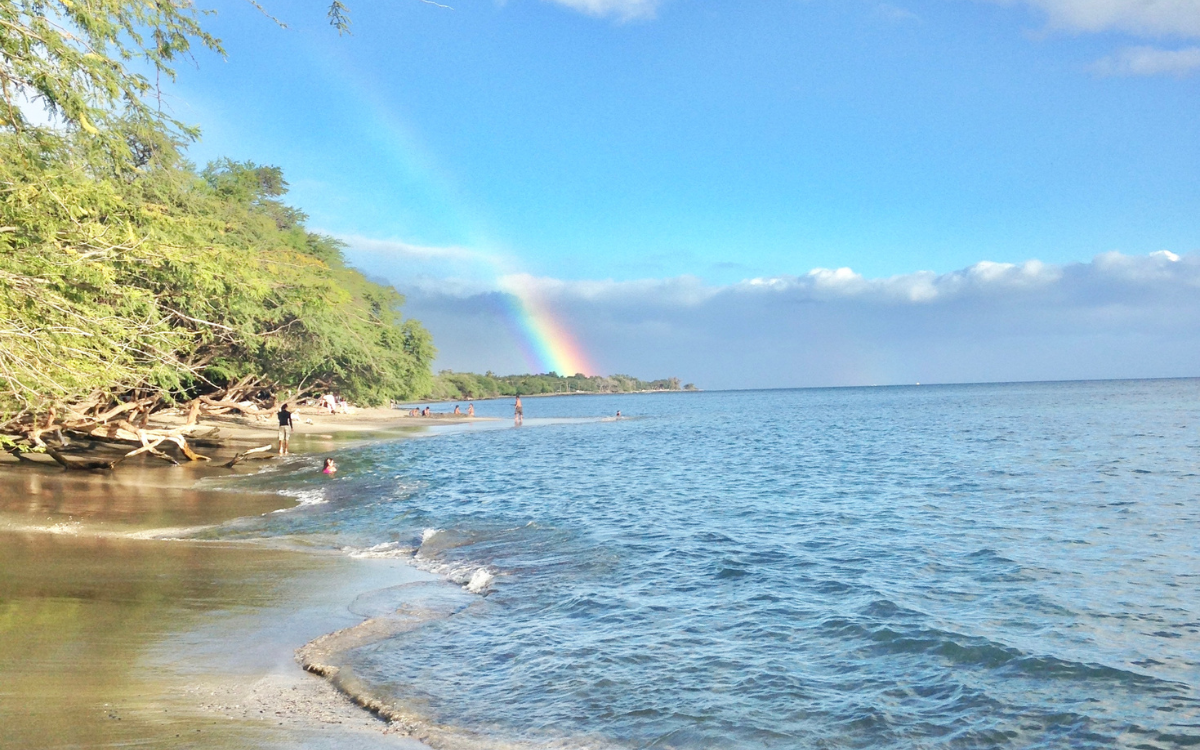
The Best Time to Go to Hawaii
And I know these days most people are planning their vacations around work/school/holiday schedules and generally have an idea about when they’re going to go, but if you’re wide open and trying to pick the best time to go to Hawaii, here are a few things to think about:
As far as weather goes, Hawaii is pretty temperate year round, but their seasons technically match ours on the US mainland. Our summer is their summer and our winter is their winter.
“Winter” is a relative term in Hawaii, but what it mostly means are big waves and more rain.
Winter is the wet season in Hawaii so while most resort areas on the Hawaiian islands occupy the leeward (dry and sunny) side of the island, if you’re venturing to the north shore or any jungle areas, you’ll likely experience more rain in the winter months. It’ll also be much lusher and greener and you’ll see more waterfalls ; )

The winter months also bring big swells and surf competitions (on Oahu) and many stellar snorkeling spots (Honolua Bay on Maui, Waimea Bay on Oahu, and Tunnels on Kauai) aren’t snorkelable (is that a word??) in the winter.
The difference between “winter” and “summer” is a bigger deal to locals than tourists though. Unless you’re visiting the higher elevation areas of Maui and the Big Island, you aren’t likely to notice much of a difference in the temperature (air or water). Just remember, winter generally means more rain. But if you’re staying in the resort areas (Waikiki and Ko Olina on Oahu, Wailea/Kihei and Lahaina/Kaanapali on Maui, Kona and Kohala on the Big Island, and Poipu on Kauai) you’re going to be pretty good on the sunshine.
And while hurricane season in Hawaii is technically June-November, hurricanes are pretty rare.
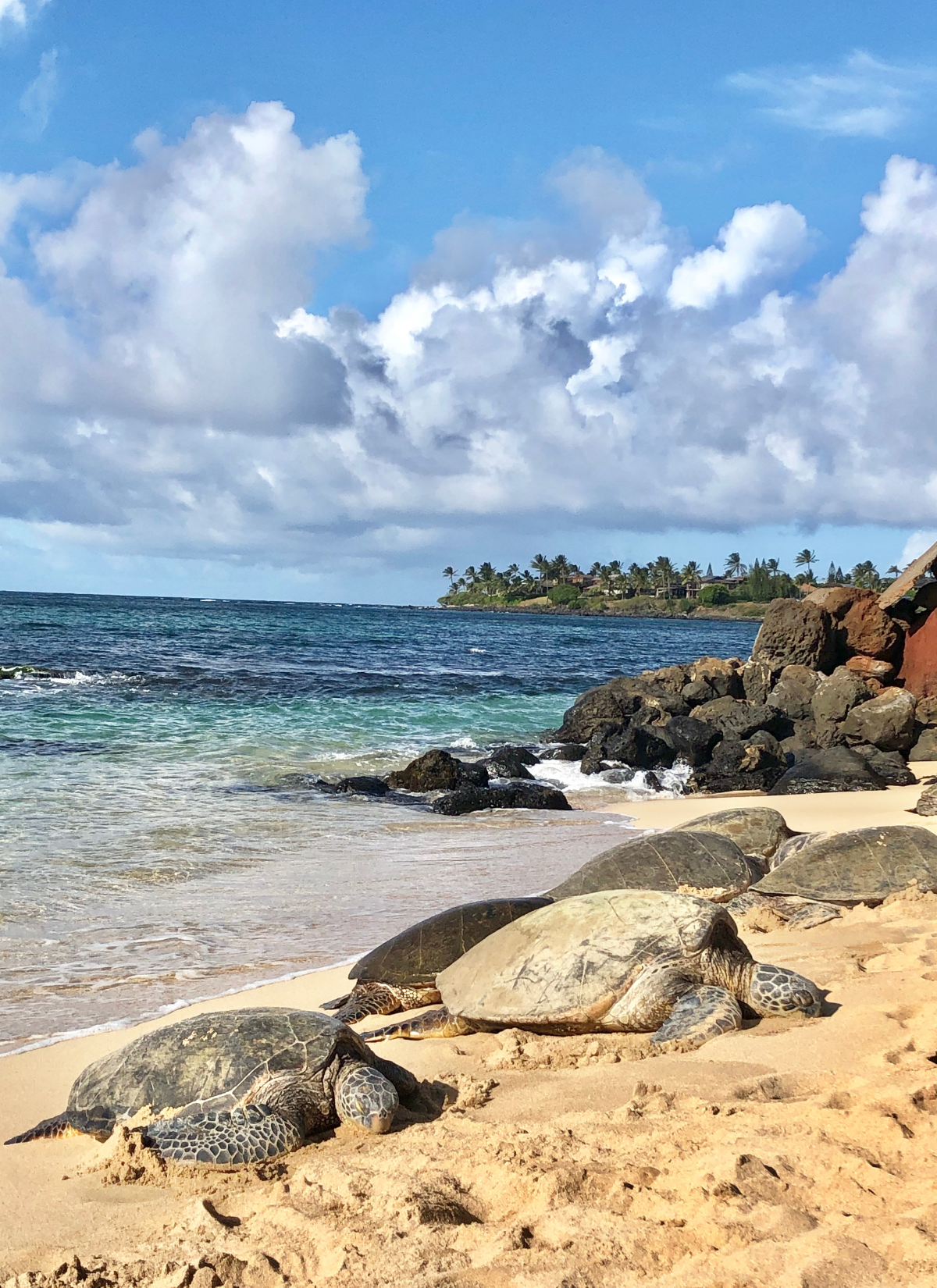
Whale Season
Whale season usually stretches from mid December through mid April. Of course the whales aren’t quite aware of the thousands of tourists in Hawaii waiting for their arrival, so they come when they want to.
The first arrivals could start showing up as early as late October, but they’re few and far between. The end of December through January is when they reallllly start to arrive with February being PEAK whale season.
By mid April, the majority have already started their migration back to Alaska (where they feed), but there could be a few stragglers that hang around into May.
If you’re planning your trip with the main goal of seeing humpback whales…make it February, and make it Maui.
Read more about whale watching in Hawaii here .
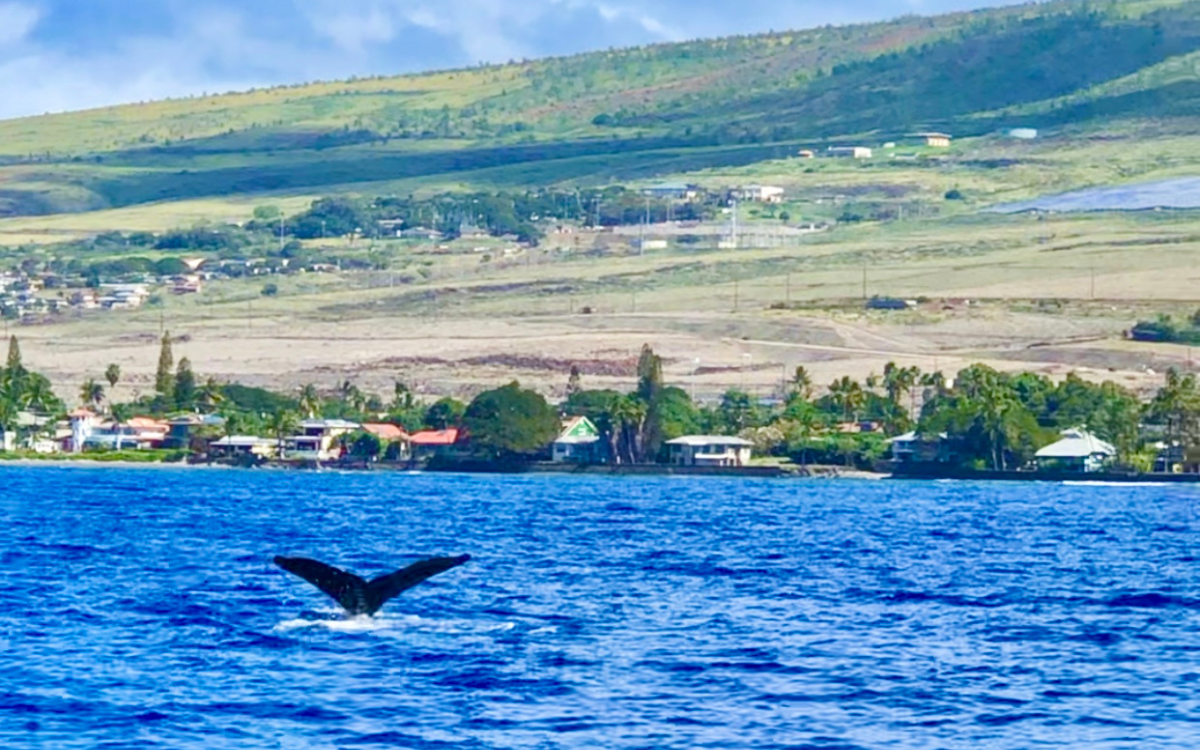
***Want to save major $$$ on your trip to Hawaii? I get asked ALL the time how I’m able to travel so often to Hawaii and stay at really nice resorts. Well, my favorite travel hack is cashing in points to score free airfare and free nights at some of Hawaii’s most high end resorts. Read my full guide on the exact system I use to max out credit card rewards here . Seriously, it’s going to save you soooo much money.
The Cheapest Time to Go to Hawaii
Well, it’s not when kids are out of school ; ) Whenever kids are out of school is high season…the summer and the winter holidays are booming, ESPECIALLY around Christmas and New Years.
Airfare skyrockets around Christmas and you’ll pay a premium at every resort and condo in the islands. If you’re traveling on a budget, avoid Christmas! I would block out the last two weeks of December and the first week of January.
June, July, and the first half of August are when summer crowds flock to Hawaii. Though nothing like Christmas in terms of crowds and prices, the summer months still attract a fair number of visitors and airfare prices sometimes reflect that. If you’re working with some kind of external factors (school schedules, ability to take vacation days from work, etc.) summer is still a good time to plan a trip to Hawaii.
You may not find airfare or accommodations at their rock bottom, but you can still find plenty of deals during this time of year.

So the VERY best time to go to Hawaii in terms of low crowds and therefore low(er) prices is during shoulder season in the spring and fall.
I’ve been to Hawaii pretty much all times of the year and I’m constantly monitoring prices on flights and hotels and I consistently find mid April through May and mid August through mid October to be the cheapest time of year to go to Hawaii.
You can find great airfare bargains during this time and hotel prices are generally as low as you’ll ever find them. Kids are either just wrapping up school and have a lineup of events (prom, graduation, etc.) or they’ve just started back to school so no one is skipping school for vacation.
Also, while these are transition seasons, you’ll have mostly summer weather. Late spring has the perk of everything still being super green from all the winter rain, but early fall has the perk of warmer air and water temperatures on the coattails of summer (both are relative though because Hawaii is pretty much always “green and lush” and “warm and sunny.”
(an end to the busy summer travel season) and holiday travel hasn’t started yet so it’s a nice little lull.
You’ll have mostly summer weather although October is usually a transition month.
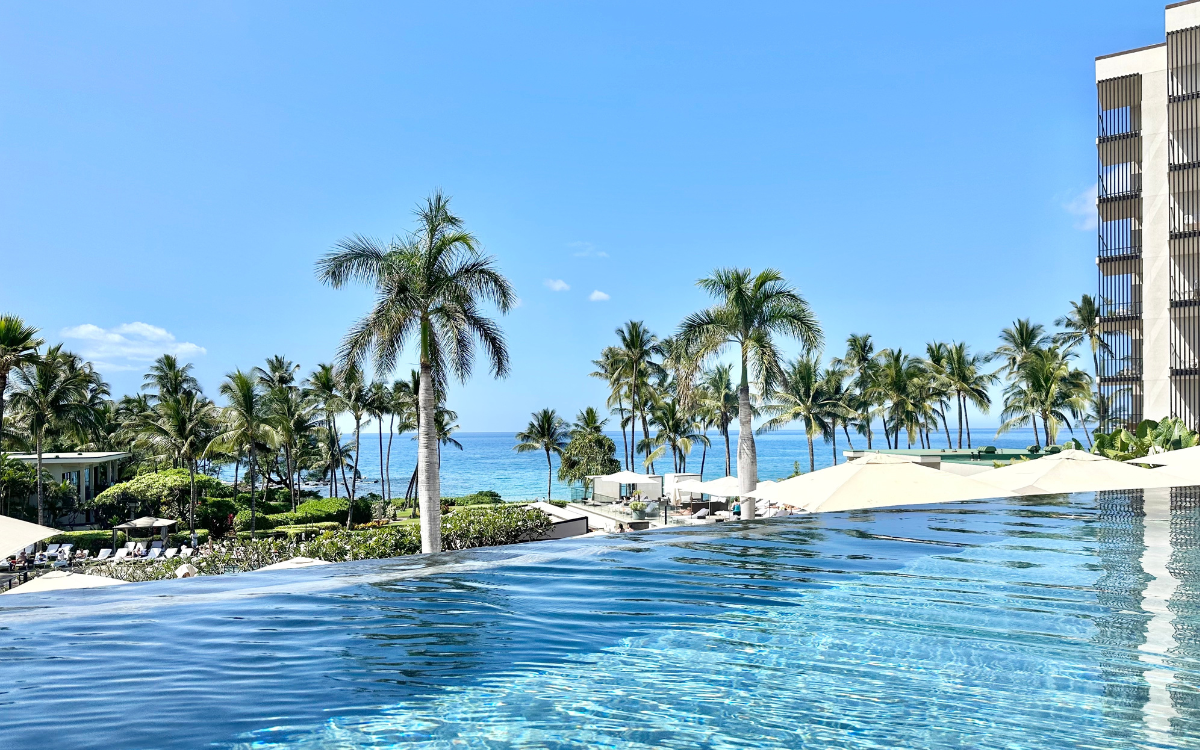
Avoiding Crowds
I’ve already mentioned Christmas and the general busyness of summer, but another window to be aware of is Japan’s Golden Week.
Japanese tourists flock to Hawaii year round, but their prime travel time (comparable to our winter holidays) is Golden Week. This week at the end of April/beginning of May (April 29-May 5, 2025) is a stretch of four national holidays over the span of seven days. So it’s a major travel time.
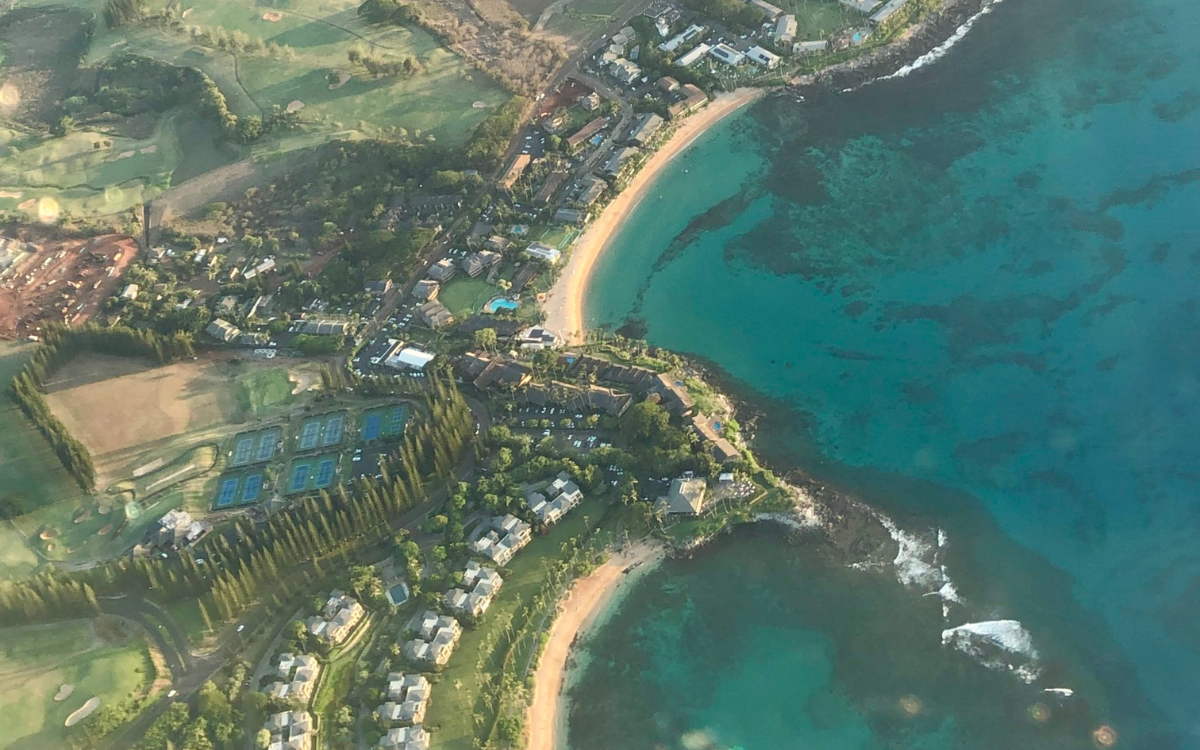
While I don’t think you necessarily see more crowds in general during this time in Hawaii (because it’s the low season for US travel), it’s a higher concentration of Japanese travelers and sometimes that means higher prices at resorts and hotels. This is mostly on Oahu, but you may notice it a bit at the high end resorts on the outer islands too.
I don’t think this is something to reschedule a trip around, but if you’re wide open you may find better prices (and slightly fewer crowds) by avoiding these days. Just something to look into.
That being said, if you like Japanese culture, I think sometimes the hotels/shops/restaurants put our special offerings that cater more to Japanese guests during this time and that could be attractive.
For example, at Disney’s Aulani Resort on Oahu, character meet and greets, merch, and snacks that vibe with things that are popular with Asian visitors (namely fan favorites like Duffy, Shellie May, and Olu Mel) are featured more plentifully during this time of year. Read this post if you have no idea what I’m talking about ; )
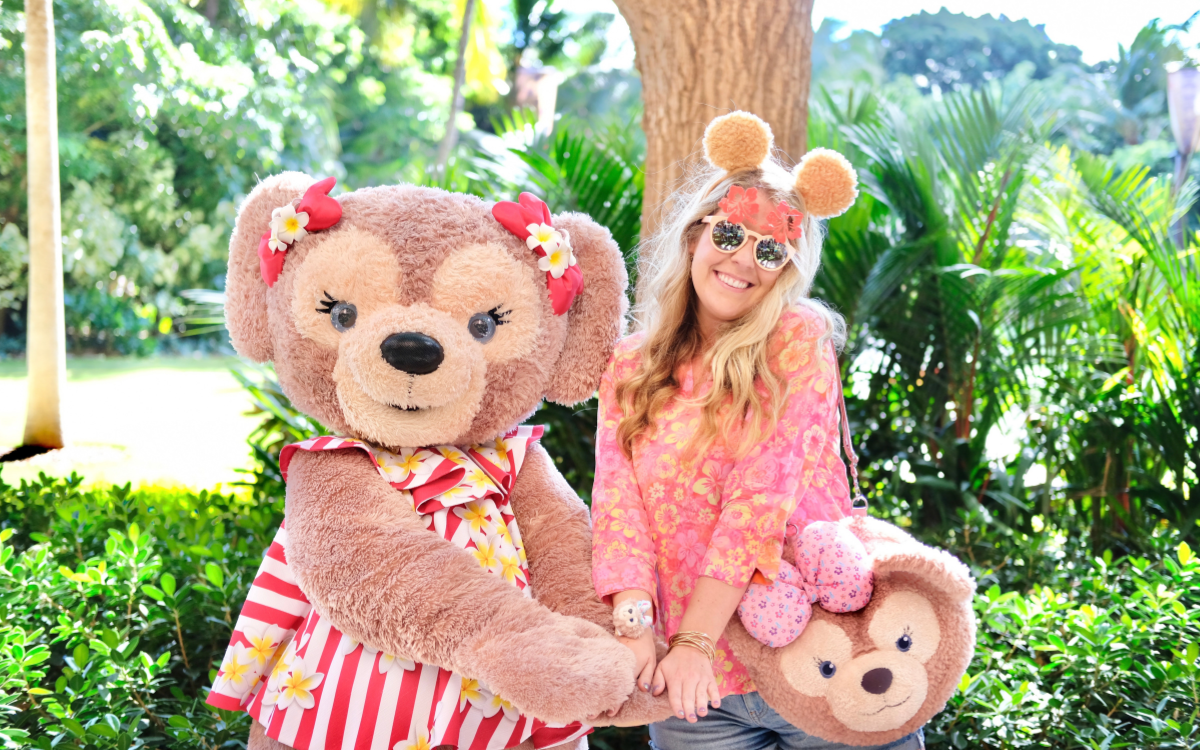
There may be more shopping collections and opportunities at places like the Ala Moana geared towards Japanese visitors too. Basically, don’t miss the Hello Kitty merch.
And I would also be aware of the IronMan World Championships which are hosted in Kona (Big Island usually towards the end of October (October 26, 2024 this year). This event brings a LOT of people to the island and congestion around Kona in particular. Can you avoid it if you’re staying on another part of the island? Yes, but have a good plan.
Side Note: If you’re looking for a rental car for your trip, I LOVE Discount Hawaii Car Rentals . They’re seriously the only company I ever use. They’ll give you the very best prices, you don’t have to reserve with a credit card or pay until you show up, you can cancel and re-book anytime if you find a better rate, and they usually have a special that adds additional drivers for no fee. It’s a no brainer. Click here to check rates for your trip.
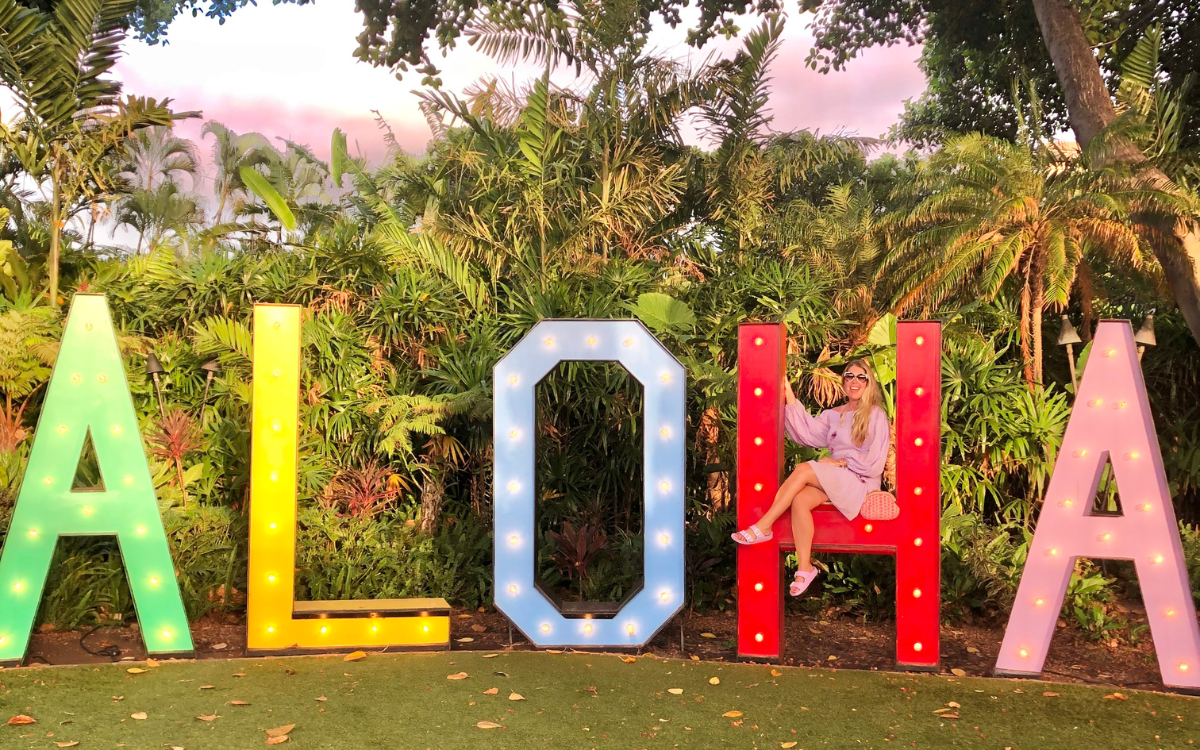
Special Events in Hawaii
Sometimes it’s fun to plan your trip to coincide with a special event. Here are some big ones throughout the islands:
Merrie Monarch Festival (Hilo, Big Island in March 31-April 6, 2024)
Honolulu Marathon (Oahu on December 8, 2024)
Made in Hawaii (Oahu on August 23-25, 2024)
Made on Maui (Maui on November 1 and 2, 2024)
May Day (All Islands on May 1)
Hawaii International Film Festival (October 2-13, 2024)
Prince Lot Hula Competition (Oahu on July 20, 2024)
King Kamehameha Celebration (All Islands from June 7-15 )
Hawaii Food & Wine Fest (Big Island, Maui, and Oahu in October )
Kona Coffee Cultural Festival (Big Island on November 1-10, 2024)
Kapalua Wine & Food Fest (Maui on June 6-9, 2024)
Kauai Chocolate & Coffee Festival (Kauai on October 20, 2024)
My Favorite Times to Go to Hawaii
Like I said, there’s never a bad time to go to Hawaii, and I’ve tested that out ; )
But here are the times of year I keep coming back to…
Shoulder Season in April/May and September/October
I am a hotel/resort person so I always have a list of places that I want to stay. And I consistently find the best rates in either late April through May or late August through October. So that is very attractive to me. The only downside about visiting during these times is that it’s the best part of the year weather wise where I live. So escaping home for a trip to Hawaii just isn’t as appealing as it is in…
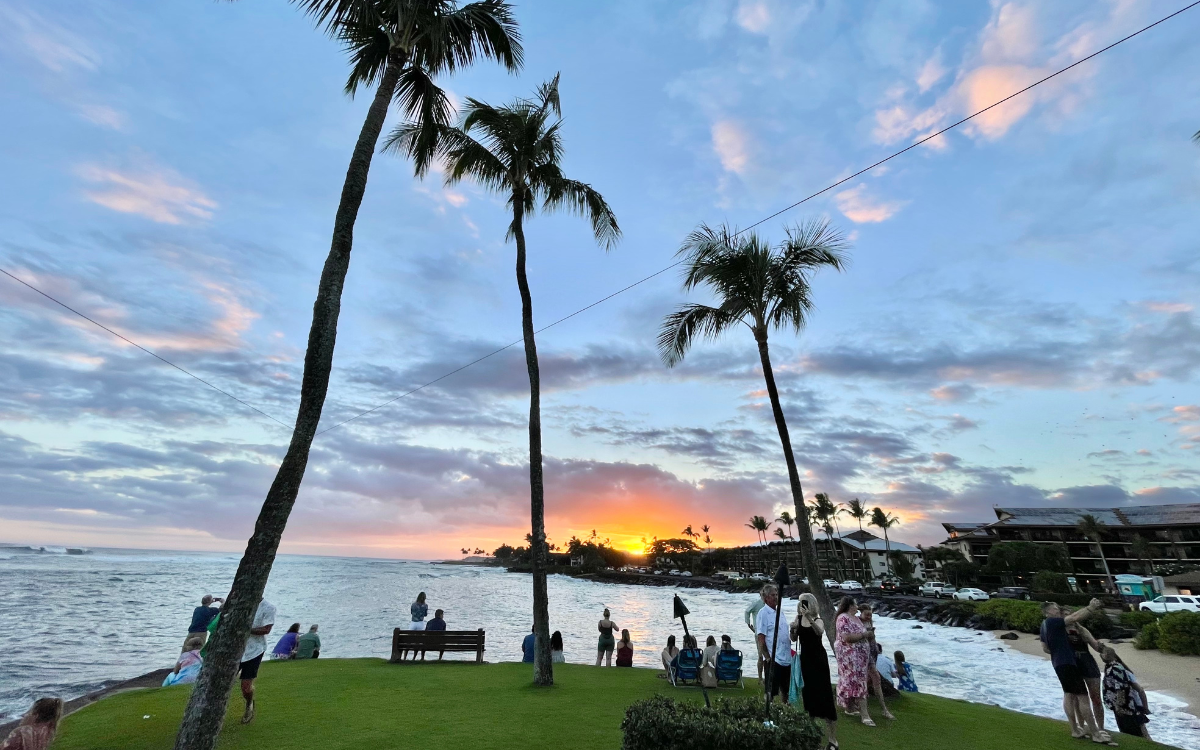
February
This brings me to my FAVORITE time of year to go to Hawaii. February is not necessarily the cheapest or the least crowded (it’s also not the most!), but there is NOTHING more luxurious than escaping the long, cold, dark winter where I live for a trip to Hawaii.
I will pay a little bit more as a “winter tax” and while visiting Hawaii anytime is a treat, visiting Hawaii during the winter is my ultimate treat. Plus, there are whales ; )
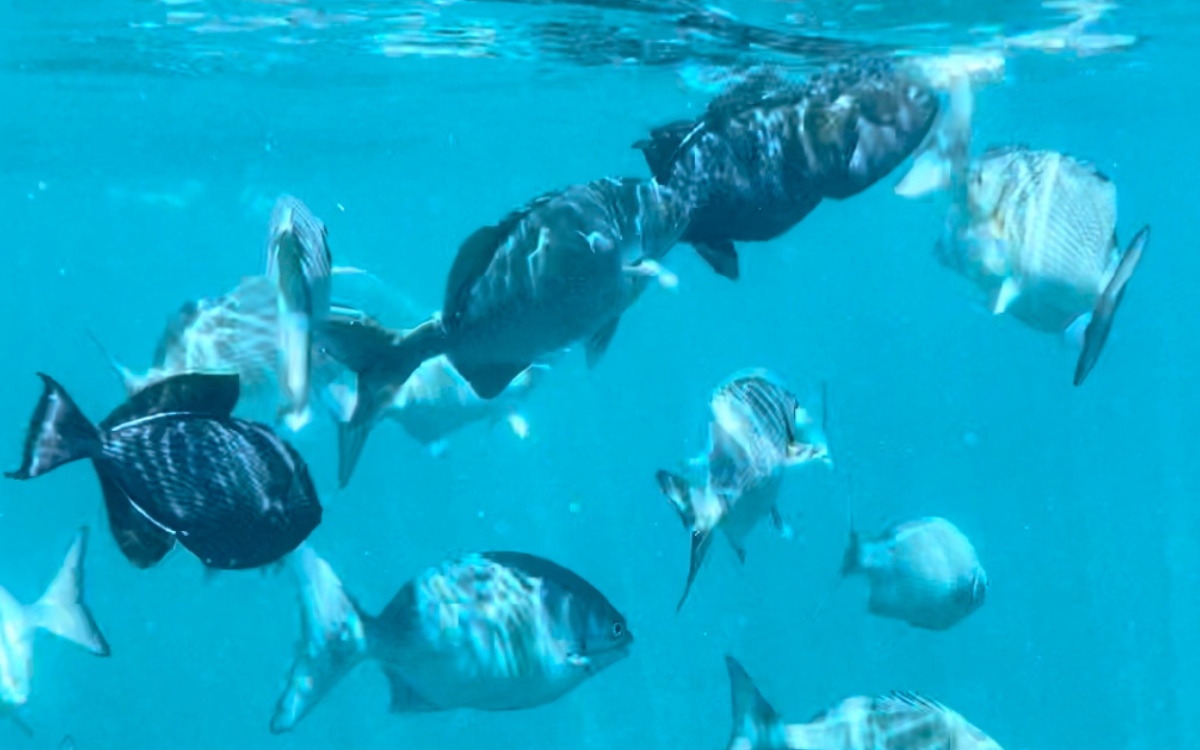
Here’s one more really important thing you need to know before your Hawaii trip…
Reservations You Need to Make BEFORE Your Hawaii Trip
You’ve got your airfare, hotel, rental car and your big activities booked, so you should be good to go, right? Wrong!
Travel is BOOMING in Hawaii so a lot of state and national parks used the closure and reopening to institute reservation systems at some of the island’s most popular spots to make things a little more sustainable.
That means that there are now over half a dozen sites (beaches, trailheads, etc.) that require advance reservations. And some sell out well before you arrive on the island so you really need to have some sort of a plan.
I recently saw somebody in a Hawaii travel group post in a panic that they didn’t know they had to make reservations for things in advance…they thought they could just show up and “go with the flow.” I was tempted to say, well, “as long as the flow doesn’t take you somewhere that requires reservations, you can!” ; )
But I don’t want YOU to be that person, so I’ve pulled together a list of all the places you need to reserve entry in advance (plus all the details on booking windows, price, links, etc.) and a handful of popular tourist hotspots that book out really far in advance too.
Haleakala National Park (Maui)
To visit Haleakala National Park for sunrise at the summit, you must make reservations in advance here.
Reservations are required to enter the park gates between 3AM and 7AM (sunrise hours).
Online reservations are $1 per reservation/vehicle PLUS you’ll pay the park entrance fee of $30/vehicle when you arrive (National Park annual passes are also accepted at the gate).
The reservation booking window opens 60 days in advance at 7AM HST. There are also a limited number of tickets released two days before.
You can make one reservation every three days with the same account. So if you want to make reservations for back to back days (in case of weather/conditions), you’ll need to do so with separate accounts (email addresses).
If you can’t get reservations for sunrise, you can enter the park anytime after 7AM without reservations. The summit is spectacular during the day and you don’t need reservations for sunset.
I strongly recommend creating an account before and making sure you’re logged in at 7AM HST because it’s not uncommon for reservations to sell out quickly.
Waianapanapa State Park (Maui)
To visit Maui’s famous black sand beach at Waianapanapa State Park on the Road to Hana, you must make reservations in advance here.
Reservations are required to visit the beach and are distributed in windows from 7AM-10AM, 10AM-12:30PM, 12:30PM-3PM, and 3PM-6PM. And they are pretty strict about exiting by the end of your window time (you can arrive anytime within your window).
It’s $5/person to enter plus $10/vehicle to park and those fees are paid when you book your time slot.
Reservations open up 30 days in advance.
Iao Valley State Park (Maui)
To visit the lush, green mountains and hike at Iao Valley State Park, you must make reservations in advance here.
Reservations are offered for 90 minute time slots beginning at 7AM and ending at 6PM. They ask that you arrive within the first 30 minutes of your time slot.
Entry is $5/person plus $10/vehicle to park.
Diamond Head (Oahu)
To hike to the top of Waikiki’s famous Diamond Head, you must make reservations in advance here.
Reservations are offered in two hour increments beginning at 6AM (6AM-8AM, 8AM-10AM, etc.) and ending at 6PM. If you’re parking onsite, they ask that you arrive within the first 30 minutes of your reservation window.
Tip: I recommend booking one of the first two time slots because there isn’t much shade on this hike and it gets pretty hot.
Hanauma Bay (Oahu)
To snorkel at Oahu’s pristine Hanauma Bay, you must make reservations in advance here.
Entry times are staggered in 10 minute increments from 7AM to 1:20PM with roughly 1000 slots being assigned in advance every day.
Reservations can be made two days in advance and they open at 7AM HST. They’re usually gone in minutes (if not seconds).
If you’re unable to get an advanced reservation, you can try for a day of, walk in ticket. They open at 6:45AM and they only have a limited number available. Everyone in your group needs to be present when you purchase your tickets in person.
There are no reservations for parking and it’s first come, first serve. $3/vehicle.
It’s $25/person to snorkel at Hanauma Bay (12 and under, active military, and locals with HI ID are free).
The Hanauma Bay Nature Preserve is open Wednesday through Sunday (CLOSED MONDAY AND TUESDAY) from 6:45AM-4PM. Last entry is at 1:30PM, the beach is cleared at 3:15PM and you have to leave the facility by 4PM.
Jellyfish patterns can also affect whether or not the bay is open so double check the day before/day of.
USS Arizona at Pearl Harbor (Oahu)
If you want to take the boat tour at Pearl Harbor out to the USS Arizona, it’s recommended to make advance reservations here.
Online reservations are guaranteed a specific boarding time to go out to the USS Arizona. If you’re unable to get an advance reservation, you can wait standby when you arrive. The line could be short (15 minutes or so) or long (hours) and it just depends on the day (if they’re having problems with the loading dock sometimes they don’t take many from the standby line) and the time of day.
Reservations are supposed to open up 60 days in advance, but keep an eye on your exact dates, because lately they’ve actually been opening up about 57ish days in advance???
They also release a small batch of tickets the day before.
The boat ride out to the USS Arizona is free, but it’s $1 to make the reservations online.
They recently started charging $7/vehicle for parking at Pearl Harbor.
Haena State Park / Kalalau Trail (Kauai)
If you want to hike Kauai’s famous Kalalau Trail, you must make advance reservations here. You’ve got three options here:
1) Parking & Entry: This is the most flexible option and also the most limited. THESE RESERVATIONS SELL OUT IN LESS THAN A MINUTE. There are three time slots available: 6:30AM-12:30PM, 12:30PM-5:30PM and 4:30PM to sunset. You can purchase multiple time slots if you want to stay longer. It’s $10/timeslot (parking) plus $5/person and you have to reserve every person when you initially book. Everybody has to arrive in the same car and your ID needs to match the reservation.
2) Shuttle & Entry: If you can’t get parking at the trailhead, there’s also a shuttle option. Shuttle reservations are $35/person (16+), $25/person (ages 4-15), 3 and under can ride free. The shuttle runs every 20 minutes 6:20AM to 6:40PM.
3) Entry Only: If you’re a Hawaiian resident (with HI ID) or someone WITH a Hawaiian resident, you can purchase entry only for $5/person with no advance reservations. Also, if you’re walking or biking to the trailhead you can do this option. But there is NOWHERE to park in the area to walk in. So this really only works for those with bikes or who are staying close enough to walk. They will tow your car if you park outside the designated areas.
The reservation window opens 30 days in advance at 12AM HST. The parking & entry option usually sells out in a minute, but the shuttle availability will last longer.
There are a TON of FAQs here including the possibility of snagging a canceled reservation.
Other Things to Book in Advance
Hawaii is a busy place these days! Besides the state and national parks above, here’s a handful of miscellaneous things you should make reservations for in advance (if they’re on your radar):
Mama’s Fish House (Maui) : The iconic spot is the most popular restaurant in Hawaii and dinner reservations usually start filling up about 6 months in advance (they open up bookings 18 months in advance). Make reservations through their website and if the dates you want are already booked, you can join a waitlist. Most people have pretty good success getting in on the waitlist (even if it’s for lunch).
Old Lahaina Luau (Maui) : Honestly, any luau you’re planning to attend you should book early, but most people are usually shocked how far out the Old Lahaina Luau books out. Book it as soon as you know your dates (I think they open at the six month window). They also have a waitlist.
Kualoa Ranch UTV Tour (Oahu) : Everybody loves Jurassic Park so getting to ride UTVs where they filmed the movies is very popular. The ranch offers a lot of different tours but the UTV tours usually book out a couple of months in advance.
Spa Reservations : If you’re staying at a resort with a spa (or planning on visiting one), don’t wait until you arrive to make your reservations. I’d make them at least a month in advance.
Tee Times : Same for golf, reserve your tee times well in advance.
Dining Reservations : Any “fancy” or resort restaurant is likely to be booked up these days so if you like having a nice dinner every night, make your plans in advance.
P.S. Thanks for sticking around and reading this whole post! If you have ANY questions about planning your trip to Hawaii, you can join my free Facebook group here . I’m there answering questions every day and there are 7500+ other friends who have a ton of Hawaii information to share!
Also, if you want to follow along on my travel adventures in real time, you can follow me on Instagram (@ caitylincoln ). My post captions are full of travel tips and I have a ton of story highlights and videos with great info. And please share my account with your friends that are headed to Hawaii! Your support really helps me keep this blog running!
Oahu Beaches Guide
Hanauma Bay, Waikiki, Lanikai, ...
Oahu Sights Guide
Pearl Harbor, Nuuanu Pali, Honolulu
Oahu Hiking Trails Guide
Waimea Falls, Diamond Head, ...
Oahu Regions Guide
Honolulu, North Shore, Waianae, ...
When to Visit Oahu
Learn about the best time to visit Oahu →
Oahu Travel Tips
Our Oahu travel tips & recommendations →
Oahu Top Picks
Explore Oahu's Must See & Do →
All Hawaii Island Guides →
Oahu Accommodations →
Lodging by type.
- Oahu Hotels & Resorts
- Oahu B&B's and Inn's
- Oahu Vacation Rentals
Popular Reads
- Where to stay on Oahu →
- When to visit Oahu →
- Oahu Attractions →
- Oahu Weather →
Explore Oahu Hotels & Resorts Search Now
Oahu Activities →
Oahu tours by type.
- Land Tours & Services
- Ocean & Water Tours
- Plane & Helicopter Tours
- Oahu Itineraries
Popular Oahu Activities...
- Oahu Luau's →
- Pearl Harbor Tours →
- Diamond Head Tours →
- Oahu Snorkeling Tours →
Explore Oahu Tours Search Now
Top Times of Year to Travel to Oahu
Handpicked Tours & Activities
Discount Hawaii Car Rentals
Best Time to Visit Oahu
Oahu tips for when to visit.
Wondering when to visit Oahu? If you've narrowed down your selection of islands and Oahu is your destination, you've made an excellent choice! Oahu has excellent weather year-round; in fact, many people believe it has the best weather of all the islands. Maybe that's why almost half of all visitors to the state of Hawaii pick Oahu. Or perhaps it's because Oahu is the most scenic of all the islands, or... well, that list could go on and on. Oahu is an excellent choice for visitors!
The best time to visit Oahu, taking into consideration the weather, demand for accommodations, and how crowded (or not) the island is - are the months of early April, May, September, and early October. Some call these Oahu's 'off-season periods' or the 'shoulder months.'
Below we'll cover Oahu visitor arrivals, Oahu's weather and climate, accommodations, rates, and what to expect on a visit during each season on Oahu.
— article continued below —
2024 Oahu Visitor Guides
Visiting Oahu soon? Be sure to grab your copy of one of our updated Oahu Visitor Guides .
~ Trusted by Millions of Hawaii Visitors Annually ~
Oahu Visitors Arrivals
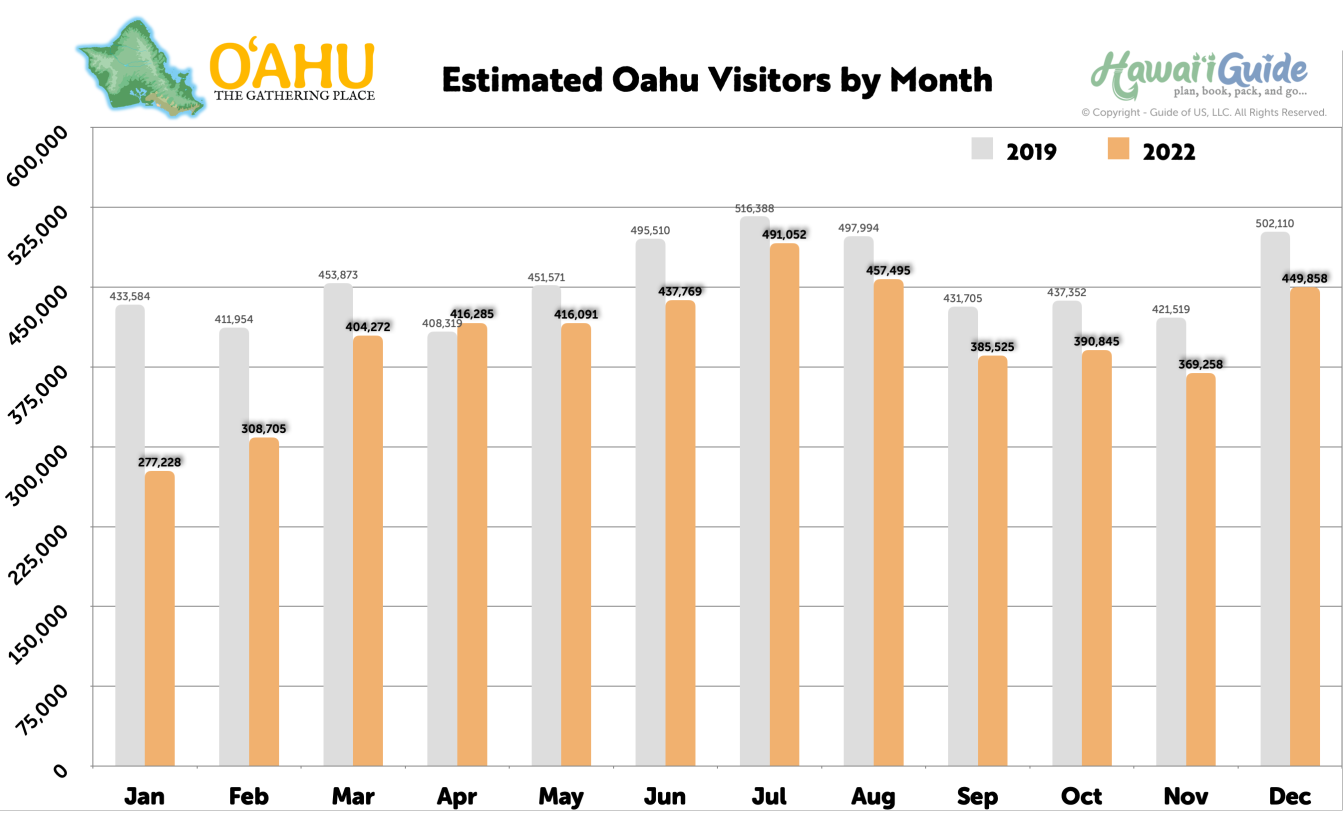
Typical Oahu Visitor Arrivals (2019 & 2022) - Click to Enlarge
What to Expect on Oahu in 2024
Visiting Oahu within the next few years, between 2024 and 2025, means you'll avoid the increased crowds projected to return by 2026. As of late 2023, Oahu remains the only island with fewer visitors compared to the same period year over year, and also lower than pre-pandemic figures. So if you're visiting soon, you've selected a great time!
Despite the many challenges of the pandemic and subsequent inflation, Hawaii appears to be on track for record visitor arrivals in the coming years.
We'll keep you posted... this article will be updated accordingly as things change.
Weather & Climate
Weather is the primary concern of many travelers, so it's a relief to know you don't have to worry about it much on Oahu. Even in the winter months, from mid-November through March, the high-temperature averages somewhere around 80°F (26°C). In the summer months, the high typically average somewhere in the mid- to upper- 80s F (30-32°C).
As with all the islands, Oahu does see a bit more rain during the winter months, especially on the windward (east) side. Typically, showers are scattered, and the sun quickly returns after a brief rainstorm. Plus, there's the added benefit that rain keeps the island beautiful and lush. Not to mention, winter is prime whale-watching season. For more detailed information about the weather, check out our Oahu Weather article.
Hurricane Season
Hurricane and tropical storms are historically rare events on Oahu and Hawaii in general, but it’s still important to be prepared for storms if you visit during Hawaii hurricane season - June through November. The last few years have seen increased activity around the islands, including Oahu, so it’s essential to monitor weather conditions when planning and taking your trip.
Average Oahu Temperature and Precipitation Charts
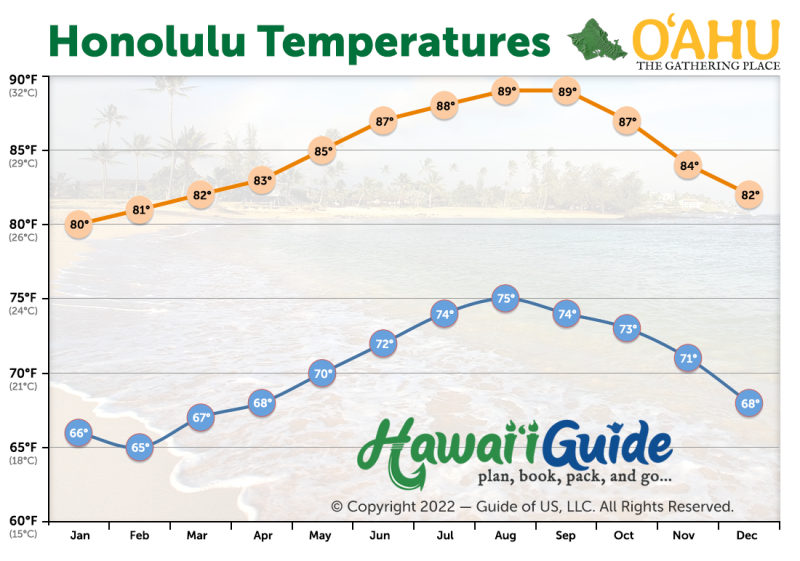
Honolulu Average Temperature

Honolulu Average Precipitation
Oahu Accommodations & Rates
Accommodations wise, you'll find better deals during the months of April-May and August-November, when demand for rooms is lower. The holidays are the busiest time on the island, and the increased demand sends prices rocketing.
This is especially true during Christmas, when the island feels quite crowded, in our opinion. For more information on accommodations on Oahu, be sure to read our article about Where to Stay on Oahu .
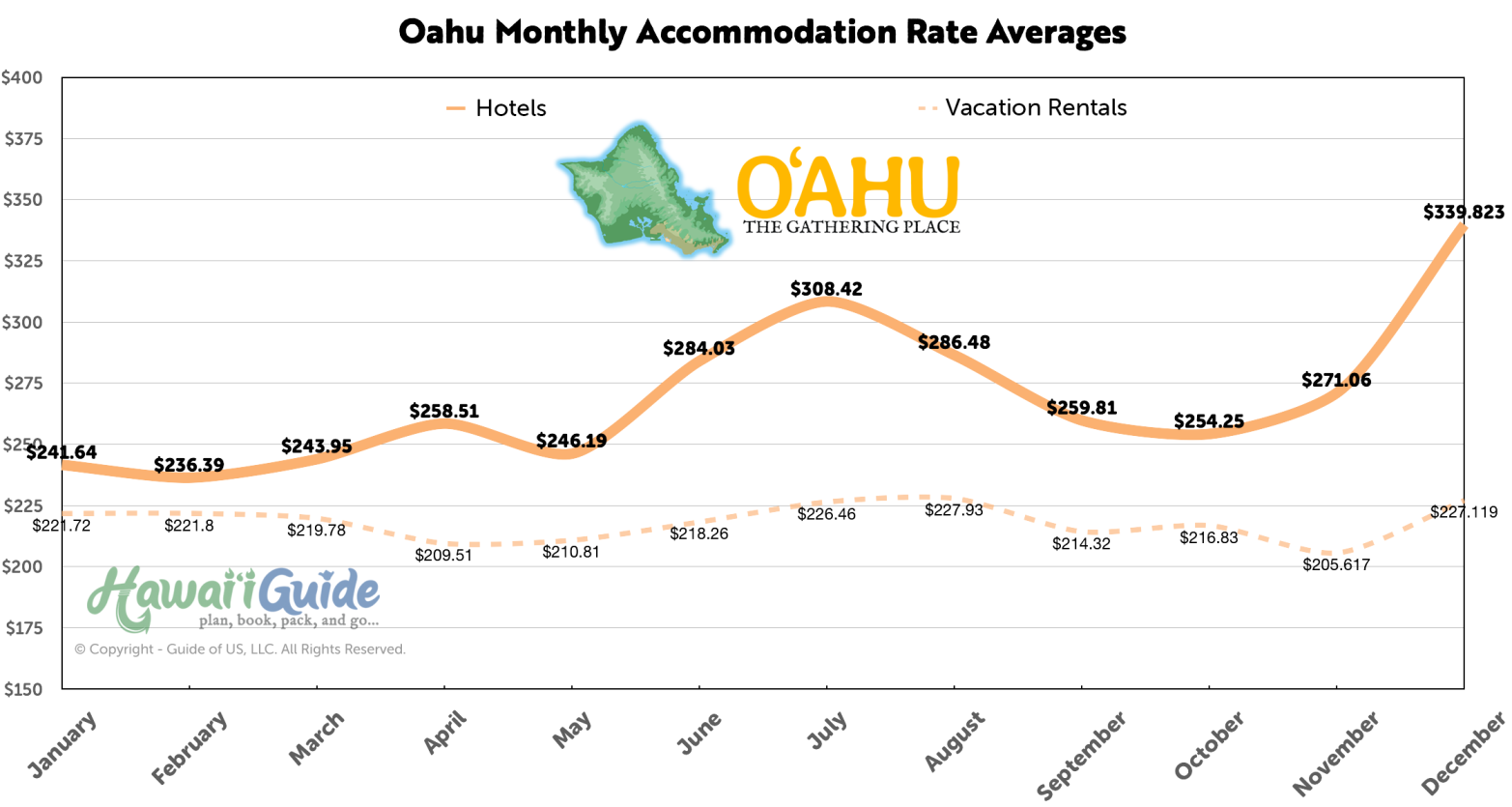
Oahu Accommodation Rate Averages (click to enlarge)
Oahu Seasonal Expectations
Events updated for 2023 - 2024.
We've included the dates and months that most Oahu events are typically held below, but please be aware that currently, things are subject to change.
Visiting Oahu in January, February, or March
The winter months of January - March will be some of the coolest on the island, and you may want to keep a light jacket on you for the afternoons. There is still the chance for increased precipitation this time of year, but most of that rain will likely occur in earlier winter; Oahu starts to dry out a bit by March.
The Chinese New Year celebration falls in either January or February and features lion dances, night festivals, and fireworks. Also, if you are lucky during these months, you might have a chance to spot some whales; this is peak Humpback whale season in Hawaii.
Oahu Winter Events:
- Sony Open in Hawaii (January) - The Sony Open is known to golf fans as the largest charity golf tournament in Hawaii. Since 1999, the event has raised nearly $20 million for non-profits.
- Chinese New Year Festival (January) - Typically held at Chinatown Cultural Plaza (100 N. Beretania Street)
- Honolulu Festival (March) - Hawaii’s premier cultural event, promoting mutual understanding, economic cooperation, and ethnic harmony between the people of Hawaii and the Pacific Rim region.
Be sure to also regularly check our Oahu current event pages for:
- January Oahu Events
- February Oahu Events
- March Oahu Events
Visiting Oahu in April, May, or June
The early spring months are the best time to visit Oahu . Temperatures are not yet as warm or hot as they'll be in the summer, and the large crowds have yet to materialize on the island; though, by June, visitor arrivals will increase significantly compared to the slower spring months. This is also one of the drier periods on the island, so it's a great time to visit weather-wise.
There are only two spring periods to potentially avoid if you're seeking to miss the crowds on Oahu. The first is Japan's "Golden Week" - usually held in April, which is a national holiday famous for bringing large numbers of visitors to Hawaii from Japan. The second period to potentially avoid is mid-to-late June, which can also be more crowded on-island.
Oahu Spring Events:
- Waikiki Spam Jam (April) - Come and celebrate one of Hawaii’s favorite foods, spam.
- Lei Day Celebration (May) - Every May 1st, Oahu celebrates Lei Day, a festival celebrating Aloha in Hawaii.
- Lantern Floating Hawaii (May) - Held each Memorial Day at Ala Moana Beach Park, visitors can observe a beautiful assembly of lanterns floating on the ocean in memorial of lost loved ones.
- Kamehameha Day Celebrations (June) - Celebrating the life of King Kamehameha, who united the Hawaiian Islands.
- April Oahu Events
- May Oahu Events
- June Oahu Events
Visiting Oahu in July, August, or September
The warmest weather will occur on Oahu during these summer months. The earlier summer also typically means increased visitation and crowds on-island, as many families travel to Oahu during these summer months. Crowds will tend to decrease heading into September.
Oahu Summer Events:
- Hawaii State Farm Fair (July) - Started in 1962 by the Hawaii Farm Bureau (HFB), this fair is an opportunity to promote awareness of Hawaii’s agricultural and ranching industries.
- The Made in Hawaii Festival (August) - Showcases local artisans and culinary professionals.
- Aloha Festivals (August / September) - A month-long festival, visitors can get to know Hawaiian culture at this free event celebrating Hawaiian heritage with music, dance, and historical showcases.
- July Oahu Events
- August Oahu Events
- September Oahu Events
Visiting Oahu in October, November, or December
Early fall often can be a good time to visit Oahu, but keep in mind that the wetter weather will typically arrive starting in late October. Temperatures will be lower at this time of year, however, providing a welcome break from the summer warmth/heat.
If you're looking to catch some of the big waves on the North Shore, you'll probably want to visit during this period, when the surf is up. The best waves usually occur during December through mid-February. If you're lucky, you may also catch a glimpse of the humpback whales that spend their winters in the warm Hawaiian waters.
At the end of the year, Oahu celebrates the New Year celebration with fireworks displays throughout the island. The finale occurs at midnight, to top things off, with a massive fireworks show off the beach in Waikiki.
Oahu Fall Events:
- Hawaiian Airlines Moloka'i Hoe (October) - Each year, over 1000+ paddlers from around the world compete in the Moloka'i Hoe, the men’s world championship in outrigger canoe racing.
- The Hawaii Food and Wine Festival (October) - A three-week celebration of fine food and wine, featuring Chefs from around the world.
- Van’s Triple Crown (November - December) - For those seeking big waves & surfing, this is the time of year to be on Oahu’s famous North Shore.
- October Oahu Events
- November Oahu Events
- December Oahu Events
Local Oahu Customs and Visitor Etiquette
Understanding and adhering to local customs and etiquette is a crucial part of immersing oneself in the Hawaiian culture, which is deeply rooted in respect, tradition, and the spirit of 'ohana (family). When visiting Oahu or any part of Hawaii, it's important to show respect for the land (‘āina) and local residents.
- Greetings : It's customary to greet others with a friendly "Aloha" which means hello, goodbye, and love.
- Shoes Off Indoors : It’s a common practice to remove one’s shoes before entering someone’s home.
- Respect the 'Aina : Show respect to the land by not littering, staying on marked trails, and not taking anything from natural sites.
- Don’t Rush : The pace of life is slower in Hawaii; embrace the relaxed pace and don’t rush.
- Respect Sacred Sites : Many areas in Hawaii are considered sacred; obey posted signs and keep a respectful distance.
- Driving Etiquette : Drive with aloha; let others merge, and wave a thank-you (or practice your best 'shaka' sign ) if someone lets you in.
By adhering to these simple yet significant customs and practices, visitors can contribute to preserving the local culture and enjoy a more authentic and welcoming experience during their stay in Oahu.
Book Your Oahu Vacation Today!
It's easy to plan and book your perfect Oahu trip. Enter your trip dates to search Oahu hotels, resorts, and other Oahu accommodations.

Oahu is beautiful all year long.

Our Suggestions for Where to Stay on Oahu
Our suggestions for things to do on oahu.
*Oahu monthly Visitor Statistics are provided by the Department of Business, Economic Development & Tourism .
Recommended Oahu Tours
Terms of use & disclosures.
This website's use is your expressly conditioned acceptance of the terms, conditions, and disclaimers found within our Disclaimer of Warranty and Limitation of Liability page without any modifications. Your use of this website constitutes your acceptance of all the terms , conditions, and disclaimers posted herein. If you do not agree with any part of these terms and conditions, you should not use this website. We also receive a small commission from travel partners for some of the links found on this website. All partners and related links comply with our Advertising Disclosures . For example, as an Amazon Associate, we earn from qualifying purchases. These links do not cost you anything and help provide the necessary funding to maintain this website. Mahalo!
Article Published/Updated: 10-29-2023
Download our Hawaii Map Packet
Includes most major attractions, all major routes, airports, and a chart with estimated driving times for each respective island..
Our popular Summary Guidesheets are now included.
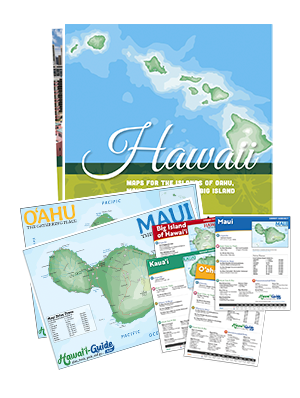
Download your copy of our... 2024 Hawaii Travel Guide
Hawaii-Guide.com has been featured in...

Hawaii Visitor Information...

Try out our new AI Powered Search & Chatbot →

Plus & Premium Benefits
Donate and remove ALL the ads
Mahalo for your support!
By donating to our small business, you accept and acknowledge the donation terms . Mahalo!
Hawaii sees considerably more tourists during certain times of the year
Hawaii when to go, high traffic.
Most vacationers travel to Hawaii whenever their schedules permit, but if the choice is yours as to when you’ll visit the islands, it may be helpful to know more about the best and worst times to go. The time, or season, during which you visit Hawaii can greatly effect your trip.
There are really only two seasons in Hawaii: summer and winter. Both are warm, but the winter months have considerably more rain. In some areas of the Hawaiian Islands, it rains every day during this time of year, but usually no longer than for three days straight in one particular spot. Despite the rain, the high tourist season falls during Hawaii’s winter months and the low season during the summer. During the high seasons the islands will be more crowded with tourists trying to escape the cold weather of the more northern regions. Hotels, resorts, and other businesses on the island use this time to increase their prices, while during the low tourism season, vacationers will be able to find accommodations at discounted rates.
High Season
The peak tourism season in Hawaii starts in the middle of December up until either the end of March or mid-April. During this time Hawaii is a very popular vacation destination, particularly during the last two weeks of December. Temperatures in other parts of the world are at their lowest then, but Hawaii is maintains a daytime temperature of about 78 degrees Fahrenheit. If you plan on visiting any of the islands during this time, you must make your reservations well in advanced, as many hotels and resorts will sell out. Also, along with the crowds, you should expect higher rates not only at the hotels, but also from the airlines and car rental companies.
Several of Hawaii’s festivals and major annual events fall during the high tourism season, including the Aloha Bowl in December and several PGA championships in January. These events are incentives for travelers to visit the region as well. Many families also choose to come to Hawaii during the summer time, between June and August, when school is out. As a result, you won’t find many travel deals during this time, either.
Ironically, the best time to visit Hawaii may be during the off season which falls between the middle of April until the middle of June, and then from September until the middle of December. The number of tourists visiting the islands drops drastically during this time of year, so there are fewer crowds. With fewer visitors, hotel and airline rates decrease significantly and vacationers can find better travel packages. The weather during the off season is also better and more reliable, since there is less rainfall than during the winter months. If you’re looking to save money on your trip, avoid large crowds, or enjoy a little more sunshine during your stay then this may be the best time for you to travel to Hawaii.
Some other things that you may want to consider when deciding on when to take your trip to Hawaii are that Maui, the Big Island, Oahu, and Kauai have the best beaches to visit year-round. Also, the islands see an increase in travel during federal, state, and government holidays, especially those that fall on a long weekend. Vacationing in Hawaii is possible during anytime of year, and it is up to you decide whether you’ll visit during the high or the low tourism season.
Leave a Reply Cancel reply
Your email address will not be published. Required fields are marked *
Save my name, email, and website in this browser for the next time I comment.
- HawaiiActivities.com
- Partner with Us

- Attractions
- Experiences
- Food & Drinks
- Family-friendly
- Private Charters
- Local Events
- Kama’aina/Military Discounts
- Special Deals
- Travel Agent Program
- Affiliate Marketing
- Content Creator Sponsorship
Travel to Hawaii in the Off-Season
Summer’s over, meaning kids go back to school, college starts its fall semester, and the heat finally relents after months of sweat. It also means that one of the peak travel times has passed, and everyone goes back to work to bide their time until the winter holidays. In general, there are less people traveling worldwide, and especially to Hawaii. Here’s a guide on how you can take advantage of the off-season’s offerings!
When is “off-season”?
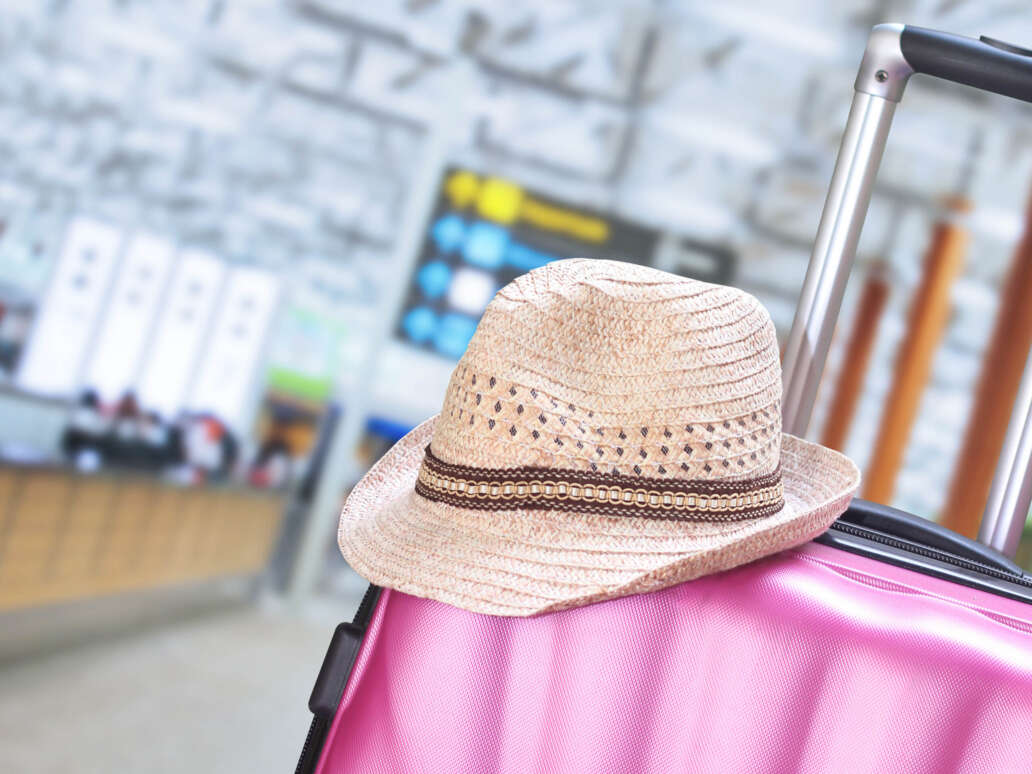
In general, Hawaii’s off-season is in late winter (January to early March), late spring (late April to early June), and fall (September to mid-December). Different people will give you different answers as to when off-season really is, mostly because of how complicated and unpredictable travel and travel-related trends can be.
In addition, each place has it’s own off-season, and most (like Hawaii) have multiple times of year that are considered off-season. Lastly, some people also refer to off-seasons as “low seasons,” “trough times, ” or a variety of other terms that are unique to specific tourist destinations.
For this guide, we’re using the term “off-season” to refer to the less busy times of the year—note that we said “less busy” rather than “empty” or “quiet.
Compared to a lot of other tourist destinations, Hawaii is always busy . With that in mind, every time we describe a trend or pattern just understand that any statements will be relative rather than absolute. So, relatively speaking, the above listed times are much less busy because you avoid the many travelers visiting during their winter holidays, spring breaks, and summer vacations.
Why Come in the Off-season?
It's less crowded.
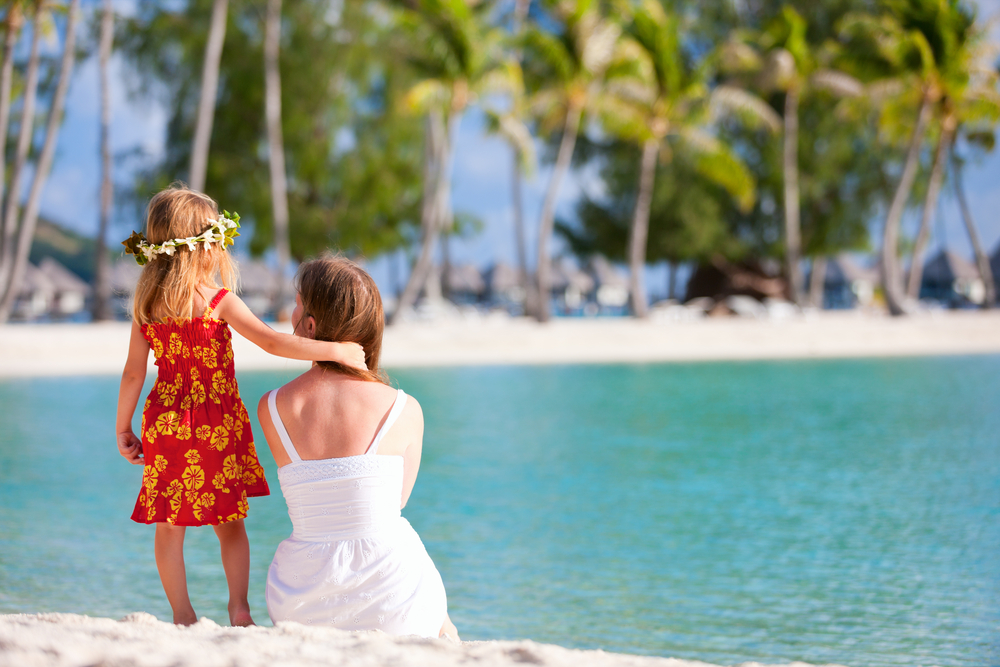
The busy seasons in Hawaii are characterized by climate, holidays, and convenience, but they often involve competition for rates, deals, and personal space. This can make it difficult to enjoy a beautiful Hawaiian sunset or a romantic dinner cruise with a throng of tourists. One compelling argument to travel in the off-season is to skip the crowds.
The summer traveling season , which lasts from early June to August , is filled with large groups of tourists eager to see and do everything before summer ends. However, starting in September, these large groups migrate back home, leaving tourist destinations less crowded. The winter holidays, Thanksgiving, Christmas, and New Year’s, attract many visitors, including “snowbirds” from colder climates. This period is the busiest time of year worldwide, and Hawaii is no exception.
However, between the winter holidays and spring break, travel decreases significantly, making it an ideal time to escape both crowds and the coldest months of the year. To avoid crowds, consider all major holidays and convenient travel times… and avoid them like the plague.
The Prices are Lower
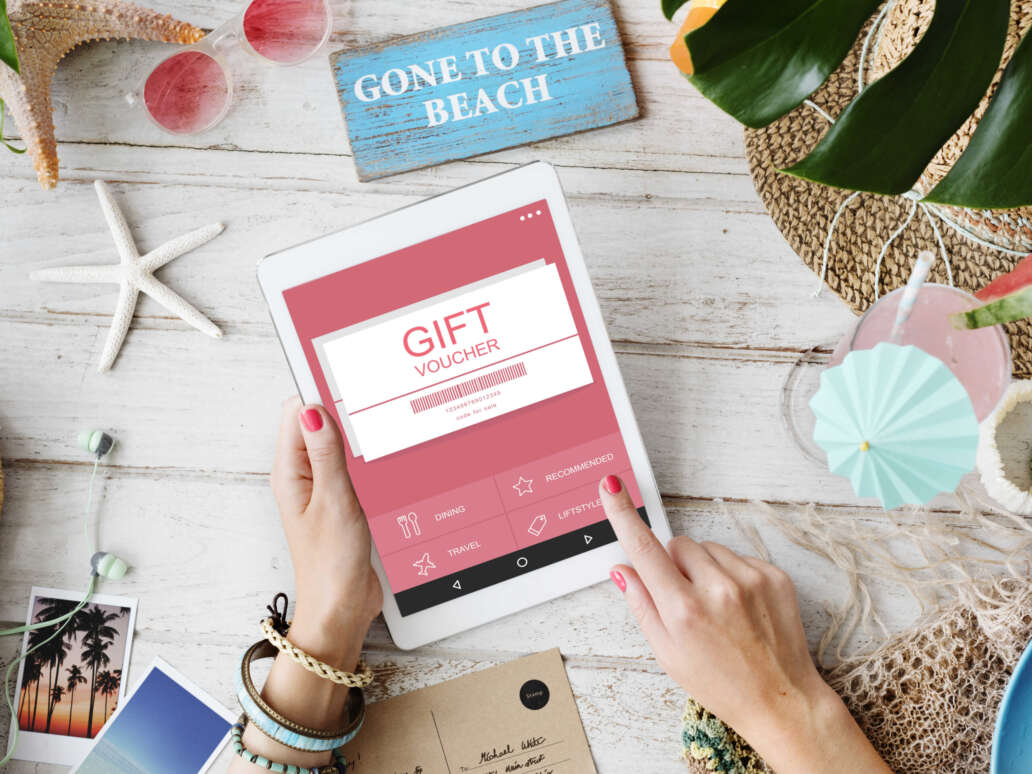
Market forces dictate that as demand decreases, prices must decrease to account for the surplus of supply. In the off-season, hotel and airline companies lower their prices due to the decreased volume of people traveling. Compared to traveling in October, buying a plane ticket during the summer would be one-and-a-half times as expensive, and taking a flight at the end of December would cost more than twice as much. This price trend also applies to hotel accommodations, as the convenience of traveling during major holidays will cost you cold hard cash. On the other hand, it means that things are cheaper in the off-season, there’s less competition for plane seats and hotel rooms, and everything is less crowded than in the busy times of year.
Govisithawaii.com , an excellent resource for Hawaii hotel trends, produced an infographic on Hawaii hotel trends, including a line graph. Many hotel, airline, and tour companies also offer discounts and special deals to stimulate business during the off-season. Off-season flights are usually half the cost of those at Christmas, but airline companies often make last-minute deals on flights to fill up seats when they aren’t busy. Hotels also offer lower rates on accommodations to stay in the black during the less busy months.
In conclusion, the off-season is a time for businesses to lower prices and more deals pop up to encourage people to travel.
The Weather is Particularly Milder
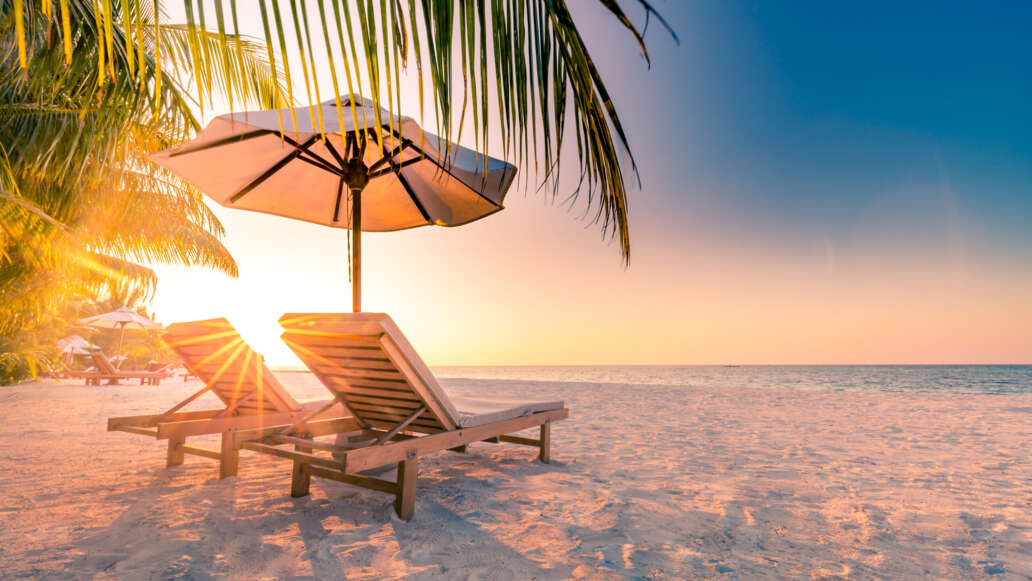
Hawaii’s weather is generally pleasant for tourists, but summer travelers may experience sunburn due to its high ultraviolet index due to its proximity to the equator. The sun’s direct UV rays can reach up to 90° F, making it difficult to avoid skin redness and sensitivity. Summer travelers should apply sunscreen regularly, as the dry months rarely offer cloud cover from the sun’s intense rays.
Winter travelers face unique challenges in Hawaii. Winters are wet, which is beneficial for tropical plants and greener surroundings, but not ideal for beach activities, cruises, or leisurely hikes. Weather forecasts are unpredictable and unpredictable, and weather conditions can be unpredictable and unpredictable. Winter is also prime surfing time for Hawaii residents and visitors, with larger waves and rougher ocean conditions.
The spring and fall months provide a perfect balance between the two seasons, offering occasional rainfall, warm temperatures, and a milder climate. The sun remains with lesser intensity, and occasional clouds provide brief respites and drizzle. Although the water remains fairly warm from the summer and there will be waves, winters are less dangerous. Variable weather also offers advantages, as individual areas may see more sun and rain than others. If you prefer a different climate, driving to another location can provide a change of climate.
There's Greater Adaptability
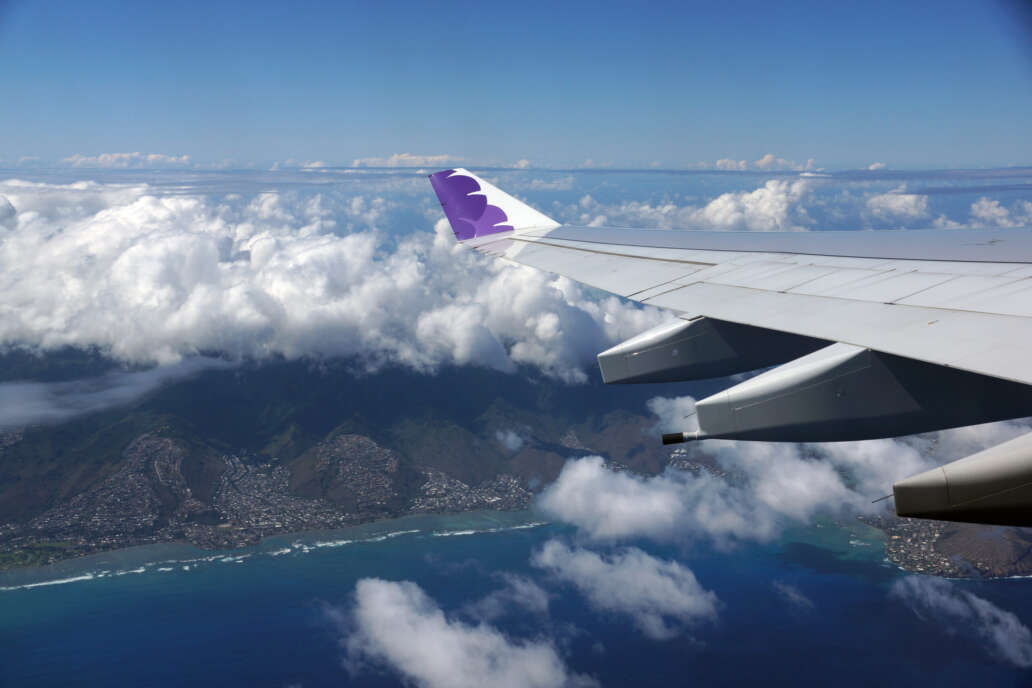
Chances are, if you’re not planning to visit during any major holidays, you’re more flexible as to when you’re willing to travel. An adjustable travel schedule allows you one major benefit: the freedom to bargain-hunt.
Instead of planning a week of travel and hoping for deals on that day, you can search for specials first, then plan your trip around any discounts you might find. You’ll be shocked at how much money you can save bargain-hunting for special deals on flights, hotels, and even tours at any off-season destination.
Obviously, these specials won’t happen during busy times of the year or major holidays when everyone and their aunt decides to travel. However, there’s no way of telling exactly when these deals will pop up, so deal-savvy travelers will have to keep their eyes open and their schedules flexible. And that’s a major strength of traveling off-season that many people overlook: you decide when it’s best to travel instead of being constrained to a calendar.
Summer’s over! Will you be traveling this fall? Do you have any other questions about traveling in the off-season? Let us know in the comments!
Having grown up in Honolulu, Jason writes for HawaiiActivities to help share the beauty of the islands with visitors.
Related Articles
Kapu things to not do in hawaii.
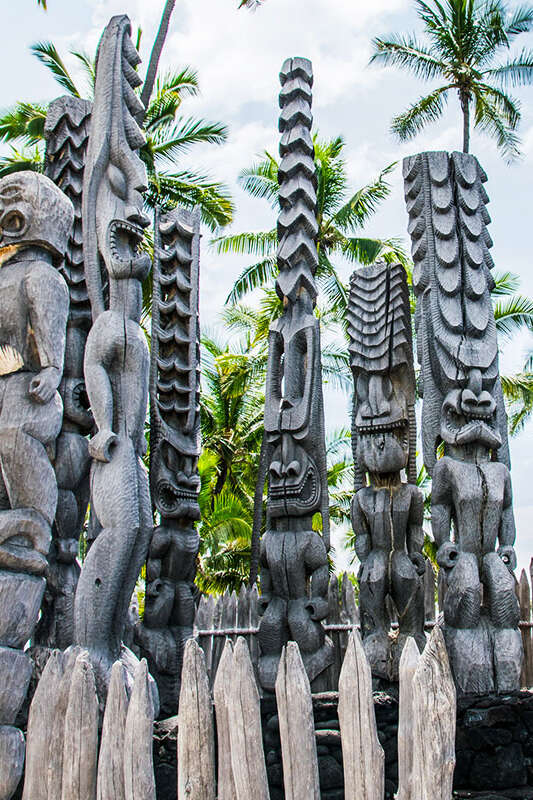
Weather in Hawaii: Climates and Seasons
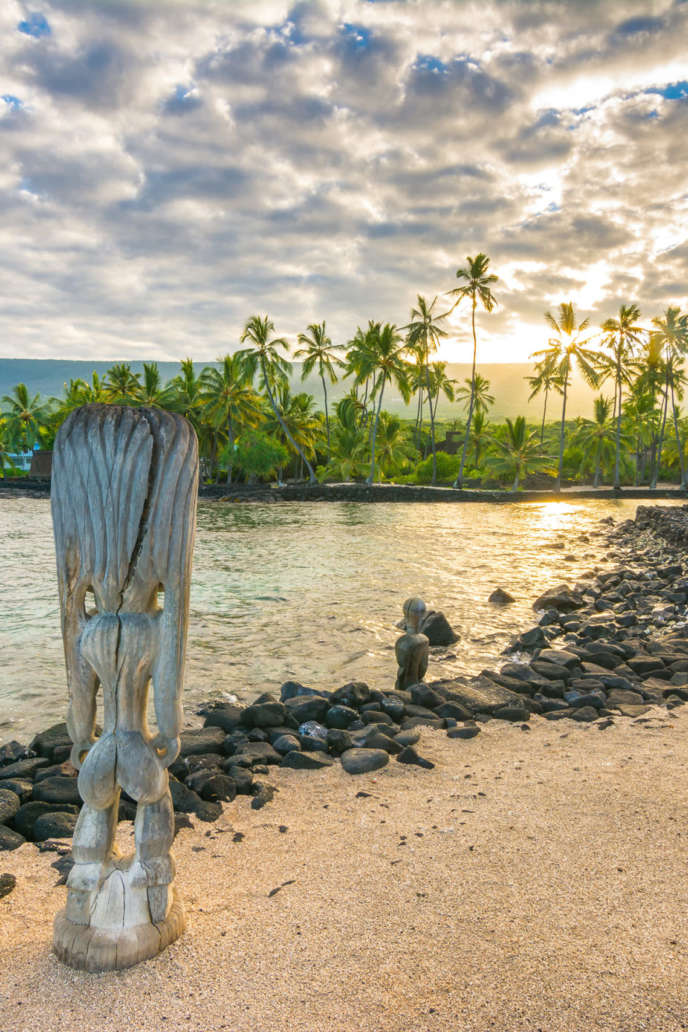
Inter-Island Travel: An In-Depth Guide
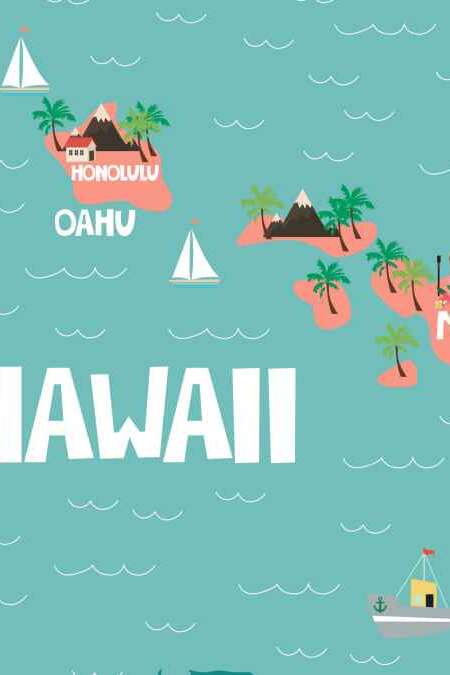
Add comment Cancel reply
Save my name, email, and website in this browser for the next time I comment.
This site uses cookies. By continuing to browse the site you are agreeing to our use of cookies. Learn more
Privacy Preference Center
Privacy preferences.

The Worst Time to Visit Hawaii (the month I wouldn’t send my mother)
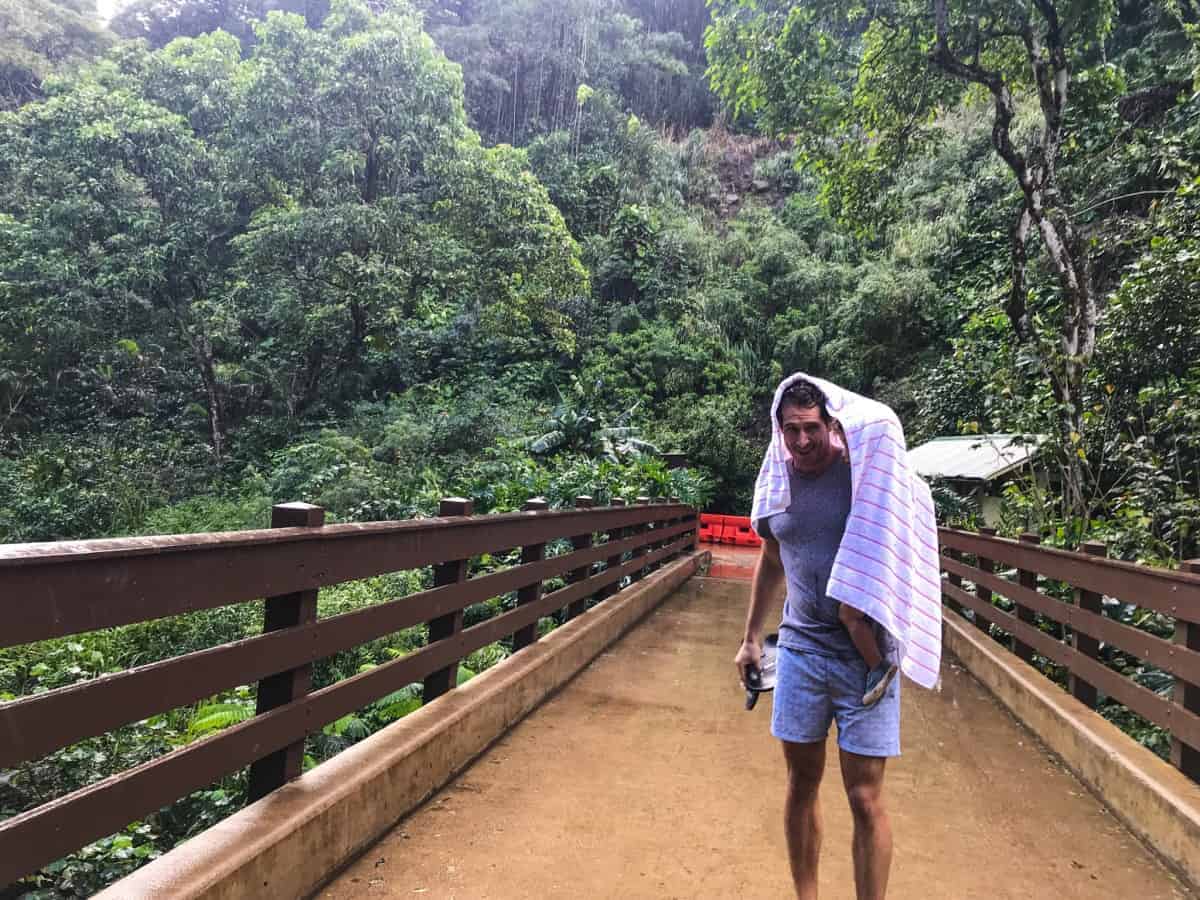
Disclosure: This post may contain affiliate links, meaning if you decide to make a purchase through my links we may earn a commission at no additional cost to you. Read about our affiliate policies here .
Share with your friends!
As a Maui resident, I tell my friends to avoid Hawaii for some months. Hawaii has its busy season, uber-expensive months, and wet months. You deserve a spectacular trip to Hawaii, so avoid these months, especially December .
The worst time to visit Hawaii is December . Hawaii experiences a spike in visitors from mid-December to New Year, resulting in high accommodation, plane tickets, and rental car costs. December is also the wettest month of the year as temperatures cool across the Hawaiian islands.
Here are some quick links to make your vacation planning go smoothly: – If you’re still not deterred by December, check out which island to have your Hawaiian Christmas Vacation – Learn about the cheapest Hawaiian island to visit. – Let us make the rest of your planning easier, head over to our Activities page and our Where to Stay directory
Erica and I ran the numbers, we relived our worst Hawaii experiences, and we broke down the worst times to go to Hawaii based on the following three priorities:
🍍 Clouds
🍍 Crowds
🍍 Cost
Perhaps you don’t mind crowds but desire an affordable luau. If December is the worst month, read on for the best month to visit Hawaii.
And if you want us to walk you through all of this with a video, we have you covered:
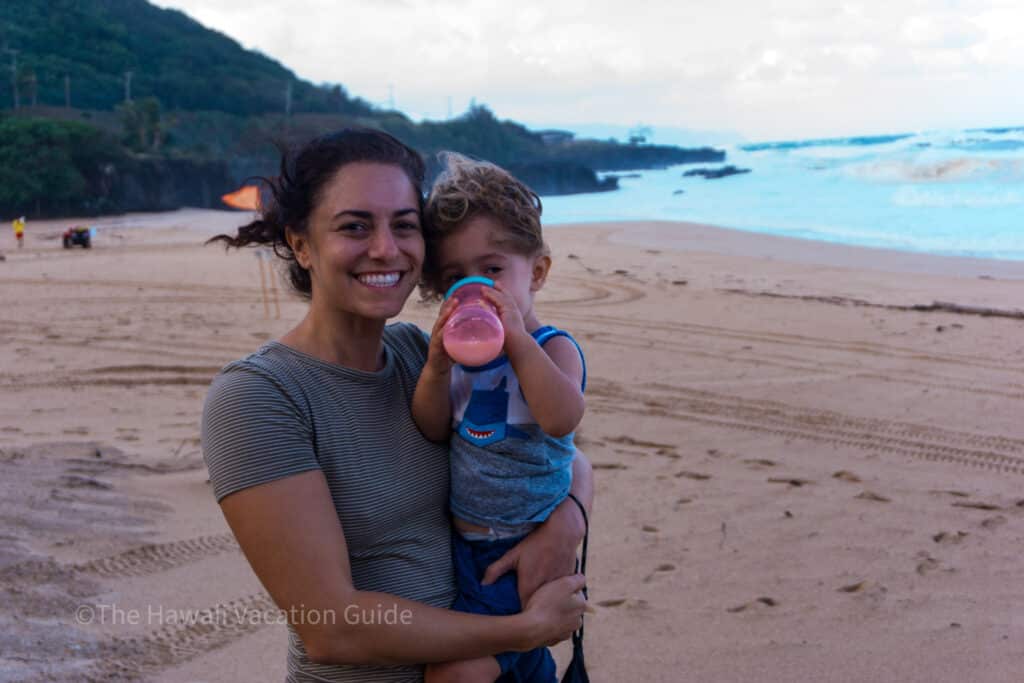
When is the Worst Time to Visit Hawaii?
December is the worst time to visit Hawaii. Hands down, avoid December for any of the Hawaiian islands.
Out of our three categories to avoid (crowds, cost, and weather) in Hawaii, two out of three have December as the winner (or loser) for the worst month to visit Hawaii.
🍍 Worst Weather: December
🍍 Biggest Crowds: July
🍍 Most Expensive: December
From mid-December to early January , the Hawaiian islands get swarmed with Christmas cheerful visitors. Hotel occupancy rates can hit 100%, rental car companies are sold out of cars, and flights are full as people fight for tickets.
The reason is simple, Hawaii is the best place to have a white-sand Christmas.
Related articles: Hawaii Christmas Vacation: The Best and Cheapest Island for Christmas
Based on historical data, December has always been crowded and an expensive time to visit Hawaii.
While you will avoid the snow back home with a trip to Hawaii in December, you may get wet. December is the wettest month of the year in Hawaii. Plus it is the coldest but that is truly splitting hairs because temperatures are in the high-70s.
December doesn’t get the big visitor count like the summer high season but that is because early December is relatively quiet. Early December brings down the monthly visitor count which helps July pull ahead for the busiest month of the year.
December isn’t all bad. Early December, after Thanksgiving, is a good time to visit. You will avoid the holiday rush to Hawaii. Plus, you can find great deals on hotels and vacation rentals.
Arriving in late December to Hawaii is crazy, but arriving in early December is brilliant. Here is everything to know for your trip if you choose to visit in December.
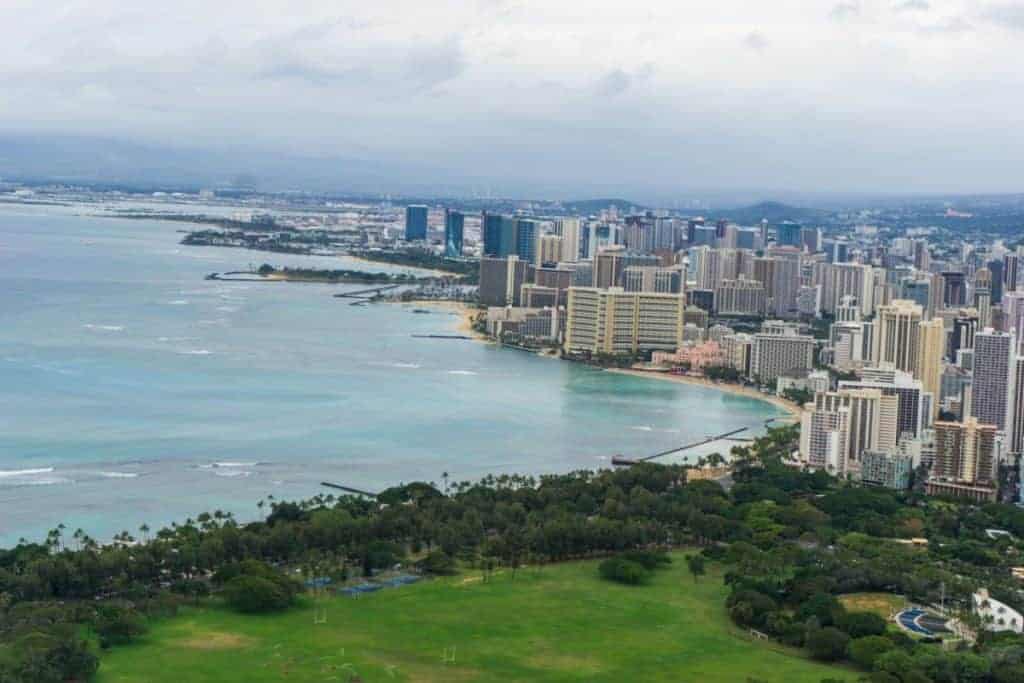
Personally, I love December. Maui gets hot, sizzling hot, from June through September . Come the winter, the temperature is perfect. But I don’t have to pay exorbitant hotel rates or rental car rates like visitors do. And my family knows how to avoid crowds.
The same pattern of unfavorable visitor count, weather, and cost in December is seen across the Hawaiian islands. Only the Big Island is more favorable to visit in December.
The Worst Time to Go to These Hawaiian Islands
Each Hawaiian island is unique but when it comes to the worst time to visit, they share a common denominator: December.
🍍 Oahu: December
🍍 Maui: December
🍍 Kauai: December
🍍 Hawai’i (Big Island): January (December is a close 2nd place)
The Big Island is colder and wetter in January compared to December with about the same accommodation costs that tipped January to be the worst month to visit the island of Hawaii.
My results for each island are skewed (weighted) to poor weather and expensive vacation. I weigh crowds as less important. Perhaps you can’t stand the crowds so June , July , and August are your arch-nemeses.
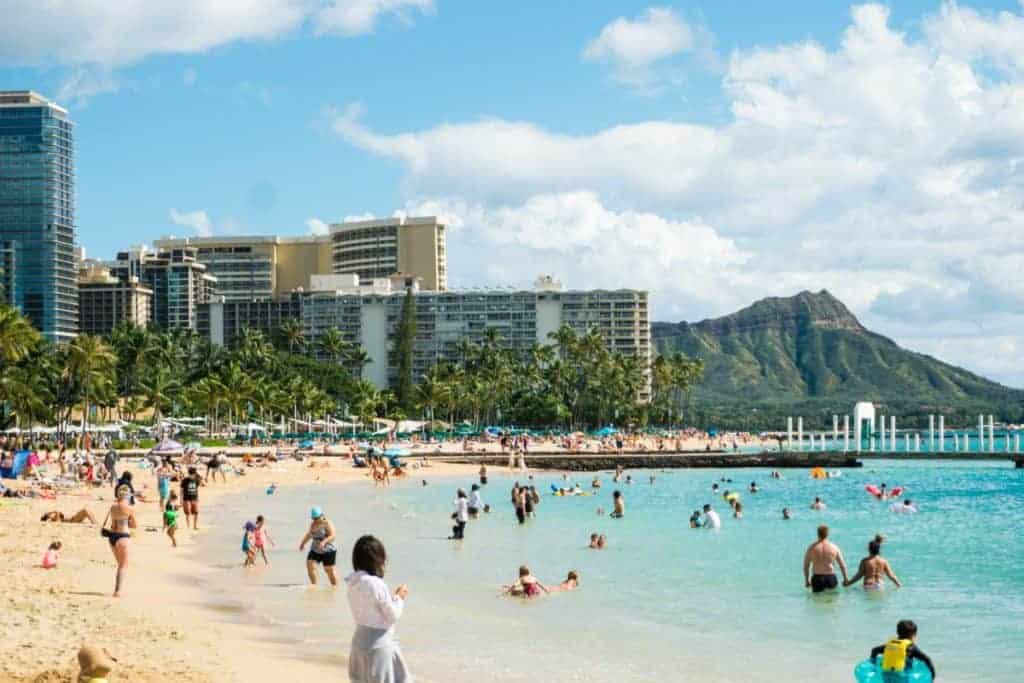
The cost of activities doesn’t fluctuate with the seasons. Tour operators offer coupons and booking discounts throughout the year to fill their shuttles, boats, and pineapple farm tours.
Take a plunge into the charts below so you can weigh the reasons why December is the worst time to visit Hawaii.
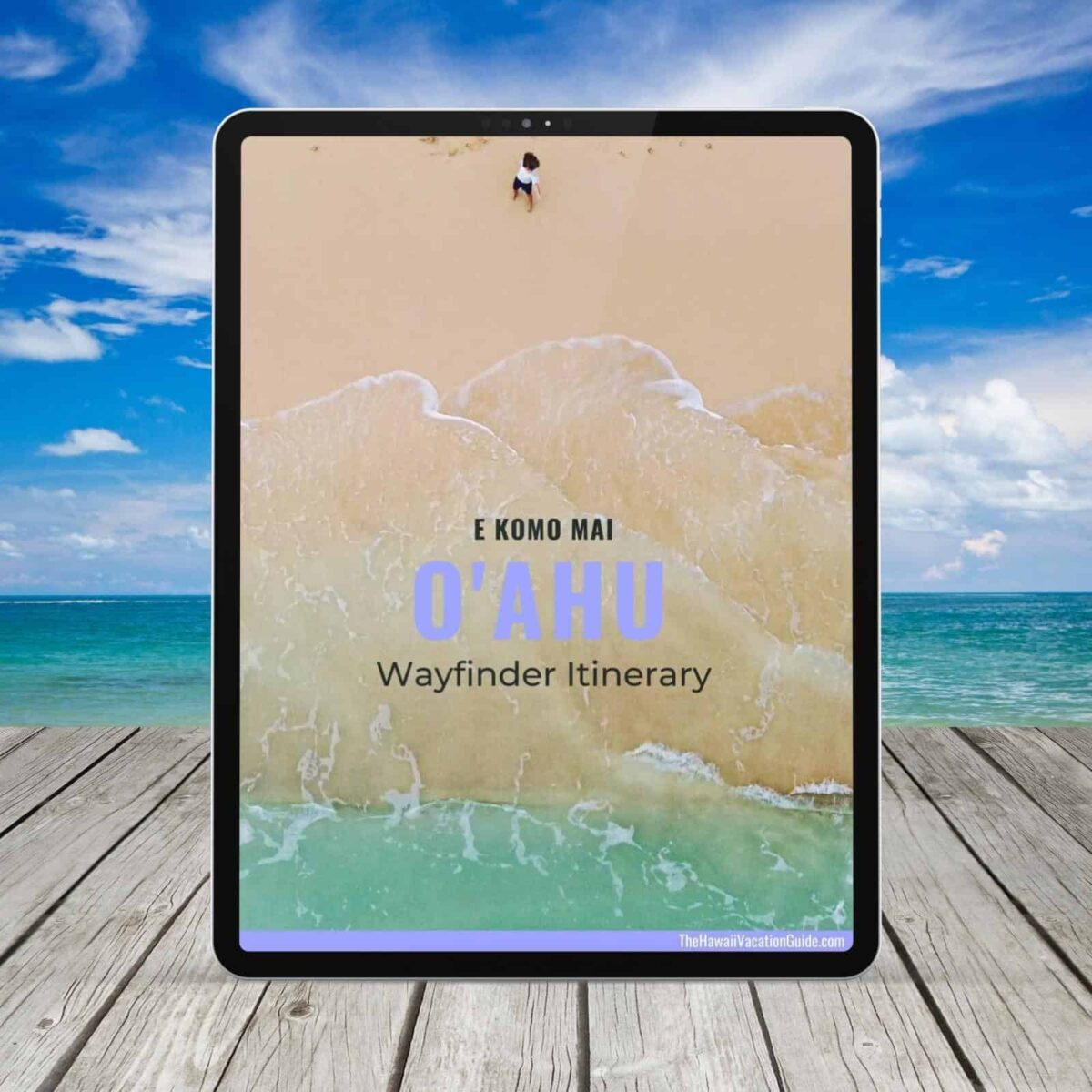
Oahu Wayfinder Itinerary
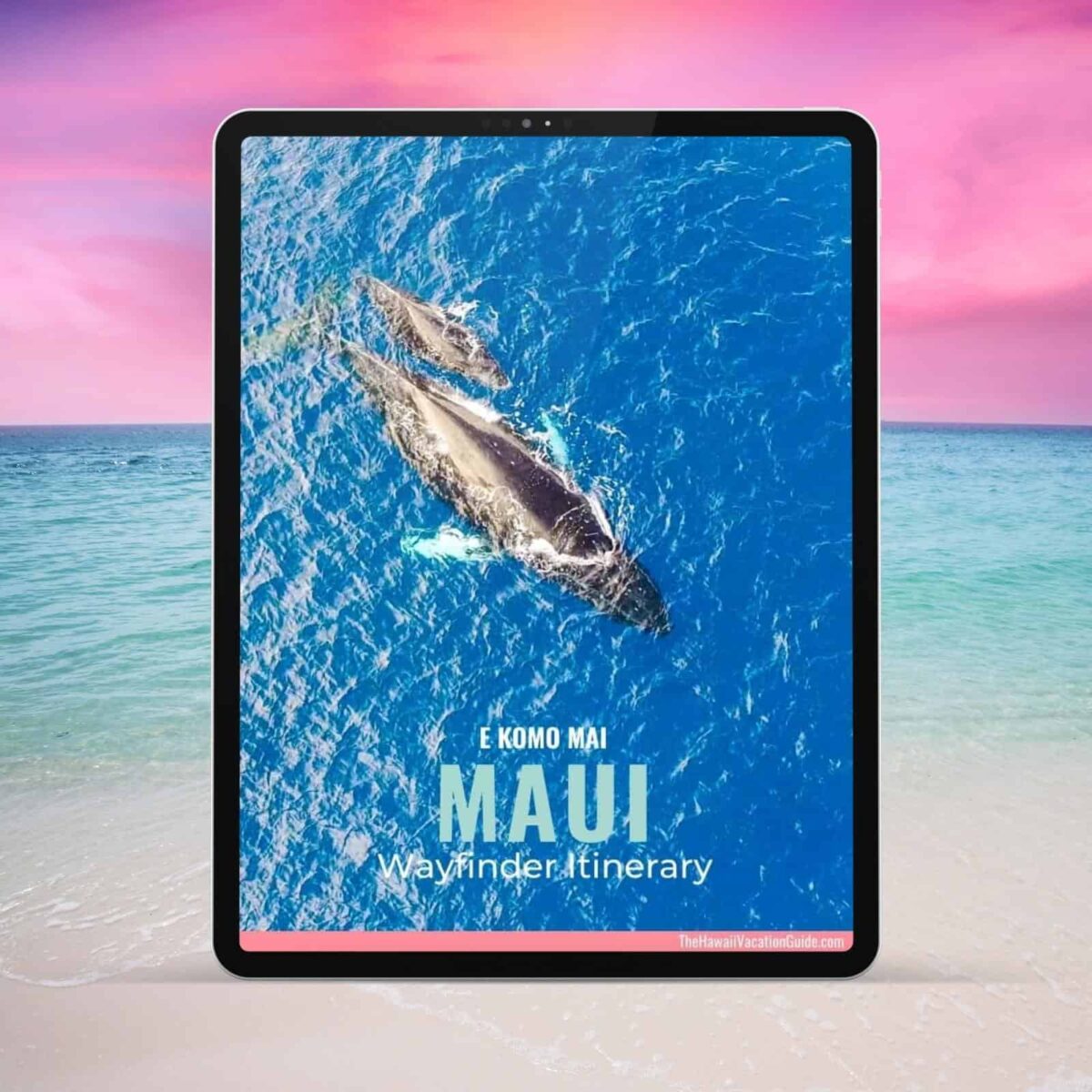
Maui Wayfinder Itinerary
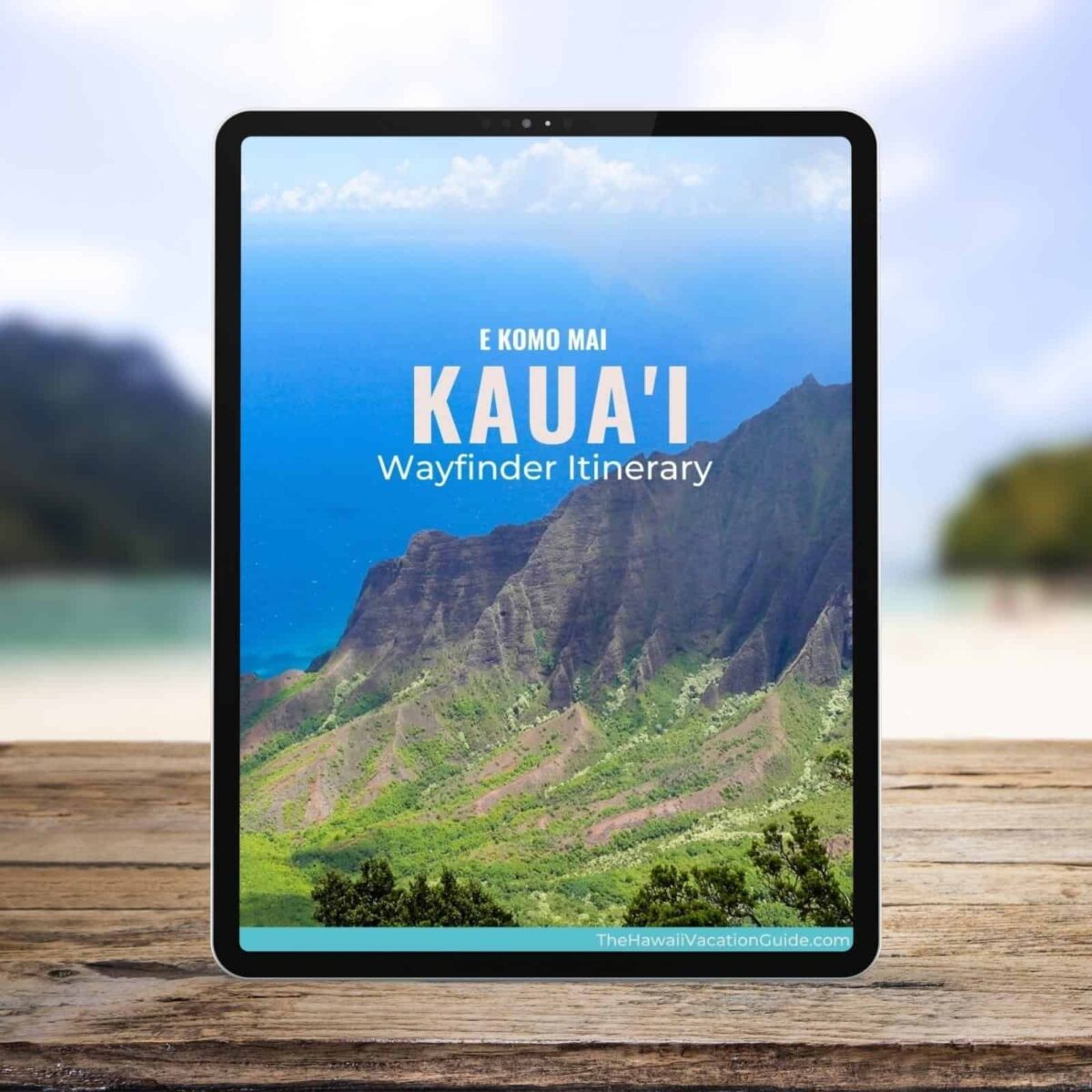
Kauai Wayfinder Itinerary
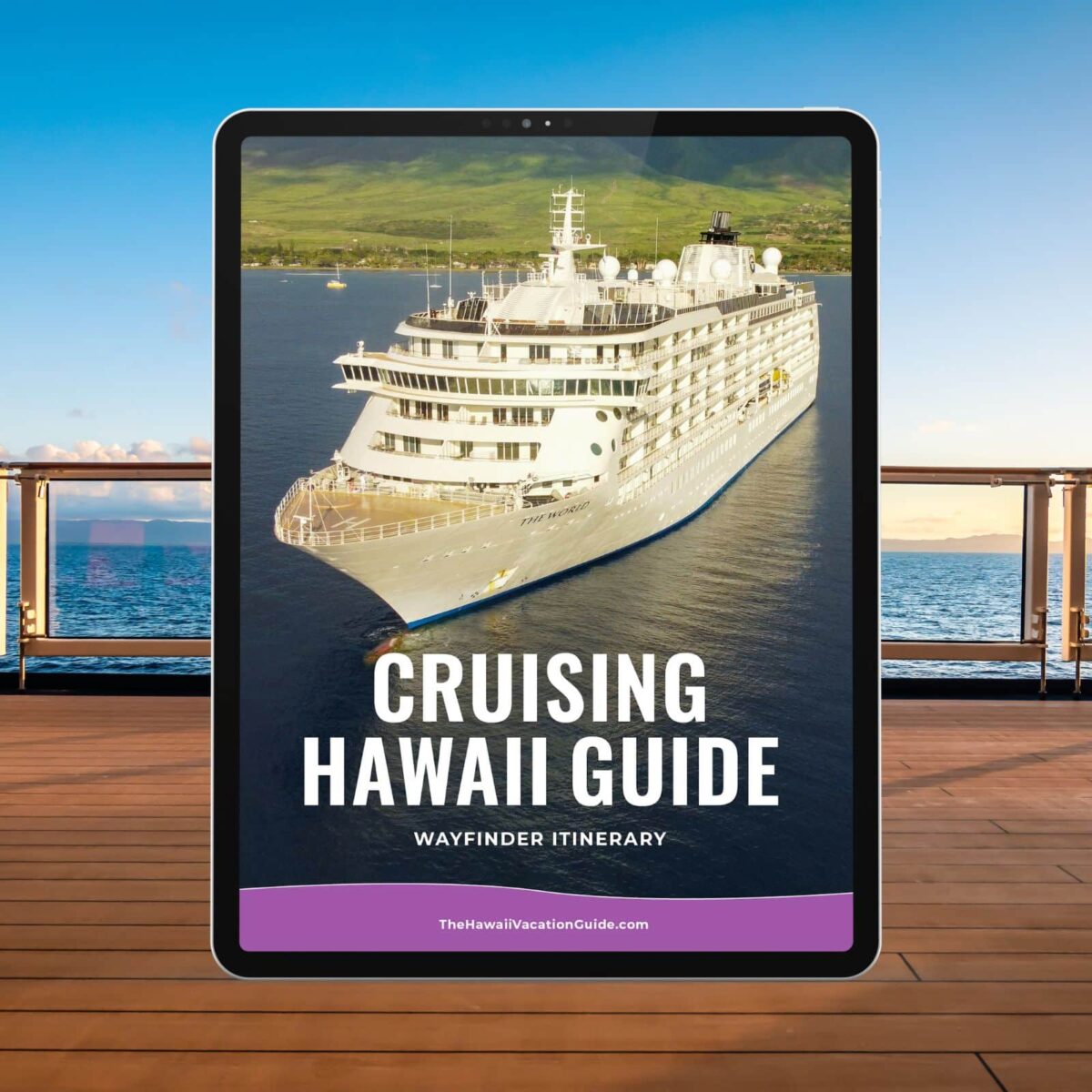
Cruising Hawaii Guide
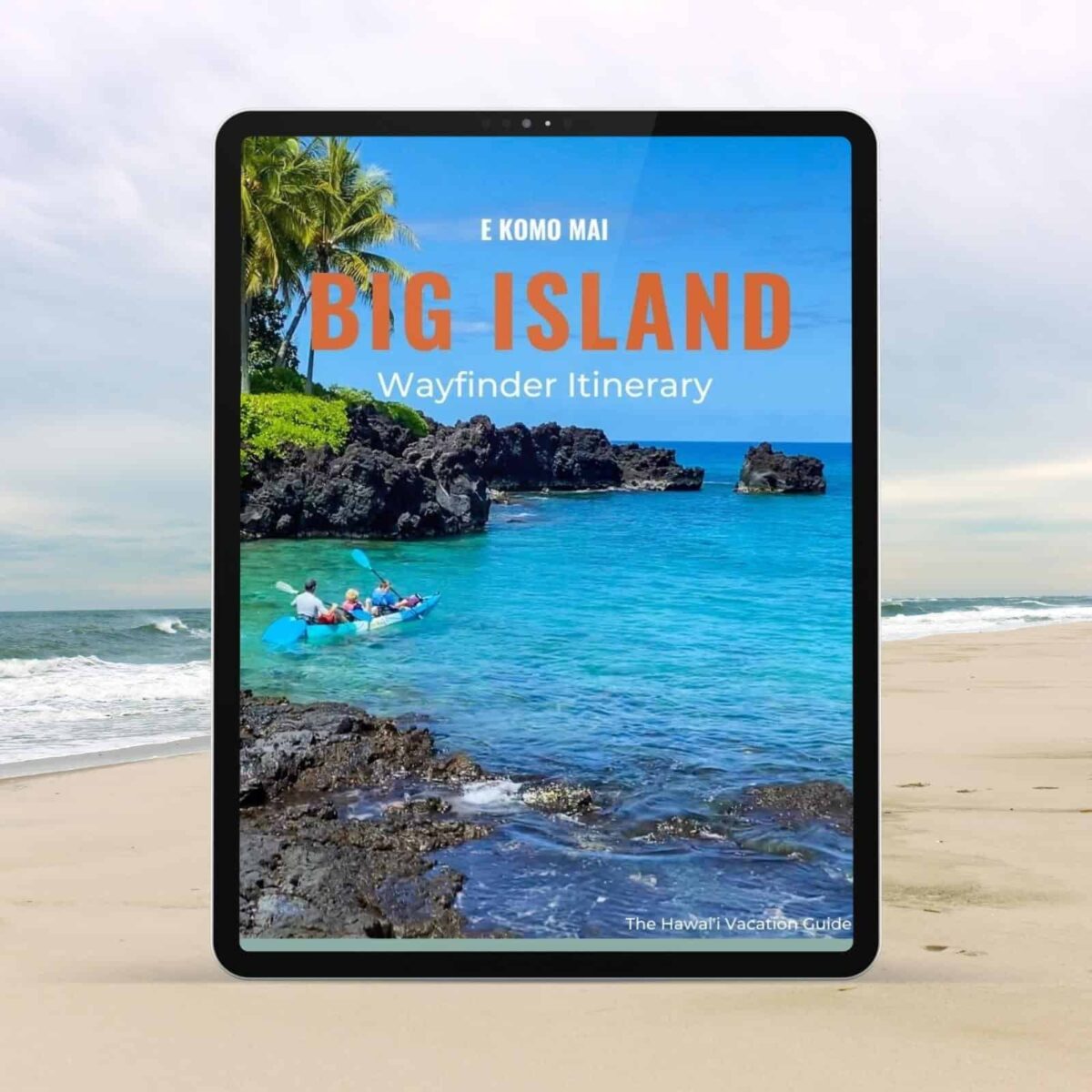
Big Island Wayfinder Itinerary
The worst time to visit hawaii: weather.
Hawaii is better than Old Faithful when it comes to the weather. But don’t be that person who is shocked when a hurricane arrives during hurricane season.
Hawaii sits snuggly in the Tropic of Cancer. Therefore, the changes to the weather over the seasons are minimal. You won’t need to pack a sweater and jeans for a winter vacation in Hawaii.
If you do get stuck in the rain in Hawaii, explore our What to Do in Hawaii When it Rains for a full list of activities.
But, if you want sun-filled days with no worries of rain then it is best to avoid December as it is the wettest month across all the Hawaiian islands.
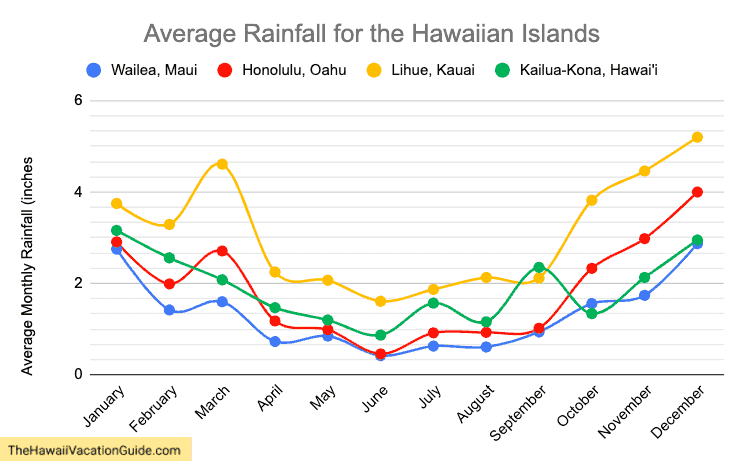
Source: Weather.com
The average rainfalls shown in the plot above are the main resort area on each island. Except, Kauai where I show Lihue. Lihue is a good in-between for the wetter north shore of Princeville and the dryer area of South Kauai.
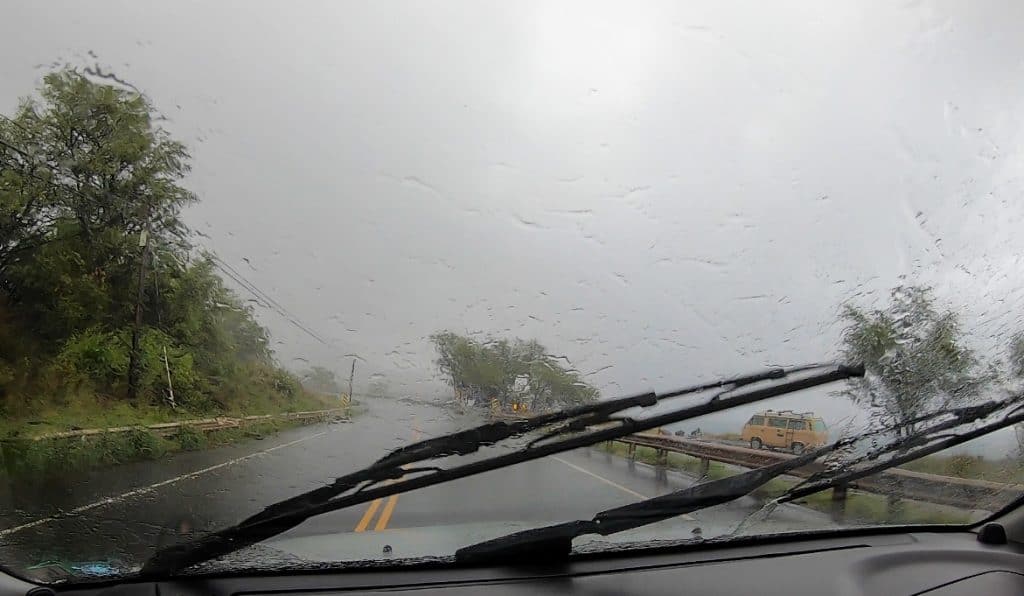
The Hawaiian resort areas are located on the leeward or dry side of the island. So this rainfall represents the best you can get. Stay in Ka’anapali or Wailea on Maui for the best weather in December. Or stay in Ko Olina (Kapolei) for the best weather on Oahu in December.
The coolest temperatures are in January , February , and March across Hawaii. December is the start of a cool period.
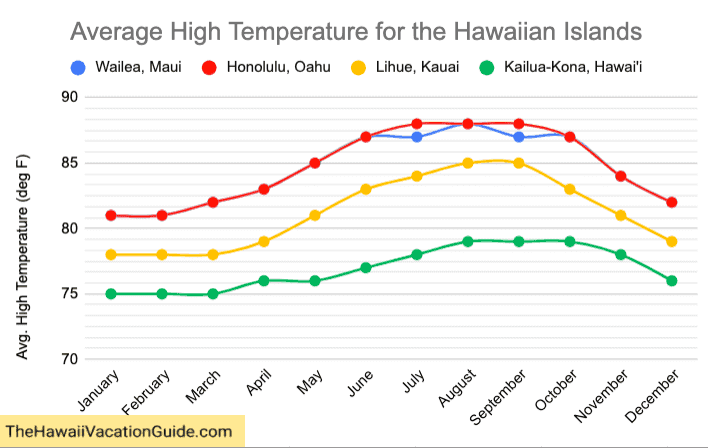
The warmest islands are Oahu and Maui. Their temperature trends pretty much track each other. Stay away from Kailua-Kona in December as the Big Island gets the lowest temperatures out of the Hawaiian islands.
But let’s be serious, we are still talking about the high-70s as the average. After being born and raised in the midwest, I’ll take any of those temperatures in December.
The difference between the daily average cold and hot is about 15 degrees. The tradewinds pick up in the afternoon helping to cool your lanai for happy hour and a pleasant night’s sleep.
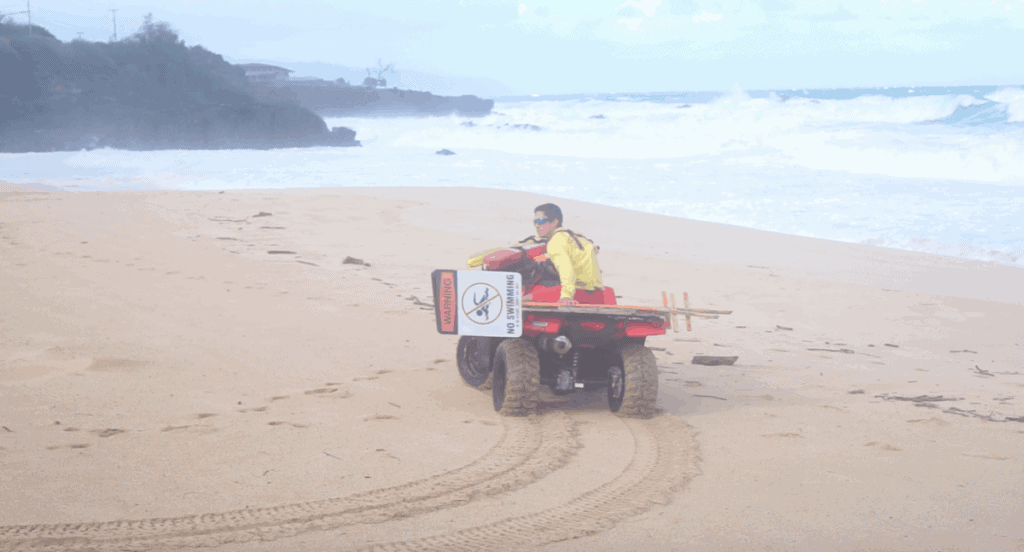
December has some of the worst weather of the year in Hawaii. A higher likelihood of rainfall means more overcast days and the potential for a rainy week. In my experience, it hardly rains all day in December or the winter in general. A storm may blow through for a couple of days, but that is the worst you can expect.
Read all about Hawaii’s second season with everything you need to know about Hawaii in the winter .
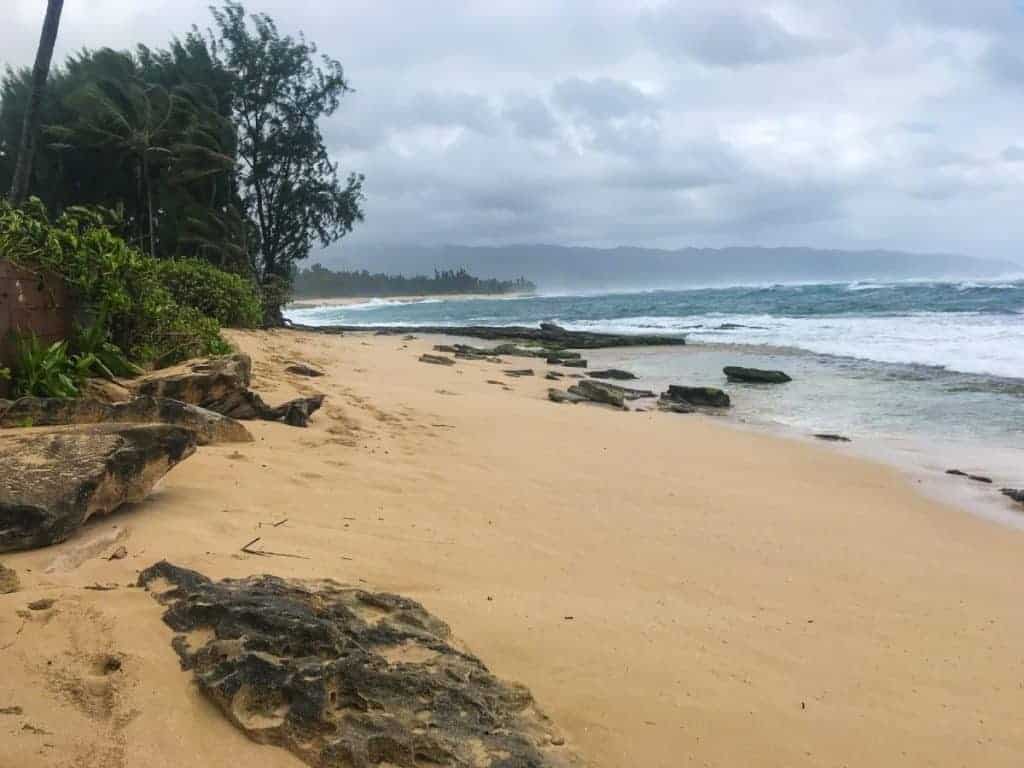
Hurricane Season in Hawaii
If you wish to avoid Hawaii’s hurricane season , then stay clear of Hawaii from June 1st to November 30th.
Due to winds, currents, and ocean temperatures around the islands, Hawaii escapes most direct hits. The last hurricane to directly hit a Hawaiian island was Hurricane Iniki in 1992 . Hurricanes are rare in Hawaii.
The hurricane season is during the fall slow season. This shoulder season is an excellent time to visit Hawaii as flights, hotel rates, and visitor counts are low during this time of year.
Except for the threat of hurricanes, the weather has historically been lovely during this time of year.
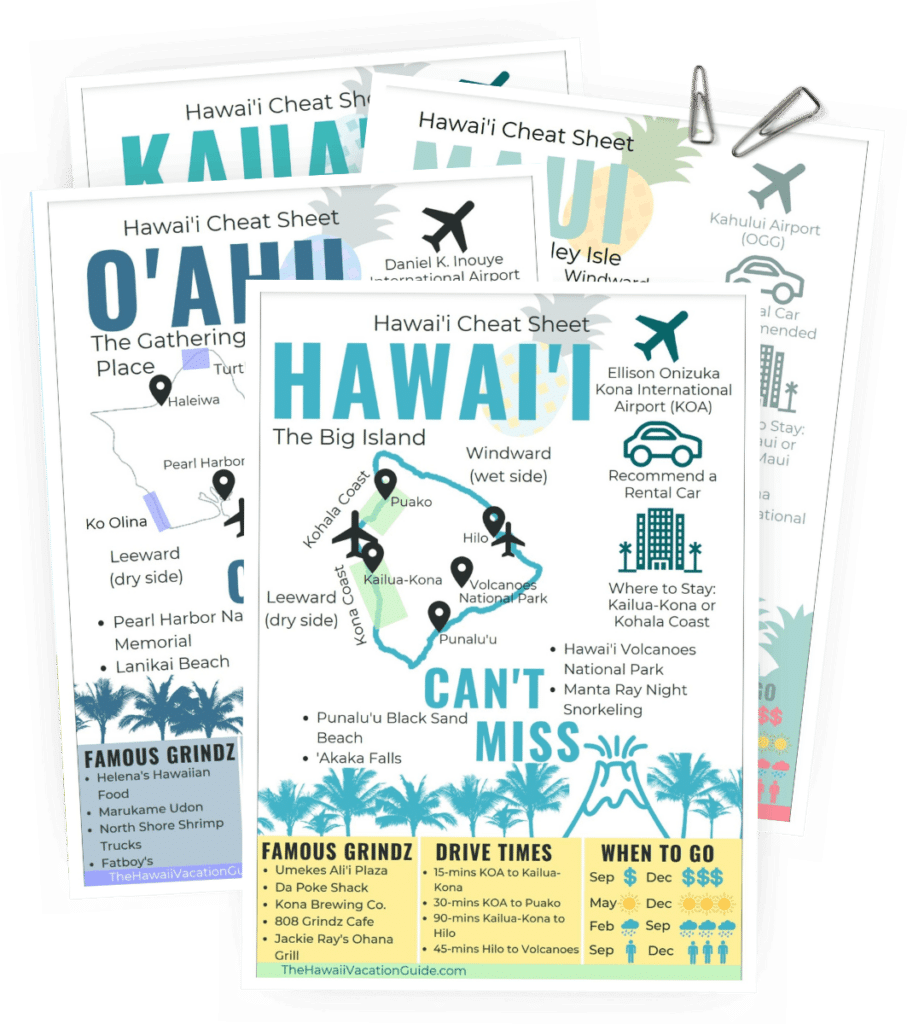
Free Download!
Hawaiian island cheat sheets.
Sign up & we’ll send you our island cheat sheets so you can get to know the islands like the back of your hand!
We’ll share 4 can’t-miss activities on each island, a map with the main sights in town, & famous local grindz (eats)!
where should we send your free Island Cheat Sheets?
By signing up, you agree to our Privacy Policy . We hate spam and promise to keep your email safe. Unsubscribe at any time.
The Worst Time to Visit Hawaii: Cost
Hawaii is a trip of a lifetime for many. Due to the cost of this sun and sea destination, you want to ensure your money is well spent.
If you are looking to get the same Hawaii vacation, for a lower cost then avoid December. December is the most expensive time of year to visit the Hawaiian Islands.
The biggest line item for a trip to Hawaii is lodging. Hotels, vacation rentals, and timeshares are some of the most expensive in the world. Hawaii beats out San Francisco and New York for the most expensive hotel rooms in the country.
Since 70% of visitors stay in hotels, let’s look at the most expensive month for hotels in Hawaii.
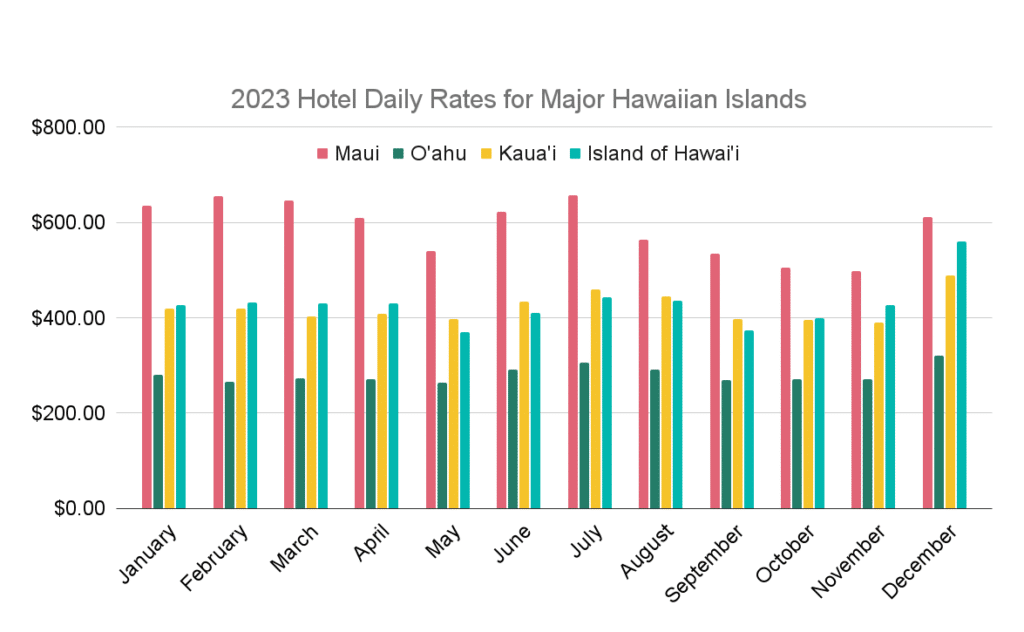
Source: Hawaii Tourism Authority Infrastructure Research
December shows a spike in the cost of the daily average rate for hotels across the Hawaiian islands. Prices are even higher in luxury resort areas like Wailea, Maui, and the Kohala Coast, Hawai’i.
The winter months all have the highest rates for hotels but December leads the pack due to Christmas. Maui’s rates didn’t climb as high as usual in December last year as the island was encouraging tourism as it recovers from the Lahaina fires .
You can save money on accommodations in Hawaii by staying at a vacation rental. Look to Airbnb or Vrbo for options. While cheaper than hotel rooms, vacation rental costs also experience a jump come December across the Hawaiian Islands.
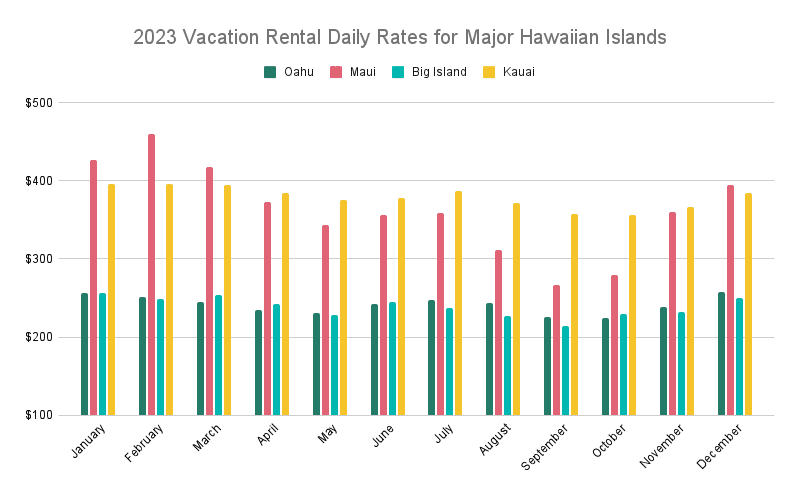
December is the fourth most expensive month for vacation rentals. January, February, and March are more expensive. This is due to deals after Thanksgiving on vacation rentals. While December is the worst time to visit Hawaii, early December can be an opportunity to stay in a vacation rental for cheap.
If the cost of accommodations in December stings, don’t expect to save on airfare either.
Most Expensive Month to Fly to Hawaii
I researched FareDetective History Charts to find the most expensive and cheapest time to fly to Hawaii.
The table represents the most popular departure destination to Hawaii: Los Angeles, California. Ticket costs are from March 2023 to February 2024.
Los Angeles to the Hawaiian Islands (round trip)
Flights from Los Angeles are the most expensive during the summer months (of course with the exception of December). Both cost increases are due to demand, be it to escape the cold or vacation while school is out is causing the higher ticket prices.
Head to Hawaii during the spring shoulder season to get the lowest ticket prices on average.
If you are wondering what the cheapest Hawaiian island to visit is, then look no further: This is the Cheapest Hawaiian Island to Visit .
Cheapest Time to Visit Hawaii
If December is the most expensive time to visit Hawaii, what is the cheapest?
October and November are the cheapest times to visit Hawaii.
Hawaii’s shoulder seasons are visible in the accommodation graphs. Lodging rates dip during the spring and fall slow seasons. For the best rates on hotels and rental cars, visit Hawaii in October and November
Our best money saving Hawaii vacation tips, in one place: Learn about booking your trip with points and save on your biggest expense! Read up on how to get a cheap ticket to Hawaii to slash that airfare price. We give away our secrets on how we book our Hawaii travel (and beyond) . We’ve also compiled a list of discount codes for you to take advantage of!
Worst Time to Visit Hawaii: Rental Car Rates
The average rate for a rental car in Hawaii is $50 a day (source: Kayak ). Rental car pricing is based on demand. Therefore look no further than the visitor count data below to figure out when you can expect to pay multiples higher than $50 a day.
Spoiler: late December is a bad time to rent a car in Hawaii.
The Worst Time to Visit Hawaii: Crowds
Crowds may be your Achille’s heal for a vacation. Paradise isn’t paradise when you are fighting for a spot to put your beach towel.
While I’ve focused on the cost and the weather, crowds may be the most important to you. If that is the case, avoid the summer months to visit Hawaii. July is a nasty month to visit as visitors hit almost 1,000,000 in 2023.
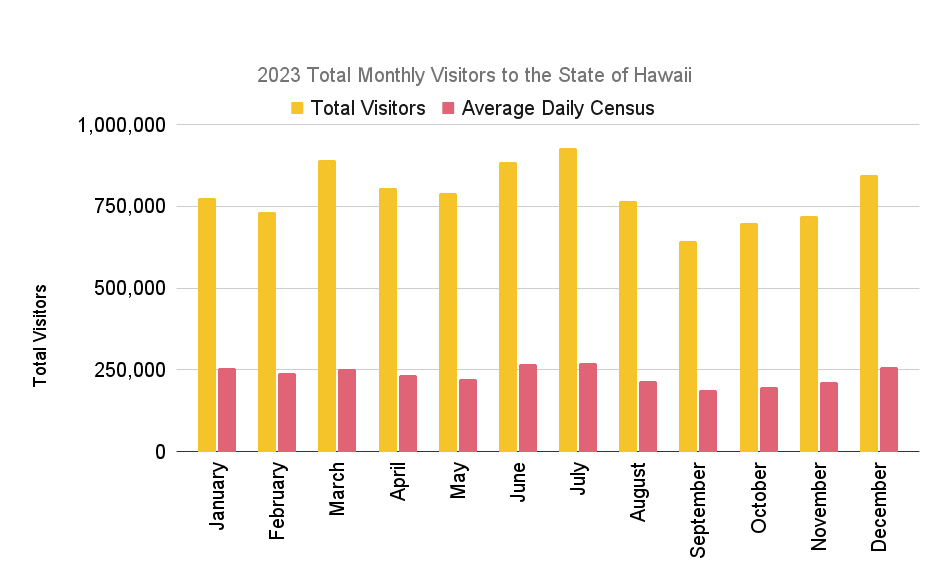
Source: Hawaii Tourism Authority Monthly Visitor Statistics
1,000,000 million visitors in one month! That is nuts. The population of the State of Hawaii is about 1.5 million.
Oahu brings the biggest crowds as the most visited island. And within Oahu, the majority of visitors are staying in Waikiki.
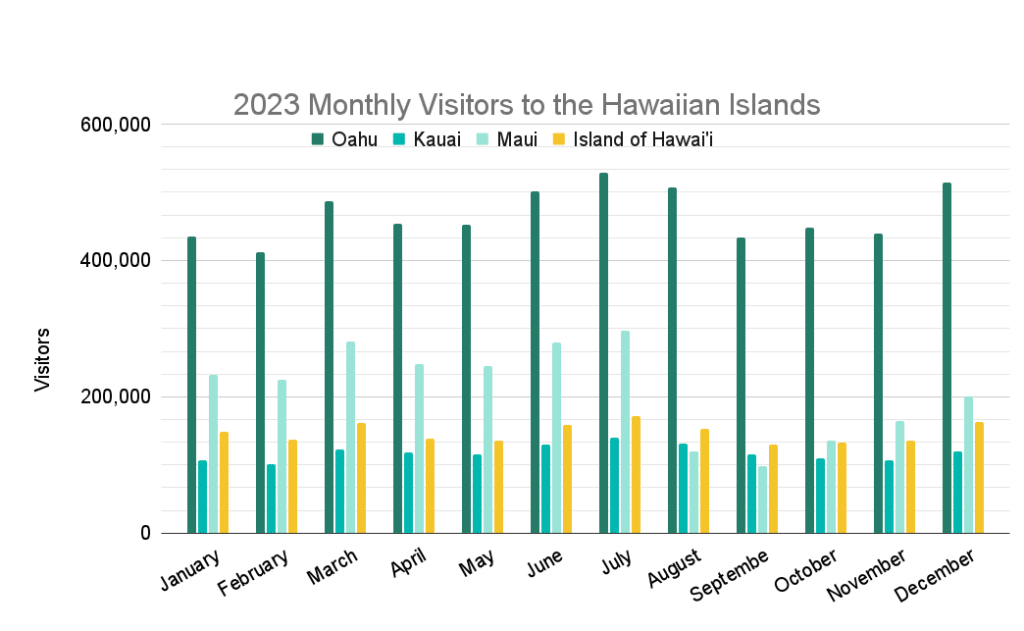
The summer months are busy, but December is right behind them. Since most visitors are arriving in mid-December to New Year’s, one can expect a higher density of visitors in December during the peak season.
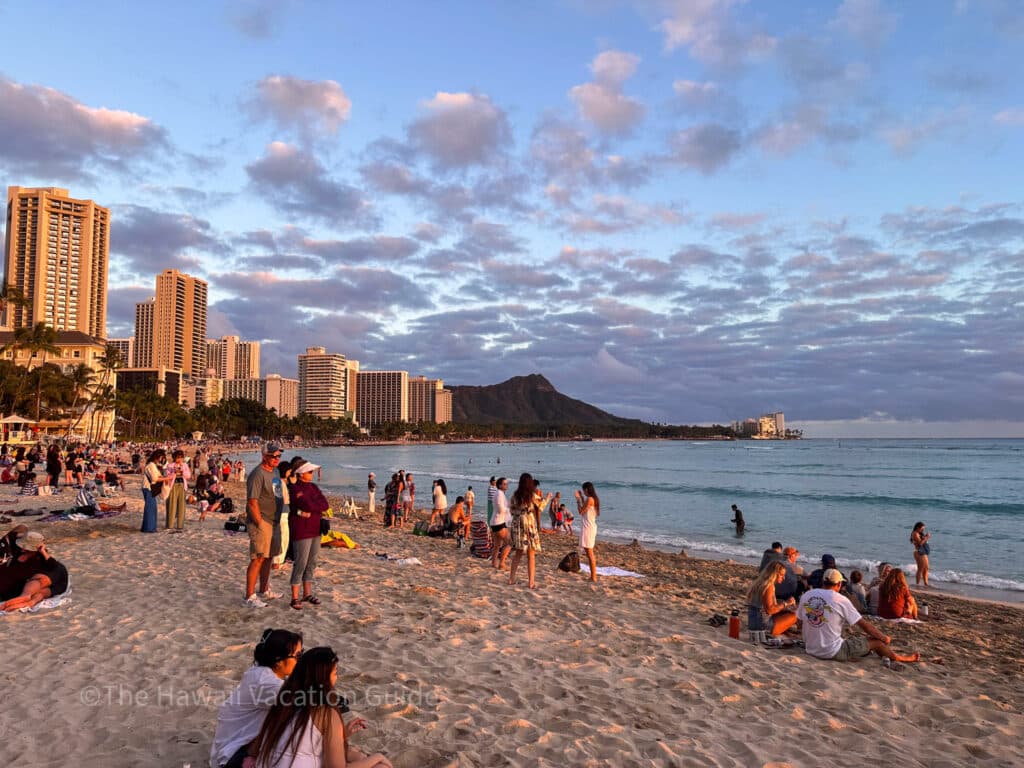
The Big Island is very popular for Christmas. December is the busiest month for the Island of Hawai’i.
Hawaii is an amazing place to visit. I’m not used to talking about the worst time to visit Hawaii since the difference between months isn’t staggering.
If December is the worst month to visit Hawaii, what is the best month?
Not the Worst Months to Visit Hawaii
October is my favorite month to live in and visit Hawaii. Find a reason to pull the kids out of school or steal your fiance away in October to Hawaii.
In October, you will find the least visitors of the year and the lowest cost rental cars and lodging rates. Airplane deals are also plentiful in October. No crowds and a great deal on a luxury Hawaiian resort makes October not the worst month to visit Hawaii.
The weather is also ideal in October as the temperature has cooled down from the summer highs yet the rain hasn’t arrived.
The shoulder seasons in general from mid- September to Thanksgiving and April through May are the best times to visit Hawaii for a well-priced trip and good weather.
Whatever month you choose for your Hawaii vacation, you won’t regret it. December may sound bad but a December trip to Hawaii will still be memorable.
For no regrets, head to Maui as December is the start of the humpback whale season. That is worth every penny.
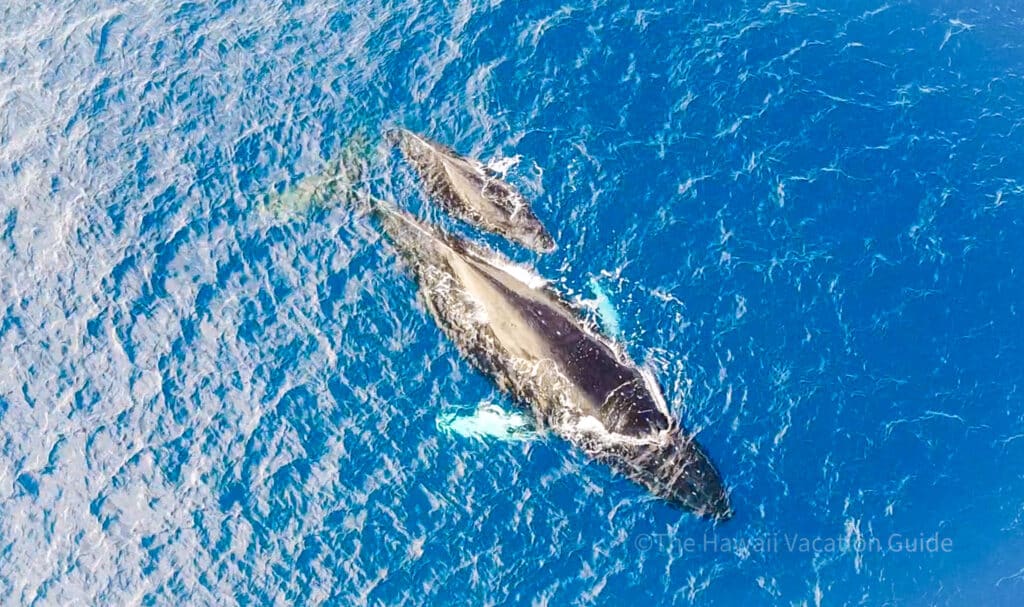
Have a great trip, whatever month you decide to visit!
Download our free Hawaiian Island Cheat Sheets for more information on planning your perfect trip to Hawaii!
Was this article helpful? Pin it and follow us for more!
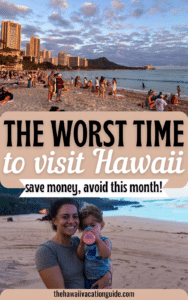
Thanks for reading The Hawaii Vacation Guide! I'm the co-founder, with my wife Erica, of the best Hawaii travel guide on the internet in our biased opinions. We enjoy traveling throughout Hawaii after living on Maui and Oahu. We share our adventures, travel tips and resources, and honest reviews so you can easily plan your dream vacation to Hawaii. Editing our videos, teaching the kids how to snorkel, and learning about the 'aina (land) and Hawaii culture are my favorite things to do. Have a wonderful trip to the Aloha State.
Similar Posts
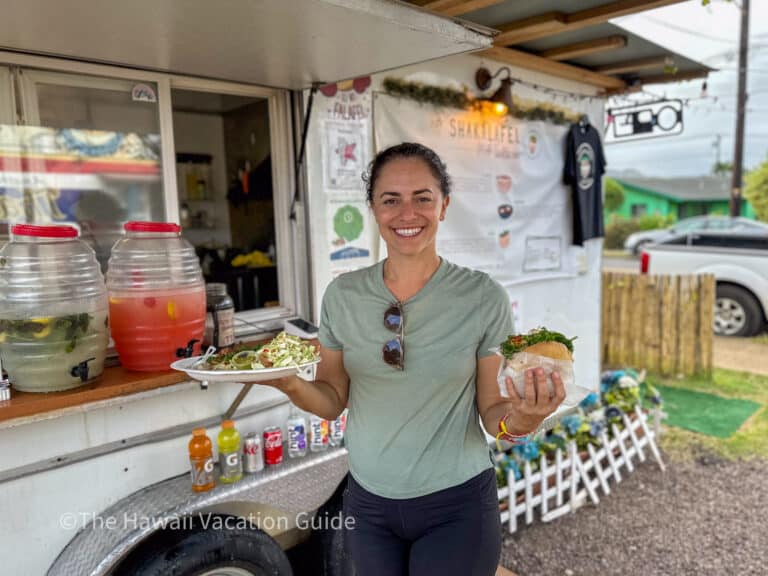
The Ultimate Kauai Food Truck Guide (find the best cheap eats)
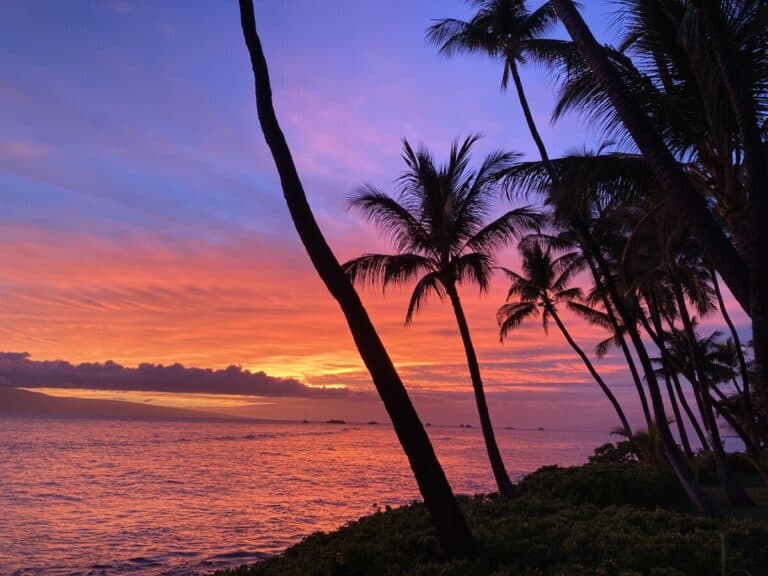
Your Maui Honeymoon: 10 Unforgettable Activities for Couples
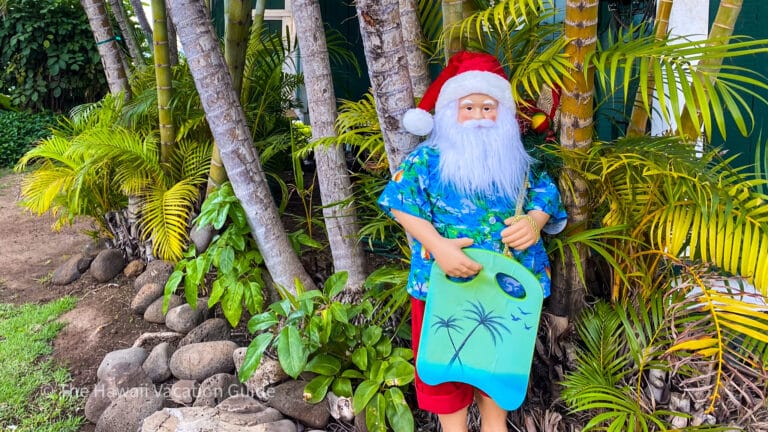
Christmas Magic in Hawaii: 19 Tips to Plan Your Hawaii Christmas Vacation
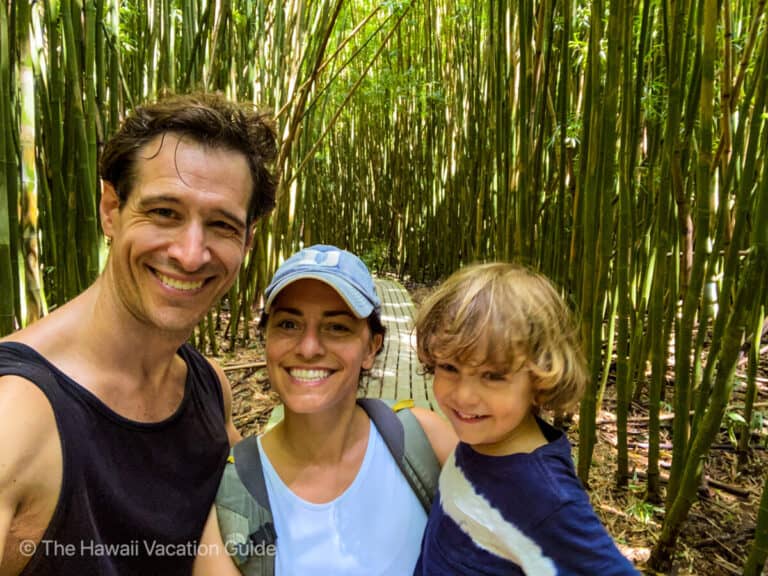
Maui vs Big Island: Beach Vacation or Adventure (you decide)
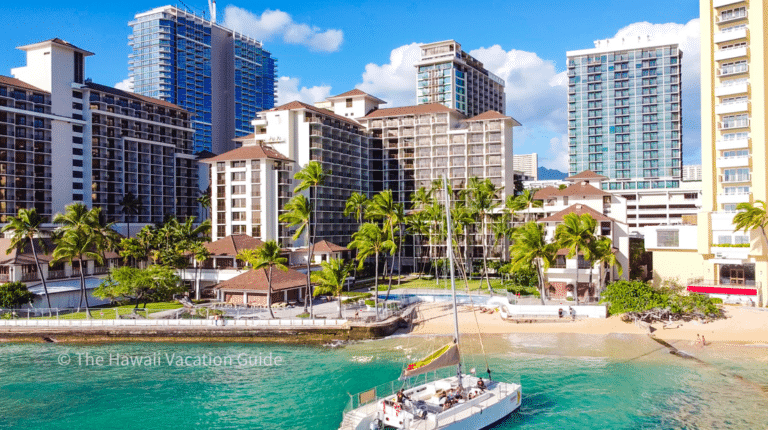
7 Awesome Vacation Rentals in Waikiki: Pick The Right Place
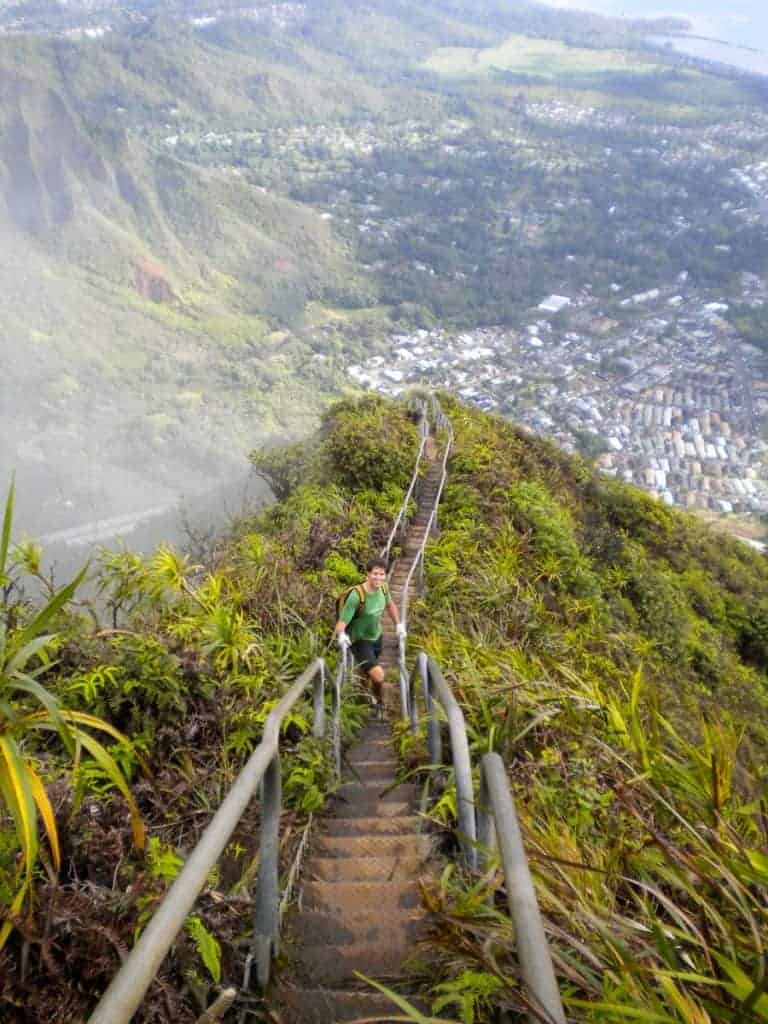
Best Hawaiian Island for Hiking (plus 11 trails that make it the best)
This is the most comprehensive Hawaii vacation planning resource on the internet!
TOP RESOURCES
- Join Our Newsletter
- Hawaii Itineraries
- Tours & Activities
- Top Travel Gear
- Discount Car Rentals
ISLAND GUIDES
- Planning A Trip To Hawaii
- Oahu Island Guide
- Maui Island Guide
- Hawai’i (Big Island) Guide
- Kauai Island Guide
Your use of the information provided in our Content, Itineraries, Site, and Services is for your informational purposes only and is subject to our Privacy Policy and Terms of Service. Your use of the information described in, your participation in activities presented in, and/or your engagement of any Travel Service Providers presented in our Content, Itineraries, Site, and/or Services may carry the risk of illness, bodily injury, disability, death, or property damage. You voluntarily and freely assume all risks and dangers that may occur pursuant to your access, use, purchase, or participation in any information, activity, good, or service described in our Content, Itineraries, Site, and Services or provided by any Travel Service Providers.
Don’t start planning without our cheat sheets
You’ll get:
- 4 can’t-miss activities on each island,
- a map with the main sights in town,
- and famous local grindz (eats)!
Review Cart
No products in the cart.

Travel Guide
- Things to Do
- Things to See
- Entry Requirements & Customs
- Getting Around
- Tips on Accommodations
- Visitor Information
- Special-Interest Vacations
- Staying Healthy
- Calendar of Events
- Getting Married
- Getting There
- Sustainable Travel & Ecotourism
- Tips for Families
- Tips for Gay and Lesbian Travelers
- Tips for Senior Travelers
- Tips for Travelers with Disabilities
- Staying Connected
- Active Pursuits
- Suggested Itineraries
- A Nature Guide
When to Go to Hawaii
Most visitors come to Hawaii when the weather is lousy elsewhere. Thus, the high season —when prices are up and resorts are often booked to capacity—is generally from mid-December to March or mid-April. In particular, the last two weeks of December and first week of January are prime time for travel to Hawaii. Spring break is also jam-packed with families taking advantage of the school holiday.
If you’re planning a trip during peak season, make hotel and rental car reservations as early as possible, expect crowds, and prepare to pay top dollar. The winter months tend to be a little rainier and cooler. But there’s a perk to traveling during this time: Hawaiian humpback whales are here, too.
The off season , when the best rates are available and the islands are less crowded, is late spring (mid-April to early June) and fall (September to mid-December).
If you plan to travel in summer (June–August), don’t expect to see the fantastic bargains of spring and fall—this is prime time for family travel. But you’ll still find much better deals on packages, airfare, and accommodations than in the winter months.
Because Hawaii lies at the edge of the tropical zone, it technically has only two seasons, both of them warm. There’s a dry season that corresponds to summer (April–October) and a rainy season in winter (November–March). It rains every day somewhere in the islands at any time of the year, but the rainy season can bring enough gray weather to spoil your sunbathing opportunities. Fortunately, it seldom rains in one spot for more than 3 days straight.
The year-round temperature doesn’t vary much. At the beach, the average daytime high in summer is 85°F (29°C), while the average daytime high in winter is 78°F (26°C); nighttime lows are usually about 10° cooler. But how warm it is on any given day really depends on where you are on the island.
Each island has a leeward side (the side sheltered from the wind) and a windward side (the side that gets the wind’s full force). The leeward sides (the west and south) are usually hot and dry, while the windward sides (east and north) are generally cooler and moist. When you want arid, sunbaked, desert-like weather, go leeward. When you want lush, wet, rainforest weather, go windward.
Hawaii also has a wide range of microclimates , thanks to interior valleys, coastal plains, and mountain peaks. Kauai’s Mount Waialeale is one of the wettest spots on earth, yet Waimea Canyon, just a few miles away, is almost a desert. On the Big Island, Hilo ranks among the wettest cities in the nation, with 180 inches of rainfall a year. At Puako, only 60 miles away, it rains less than 6 inches a year. The summits of Mauna Kea on the Big Island and Haleakala on Maui often see snow in winter—even when the sun is blazing down at the beach. The locals say if you don’t like the weather, just drive a few miles down the road—it’s sure to be different.
When Hawaii observes holidays (especially those over a long weekend), travel between the islands increases, interisland airline seats are fully booked, rental cars are at a premium, and hotels and restaurants are busier.
Federal, state, and county government offices are closed on all federal holidays. Federal holidays include:
• New Year’s Day , January 1
• Martin Luther King, Jr., Day , third monday in January
• Presidents’ Day , third Monday in February
• Memorial Day , last monday in May
• Independence Day , July 4
• Labor Day , first Monday in September
• Columbus Day , second Monday in October
• Veterans Day , November 11
• Thanksgiving , fourth Thursday in November
• Christmas , December 25
State and county offices are also closed on local holidays. These include:
• Prince Kuhio Day , March 26, honoring the birthday of Hawaii’s first delegate to the U.S. Congress
• King Kamehameha Day , June 11, a statewide holiday commemorating Kamehameha the Great, who united the islands and ruled from 1795 to 1819
• Admission Day , observed on the third Friday in August to mark the admittance of Hawaii as the 50th state on August 21, 1959
Note : This information was accurate when it was published, but can change without notice. Please be sure to confirm all rates and details directly with the companies in question before planning your trip.

- All Regions
- Australia & South Pacific
- Caribbean & Atlantic
- Central & South America
- Middle East & Africa
- North America
- Washington, D.C.
- San Francisco
- New York City
- Los Angeles
- Arts & Culture
- Beach & Water Sports
- Local Experiences
- Food & Drink
- Outdoor & Adventure
- National Parks
- Winter Sports
- Travelers with Disabilities
- Family & Kids
- All Slideshows
- Hotel Deals
- Car Rentals
- Flight Alerts
- Credit Cards & Loyalty Points
- Cruise News
- Entry Requirements & Customs
- Car, Bus, Rail News
- Money & Fees
- Health, Insurance, Security
- Packing & Luggage
- -Arthur Frommer Online
- -Passportable
- Road Trip Guides
- Alaska Made Easy
- Great Vacation Ideas in the U.S.A.
- Best of the Caribbean
- Best of Mexico
- Cruise Inspiration
- Best Places to Go 2024


Escape the Crowds: The Best Time to Visit Hawaii’s Hidden Gems

- Post author: Avoid Crowds
- Post published: April 7, 2023
- Post category: United States
- Post comments: 0 Comments
Hawaii is one of the most popular vacation destinations in the world, with millions of visitors every year. While the main islands of Oahu, Maui, and Hawaii (also known as the Big Island) have plenty to offer, they can be crowded and busy, especially during peak travel seasons. However, there are lesser-known islands that offer a more authentic and peaceful Hawaiian experience. In this guide, we’ll show you why and when to visit Hawaii’s less crowded islands.
Why Visit Hawaii's Less Crowded Islands?
Hawaii’s less crowded islands offer a chance to escape the hustle and bustle of the more popular tourist destinations. These islands are known for their natural beauty, laid-back lifestyle, and unique cultural experiences. They offer a chance to immerse yourself in Hawaiian culture and history, without the crowds and tourist traps.
When to Visit Hawaii's Less Crowded Islands
The best time to visit Hawaii’s less crowded islands depends on several factors, including high and low seasons, weather considerations, and event calendars.
High Season vs. Low Season
Hawaii’s high season is typically from mid-December to mid-April, when the weather is at its best and many tourists flock to the islands. The low season is from mid-April to mid-December, when crowds are thinner and prices are lower.
It’s important to note that these are generalizations and may vary depending on the specific island and time of year. Be sure to do your research and consider all factors when planning your trip to Hawaii’s less crowded islands.
Weather Considerations
Hawaii’s weather is warm and tropical year-round, but each island has its own microclimate that can affect temperature, rainfall, and wind. For example, the islands of Maui and Hawaii can be windier than other islands during certain seasons, while the island of Kauai can be wetter. It’s important to research the weather patterns of each island before you plan your trip.
Event Calendar
Hawaii has a busy event calendar throughout the year, with festivals, cultural events, and sports competitions. While some events can draw large crowds, others can be more intimate and off the beaten path. It’s a good idea to research the event calendar for each island and plan your trip accordingly.
In the next sections, we’ll delve deeper into each factor and help you plan your peaceful Hawaiian getaway.

Which Islands to Visit for Fewer Crowds
If you’re looking to escape the crowds and experience a more laid-back side of Hawaii, consider visiting one of these less crowded islands:
Molokai: Known as the “Friendly Isle,” Molokai is the least developed and least visited of the main Hawaiian islands. Its small size and lack of tourist infrastructure make it a great destination for those seeking a more authentic Hawaiian experience.
Lanai: This small island is home to only two resorts and a population of less than 3,000 people. With beautiful beaches and rugged terrain, Lanai is a great destination for outdoor enthusiasts and those looking to escape the hustle and bustle of more touristy destinations.
Kauai: Often called the “Garden Isle,” Kauai is known for its lush rainforests, stunning waterfalls, and laid-back atmosphere. While it still attracts a fair number of tourists, it’s a far cry from the crowds of Waikiki or Maui.
Big Island: While the Big Island is the largest of the Hawaiian islands, it’s also the least densely populated. With a wide range of landscapes and outdoor activities, from active volcanoes to black sand beaches, the Big Island is a great destination for those looking to get off the beaten path.
No matter which island you choose to visit, be sure to do your research and plan ahead to make the most of your trip.
What to Do on Hawaii's Less Crowded Islands
While Hawaii’s less crowded islands may not have the same tourist infrastructure as some of the more popular destinations, there are still plenty of things to see and do. Here are a few ideas:
Outdoor Activities
Hawaii is known for its beautiful landscapes and outdoor activities, and the less crowded islands are no exception. Some popular outdoor activities include:
Hiking: There are many great hiking trails on all of Hawaii’s islands, ranging from easy nature walks to strenuous backcountry treks.
Beaches: Hawaii is famous for its beaches, and the less crowded islands have plenty of beautiful options to choose from.
Snorkeling and Scuba Diving: Hawaii’s clear waters are home to a diverse array of marine life, and snorkeling or scuba diving is a great way to experience it up close.
Cultural Experiences
Hawaii has a rich and unique culture, and the less crowded islands offer many opportunities to learn about it. Some cultural experiences to consider include:
Visiting Historic Sites: From ancient Hawaiian heiaus (temples) to historic plantation towns, there are many sites of cultural and historical significance to visit.
Attending Local Festivals: Throughout the year, Hawaii’s less crowded islands host a variety of festivals celebrating everything from local food to music and dance.
Food and Drink
Hawaii is known for its unique and delicious cuisine, and the less crowded islands offer some great options to sample it. Some food and drink experiences to consider include:
Local Farmers Markets: Many of Hawaii’s less crowded islands have vibrant farmers markets where you can sample fresh produce and locally-made products.
Local Restaurants: From plate lunches to high-end cuisine, there are many great restaurants on Hawaii’s less crowded islands serving up delicious food.
No matter what your interests, there’s plenty to see and do on Hawaii’s less crowded islands. Be sure to do your research and plan ahead to make the most of your trip.
Where to Stay on Hawaii's Less Crowded Islands
When it comes to accommodations, Hawaii’s less crowded islands may not have as many options as the more popular destinations, but there are still some great choices available. Here are a few things to consider:
Hotels and Resorts
While the less crowded islands may not have the same number of large hotels and resorts as places like Waikiki or Maui, there are still some great options available. Some hotels and resorts to consider include:
Hotel Molokai: This small, locally-owned hotel on Molokai is a great option for those seeking a more authentic Hawaiian experience.
Four Seasons Resort Lanai: For those looking for luxury accommodations, the Four Seasons on Lanai is one of the top-rated resorts in Hawaii.
Koa Kea Hotel & Resort: Located on the south shore of Kauai, the Koa Kea is a boutique hotel that offers a more intimate and personalized experience.
Vacation Rentals
Vacation rentals are a popular option on Hawaii’s less crowded islands, and there are many great choices available. Some vacation rental options to consider include:
Airbnb: There are many Airbnb listings on all of Hawaii’s islands, from private rooms to entire homes.
VRBO: Similar to Airbnb, VRBO (Vacation Rentals By Owner) offers a wide range of vacation rental options on Hawaii’s less crowded islands.
Hawaiian Beach Rentals: This company specializes in vacation rentals on all of Hawaii’s islands, including many options on the less crowded islands.
No matter what your budget or preferences, there are plenty of options for accommodations on Hawaii’s less crowded islands. Be sure to book early, as availability can be limited, especially during peak travel seasons.
Tips for Avoiding Crowds on Hawaii's Popular Islands
If you do decide to visit one of Hawaii’s more popular islands, there are still ways to avoid the crowds and make the most of your trip. Here are a few tips:
Visit During the Shoulder Season: The shoulder season, which falls between the high and low seasons, can be a great time to visit Hawaii’s more popular islands. The crowds are thinner and the prices are often lower.
Get Up Early: Many tourists tend to sleep in, so getting up early can be a great way to beat the crowds at popular attractions and beaches.
Explore Off the Beaten Path: Hawaii’s more popular islands have plenty of hidden gems that are often overlooked by tourists. Do some research and explore areas that are off the beaten path.
Avoid Peak Travel Times: Holidays and school breaks can be some of the busiest times on Hawaii’s popular islands. If possible, try to avoid traveling during these times.
Plan Your Peaceful Hawaiian Getaway: When and Where to Escape the Crowds
Hawaii’s less crowded islands offer a unique and authentic Hawaiian experience, with beautiful landscapes, outdoor activities, and cultural experiences. Whether you’re looking for a laid-back beach vacation or an adventurous outdoor escape, there’s something for everyone on Hawaii’s less crowded islands. By doing your research, planning ahead, and following our tips, you can make the most of your trip and avoid the crowds on Hawaii’s more popular islands.
You Might Also Like

The Smartest way to by tickets to Universal Studios Hollywood: Ticket with Easy Cancellation

US Expats & Taxes – What You Should Know When Moving Abroad

Best time to visit Chicago
Leave a reply cancel reply.
Winter is here! Check out the winter wonderlands at these 5 amazing winter destinations in Montana
- Travel Destinations
- United States
When Is Peak Tourist Season In Hawaii
Published: November 8, 2023
Modified: December 28, 2023
by Suzi Bunting
- Hotel Reviews
- Plan Your Trip
- Travel Guide
Introduction
Welcome to the beautiful islands of Hawaii! With its stunning natural landscapes, vibrant culture, and warm hospitality, Hawaii is a dream destination for travelers from around the world. But when is the best time to visit this tropical paradise? Understanding the tourist seasons in Hawaii can help you plan your trip and make the most of your vacation experience.
Hawaii’s popularity as a tourist destination means that it attracts visitors year-round. However, the islands experience distinct high, low, and shoulder seasons, each offering a unique experience. The peak tourist season in Hawaii is when the islands are bustling with visitors, while the low season offers a more laid-back and tranquil atmosphere. The shoulder season, on the other hand, provides a balance between crowds and affordability.
In this article, we will explore the various tourist seasons in Hawaii, give you insights into the factors that influence these seasons, and provide tips for visiting during the peak season. Whether you’re planning a honeymoon, family vacation, or solo adventure, understanding Hawaii’s tourist seasons will help you make the most informed decision about when to visit.
Weather and Climate in Hawaii
Hawaii boasts a tropical climate with consistent warm temperatures throughout the year, making it an ideal destination for beach lovers and outdoor enthusiasts. The islands experience two main seasons: a dry season (kau in Hawaiian) and a wet season (hooilo). However, it’s important to note that Hawaii’s weather can vary depending on the island and the specific region within each island.
The dry season, which runs from April to October, is characterized by lower humidity, clear skies, and warm temperatures ranging from the mid-70s to mid-80s Fahrenheit. This season is the preferred time for many travelers as it offers optimal conditions for outdoor activities such as hiking, snorkeling, and surfing.
The wet season, from November to March, brings more rainfall and higher levels of humidity. While rain showers are common, they tend to be brief and followed by sunny periods. The temperatures during the wet season average in the high 70s, making it still comfortable for beach visits and exploration. It’s worth noting that the wet season is also known as the “whale season” as it coincides with the annual migration of humpback whales to the warm Hawaiian waters.
The weather in Hawaii can also vary by microclimate, with different regions experiencing different levels of rainfall and sun. For example, the windward (eastern) side of the islands tends to receive more rain, while the leeward (western) side is typically drier and sunnier. The higher elevation areas, such as the Haleakala volcano on Maui or the Mauna Kea volcano on the Big Island, can also have cooler temperatures and more unpredictable weather.
No matter the season, Hawaii’s weather is generally pleasant, and even during the wet season, there are plenty of opportunities to enjoy outdoor activities and explore the islands’ natural beauty. Pack your swimsuit, sunscreen, and a light jacket or umbrella, and get ready for a vacation filled with sunshine and adventure.
High Season in Hawaii
The high season in Hawaii, also known as the peak tourist season, is when the islands are bustling with visitors from around the world. It typically runs from mid-December to mid-April, coinciding with the winter months in the Northern Hemisphere. During this time, the islands experience heavy tourism, crowded beaches, and higher accommodation prices.
There are several reasons why the high season is popular among tourists. One of the main factors is the desire to escape the cold winter weather elsewhere. Many travelers from North America, Europe, and Asia flock to Hawaii for a warm and tropical getaway. Additionally, the high season coincides with school holidays, making it a popular time for families to visit.
Another reason for the high season’s popularity is the abundance of festivals and events taking place during this time. From the iconic Honolulu Festival to the vibrant Merrie Monarch Festival on the Big Island, there are numerous cultural celebrations, food festivals, and music performances that attract locals and visitors alike.
The high season also offers the best chance to witness Hawaii’s famous humpback whales, which migrate to the islands’ warm waters during the winter months. Taking a whale-watching tour during this time can be an incredible experience.
Despite the higher prices and crowds, there are advantages to visiting during the high season. The weather is generally pleasant with warm temperatures and little rainfall. This makes it an excellent time for outdoor activities such as snorkeling, hiking, and exploring the stunning national parks and landscapes.
If you decide to visit during the high season, it’s essential to plan ahead and book your accommodations and activities well in advance. Popular attractions and accommodations can sell out quickly during this time, so securing your reservations early is crucial. Additionally, be prepared for larger crowds, and consider exploring off-the-beaten-path locations and less crowded beaches to escape the masses.
Overall, the high season in Hawaii offers vibrant energy, perfect weather, and a plethora of cultural events. It’s a time when the islands come alive with tourists, and you can fully immerse yourself in the rich Hawaiian culture and natural beauty.
Low Season in Hawaii
The low season in Hawaii is characterized by fewer crowds, lower prices, and a more relaxed atmosphere. It typically occurs during the months of April to mid-December, excluding major holidays and special events. While the low season may not be as popular as the high season, it offers its own unique advantages for those seeking a quieter and more affordable vacation experience.
One of the main benefits of visiting during the low season is the smaller crowds. With fewer tourists around, you’ll have more space to enjoy the beaches, explore the attractions, and have a more intimate experience with the local culture. You can savor the tranquility and serenity of Hawaii’s stunning landscapes without feeling overwhelmed by crowds.
Another advantage of the low season is the opportunity to find better deals on accommodations, flights, and activities. Many hotels and vacation rentals offer discounted rates during this time, which can help you save money on your vacation expenses. Additionally, airlines may have more affordable fares, making it a great time to secure cheaper flights to Hawaii.
The weather during the low season is still favorable, with warm temperatures and plenty of sunshine. While there may be occasional rain showers, they are generally short-lived, allowing you to enjoy outdoor activities such as snorkeling, hiking, and sightseeing.
Visiting during the low season also allows you to experience the authentic side of Hawaii. With fewer tourists around, you can immerse yourself in the local culture, interact with the friendly residents, and explore lesser-known attractions that may not be as crowded during peak times. It’s an opportunity to discover hidden gems and have a more personalized experience.
It’s worth noting that some attractions, restaurants, and accommodations may have reduced operating hours or seasonal closures during the low season. Therefore, it’s advisable to check ahead and plan your activities accordingly. Additionally, while hurricanes are rare in Hawaii, the low season coincides with the official hurricane season (June to November), so it’s essential to stay updated on weather conditions and any potential storm alerts.
If you prefer a more laid-back vacation with fewer crowds and more affordable prices, the low season in Hawaii is the perfect time to visit. Embrace the slower pace, take advantage of the discounts, and savor the beauty of the islands at your own pace.
Shoulder Season in Hawaii
The shoulder season in Hawaii, also known as the off-peak season, occurs during the transitional periods between the high and low seasons. It falls in the months of April and May, as well as September and October. These months offer a sweet spot between the bustling high season and the quieter low season, providing a balance of fewer crowds and affordable prices.
One of the advantages of visiting during the shoulder season is the mild and pleasant weather. With temperatures ranging from the high 70s to mid-80s Fahrenheit, you can still enjoy warm sunny days without the intense heat of the summer months. The shoulder season also tends to have lower humidity levels, making it more comfortable for outdoor activities.
During the shoulder season, you can expect fewer crowds compared to the high season, but more visitors than the low season. This means you’ll have greater access to popular attractions, beaches, and restaurants, without feeling overcrowded. It’s a great time to explore the islands’ natural beauty, embark on hiking adventures, or simply relax on the pristine beaches with plenty of space to spread out.
Another advantage of the shoulder season is the availability of discounted rates and special offers. As it’s considered a transitional period, many hotels, resorts, and vacation rentals offer lower prices and attractive packages to entice travelers. Flights may also be more affordable during this time, allowing you to save on overall travel expenses.
The shoulder season is an excellent time to experience the local culture and events. You may have the opportunity to participate in traditional celebrations, festivals, and local markets, which are less crowded compared to the high season. It’s a chance to engage with the local community and gain a deeper understanding of Hawaii’s rich heritage.
While the shoulder season offers many advantages, it’s important to note that some tourist attractions and amenities may have reduced operating hours or maintenance closures during this time. It’s advisable to check ahead and plan your activities accordingly. Additionally, keep in mind that the shoulder season coincides with the end of the rainy season, so there may be occasional showers, but they are typically short-lived and followed by clear skies.
If you’re looking for a well-balanced vacation experience with fewer crowds and better value, the shoulder season in Hawaii is an ideal time to visit. Enjoy the pleasant weather, take advantage of the discounts, and embrace the peaceful ambiance before the high season rush begins.
Factors Influencing Tourist Season
The tourist seasons in Hawaii are influenced by several factors that impact the number of visitors and the demand for accommodations and activities. Understanding these factors can provide valuable insights into when to plan your trip to the islands.
1. Weather: One of the primary factors influencing the tourist season in Hawaii is the weather. The islands’ pleasant tropical climate, with warm temperatures and abundant sunshine, attracts visitors throughout the year. However, the desire to escape colder climates elsewhere often drives higher tourism numbers during the winter months when the weather is less favorable in other parts of the world.
2. School Holidays: The timing of school holidays, particularly in the United States, greatly affects the influx of tourists to Hawaii. Families tend to plan their vacations during school breaks, leading to increased demand during these periods. The peak tourist season coincides with major holidays such as Christmas, New Year’s, and Spring Break.
3. Events and Festivals: Hawaii hosts numerous events and festivals throughout the year, which can impact the tourist season. Major cultural celebrations, food festivals, and music events draw both local residents and visitors, creating spikes in tourism during those specific times. These events often generate high demand for accommodations and activities.
4. Flight and Accommodation Prices: The cost of flights and accommodations can also influence the tourist season in Hawaii. During the high season, prices tend to be higher due to increased demand. Conversely, during the low and shoulder seasons, many airlines and accommodations offer discounted rates to attract visitors during quieter periods.
5. Cruise Ship Schedules: The arrival and departure of cruise ships in Hawaii can impact tourist numbers as well. Cruise season typically runs from November to April, with ships stopping at various ports throughout the islands. The presence of cruise ships can contribute to a higher influx of tourists during certain periods.
6. Natural Phenomena: Natural phenomena, such as the migration of humpback whales and the blooming of certain flowers, can also influence the tourist season in Hawaii. The whale-watching season, for example, attracts visitors who want to witness these majestic creatures up close. Additionally, the blooming of the iconic cherry blossoms in Waimea Valley in Oahu can draw crowds during the spring months.
Understanding these factors can help you determine the best time to visit Hawaii based on your preferences. Whether you prefer vibrant energy and bustling crowds during the high season or a more relaxed and affordable experience in the low or shoulder seasons, planning your trip around these influencing factors can enhance your overall vacation experience in the beautiful islands of Hawaii.
Peak Tourist Season in Hawaii
The peak tourist season in Hawaii corresponds with the high season and is the busiest time of the year for the islands’ tourism industry. From mid-December to mid-April, Hawaii sees a significant influx of visitors, both domestic and international. The peak season offers a vibrant and energetic atmosphere with perfect weather and a wide range of activities to enjoy.
One of the main reasons for the peak tourist season is the desire for a warm tropical escape during the winter months. Travelers from colder regions, especially North America, Europe, and Asia, flock to Hawaii to soak up the sun and enjoy the pleasant temperatures. The allure of Hawaii’s stunning beaches, lush landscapes, and endless outdoor adventures is irresistible during this time.
Another factor contributing to the peak season is the school holiday period. With winter break and spring break falling within this timeframe, families take advantage of the long vacation to create unforgettable memories in Hawaii. Expect to see an increase in family tourists during this period, especially at popular attractions and kid-friendly resorts.
The peak season is also when Hawaii hosts various events and festivals. From the Honolulu Festival to the Merrie Monarch Festival and the Kona Coffee Festival, there is no shortage of cultural celebrations and lively activities to enjoy. These events provide a unique opportunity to immerse yourself in Hawaiian traditions and experience the vibrant local culture.
One of the highlights of visiting Hawaii during the peak season is the chance to witness the incredible annual migration of humpback whales. These majestic creatures make their way to the warm Hawaiian waters during this time, providing exceptional opportunities for whale-watching cruises and sightings from the shoreline.
It’s important to note that the peak tourist season comes with some drawbacks. The islands can be crowded, especially popular tourist spots like Waikiki Beach in Oahu and Lahaina in Maui. Accommodation prices tend to be higher, and availability can be limited, so it’s essential to book well in advance. Additionally, attractions and activities may require reservations to ensure access during this busy period.
If you’re planning to visit during the peak season, make sure to plan ahead, be prepared for larger crowds, and secure your accommodations and activities early. Despite the hustle and bustle, the peak tourist season offers an exciting and vibrant atmosphere, ideal weather conditions, and countless opportunities for adventure and relaxation in the stunning beauty of Hawaii.
Tips for Visiting During Peak Season
Visiting Hawaii during the peak tourist season can be an exciting and memorable experience, but it’s important to be prepared for the crowds and high demand. Here are some tips to help you make the most of your trip during this busy time:
- Book in advance: As the high season attracts a large number of visitors, it’s crucial to book your accommodations, flights, and activities well in advance. This will ensure you secure the best options and avoid disappointment.
- Arrive early: Popular attractions and beaches can get crowded later in the day. Arriving early in the morning not only allows you to beat the crowds but also gives you ample time to explore and enjoy the sites before it gets too busy.
- Consider alternative destinations: While popular tourist spots like Waikiki and Lahaina are a must-visit, consider exploring lesser-known areas to escape the crowds. Explore the North Shore of Oahu or the less-touristy side of the Big Island to experience a more laid-back and authentic Hawaiian vibe.
- Be flexible with your itinerary: During peak season, some attractions may have limited availability or longer wait times. Have a flexible itinerary and be open to alternative activities or sites in case your first choice is overly crowded.
- Make dining reservations: Popular restaurants can quickly fill up, especially during peak season. Make dining reservations in advance to ensure you secure a table at your desired restaurants and avoid long waits.
- Utilize early mornings and late evenings: Take advantage of the quieter times of the day. Enjoy a peaceful morning hike, watch the sunset from a secluded beach, or book an evening activity to avoid the crowds.
- Explore off-peak hours: Visit popular attractions during off-peak hours, such as early morning or late afternoon, to avoid the majority of the crowds and enjoy a more relaxed experience.
- Be patient and embrace the atmosphere: Remember that the high season attracts visitors from all over the world. Be patient with long lines and crowded areas, and embrace the vibrant atmosphere and the opportunity to connect with people from different cultures.
- Plan for downtime: With the increased energy and excitement during peak season, it’s important to schedule some downtime for relaxation. Visit a spa, take a leisurely stroll on a less crowded beach, or simply enjoy a peaceful moment soaking up the beauty of Hawaii.
By following these tips, you can navigate through the peak tourist season in Hawaii and have a memorable and enjoyable vacation. Embrace the energy, plan ahead, and make the most of your time in this stunning tropical paradise.
Hawaii is a destination that captivates visitors with its breathtaking landscapes, vibrant culture, and warm hospitality. Whether you choose to visit during the high season, low season, or shoulder season, each offers its own unique experience and advantages.
During the high season, the islands come alive with energy, festivals, and events, attracting crowds of tourists seeking a warm tropical escape. The peak season provides optimal weather conditions and a wide range of activities to enjoy, but it also comes with higher prices and larger crowds.
The low season offers a more tranquil and serene experience, with fewer crowds and more affordable prices. It’s an excellent time to explore the natural beauty of the islands and immerse yourself in the local culture without feeling overwhelmed by tourists.
The shoulder season provides a balance between the two extremes, with pleasant weather, fewer crowds, and attractive discounts. It’s a great time to visit if you want a more moderate experience with fewer crowds but still want to enjoy the lively atmosphere and events.
Factors such as weather, school holidays, flight and accommodation prices, as well as events and natural phenomena, all influence the tourist seasons in Hawaii. Understanding these factors can help you plan your trip and make the most informed decision about when to visit based on your preferences.
Whether you choose to visit during the peak tourist season, the quiet periods, or the transitional shoulder seasons, Hawaii will undoubtedly leave you with unforgettable memories. From the stunning beaches and lush landscapes to the rich Hawaiian culture and warm-hearted locals, Hawaii is a paradise that offers something for everyone.
So pack your bags, prepare to soak up the sunshine, and get ready to embark on an incredible adventure in the beautiful islands of Hawaii!

- Privacy Overview
- Strictly Necessary Cookies
This website uses cookies so that we can provide you with the best user experience possible. Cookie information is stored in your browser and performs functions such as recognising you when you return to our website and helping our team to understand which sections of the website you find most interesting and useful.
Strictly Necessary Cookie should be enabled at all times so that we can save your preferences for cookie settings.
If you disable this cookie, we will not be able to save your preferences. This means that every time you visit this website you will need to enable or disable cookies again.

Visiting Maui in the Off-Season
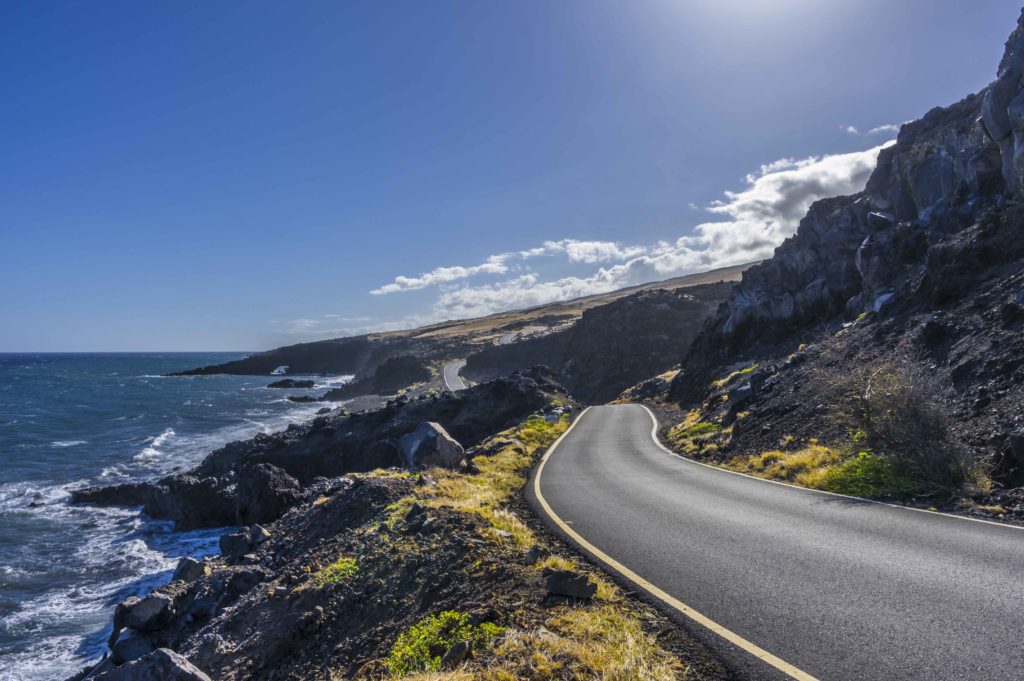
Find the cheapest rates
Avoid the crowds, learn about the hawaiian culture.
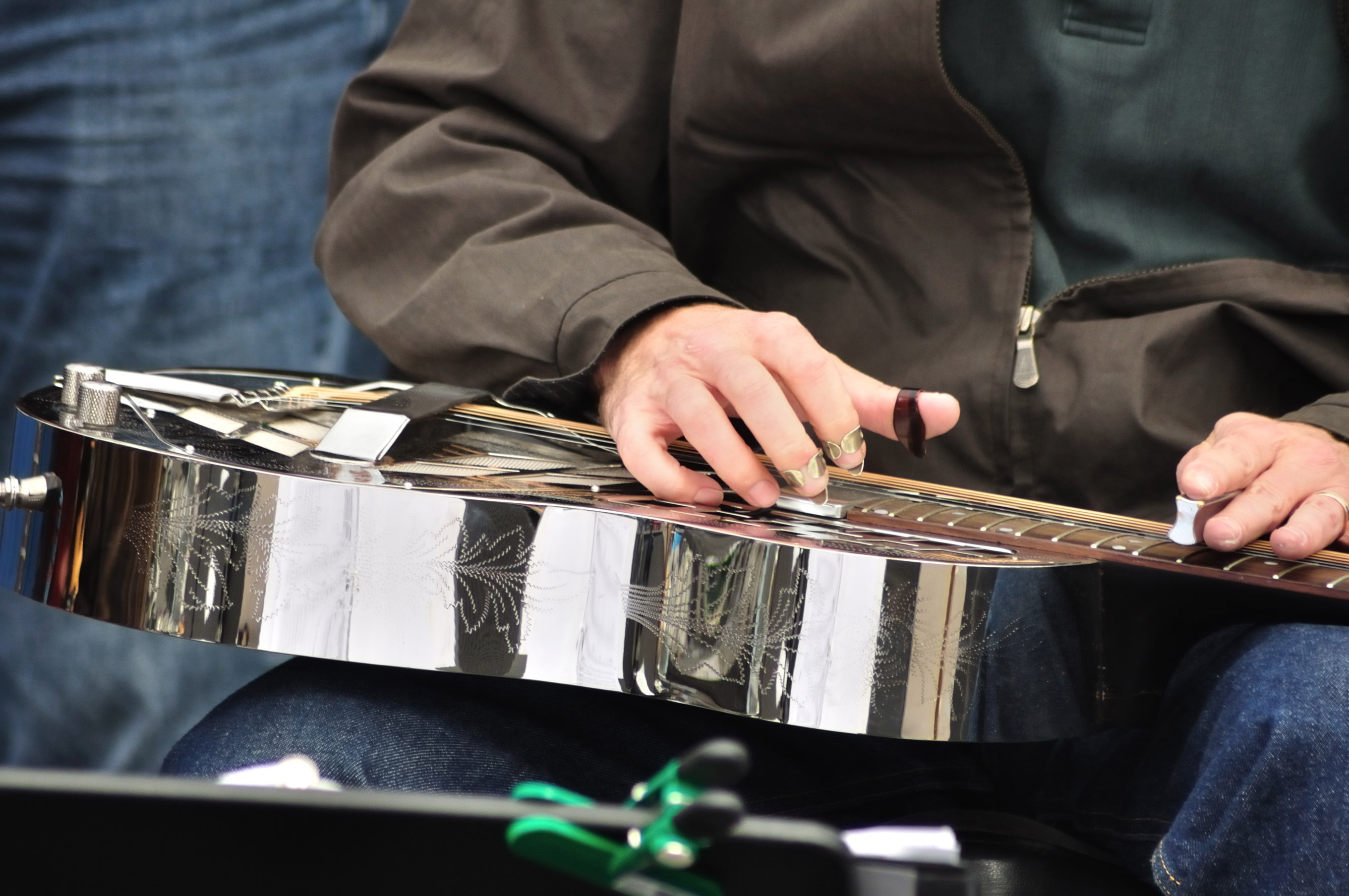
Be inspired by world-class athletes

Kaanapali 8-Line Zipline Adventure
Explore topics.

Best Time to Vist Honolulu
Updated : May 01, 2024
AAA Travel Editor, WA
Table of contents, december to mid-april: peak season, mid-april to mid-june: shoulder season, mid-june to august: peak season, september to november: shoulder season, plan your trip to honolulu with aaa..
When is the best time of year to visit Honolulu , capital and biggest city in Hawai’i? The O’ahu hub offers a plethora of attractions , from the internationally renowned beachfront of Waikiki and the craggy visage of Diamond Head to an epic lineup of restaurants, some outstanding museums (such as the Bishop Museum ) and botanical gardens and multiple major live-performance venues.
All of those are year-round draws, no question and given O’ahu’s tropical climate—and, furthermore, Honolulu’s rain shadowed position on the island’s leeward side—the weather is, let's face it, always pretty fabulous. Indeed, this is a two-season climate with only minimal differences in temperature between the winter/"low-sun" half and the summer/"high-sun" half. Rainfall varies somewhat more strongly between the seasons, but even in the rainiest months Honolulu delivers loads of sunshine, with extended downpours rarer than not.
This means that, overall, other considerations rather than weather determine the best Honolulu time of year for a given traveler’s needs and preferences: from relative levels of crowds and seasonal fluctuations in prices to whale-watching opportunities. We’ll dig into these factors in the following guide on when to visit Honolulu, which breaks down the O’ahu year by relative visitation into two peak seasons and two shoulder seasons. We hope it helps you with your Honolulu trip-planning .
- Pros: Peak season for big-wave surfing and whale-watching; lots of festivals and other events; warm, pleasant “winter” weather compared to much of the U.S.
- Cons: Higher rates and prices; crowds; higher potential for heavier rain
The heart of O’ahu’s “winter” ( Hoo-ilo ) season, this stretch of the calendar is one of two high seasons for tourism and, generally, the busiest. After all, it overlaps with the end-of-the-year holidays as well as spring break and also coincides with wintry weather in more northerly climes: Many from mainland North America (and other areas) flee to Hawai’i this time of year for a break from snow, ice and bone-rattling cold.
And a break is indeed what they get, on account Honolulu—like the rest of the Hawai’ian Islands—experiences a decidedly different sort of winter season than the continental U.S. Winter temperatures on O’ahu typically range between lows in the low 60s F and highs in the upper 70s to low 80s, only marginally cooler than the summer/high-sun weather. We’re talking average monthly temperatures in the coldest months of January and February in the low 70s—not bad.
This is also the rainy season, technically and winter storms such as Kona systems can indeed bring bouts of heavy rainfall. But such rainstorms are often of short duration, lasting perhaps a few hours to a couple of days. They’re unlikely to spoil your vacation, unless you’re only in Honolulu for a day or two; winter here serves up lots of sunshine and prime beachgoing weather.
The burly northerly swells of winter make this the season of pro-level, big-wave surfing on Oahu’s North Shore. Even if you’re not an elite board-rider, you might consider a trip out of Honolulu to go watch the massive breakers and the surfers who tackle them on the other side of the island.
This is also the best time to see humpback whales in O’ahu waters; the leviathans’ journey to the Hawai’ian Islands from Alaska to breed and calve in these balmy channels. Watch for humpbacks from beaches, headlands and other coastal vantages or on whale-watching cruises (many of which depart from Honolulu).
There are plenty of annual events on the winter calendar in and around Honolulu, including O’ahu surfing competitions such as the Volcom Pipe Pro at the North Shore’s celebrated Banzai Pipeline reef break, Hawai’i’s largest charity golf tourney (the Sony Open, in January) and the Honolulu Festival in March, which celebrates Hawai’ian, Pacific and Asian cultures.
It goes without saying that this peak tourism season in Honolulu comes, accordingly, with higher prices for just about everything; the need to book accommodations, dining reservations and the like well in advance; and heavier crowds and traffic.
- Pros: Less crowded; less expensive; continued whale-watching opportunities; near-perfect weather
- Cons: Fewer festivals and events underway
The “spring” shoulder season is one of the best times to visit Honolulu. With the crowds of winter in the rear-view mirror, you’ll find a bit more elbow room on the sands of Waikiki Beach and other popular destinations. Humpback whales continue to be visible in O’ahu waters in April and May, extending the world-class whale-watching for which Hawai’i is known into springtime.
Another reason why this is a contender for the best time of year to visit Honolulu? The weather, which is all-around stellar: Daily temperatures range roughly between the mid-60s and the low 80s and rain showers are rare indeed. Hikers are less likely to run into mud and swollen creeks, particularly in leeward Oahu.
Ocean waters are calming down, too, expanding opportunities for swimming, snorkeling and beginner-level surfing. (Bear in mind you can always find such opportunities in Honolulu, but they’re more seasonal along, for example, the Oahu North Shore, battered as it is during the winter by those gnarly waves.)
Events-wise, this spring window in Honolulu is something of a lull, but you will find some happenings underway, not least the Waikiki Spam Jam.
- Pros: Reliably warm, dry, sunny weather; great season for hiking, swimming, snorkeling, SUP; lots of festivals and events
- Cons: Higher prices and more crowds again
The heart of summer is another top season to visit Honolulu, no question. That’s primarily because families with school-age children are taking advantage of summer vacations. So expect plenty of crowds, pricier airfare and the potential for booked-up lodgings, tours or cruises.
The high-sun weather on O’ahu is pretty ideal. The average temperature of Honolulu’s all-around warmest month, August, is about 80 degrees or so. This is the dry season, too, with very scanty precipitation and a lot of sunshine.
Calm summer waters make for ideal swimming, snorkeling, paddling and other ocean fun and hiking conditions tend to be excellent. And there’s a busy lineup of events, from the King Kamehameha Festival in June and the Hawaii State Farm Fair in July to Waikiki’s Duke Kahanamoku Ocean Festival in August.
- Pros: Fewer crowds; lower prices; lots of annual events
- Cons: Rain becomes more frequent; hurricane season
Oahu’s “fall” shoulder season is another great time to visit Honolulu. You’ll find the city and the island less crowded and less pricey, while the weather remains generally postcard perfect. That said, precipitation tends to increase in October, ushering in the start of the rainy season. This is also the main window for hurricanes, but in fact these tropical cyclones are quite rare in the Hawai’ian Islands, with direct hits few and far between.
There are quite a few high-profile annual events around Oahu during the fall stretch, another reason to visit this time of year. They include the Aloha Festivals, an epic celebration of Hawai’ian culture and heritage, as well as the Hawai’i Food & Wine Festival, the Hawai’ian international Film Festival and Hawai’i Fashion Week. As big-wave surfing season gets underway by November, surf competitions such as the Vans Triple Crown of Surfing also crank up.
Join the over a million people who are AAA members and start planning your trip to Honolulu today. Dream up the perfect trip and use your membership to get the best discounts on hotels , rental cars and entertainment tickets.
More Articles
Travel like an expert with aaa and trip canvas, get ideas from the pros.
As one of the largest travel agencies in North America, we have a wealth of recommendations to share! Browse our articles and videos for inspiration, or dive right in with preplanned AAA Road Trips, cruises and vacation tours.
Build and Research Your Options
Save and organize every aspect of your trip including cruises, hotels, activities, transportation and more. Book hotels confidently using our AAA Diamond Designations and verified reviews.
Book Everything in One Place
From cruises to day tours, buy all parts of your vacation in one transaction, or work with our nationwide network of AAA Travel Agents to secure the trip of your dreams!
- Our Supporters

Biki’s Balancing Act: The Bike Share Company Is Raising Rates While Trying To Attract More Riders

Hawaiian Electric Execs Got Big Raises In 2023. They’re About To See How Shareholders Feel About It

Lessons For Hawaii: Other States Have Strong Pay-To-Play Laws

Proposed Black Sand Beach Development On Big Island Hits Rocky Shores
- Special Projects
- Mobile Menu
Hawaii Is Entering A Dangerous Fire Season. Here’s What Will Be Different Post-Lahaina
Fire and emergency personnel are putting new protocols in place for responding to wildfires, but are also warning that people need to be better prepared, too.
As Hawaii enters its first wildfire season since the deadly Aug. 8 fires in Lahaina, emergency responders and state officials say they’re using lessons learned from the Maui tragedy to better prepare for what forecasters say is a high-risk year for significant fires.
On Oahu and Kauai, fire departments will deploy more engines, tankers and firefighters at the first sign of a wildfire in hopes that gives them a better chance at containing it. State transportation officials are spending $9 million to clear nearly 500 acres of fire breaks in dry, fire-prone regions.
Emergency personnel on Kauai say they’ll now activate their emergency operations center when a red flag warning is issued instead of waiting for a fire to appear to take that step.
And the islands’ two largest power suppliers, Hawaiian Electric Co. and Kauai Island Utility Cooperative, have new protocols in place that include potentially shutting down parts of the grid in advance when it’s too dry and gusty — and the risk of sparking a wildfire is especially high.

Those early moves will surely help Hawaii face the growing risks, advocates say. However, there’s still much more to do long-term to protect the isolated, island state against the threat of catastrophic wildfire. That includes purchasing new and improved fire engines and tankers, boosting efforts to remove the sprawling, invasive grasses that fuel Hawaii’s wildland blazes, and recruiting and persuading more community members to join in the effort.
“I don’t think in my entire career I thought that we would have this elevated commitment across the board” to curb local wildfire risks, nonprofit Hawaii Wildfire Management Organization Co-Director Elizabeth Pickett said Friday as the new, elevated fire season got underway.
That post-Lahaina interest in wildfire mitigation is encouraging but the islands still lack critical fire breaks across vast tracts of land overrun with dead and dry vegetation, she added. “That’s the part I think we could really shore up for this dry season.”
County fire chiefs and emergency planners stress that they won’t be able to tackle the problem alone.
“What we learned on Maui is educating the community about what they can do,” Honolulu Fire Department Chief Sheldon Hao said. “You cannot just look at government. We’re asking the community to help themselves.”
Getting Communities Prepared
On the Big Island, Hawaii Fire Department Chief Kazuo Todd is looking to work more closely with the community on fire-related policies such as building codes, evacuation routes and emergency planning before a wildfire ever sparks.
“It’s not as easy as waiting for the 911 call to come. We have to be reaching out to the community on a deeper level,” Todd said at a Waimea Community Association town hall meeting Thursday.
At a town hall meeting last month on Oahu, Mayor Rick Blangiardi told residents that the Aug. 8 wildfires combined with the 2018 false missile alert, the Covid-19 pandemic and the Red Hill fuel leaks show that local emergency planners can only plan for so many different scenarios.
“To the extent we can prepare, we will. But the challenge right now of what we’re up against, given the enormity and the magnitude and the danger is not something we can easily answer and say we’ve got it handled,” Blangiardi told residents gathered at the Manoa District Park Gymnasium.
It’s estimated that 60% of all communities in Hawaii have just one way in and one way out, Honolulu Department of Emergency Management Hiro Toiya added at that town hall, which presents even more potential challenges when wildfire evacuations are needed.

In Lahaina, scores of people were trapped in traffic gridlock when trying to flee the fire. In an interview last week, Toiya said that Oahu’s county emergency personnel have been discussing how to handle evacuations under different scenarios.
Those post-Lahaina discussions involve efforts to get more advance warning to the public so that the first time the public hears from the county officials they’re not being told to immediately evacuate, he said.
Following last year’s Maui fires, Honolulu fire officials did a lot of community outreach promoting defensible spaces , or maintenance to keep the perimeters around a home free of leaves and other fire fuels, Hao said.
This week, HWMO launched an online symposium, organized with county fire departments, to educate large landowners across the state on the best practices to manage the dry grasses and vegetation that fuel wildland blazes.
Those abundant, dry grasses, paired with wind gusts fueled by a hurricane passing hundreds of miles to the south, enabled the Aug. 8 wildfires on Maui to tear through Lahaina at ferocious speeds.
Prior to Aug. 8, HWMO mostly worked with fire crews “and communities who’ve been scared in the past because fire has come close, and that was it. It was the choir trying to support the choir,” Pickett said.
“Now, it’s everyone actually on board trying to figure out what their roles are and taking steps. This general commitment and awareness is so encouraging, and we’ve long needed it.”
‘What’s The Most We Can Do?’
Maui County officials, including the county’s fire personnel, declined to be interviewed last week regarding any immediate steps they might be taking to address the elevated wildfire threat in the next few months.
However, in an after-action report released last month on the Aug. 8 fires, the Maui Fire Department recommended pre-positioning fire-fighting equipment in high-risk areas during red flag warnings. That’s similar to the protocols enacted this season by Oahu and Kauai’s fire departments.
Hawaii County’s fire and emergency management chiefs did not respond last week to requests for comment.
Hawaiian Electric Co. faced widespread criticism in the aftermath of the fires that destroyed most of Lahaina and devastated parts of upcountry Maui for not already having a “power safety shutoff plan” in place, similar to utility companies in other fire-prone states.
Now, the company expects to have that plan ready by July 1, although officials stress it would only be used as a last resort.

The Western states that have those shutoff plans also have much more advanced weather forecast capabilities than Hawaii does, according to HECO spokesperson Darren Pai. Those states can use those tools to hone in and get a much clearer idea of the real-time conditions on the ground.
“In Hawaii we’re just getting started with that. But we’re putting those things in place and it’s about taking these steps to ensure that we can keep the public safe,” Pai said.
Hawaii’s state emergency leaders say they’re working with the National Weather Service to refine those capabilities so that during a red-flag warning they can better isolate the areas threatened by wildfire.
The state aims to use that data to more strategically deploy weather stations and sensors and keep track of real-time conditions in the most critical areas, said James Barros, Hawaii Emergency Management Agency administrator. Barros did not have an estimate on when that work might be done.
KIUC, meanwhile, already conducted a power safety shutoff last September in Kokee during a red-flag warning, according to utility spokesperson Beth Amaro.
Both utilities also have new post-Lahaina protocols to trip and shut down circuits along their transmission lines more quickly during wildfire conditions.
As the new season begins, more people are taking the wildfire threat seriously.
On Oahu, Honolulu emergency officials will also consider using the island’s all-hazard sirens in “dynamic” emergencies, such as a wildfire, in conjunction with wireless alerts that give the public more details, Toiya said.
However, that’s not a direct result of last year’s fires on Maui, when the county’s emergency officials notoriously opted not to use the sirens, believing the public would assume they faced a tsunami and not a fire.
Instead, it’s been the policy on Oahu to consider using the sirens ever since heavy rains prompted flooding and evacuations in Haleiwa in 2020, Toiya said. Following that event, North Shore residents asked why the county didn’t use the sirens, he added.
Before Lahaina, HFD would initially respond to a wildfire report with one fire engine. Now, the protocol is to send two engines and a tanker out to better ensure the fire doesn’t get out of control, Hao said.
On both Oahu and Kauai, the fire departments will look to deploy more fire crews on those islands’ arid, western sides during wildfire conditions. Kauai Fire Chief Michael Gibson called this policy of so-called “severity staffing” a direct result of what they saw occur on Maui last year.
In the short term, “What’s the most we can do? We know we can’t build a new station.” Beefing up the stations in dry areas during red flag warnings is an optimal way to get additional staff in quickly, he said.
The Kauai Fire Department is also asking for two additional water tankers in the county’s fiscal year 2025 budget, Gibson said. Currently, the department only has one for the entire island and has to draw from tankers from other agencies and private owners in an emergency. The county’s public works department also aims to get excavators, loaders and bulldozers to help clear fire fuel and create fire breaks, he said.
As the new season begins, more people are taking the wildfire threat seriously, Pickett said. Before Lahaina, HWMO would have to convince many locals that the fire risk in Hawaii was high.
“Now we don’t have to say that anymore,” Pickett said. “We’re already past hoping people care to assisting people in taking action and getting ready, which is all we ever really wanted. That elevated level of awareness is going to keep people safer in the long run.”
Civil Beat’s coverage of climate change is supported by the Environmental Funders Group of the Hawaii Community Foundation, Marisla Fund of the Hawaii Community Foundation and the Frost Family Foundation.
--> Sign up for our FREE morning newsletter and face each day more informed. --> Sign up for our FREE morning newsletter and face each day more informed.
We’re a pulitzer finalist, because of you.
Civil Beat is humbled to share that we have been selected as a 2024 Pulitzer Prize Finalist in Breaking News Reporting for our “distinctive, sweeping and urgent coverage of the Maui wildfires…” This honor is shared with our community supporters who have made the investment in our work and mission, so if you are a donor with Civil Beat, mahalo from all of us in the newsroom.
To continue this kind of public-service journalism, we need more readers to become donors. Celebrate with us by making a gift today !
At this momentous occasion, we’d also like to honor the victims of the Maui fires, as well as the survivors who have so bravely and generously shared their stories with our reporters over the past nine months. Thank you.
About the Author

Top Stories

Hawaii’s New School Board Chair Has Played A Big Role In Public Education Reforms

Lawmakers Commit $94M To Fix Deteriorating Prisons And Jails

Naka Nathaniel: Hawaii Remains An Outlier When It Comes To America’s Gun Culture

The Sunshine Blog: A Former Governor’s Part In A Federal Fraud Trial. But Not The One You Think
Get in-depth reporting on hawaii’s biggest issues, sign up for our free morning newsletter.
You're officially signed up for our daily newsletter, the Morning Beat. A confirmation email will arrive shortly.
In the meantime, we have other newsletters that you might enjoy. Check the boxes for emails you'd like to receive.
- Breaking News Alerts What's this? Be the first to hear about important news stories with these occasional emails.
- Special Projects & Investigations What's this? You'll hear from us whenever Civil Beat publishes a major project or investigation.
- Environment What's this? Get our latest environmental news on a monthly basis, including updates on Nathan Eagle's 'Hawaii 2040' series.
- Ideas What's this? Get occasional emails highlighting essays, analysis and opinion from IDEAS, Civil Beat's commentary section.
Inbox overcrowded? Don't worry, you can unsubscribe or update your preferences at any time.

2,100+ Miles: Examining Southwest Airlines' Longest Non-Hawaii Routes
- Southwest Airlines operates domestic routes with its Boeing 737 jets; longest non-Hawaii routes are to Costa Rica and the West Coast.
- Southwest's busiest long-distance routes are out of Baltimore/Washington International Airport.
- Southwest exclusively uses Boeing 737 narrow-body jets for short-haul travel; no widebody long-haul aircraft in their fleet.
Southwest Airlines does not operate any true long-haul flights as it concentrates on the domestic American market and flies short/medium haul Boeing 737s . Many of Southwest Airlines' top ten longest flights are to Hawaii , but what are the airline's longest non-Hawaii routes? This article considers Southwest Airlines' longest flights not to Hawaii.
The longest flight in the world is Singapore Airlines Flight SQ22/SQ21 from Singapore to JFK New York, while many of the other longest flights are from the Middle East to New Zealand and Australia .
Southwest Airlines' longest non-Hawaii routes
Southwest's longest route is from Phoenix to Honolulu (a distance of around 2,917 miles), while the longest non-Hawaii route is from Baltimore/Washington to Oakland (a distance of around 2,446 miles). By comparison, the longest Delta Air Lines flight is from Atlanta to Johannesburg (South Africa) - a distance of 8,433 miles taking around 16 hours and 30 minutes inbound.
Below are the eight longest non-Hawaii Southwest Airlines routes per Cirium (an aviation analytics company). The flights and data are for the week of May 13-19 and include all Southwest (non-Hawaiian) flights longer than 2,100 miles. Note that each of these routes also includes the return flight. Denver International Airport has Southwest's two longest international routes with both flights going to different airports in Costa Rica.
Four of the eight longest routes are out of Baltimore/Washington International Airport, and all four are transcontinental flights to the West Coast (including Las Vegas). Baltimore has all of the busiest, longest-distance Southwest routes. The busiest of these longest routes are from Baltimore to Las Vegas, San Diego, and Los Angeles, with Available Seat Miles (ASMs) of 9,750,000, 7,340,000, and 6,930,000, respectively.
Southwest Airlines To Reduce Pilot Hours Over Boeing Delays But Does Not Anticipate Furloughs
A low-cost domestic-focused airline.
Southwest Airlines is one of the major airlines in the United States, connecting most of the country. It is headquartered in Love Field, Dallas, and unlike most airlines that use a hub-and-spoke model, Southwest uses a point-to-point system. It operates flights to around 121 destinations in the United States and 42 of the nation's 50 states (plus Puerto Rico).
Southwest Airlines International Destinations
Southwest Airlines focuses on popular routes, maximizing efficiency, reducing turnaround times, and lowering costs. Southwest's successful business model has been replicated by Ryanair and EasyJet in Europe. When measured by passengers flown, it is the third-busiest carrier in North America (although Southwest Airlines is no longer ranked in the top three by market value ).
However, Southwest mostly concentrates on operating as a domestic carrier, offering comparatively few international routes (compared to Delta Air Lines and United). Southwest only offers international flights to popular tourist destinations in the Mexican/Central American/Caribbean era. It only operates flights to 10 countries outside of the United States. This means that Southwest does not operate outside of North America.
Surprisingly, Southwest does not operate any flights north to Canada. But it's not just Canada. Southwest Airlines doesn't operate any flights to Alaska either.
Southwest Airlines Will Cut 25 Flights From HartsfieldJackson Atlanta International Airport
No widebody long-haul aircraft.
Southwest was a launch customer for Boeing's 737-700, 737-500, 737-300, and 737 MAX 8. Today, Southwest Airlines operates on a low-cost carrier model and exclusively uses Boeing 737 family jets (it has a total of 817 Boeing 737s as of December 31, 2023). Boeing 737s are narrow-body airliners designed for short-haul travel. This means Southwest does not have jets capable of flying long-haul.
The range of a Boeing 737 depends on its load, its type, and other factors. Boeing lists the Boeing 737-8 as having a range of 3,500 nautical miles or around 4,025 miles. Southwest Airlines mostly uses its Boeing 737 MAX 8s for flights to Hawai'i and interisland travel (Southwest's first 737 MAX 8s began scheduled service on October 1, 2017). Boeing 737 MAX 8s are approximately 14% more fuel-efficient than the prior generation Boeing 737-800 aircraft.
Southwest's fleet averages around 11 years old. The average aircraft trip length in 2023 was 730 miles, while the average flight duration was around two hours.
Southwest Airlines
IATA/ICAO Code: WN/SWA
Airline Type: Low-Cost Carrier
Hub(s): Baltimore/Washington International Thurgood Marshall Airport, Dallas Love Field, Denver International Airport, Harry Reid International Airport, Hartsfield-Jackson Atlanta International Airport, Houston Hobby Airport, Los Angeles International Airport, Midway International Airport, Oakland International Airport, Orlando International Airport, Phoenix Sky Harbor International Airport
Year Founded: 1967
CEO: Robert Jordan
Country: United States


100 Day Dream Home
- Bargain Block
- Battle on the Beach
- Battle on the Mountain
- Building Roots
- Celebrity IOU
- Christina on the Coast
- Down Home Fab
Farmhouse Fixer
- Fixer to Fabulous
- Help! I Wrecked My House
- Home Town Takeover
House Hunters
- Lakefront Empire
- Lil Jon Wants to Do What?
- Love It or List It
- Married to Real Estate
- My Lottery Dream Home
- No Demo Reno
- Property Brothers: Forever Home
Renovation Aloha
- Rico to the Rescue
- Rock the Block
- Small Town Potential
- Ugliest House in America
- Unsellable Houses
- Who's Afraid of a Cheap Old House?
- Why the Heck Did I Buy This House?
- Zillow Gone Wild
- See Full Schedule
- Stream Full Seasons
- Sign Up for Our Newsletters
- Ideas by Room
- Design Styles
- HGTV Magazine
- HGTV Newsletters
- Flowers and Plants
- Landscaping and Hardscaping
- Outdoor Spaces
- Curb Appeal
- Cleaning and Organizing
- Entertaining
- Healthy Home and Garden
- Real Estate
- Home Improvement
- DIY Projects
- HGTV Handmade
- HGTV Smart Home 2024: Enter the Sweepstakes
- Get Outside $5K Giveaway
- Throw It on the Grill $10K Giveaway
- Spring It Forward $5K Giveaway
- HGTV Dream Home 2024
- HGTV Urban Oasis 2023
- Product Reviews
- Gift Guides
- Sales and Deals
- News and Trends
- Newsletters
- TV Schedule
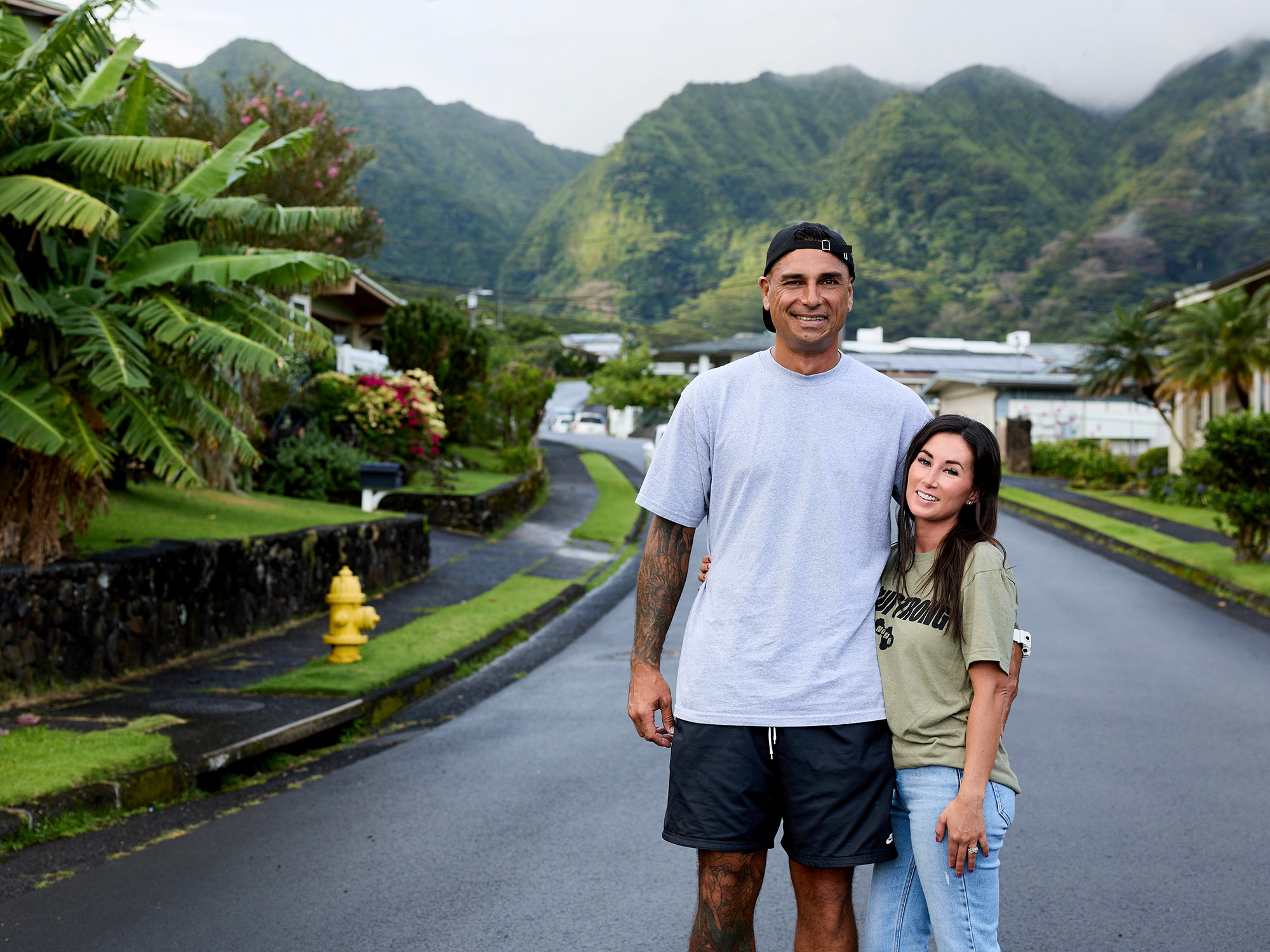
All the Details on 'Renovation Aloha'
Hawaii's most rundown properties get a new life.
About The Show
Follow husband-and-wife team Kamohai and Tristyn Kalama as they take on house-flipping projects across the island of Oahu, Hawaii, the most restrictive and difficult flipping location in the country.
Kamohai Kalama

Tristyn Kalama
The latest from 'renovation aloha'.

'Renovation Aloha' Returns to HGTV for Season 2 With More Stunning Hawaiian Home Renovations
Tristyn and Kamohai Kalama are back for a second season. Here's everything we know.
.jpg.rend.hgtvcom.616.462.suffix/1710463830950.jpeg)
Stunning Hawaiian Home Makeovers From 'Renovation Aloha' 15 Photos
Check out these amazing before-and-after makeovers, which Renovation Aloha hosts Kamohai and Tristyn pulled off in one of the most …
.jpg.rend.hgtvcom.616.462.suffix/1705686929117.jpeg)
Meet Tristyn and Kamohai Kalama, the Power Couple Hosts of 'Renovation Aloha'
These Hawaiian locals are uplifting their community one flip at a time.

HGTV's Sunny New Show 'Renovation Aloha' Features Stunning Hawaiian Home Renovations
Hawaii's most rundown properties get a new life in HGTV's Renovation Aloha. HGTV has all the details.
Follow the Kalamas on Instagram
View this post on Instagram A post shared by Kamohai and Tristyn Kalama | Hawaii Real Estate Investors (@kamohaiandtristyn)
- Recently On TV
Restoring the Block
Kamohai and Tristyn buy their third house on the same block in Kamohai's hometown of Kaneohe. Unfortunately, the house is in even worse shape than they thought, and it's going to take all of their skills to successfully pull off a transformation.
Bee Infestation on the Bay
A heads-up from a junkman gives Kamohai and Tristyn the chance to buy a house with a million-dollar view. Now, they have to tackle walls full of bees, rat infestations and water damage in order to turn a disaster into a luxurious, modern masterpiece.
Discovery Disgusting
A family connection helps Kamohai and Tristyn land a rough house in a fantastic neighborhood for a good deal. The horrifying smells and birds inside don't scare them, but a challenging layout and a crumbling foundation certainly put them to the test.
Historic Hawaiian Finds
Kamohai and Tristyn buy an off-market property in one of the oldest and most desirable neighborhoods in Honolulu. They're at a luxury price point that raises the stakes, so they're looking to give this house a high-end look with no budge in their budget.
Termites to Treasure
Kamohai and Tristyn are led to a neighborhood they've never tackled before and homes that pull at their heartstrings. They want to make a profit in uncharted territory, but they'll have to look past termites and spiders to see a house's true potential.
House Held Up by Car Jacks
Kamohai and Tristyn buy a house that's so termite eaten they don't even need a hammer for demo. And more problems appear as they peel back the layers as they discover a deck being held up by a rope and a foundation that's on car jacks.
High Stakes on the Lake
Kamohai and Tristyn put it all on the line as they attempt their priciest flip to date. Things get off to a rocky start when the "new" deck falls apart, and they also discover they need to add some serious square footage to appeal to a high-end buyer.
House Hunters International

Sunday Nights at 8|7c
HGTV Insider Newsletter
Go behind the scenes at HGTV with your favorite show and host news, delivered straight to your inbox.
By entering your email address, you agree to our Terms of Use and acknowledge the Privacy Policy . HGTV and its affiliates may use your email address to provide updates, ads, and offers.
To withdraw your consent or learn more about your rights, see the Privacy Policy .
- HGTV Insider
- HGTV Shopping
- HGTV Makeovers
- HGTV This Week
- HGTV Gardens and Outdoors
- HGTV Daily Sweepstakes Reminder
- HGTV Inspiration
- HGTV Weekend Projects
- Sweepstakes Updates
Follow Us Everywhere
Join the party! Don't miss HGTV in your favorite social media feeds.
- Connect With HGTV Talent
Luxury Home Giveaways

HGTV Smart Home
A sophisticated Southwestern home in Santa Fe, New Mexico

HGTV Dream Home
A modern mountain getaway in Morrison, Colorado

HGTV Urban Oasis
A Southern-inspired escape in Louisville, Kentucky
Must-See Videos

Fixer to Fabulous Season One Highlights 20 Videos

Home Town Bonus Series: Erin'spired 25 Videos

Celebrity I.O.U Season One Highlights 17 Videos
- Share full article
For more audio journalism and storytelling, download New York Times Audio , a new iOS app available for news subscribers.
The Protesters and the President
Over the past week, thousands of students protesting the war in gaza have been arrested..
This transcript was created using speech recognition software. While it has been reviewed by human transcribers, it may contain errors. Please review the episode audio before quoting from this transcript and email [email protected] with any questions.
From “New York Times,” I’m Michael Barbaro. This is “The Daily.”
Free, free, Palestine!
Free, free Palestine!
Free, free, free Palestine!
Over the past week, what had begun as a smattering of pro-Palestinian protests on America’s college campuses exploded into a nationwide movement —
United, we’ll never be defeated!
— as students at dozens of universities held demonstrations, set up encampments, and at times seized academic buildings.
[PROTESTERS CLAMORING]:
response, administrators at many of those colleges decided to crack down —
Do not throw things at our officers. We will use chemical munitions that include gas.
— calling in local police to carry out mass detentions and arrests. From Arizona State —
In the name of the state of Arizona, I declare this gathering to be a violation of —
— to the University of Georgia —
— to City College of New York.
[PROTESTERS CHANTING, “BACK OFF”]:
As of Thursday, police had arrested 2,000 students on more than 40 campuses. A situation so startling that President Biden could no longer ignore it.
Look, it’s basically a matter of fairness. It’s a matter of what’s right. There’s the right to protest, but not the right to cause chaos.
Today, my colleagues Jonathan Wolfe and Peter Baker on a history-making week. It’s Friday, May 3.
Jonathan, as this tumultuous week on college campuses comes to an end, it feels like the most extraordinary scenes played out on the campus of the University of California Los Angeles, where you have been reporting. What is the story of how that protest started and ultimately became so explosive?
So late last week, pro-Palestinian protesters set up an encampment at the University of California, Los Angeles.
From the river to the sea!
Palestine will be free!
Palestine —
It was right in front of Royce Hall, which I don’t know if you are familiar with UCLA, but it’s a very famous, red brick building. It’s on all the brochures. And there was two things that stood out about this encampment. And the first thing was that they barricaded the encampment.
The encampment, complete with tents and barricades, has been set up in the middle of the Westwood campus. The protesters demand —
They have metal grates. They had wooden pallets. And they separated themselves from the campus.
This is kind of interesting. There are controlling access, as we’ve been talking about. They are trying to control who is allowed in, who is allowed out.
They sort of policed the area. So they only would let people that were part of their community, they said, inside.
I’m a UCLA student. I deserve to go here. We paid tuition. This is our school. And they’re not letting me walk in. Why can’t I go? Will you let me go in?
We’re not engaging with that.
Then you can move. Will you move?
And the second thing that stood out about this camp was that it immediately attracted pro-Israel counterprotesters.
And what did the leadership of UCLA say about all of this, the encampment and these counterprotesters?
So the University of California’s approach was pretty unique. They had a really hands-off approach. And they allowed the pro-Palestinian protesters to set up an encampment. They allowed the counterprotesters to happen. I mean, this is a public university, so anyone who wants to can just enter the campus.
So when do things start to escalate?
So there were definitely fights and scuffles through the weekend. But a turning point was really Sunday —
[SINGING IN HEBREW]:
— when this group called the Israeli American Council, they’re a nonprofit organization, organized a rally on campus. The Israeli American Council has really been against these pro-Palestinian protests. They say that they’re antisemitic. So this nonprofit group sets up a stage with a screen really just a few yards from the pro-Palestinian encampment.
We are grateful that this past Friday, the University of California, stated that they will continue to oppose any calls for boycott and divestment from Israel!
[PROTESTERS CHEERING]
And they host speakers and they held prayers.
Jewish students, you’re not alone! Oh, you’re not alone! We are right here with you! And we’re right here with you in until —
[WORDLESS SINGING]:
And then lots of other people start showing up. And the proximity between protesters and counterprotesters and even some agitators, makes it really clear that something was about to happen.
And what was that? What ended up happening?
On Monday night, a group of about 60 counterprotesters tried to breach the encampment there. And the campus police had to break it up. And things escalated again on Tuesday.
They stormed the barricades and it’s a complete riot.
[PROTESTER SHOUTING]:
Put it down! Put it down! Put it down!
I went to report on what happened just a few hours after it ended.
And I spoke to a lot of protesters. And I met one demonstrator, Marie.
Yeah, my first name is Marie. M-A-R-I-E. Last name, Salem.
And Marie described what happened.
So can you just tell me a little bit about what happened last night?
Last night, we were approached by over a hundred counterprotesters who were very mobilized and ready to break into camp. They proceeded to try to breach our barricades extremely violently.
Marie said it started getting out of hand when counterprotesters started setting off fireworks towards the camp.
They had bear spray. They had Mace. They were throwing wood and spears. Throwing water bottles, continuing fireworks.
So she said that they were terrified. It was just all hands on deck. Everyone was guarding the barricades.
Every time someone experienced the bear spray or Mace or was hit and bleeding, we had some medics in the front line. And then we had people —
And they said that they were just trying to take care of people who were injured.
I mean, at any given moment, there was 5 to 10 people being treated.
So what she described to me sounded more like a battlefield than a college campus.
And it was just a complete terror and complete abandonment of the university, as we also watched private security watch this the entire time on the stairs. And some LAPD were stationed about a football field length back from these counterprotesters, and did not make a single arrest, did not attempt to stop any violence, did not attempt to get in between the two groups. No attempt.
I should say, I spoke to a state authorities and eyewitnesses and they confirmed Marie’s account about what happened that night, both in terms of the violence that took place at the encampment and how law enforcement responded. So in the end, people ended up fighting for hours before the police intervened.
[SOMBER MUSIC]
So in her mind, UCLA’s hands-off approach, which seemed to have prevailed throughout this entire period, ends up being way too hands off in a moment when students were in jeopardy.
That’s right. And so at this point, the protesters in the encampment started preparing for two possibilities. One was that this group of counterprotesters would return and attack them. And the second one was that the police would come and try to break up this encampment.
So they started building up the barricades. They start reinforcing them with wood. And during the day, hundreds of people came and brought them supplies. They brought food.
They brought helmets, goggles, earplugs, saline solution, all sorts of things these people could use to defend themselves. And so they’re really getting ready to burrow in. And in the end, it was the police who came.
[PROTESTERS SHOUTING]:
So Wednesday at 7:00 PM, they made an announcement on top of Royce Hall, which overlooks the encampment —
— administrative criminal actions up to and including arrest. Please leave the area immediately.
And they told people in the encampment that they needed to leave or face arrest.
[DRUM BEATING]: [PROTESTERS CHANTING]
And so as night falls, they put on all this gear that they’ve been collecting, the goggles, the masks and the earplugs, and they wait for the police.
[DRUM BEATING]:
And so the police arrive and station themselves right in front of the encampment. And then at a certain point, they storm the back stairs of the encampment.
[PROTESTERS CHANTING]:
And this is the stairs that the protesters have been using to enter and exit the camp. And they set up a line. And the protesters do this really surprising thing.
The people united!
They open up umbrellas. They have these strobe lights. And they’re flashing them at the police, who just slowly back out of the camp.
[PROTESTERS CHEERING]:
And so at this point, they’re feeling really great. They’re like, we did it. We pushed them out of their camp. And when the cops try to push again on those same set of stairs —
[PROTESTER SHOUTS]:
Hold your ground!
— the protesters organized themselves with all these shields that they had built earlier. And they go and confront them. And so there’s this moment where the police are trying to push up the stairs. And the protesters are literally pushing them back.
Push them back! Push them back!
Push them back!
And at a certain point, dozens of the police officers who were there, basically just turn around and leave.
So how does this eventually come to an end?
So at a certain point, the police push in again. Most of the conflict is centered at the front of these barricades. And the police just start tearing them apart.
[METAL CLANGING]
[CLAMORING]
They removed the front barricade. And in its place is this group of protesters who have linked arms and they’re hanging on to each other. And the police are trying to pull protesters one by one away from this group.
He’s just a student! Back off!
But they’re having a really hard time because there’s so many protesters. And they’re all just hanging on to each other.
We’re moving back now.
So at a certain point, one of the police officers started firing something into the crowd. We don’t exactly know what it was. But it really spooked the protesters.
Stop shooting at kids! Fuck you! Fuck them!
They started falling back. Everyone was really scared. The protesters were yelling, don’t shoot us. And at that point, the police just stormed the camp.
Get back. Get back.
Back up now!
And so after about four hours of this, the police pushed the protesters out of the encampment. They had arrested about 200 protesters. And this was finally over.
And I’m just curious, Jonathan, because you’re standing right there, you are bearing witness to this all, what you were thinking, what your impressions of this were.
I mean, I was stunned. These are mostly teenagers. This is a college campus, an institution of higher learning. And what I saw in front of me looked like a war zone.
[TENSE MUSIC]
The massive barricade, the police coming in with riot gear, and all this violence was happening in front of these red brick buildings that are famous for symbolizing a really open college campus. And everything about it was just totally surreal.
Well, Jonathan, thank you very much. We appreciate it.
Thanks, Michael.
We’ll be right back.
Peter, around 10:00 AM on Thursday morning as the smoke is literally still clearing at the University of California Los Angeles, you get word that President Biden is going to speak.
Right, exactly. It wasn’t on his public schedule. He was about to head to Andrews Air Force base in order to take a trip. And then suddenly, we got the notice that he was going to be addressing the cameras in the Roosevelt Room.
They didn’t tell us what he was going to talk about. But it was pretty clear, I think. Everybody understood that it was going to be about these campus protests, about the growing violence and the clashes with police, and the arrests that the entire country had been watching on TV every night for the past week, and I think that we were watching just that morning with UCLA. And it reached the point where he just had to say something.
And why, in his estimation and those of his advisors, was this the moment that Biden had to say something?
Well, it kind of reached a boiling point. It kind of reached the impression of a national crisis. And you expect to hear your president address it in this kind of a moment, particularly because it’s about his own policy. His policy toward Israel is at the heart of these protests. And he was getting a lot of grief. He was getting a lot of grief from Republicans who were chiding him for not speaking out personally. He hadn’t said anything in about 10 days.
He’s getting a lot of pressure from Democrats, too, who wanted him to come out and be more forceful. It wasn’t enough, in their view, to leave it to his spokespeople to say something. Moderate Democrats felt he needed to come out and take some leadership on this.
And so at the appointed moment, Peter, what does Biden actually say in the Roosevelt Room of the White House?
Good morning.
Before I head to North Carolina, I wanted to speak for a few moments about what’s going on, on our college campuses here.
Well, it comes in the Roosevelt Room and he talks to the camera. And he talks about the two clashing imperatives of American principle.
The first is the right to free speech and for people to peacefully assemble and make their voices heard. The second is the rule of law. Both must be upheld.
One is freedom of speech. The other is the rule of law.
In fact, peaceful protest is in the best tradition of how Americans respond to consequential issues. But, but, neither are we a lawless country.
In other words, what he’s saying is, yes, I support the right of these protesters to come out and object to even my own policy, in effect, is what he’s saying. But it shouldn’t trail into violence.
Destroying property is not a peaceful protest. It’s against the law. Vandalism, trespassing, breaking windows, shutting down campuses —
It shouldn’t trail into taking over buildings and obstructing students from going to class or canceling their graduations.
Threatening people, intimidating people, instilling fear in people is not peaceful protest. It’s against the law.
And he leans very heavily into this idea that what he’s seeing these days goes beyond the line.
I understand people have strong feelings and deep convictions. In America, we respect the right and protect the right for them to express that. But it doesn’t mean anything goes.
It has crossed into harassment and expressions of hate in a way that goes against the national character.
As president, I will always defend free speech. And I will always be just as strong and standing up for the rule of law. That’s my responsibility to you, the American people, and my obligation to the Constitution. Thank you very much.
Right, as I watched the speech, I heard his overriding message to basically be, I, the president of the United States, am drawing a line. These protests and counterprotests, the seizing and defacing of campus buildings, class disruption, all of it, name calling, it’s getting out of hand. That there’s a right way to do this. And what I’m seeing is the wrong way to do it and it has to stop.
That’s exactly right. And as he’s wrapping up, reporters, of course, ask questions. And the first question is —
Mr. President, have the protests forced you to reconsider any of the policies with regard to the region?
— will this change your policy toward the war in Gaza? Which, of course, is exactly what the protesters want. That’s the point.
And he basically says —
— no. Just one word, no.
Right. And that felt kind of important, as brief and fleeting as it was, because at the end of the day, what he’s saying to these protesters is, I’m not going to do what you want. And basically, your protests are never going to work. I’m not going to change the US’s involvement in this war.
Yeah, that’s exactly right. He is saying, I’m not going to be swayed by angry people in the streets. I’m going to do what I think is right when it comes to foreign policy. Now, what he thinks is that they’re not giving him enough credit for trying to achieve what they want, which is an end of the war.
He has been pressuring Israel and Hamas to come to a deal for a ceasefire that will, hopefully, in his view, would then lead to a more enduring end of hostilities. But, of course, this deal hasn’t gone anywhere. Hamas, in particular, seems to be resisting it. And so the president is left with a policy of arming Israel without having found a way yet to stop the war.
Right. I wonder, though, Peter, if we’re being honest, don’t these protests, despite what Biden is saying there, inevitably exert a kind of power over him? Becoming one of many pressures, but a pressure nonetheless that does influence how he thinks about these moments. I mean, here he is at the White House devoting an entire conversation to the nation to these campus protests.
Well, look, he knows this feeds into the political environment in which he’s running for re-election, in which he basically has people who otherwise might be his supporters on the left disenchanted with him. And he knows that there’s a cost to be paid. And that certainly, obviously, is in his head as he’s thinking about what to do.
But I think his view of the war is changing by the day for all sorts of reasons. And most of them having to do with realities on the ground. He has decided that Israel has gone far enough, if not too far, in the way it has conducted this operation in Gaza.
He is upset about the humanitarian crisis there. And he’s looking for a way to wrap all this up into a move that would move to peacemaking, beginning to get the region to a different stage, maybe have a deal with the Saudis to normalize relations with Israel in exchange for some sort of a two-state solution that would eventually resolve the Palestinian issue at its core.
So I think it’s probably fair to say that the protests won’t move him in an immediate kind of sense. But they obviously play into the larger zeitgeist of the moment. And I also think it’s important to know who Joe Biden is at heart.
Explain that.
He’s not drawn to activism. He was around in 1968, the last time we saw this major conflagration at Columbia University, for instance. At the time, Joe Biden was a law student in Syracuse, about 250 miles away. And he was an institutionalist even then.
He was just focused on his studies. He was about to graduate. He was thinking about the law career. And he didn’t really have much of an affinity, I think, for his fellow students of that era, for their activist way of looking at things.
He tells a story in his memoir about walking down a street in Syracuse one day to go to the pizza shop with some friends. And they walk by the administration building. And they see people hanging out of the windows. They’re hanging SDS banners. That’s the Students for a Democratic Society, which was one of the big activist groups of the era.
And he says, they were taking over the building. And we looked up and said, look at those assholes. That’s how far apart from the antiwar movement I was. That’s him writing in his memoir.
So to a young Joe Biden, those who devote their time and their energy to protesting the war are, I don’t need to repeat the word twice, but they’re losers. They’re not worth his time.
Well, I think it’s the tactics they’re using more than the goals that he disagreed with. He would tell you he disagreed with the Vietnam War. He was for civil rights. But he thought that taking over a building was performative, was all about getting attention, and that there was a better way, in his view, to do it.
He was somebody who wanted to work inside the system. He said in an interview quite a few years back, he says, look, I was wearing sports coats in that era. He saw himself becoming part of the system, not somebody trying to tear it down.
And so how should we think about that Joe Biden, when we think about this Joe Biden? I mean, the Joe Biden who, as a young man, looked upon antiwar protesters with disdain and the one who is now president and his very own policies have inspired such ferocious campus protests?
Yeah, that Joe Biden, the 1968 Joe Biden, he could just throw on a sports coat, go to the pizza shop with his friends, make fun of the activists and call them names, and then that’s it. They didn’t have to affect his life. But that’s not what 2024 Joe Biden can do.
Now, wherever he goes, he’s dogged by this. He goes to speeches and people are shouting at him, Genocide Joe! Genocide Joe! He is the target of the same kind of a movement that he disdained in 1968. And so as much as he would like to ignore it or move on or focus on other things, I think this has become a defining image of his year and one of the defining images, perhaps, of his presidency. And 2024 Joe Biden can’t simply ignore it.
Well, Peter, thank you very much. We appreciate it.
[UPBEAT MUSIC]
Here’s what else you need to know today. During testimony on Thursday in Donald Trump’s hush money trial, jurors heard a recording secretly made by Trump’s former fixer, Michael Cohen, in which Trump discusses a deal to buy a woman’s silence. In the recording, Trump asks Cohen about how one payment made by Trump to a woman named Karen McDougal would be financed. The recording could complicate efforts by Trump’s lawyers to distance him from the hush money deals at the center of the trial.
A final thing to know, tomorrow morning, we’ll be sending you the latest episode from our colleagues over at “The Interview.” This week, David Marchese talks with comedy star Marlon Wayans about his new stand-up special.
It’s a high that you get when you don’t know if this joke that I’m about to say is going to offend everybody. Are they going to walk out? Are they going to boo me? Are they going to hate this. And then you tell it, and everybody cracks up and you’re like, woo.
Today’s episode was produced by Diana Nguyen, Luke Vander Ploeg, Alexandra Leigh Young, Nina Feldman, and Carlos Prieto. It was edited by Lisa Chow and Michael Benoist. It contains original music by Dan Powell and Marion Lozano, and was engineered by Chris Wood. Our theme music is by Jim Brunberg and Ben Landsverk of Wonderly.
That’s it for “The Daily.” I’m Michael Barbaro. See you on Monday.

- May 8, 2024 • 28:28 A Plan to Remake the Middle East
- May 7, 2024 • 27:43 How Changing Ocean Temperatures Could Upend Life on Earth
- May 6, 2024 • 29:23 R.F.K. Jr.’s Battle to Get on the Ballot
- May 3, 2024 • 25:33 The Protesters and the President
- May 2, 2024 • 29:13 Biden Loosens Up on Weed
- May 1, 2024 • 35:16 The New Abortion Fight Before the Supreme Court
- April 30, 2024 • 27:40 The Secret Push That Could Ban TikTok
- April 29, 2024 • 47:53 Trump 2.0: What a Second Trump Presidency Would Bring
- April 26, 2024 • 21:50 Harvey Weinstein Conviction Thrown Out
- April 25, 2024 • 40:33 The Crackdown on Student Protesters
- April 24, 2024 • 32:18 Is $60 Billion Enough to Save Ukraine?
- April 23, 2024 • 30:30 A Salacious Conspiracy or Just 34 Pieces of Paper?
Hosted by Michael Barbaro
Featuring Jonathan Wolfe and Peter Baker
Produced by Diana Nguyen , Luke Vander Ploeg , Alexandra Leigh Young , Nina Feldman and Carlos Prieto
Edited by Lisa Chow and Michael Benoist
Original music by Dan Powell and Marion Lozano
Engineered by Chris Wood
Listen and follow The Daily Apple Podcasts | Spotify | Amazon Music | YouTube
Warning: this episode contains strong language.
Over the past week, students at dozens of universities held demonstrations, set up encampments and, at times, seized academic buildings. In response, administrators at many of those colleges decided to crack down and called in the local police to detain and arrest demonstrators.
As of Thursday, the police had arrested 2,000 people across more than 40 campuses, a situation so startling that President Biden could no longer ignore it.
Jonathan Wolfe, who has been covering the student protests for The Times, and Peter Baker, the chief White House correspondent, discuss the history-making week.
On today’s episode

Jonathan Wolfe , a senior staff editor on the newsletters team at The New York Times.

Peter Baker , the chief White House correspondent for The New York Times covering President Biden and his administration.

Background reading
As crews cleared the remnants of an encampment at U.C.L.A., students and faculty members wondered how the university could have handled protests over the war in Gaza so badly .
Biden denounced violence on campus , breaking his silence after a rash of arrests.
There are a lot of ways to listen to The Daily. Here’s how.
We aim to make transcripts available the next workday after an episode’s publication. You can find them at the top of the page.
The Daily is made by Rachel Quester, Lynsea Garrison, Clare Toeniskoetter, Paige Cowett, Michael Simon Johnson, Brad Fisher, Chris Wood, Jessica Cheung, Stella Tan, Alexandra Leigh Young, Lisa Chow, Eric Krupke, Marc Georges, Luke Vander Ploeg, M.J. Davis Lin, Dan Powell, Sydney Harper, Mike Benoist, Liz O. Baylen, Asthaa Chaturvedi, Rachelle Bonja, Diana Nguyen, Marion Lozano, Corey Schreppel, Rob Szypko, Elisheba Ittoop, Mooj Zadie, Patricia Willens, Rowan Niemisto, Jody Becker, Rikki Novetsky, John Ketchum, Nina Feldman, Will Reid, Carlos Prieto, Ben Calhoun, Susan Lee, Lexie Diao, Mary Wilson, Alex Stern, Dan Farrell, Sophia Lanman, Shannon Lin, Diane Wong, Devon Taylor, Alyssa Moxley, Summer Thomad, Olivia Natt, Daniel Ramirez and Brendan Klinkenberg.
Our theme music is by Jim Brunberg and Ben Landsverk of Wonderly. Special thanks to Sam Dolnick, Paula Szuchman, Lisa Tobin, Larissa Anderson, Julia Simon, Sofia Milan, Mahima Chablani, Elizabeth Davis-Moorer, Jeffrey Miranda, Renan Borelli, Maddy Masiello, Isabella Anderson and Nina Lassam.
Jonathan Wolfe is a senior staff editor on the newsletters team at The Times. More about Jonathan Wolfe
Peter Baker is the chief White House correspondent for The Times. He has covered the last five presidents and sometimes writes analytical pieces that place presidents and their administrations in a larger context and historical framework. More about Peter Baker
Luke Vander Ploeg is a senior producer on “The Daily” and a reporter for the National Desk covering the Midwest. More about Luke Vander Ploeg
Advertisement

IMAGES
VIDEO
COMMENTS
Find the Best Attractions in Hawaii. Compare Prices and Book Online. Full Refund Available up to 24 Hours Before Your Tour Date. Quick & Easy Purchase Process.
The peak tourism season in Hawaii typically starts in the middle of December and continues until the end of March or mid-April, depending on the timing of spring break for major parts of the U.S. ... such as late November and early March. This past September, we saw a fare war develop with prices as low as $62 one-way to Hawaii. This is ...
Generally, the best time to visit Hawaii for the most ideal overall weather, lowest statewide rates, and the fewest visitors on-island is April and May during the spring and September and October during the fall. Some refer to these times as Hawaii's 'off-season period' or 'shoulder months.'. In the summer, it will certainly be more crowded, so ...
Visiting Hawaii During the Winter. Temperatures in December through February are in the mid to low 80s. The average lows are in the mid-60s. The winter months see the most rain overall with about 3.5 inches of precipitation every month. Mid-December to March is also the peak tourist season in Hawaii.
This low crowd advantage means quieter beaches, shorter queues at attractions, and a more intimate, relaxed Hawaiian vacation experience. October in Hawaii: Cinema, Celebrations, and Calm. October in Hawaii greets visitors with a refreshing ambiance. ... The off-season in Hawaii, when tourism tends to be lower and you might find better deals ...
However, some periods are busier than others. According to the Hawaiian Tourism Authority, the most popular months for tourists are almost always June, July, and December (in some configuration ...
September to October is the cheapest time to visit. Fall is typically the slower season for travel in Hawaii - you'll run into fewer crowds but still enjoy warm temperatures, averaging a high of 88°F. Airfare from the US mainland is usually at its lowest, and finding deals (and rooms) at hotels will be easier. Evenings are balmy - perfect ...
The best time to visit Hawaii is during the shoulder season months: April, May, September, October, and November (before Thanksgiving). The best month to visit Hawaii is September. ... In this low average temperature graph for popular resort areas, the temperature is always between 70 and 80 degrees. You may still find local residents wearing ...
Generally, low season — late April, May, September, and October — offers the best weather, fewer crowds, and affordability across the board. High season (December through March) coincides with whale season; sightings are particular spectacular near Hilo Bay and the Kohala Coast. Kalapana lava flow, Hawaii.
Winter (December through February) Yes, winter in Hawaii is the wettest and coldest season of all—but cold is a relative term. Temperatures still reach the high 70s, and the trade winds blowing in result in high waves off the shores of Oahu —perfect conditions for the island's world-renowned surfing competitions.
The 'high season/period' term, of course, brings back the debate about defining "low" and "high" season. And although the tourism authority in the islands, using 2018 data, shows the second highest number of visitors arriving in December of each year, it's important to note that most of these visitors are showing up for about a week - Christmas ...
The best time to visit Hawaii is during May when many snowbirds have retreated, and the weather is pleasant, without the threat of hurricanes or excessive rainfall. May is also the tail-end of humpback whale-watching season. Decide what you want to see and do while you're in Hawaii, and then find the best time of year to meet your requirements.
In Hawaii, low season stretches from mid-April to early June, and then again from September to mid-December. "High" season usually refers to regular holiday periods when most people travel. Anyone in school or with a child in school can only manage to travel during summer or key holiday periods (like Christmas or 4 th of July).
Made in Hawaii (Oahu on August 23-25, 2024) Made on Maui (Maui on November 1 and 2, 2024) May Day (All Islands on May 1) Hawaii International Film Festival (October 2-13, 2024) Prince Lot Hula Competition (Oahu on July 20, 2024) King Kamehameha Celebration (All Islands from June 7-15) Hawaii Food & Wine Fest (Big Island, Maui, and Oahu in October)
Oahu is an excellent choice for visitors! The best time to visit Oahu, taking into consideration the weather, demand for accommodations, and how crowded (or not) the island is - are the months of early April, May, September, and early October. Some call these Oahu's 'off-season periods' or the 'shoulder months.'.
Ironically, the best time to visit Hawaii may be during the off season which falls between the middle of April until the middle of June, and then from September until the middle of December. The number of tourists visiting the islands drops drastically during this time of year, so there are fewer crowds. With fewer visitors, hotel and airline ...
In addition, each place has it's own off-season, and most (like Hawaii) have multiple times of year that are considered off-season. Lastly, some people also refer to off-seasons as "low seasons," "trough times, " or a variety of other terms that are unique to specific tourist destinations.
The Peak Season to Visit Hawaii. Hawaii's busy seasons are during winter and summer—winter for the snowbirds, and summer for families when the kiddos are out of school. ... Hawaii's a bit cooler in January than it is the rest of the year, with temperatures as low as the high 60's. You might encounter a bit of rain, but no worries ...
This shoulder season is an excellent time to visit Hawaii as flights, hotel rates, and visitor counts are low during this time of year. Except for the threat of hurricanes, the weather has historically been lovely during this time of year. Free Download! Hawaiian Island Cheat Sheets.
When to Go to Hawaii. Most visitors come to Hawaii when the weather is lousy elsewhere. Thus, the high season —when prices are up and resorts are often booked to capacity—is generally from mid-December to March or mid-April. In particular, the last two weeks of December and first week of January are prime time for travel to Hawaii.
As far as the cheapest month to travel to Hawaii, actually there are two specific periods to consider. These make up Hawaii's low season. The first is in the spring, from the Easter break until ...
The best time to visit Hawaii's less crowded islands depends on several factors, including high and low seasons, weather considerations, and event calendars. High Season vs. Low Season Hawaii's high season is typically from mid-December to mid-April, when the weather is at its best and many tourists flock to the islands.
The low season in Hawaii is characterized by fewer crowds, lower prices, and a more relaxed atmosphere. It typically occurs during the months of April to mid-December, excluding major holidays and special events. ... The peak tourist season in Hawaii corresponds with the high season and is the busiest time of the year for the islands' tourism ...
There are two off-seasons on Maui: the spring and the fall. Spring on Maui is from April to mid-June with April and May being the quietest months. The average springtime temperatures on Maui are around 80 degrees. Deals are easy to find on the island during this gap between the busy winter tourist season and the summer rush.
And a break is indeed what they get, on account Honolulu—like the rest of the Hawai'ian Islands—experiences a decidedly different sort of winter season than the continental U.S. Winter temperatures on O'ahu typically range between lows in the low 60s F and highs in the upper 70s to low 80s, only marginally cooler than the summer/high ...
As Hawaii enters its first wildfire season since the deadly Aug. 8 fires in Lahaina, emergency responders and state officials say they're using lessons learned from the Maui tragedy to better ...
Today, Southwest Airlines operates on a low-cost carrier model and exclusively uses Boeing 737 family jets (it has a total of 817 Boeing 737s as of December 31, 2023). Boeing 737s are narrow-body ...
Season 1, Episode 8 High Stakes on the Lake Kamohai and Tristyn put it all on the line as they attempt their priciest flip to date. Things get off to a rocky start when the "new" deck falls apart, and they also discover they need to add some serious square footage to appeal to a high-end buyer.
transcript. The Protesters and the President Over the past week, thousands of students protesting the war in Gaza have been arrested. 2024-05-03T06:00:08-04:00